今天,我們將學習如何使用 Wing 作為後端建立全端應用程式。 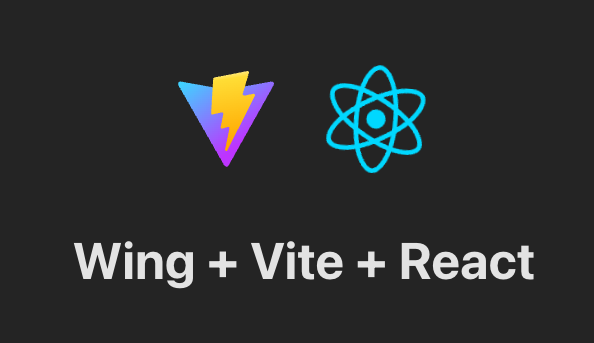 我們將使用 React 和 Vite 作為前端。 我知道還有其他框架,如 Vue、Angular 和 Next,但 React 仍然是最常見的,並且迄今為止有大量值得信賴的新創公司使用它。 如果您不知道, [React](https://github.com/facebook/react)是 Facebook 建立的開源程式庫,用於建立 Web 和本機使用者介面。正如您從儲存庫中看到的,它被超過 2040 萬開發人員使用。所以,這是值得的。 讓我們看看如何使用 Wing 作為後端。  --- [Wing](https://git.new/wing-repo) - 一種雲端程式語言。 ---------------------------------------------  Winglang 是一種專為雲端(又稱「面向雲端」)設計的新型開源程式語言。它允許您在雲端中建立應用程式,並且具有相當簡單的語法。 Wing 程式可以使用功能齊全的模擬器在本地執行(是的,不需要網路),也可以部署到任何雲端供應商。  Wing 需要 Node `v20 or higher` 。 建立一個父目錄(我們使用的`shared-counter` )並使用 Vite 使用新的 React 應用程式設定前端。您可以使用這個 npm 指令。 ``` npm create -y vite frontend -- --template react-ts // once installed, you can check if it's running properly. cd frontend npm install npm run dev ``` 您可以使用此 npm 命令安裝 Wing。 ``` npm install -g winglang ``` 您可以使用`wing -V`驗證安裝。 Wing 還提供官方[VSCode 擴充功能](https://marketplace.visualstudio.com/items?itemName=Monada.vscode-wing)和[IntelliJ](https://plugins.jetbrains.com/plugin/22353-wing) ,後者提供語法突出顯示、補全、轉到定義和嵌入式 Wing 控制台支援。您可以在建立應用程式之前安裝它! 建立後端目錄。 ``` mkdir ~/shared-counter/backend cd ~/shared-counter/backend ``` 建立一個新的空 Wing 專案。 ``` wing new empty // This will generate three files: package.json, package-lock.json and main.w file with a simple "hello world" program wing it // to run it in the Wing simulator // The Wing Simulator will be opened in your browser and will show a map of your app with a single function. //You can invoke the function from the interaction panel and check out the result. ``` 使用指令`wing new empty`後的結構如下。 ``` bring cloud; // define a queue, a bucket, and a counter let bucket = new cloud.Bucket(); let counter = new cloud.Counter(initial: 1); let queue = new cloud.Queue(); // When a message is received in the queue -> it should be consumed // by the following closure queue.setConsumer(inflight (message: str) => { // Increment the distributed counter, the index variable will // store the value before the increment let index = counter.inc(); // Once two messages are pushed to the queue, e.g. "Wing" and "Queue". // Two files will be created: // - wing-1.txt with "Hello Wing" // - wing-2.txt with "Hello Queue" bucket.put("wing-{index}.txt", "Hello, {message}"); log("file wing-{index}.txt created"); }); ``` 您可以安裝`@winglibs/vite`來啟動開發伺服器,而不是使用`npm run dev`來啟動本機 Web 伺服器。 ``` // in the backend directory npm i @winglibs/vite ``` 您可以使用`backend/main.w`中提供的 publicEnv 將資料傳送到前端。 讓我們來看一個小例子。 ``` // backend/main.w bring vite; new vite.Vite( root: "../frontend", publicEnv: { TITLE: "Wing + Vite + React" } ); // import it in frontend // frontend/src/App.tsx import "../.winglibs/wing-env.d.ts" //You can access that value like this. <h1>{window.wing.env.TITLE}</h1> ``` 你還可以做更多: - 讀取/更新 API 路線並使用 Wing Simulator 檢查它。 - 使用後端獲取值。 - 使用`@winglibs/websockets`同步瀏覽器,它在後端部署一個 WebSocket 伺服器,您可以連接此 WebSocket 來接收即時通知。 您可以閱讀完整的逐步指南,以了解[如何使用 React 作為前端和 Wing 作為後端建立簡單的 Web 應用程式](https://www.winglang.io/docs/guides/react-vite-websockets)。測試是使用 Wing Simulator 完成的,並使用 Terraform 部署到 AWS。 部署後的AWS架構是這樣的。  為了提供開發者選擇和更好的體驗,Wing 推出了對[TypeScript (Wing)](https://www.winglang.io/docs/typescript/)等其他語言的全面支援。唯一強制性的事情是您必須安裝 Wing SDK。 這也將使控制台完全可用於本地偵錯和測試,而無需學習 Wing 語言。 Wing 甚至還有其他[指南](https://www.winglang.io/docs/category/guides),因此更容易遵循。 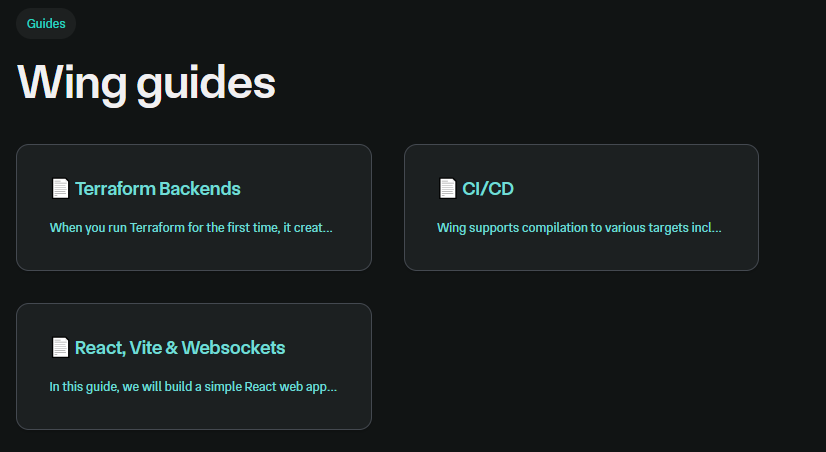 您可以閱讀[文件](https://www.winglang.io/docs)並查看[範例](https://www.winglang.io/docs/category/examples)。 您也可以在[Playground](https://www.winglang.io/play/?code=LwAvACAAVABoAGkAcwAgAGkAcwAgAHQAaABlACAAaQBtAHAAbwByAHQAIABzAHQAYQB0AGUAbQBlAG4AdAAgAGkAbgAgAFcAaQBuAGcALgAKAC8ALwAgAEgAZQByAGUAIAB3AGUAIABiAHIAaQBuAGcAIAB0AGgAZQAgAFcAaQBuAGcAIABzAHQAYQBuAGQAYQByAGQAIABsAGkAYgByAGEAcgB5ACAAdABoAGEAdAAgAAoALwAvACAAYwBvAG4AdABhAGkAbgBzACAAYQBiAHMAdAByAGEAYwB0AGkAbwBuAHMAIABvAGYAIABwAG8AcAB1AGwAYQByACAAYwBsAG8AdQBkACAAcwBlAHIAdgBpAGMAZQBzAC4ACgBiAHIAaQBuAGcAIABjAGwAbwB1AGQAOwAKAAoALwAvACAAVABoAGkAcwAgAGMAbwBkAGUAIABkAGUAZgBpAG4AZQBzACAAYQAgAGIAdQBjAGsAZQB0ACAAYQBzACAAcABhAHIAdAAgAG8AZgAgAHkAbwB1AHIAIABhAHAAcAAuAAoALwAvACAAVwBoAGUAbgAgAGMAbwBtAHAAaQBsAGkAbgBnACAAdABvACAAYQAgAHMAcABlAGMAaQBmAGkAYwAgAGMAbABvAHUAZAAgAHAAcgBvAHYAaQBkAGUAcgAKAC8ALwAgAGkAdAAgAHcAaQBsAGwAIABiAGUAIABzAHUAYgBzAHQAaQB0AHUAdABlAGQAIABiAHkAIABhAG4AIABpAG0AcABsAGUAbQBlAG4AdABhAHQAaQBvAG4AIABmAG8AcgAKAC8ALwAgAHQAaABhAHQAIABjAGwAbwB1AGQALgAgAEkALgBlACwAIABmAG8AcgAgAEEAVwBTACAAaQB0ACAAdwBpAGwAbAAgAGIAZQAgAGEAbgAgAFMAMwAgAEIAdQBjAGsAZQB0AC4ACgBsAGUAdAAgAGIAdQBjAGsAZQB0ACAAPQAgAG4AZQB3ACAAYwBsAG8AdQBkAC4AQgB1AGMAawBlAHQAKAApADsACgAKAC8ALwAgACEAIQAhACEAIQAhACEAIQAhACEAIQAhACEAIQAhACEAIQAhACEAIQAhACEAIQAhACEAIQAhACEAIQAhACEAIQAhACEAIQAhACEAIQAhACEAIQAhACEAIQAhACEAIQAhACEAIQAKAC8ALwAgAFkAbwB1ACAAYwBhAG4AIABpAG4AdABlAHIAYQBjAHQAIAB3AGkAdABoACAAdABoAGUAIABhAHAAcAAgAGkAbgAgAHQAaABlACAAYwBvAG4AcwBvAGwAZQAgAC0ALQA%2BAAoALwAvACAACgAvAC8AIABDAGwAaQBjAGsAIABvAG4AIAB0AGgAZQAgAEYAdQBuAGMAdABpAG8AbgAsACAAYQBuAGQAIAB0AGgAZQBuACAAaQBuAHYAbwBrAGUAIABpAHQAIABpAG4AIAB0AGgAZQAKAC8ALwAgAGwAbwB3AGUAcgAgAHIAaQBnAGgAdAAgAHAAYQBuAGUAbAAsACAAbwByACAAYwBsAGkAYwBrACAAbwBuACAAdABoAGUAIABCAHUAYwBrAGUAdAAKAC8ALwAgAHQAbwAgAHMAZQBlACAAaQB0AHMAIABjAG8AbgB0AGUAbgB0AHMAIABpAG4AIAB0AGgAZQAgAHAAYQBuAGUAbAAsACAAZQB0AGMALgAKAC8ALwAgACEAIQAhACEAIQAhACEAIQAhACEAIQAhACEAIQAhACEAIQAhACEAIQAhACEAIQAhACEAIQAhACEAIQAhACEAIQAhACEAIQAhACEAIQAhACEAIQAhACEAIQAhACEAIQAhACEAIQAKAAoALwAvACAAYABpAG4AZgBsAGkAZwBoAHQAcwBgACAAcgBlAHAAcgBlAHMAZQBuAHQAIABjAG8AZABlACAAdABoAGEAdAAgAHIAdQBuAHMAIABsAGEAdABlAHIALAAgAG8AbgAKAC8ALwAgAG8AdABoAGUAcgAgAG0AYQBjAGgAaQBuAGUAcwAsACAAaQBuAHQAZQByAGEAYwB0AGkAbgBnACAAdwBpAHQAaAAgAGMAYQBwAHQAdQByAGUAZAAgAGQAYQB0AGEAIABhAG4AZAAKAC8ALwAgAHIAZQBzAG8AdQByAGMAZQBzACAAZgByAG8AbQAgAHQAaABlACAAcAByAGUALQBmAGwAaQBnAGgAdAAgAHAAaABhAHMAZQAuAAoAbABlAHQAIABoAGUAbABsAG8AXwB3AG8AcgBsAGQAIAA9ACAAaQBuAGYAbABpAGcAaAB0ACAAKAApACAAPQA%2BACAAewAKACAAIABiAHUAYwBrAGUAdAAuAHAAdQB0ACgAIgBoAGUAbABsAG8ALgB0AHgAdAAiACwAIAAiAEgAZQBsAGwAbwAsACAAVwBvAHIAbABkACEAIgApADsACgB9ADsACgAKAC8ALwAgAEkAbgBmAGwAaQBnAGgAdABzACAAYwBhAG4AIABiAGUAIABkAGUAcABsAG8AeQBlAGQAIABhAHMAIABzAGUAcgB2AGUAcgBsAGUAcwBzACAAZgB1AG4AYwB0AGkAbwBuAHMACgBuAGUAdwAgAGMAbABvAHUAZAAuAEYAdQBuAGMAdABpAG8AbgAoAGgAZQBsAGwAbwBfAHcAbwByAGwAZAApADsACgAgACAAIAAgACAAIAAgACAAIAAgACAAIAAgACAAIAAgACAAIAAgACAAIAAgACAAIAAgACAAIAAgACAAIAAgACAAIAAgACAAIAAgACAACgAvAC8AIACRISAAUwB3AGkAdABjAGgAIABmAGkAbABlAHMAIABhAG4AZAAgAHMAZQBlACAAbwB0AGgAZQByACAAZQB4AGEAbQBwAGwAZQBzACAAdwBpAHQAaAAgAG0AbwByAGUACgAvAC8AIABlAHgAcABsAGUAbgBhAHQAaQBvAG4AcwAgAGEAYgBvAHYAZQAuAA%3D%3D)中使用 Wing 查看結構和範例。 如果你比較像輔導員。看這個! https://www.youtube.com/watch?v=wzqCXrsKWbo Wing 在 GitHub 上擁有超過 3500 個 Star,發布了 1500 多個版本,但仍未進入 v1 版本,這意味著意義重大。 去嘗試一下,做一些很酷的事情吧! https://git.new/wing-repo 星翼 ⭐️ --- 開發者生態系統不斷發展,許多開發者圍繞 React 建置了一些獨特的東西。 我不會介紹如何使用 React,因為這是一個非常廣泛的主題,我在最後貼了一些資源來幫助您學習 React。 但為了幫助您建立出色的 React 專案,我們介紹了 25 個開源專案,您可以使用它們來使您的工作更輕鬆。 這將有大量的資源、想法和概念。 我甚至會給你一些學習資源,以及一些產品的專案範例來學習 React。 一切都是免費的,而且只有 React。 讓我們涵蓋這一切! --- 1. [Mantine Hooks](https://www.npmjs.com/package/@mantine/hooks) - 用於狀態和 UI 管理的 React hooks。 -------------------------------------------------------------------------------------------- 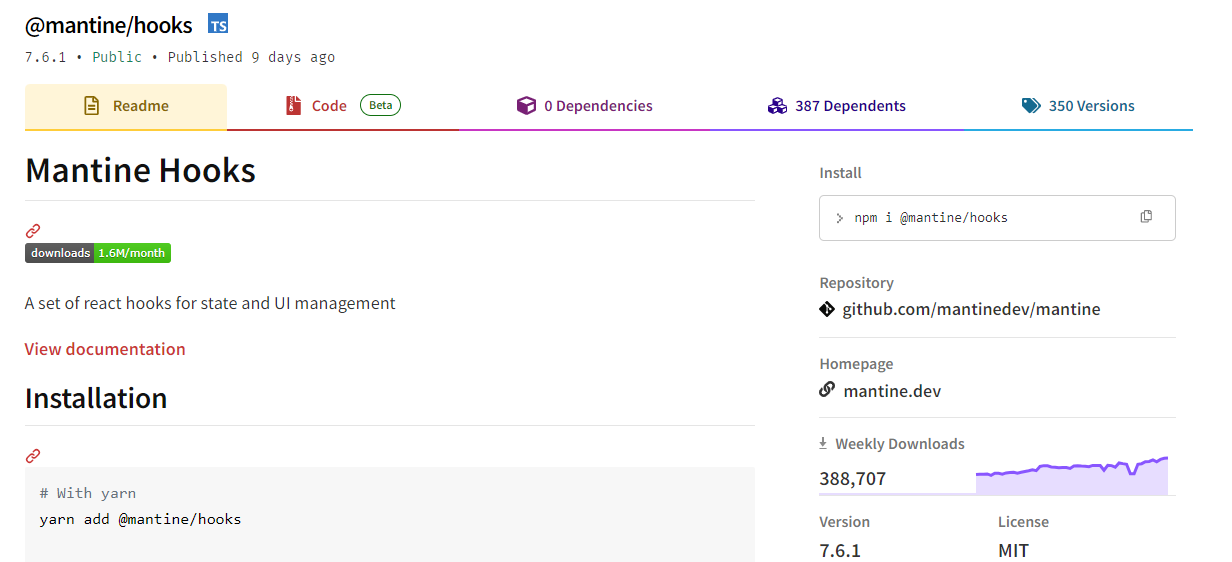 這可能不是專門針對 React 的,但是您可以使用這些鉤子來使您的工作更輕鬆。這些鉤子隨時可用,每個鉤子都有許多選項。 如果我必須評價的話,這將是每個人都可以使用的最有用的專案,而不是從頭開始編寫程式碼。 相信我,獲得 60 多個 Hooks 是一件大事,因為他們有一個簡單的方法讓您可以透過簡單的文件查看每個 Hooks 的演示。 開始使用以下 npm 指令。 ``` npm install @mantine/hooks ``` 這就是如何使用`useScrollIntoView`作為 mantine 掛鉤的一部分。 ``` import { useScrollIntoView } from '@mantine/hooks'; import { Button, Text, Group, Box } from '@mantine/core'; function Demo() { const { scrollIntoView, targetRef } = useScrollIntoView<HTMLDivElement>({ offset: 60, }); return ( <Group justify="center"> <Button onClick={() => scrollIntoView({ alignment: 'center', }) } > Scroll to target </Button> <Box style={{ width: '100%', height: '50vh', backgroundColor: 'var(--mantine-color-blue-light)', }} /> <Text ref={targetRef}>Hello there</Text> </Group> ); } ``` 它們幾乎擁有從本地儲存到分頁、滾動視圖、交叉點,甚至一些非常酷的實用程式(例如滴管和文字選擇)的所有功能。這實在太有幫助了! 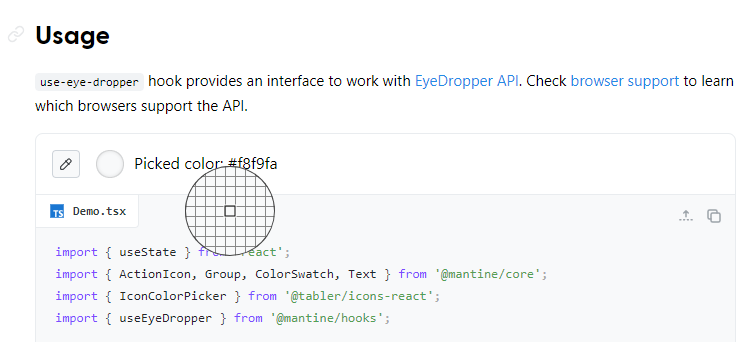 您可以閱讀[文件](https://mantine.dev/hooks/use-click-outside/)。 如果您正在尋找更多選項,您也可以使用[替代庫](https://antonioru.github.io/beautiful-react-hooks/)。 他們在 GitHub 上擁有超過 23k star,但這不僅僅是為了 hooks,因為他們是 React 的元件庫。 隨著`v7`版本的發布,它的每週下載量已超過 38 萬次,這表明它們正在不斷改進且值得信賴。 https://github.com/mantinedev/mantine Star Mantine Hooks ⭐️ --- 2. [React Grid Layout](https://github.com/react-grid-layout/react-grid-layout) - 可拖曳且可調整大小的網格佈局,具有響應式斷點。 --------------------------------------------------------------------------------------------------------  React-Grid-Layout 是專為 React 應用程式建構的響應式網格佈局系統。 透過支援可拖曳、可調整大小和靜態小部件,它提供了使用網格的簡單解決方案。 與 Packery 或 Gridster 等類似系統不同,React-Grid-Layout 不含 jQuery,確保輕量級且高效的實作。 它與伺服器渲染應用程式的無縫整合以及序列化和恢復佈局的能力使其成為開發人員在 React 專案中使用網格佈局的寶貴工具。 開始使用以下 npm 指令。 ``` npm install react-grid-layout ``` 這就是如何使用響應式網格佈局。 ``` import { Responsive as ResponsiveGridLayout } from "react-grid-layout"; class MyResponsiveGrid extends React.Component { render() { // {lg: layout1, md: layout2, ...} const layouts = getLayoutsFromSomewhere(); return ( <ResponsiveGridLayout className="layout" layouts={layouts} breakpoints={{ lg: 1200, md: 996, sm: 768, xs: 480, xxs: 0 }} cols={{ lg: 12, md: 10, sm: 6, xs: 4, xxs: 2 }} > <div key="1">1</div> <div key="2">2</div> <div key="3">3</div> </ResponsiveGridLayout> ); } } ``` 您可以閱讀[文件](https://github.com/react-grid-layout/react-grid-layout?tab=readme-ov-file#installation)並查看[演示](https://react-grid-layout.github.io/react-grid-layout/examples/0-showcase.html)。有一系列[演示](https://github.com/react-grid-layout/react-grid-layout?tab=readme-ov-file#demos),甚至可以透過點擊“查看下一個範例”來獲得。 您也可以嘗試[codesandbox](https://codesandbox.io/p/devbox/github/gilbarbara/react-joyride-demo/tree/main/?embed=1)上的東西。 該專案在 GitHub 上有超過 19k+ 的星星,有超過 16k+ 的開發者使用,並且[npm 套件](https://www.npmjs.com/package/react-grid-layout)的每週下載量超過 600k+。 https://github.com/react-grid-layout/react-grid-layout 明星 React 網格佈局 ⭐️ --- 3. [React Spectrum](https://github.com/adobe/react-spectrum) - 提供出色使用者體驗的程式庫和工具的集合。 -----------------------------------------------------------------------------------  React Spectrum 是一個庫和工具的集合,可幫助您建立自適應、可存取且強大的使用者體驗。 它們提供了太多的東西,以至於很難在一篇文章中涵蓋所有內容。 總的來說,他們提供了這四個庫。  - [反應譜](https://react-spectrum.adobe.com/react-spectrum/index.html) - [React Stately](https://react-spectrum.adobe.com/react-stately/index.html) - 一組龐大的 React Hooks,為您的設計系統提供跨平台狀態管理。 - [反應詠嘆調](https://react-spectrum.adobe.com/react-aria/index.html) - [國際化](https://react-spectrum.adobe.com/internationalized/index.html) 我們將了解一些有關 React Aria 的內容,它是一個無樣式 React 元件和鉤子庫,可幫助您為應用程式建立可存取的、高品質的 UI 元件。 它經過了各種設備、互動方式和輔助技術的精心測試,以確保為所有用戶提供最佳體驗。 開始使用以下 npm 指令。 ``` npm i react-aria-components ``` 這就是建立自訂`select`的方法。 ``` import {Button, Label, ListBox, ListBoxItem, Popover, Select, SelectValue} from 'react-aria-components'; <Select> <Label>Favorite Animal</Label> <Button> <SelectValue /> <span aria-hidden="true">▼</span> </Button> <Popover> <ListBox> <ListBoxItem>Cat</ListBoxItem> <ListBoxItem>Dog</ListBoxItem> <ListBoxItem>Kangaroo</ListBoxItem> </ListBox> </Popover> </Select> ``` 相信我,出於學習目的,這是一座金礦。  他們使用自己強大的[40 多個樣式元件](https://opensource.adobe.com/spectrum-css/),這比通常提供的要多得多。他們也有自己的一套[設計系統,](https://spectrum.adobe.com/)例如字體、UI、版面、動作等等。  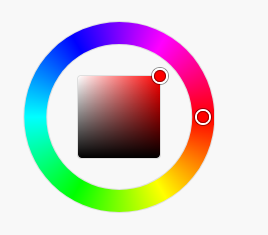 您可以詳細了解[Spectrum](https://react-spectrum.adobe.com/index.html)及其[架構](https://react-spectrum.adobe.com/architecture.html)。 他們在 GitHub 上擁有超過 11,000 顆星,這表明了他們的質量,儘管他們並不廣為人知。研究它們可以為您建立圖書館提供寶貴的見解。 https://github.com/adobe/react-spectrum Star React Spectrum ⭐️ --- 4.[保留 React](https://github.com/StaticMania/keep-react) - Tailwind CSS 和 React.js 的 UI 元件庫。 -------------------------------------------------------------------------------------------  Keep React 是一個基於 Tailwind CSS 和 React.js 建立的開源元件庫。它提供了一組多功能的預先設計的 UI 元件,使開發人員能夠簡化現代、響應式且具有視覺吸引力的 Web 應用程式的建立。 開始使用以下 npm 指令。 ``` npm i keep-react ``` 這就是使用時間軸的方法。 ``` "use client"; import { Timeline } from "keep-react"; import { CalendarBlank } from "phosphor-react"; export const TimelineComponent = () => { return ( <Timeline horizontal={true}> <Timeline.Item> <Timeline.Point icon={<CalendarBlank size={16} />} /> <Timeline.Content> <Timeline.Title>Keep Library v1.0.0</Timeline.Title> <Timeline.Time>Released on December 2, 2021</Timeline.Time> <Timeline.Body> Get started with dozens of web components and interactive elements. </Timeline.Body> </Timeline.Content> </Timeline.Item> <Timeline.Item> <Timeline.Point icon={<CalendarBlank size={16} />} /> <Timeline.Content> <Timeline.Title>Keep Library v1.1.0</Timeline.Title> <Timeline.Time>Released on December 23, 2021</Timeline.Time> <Timeline.Body> Get started with dozens of web components and interactive elements. </Timeline.Body> </Timeline.Content> </Timeline.Item> <Timeline.Item> <Timeline.Point icon={<CalendarBlank size={16} />} /> <Timeline.Content> <Timeline.Title>Keep Library v1.3.0</Timeline.Title> <Timeline.Time>Released on January 5, 2022</Timeline.Time> <Timeline.Body> Get started with dozens of web components and interactive elements. </Timeline.Body> </Timeline.Content> </Timeline.Item> </Timeline> ); } ``` 輸出如下。  流暢的小動畫讓這一切都是值得的,如果你想快速建立一個 UI,沒有任何麻煩,你可以使用它。 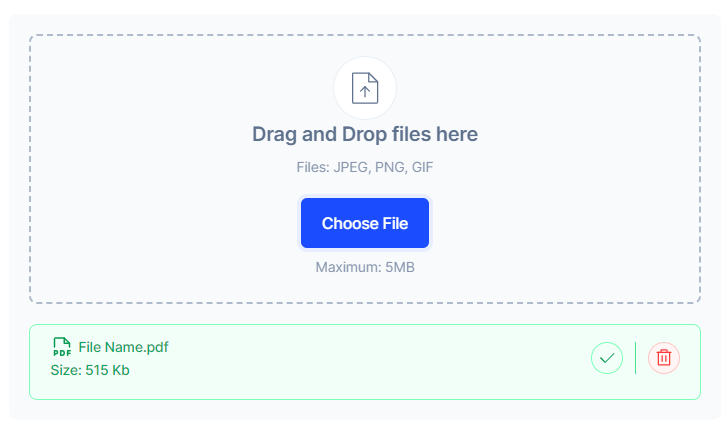  您可以閱讀[文件](https://react.keepdesign.io/docs/getting-started/Introduction)並查看[故事書](https://react-storybook.keepdesign.io/?path=/docs/components-accordion--docs)以進行詳細的使用測驗。 該專案在 GitHub 上有超過 1000 顆星,而且它的一些元件使用起來非常方便。 https://github.com/StaticMania/keep-react Star Keep React ⭐️ --- 5. [React Content Loader](https://github.com/danilowoz/react-content-loader) - SVG 支援的元件,可輕鬆建立骨架載入。 ---------------------------------------------------------------------------------------------------  該專案為您提供了一個由 SVG 驅動的元件,可以輕鬆建立佔位符載入(如 Facebook 的卡片載入)。 在載入狀態期間使用骨架來向使用者指示內容仍在載入。 總的來說,這是一個非常方便的專案,可以增強整體使用者體驗。 開始使用以下 npm 指令。 ``` npm i react-content-loader --save ``` 您可以這樣使用它。 ``` import React from "react" import ContentLoader from "react-content-loader" const MyLoader = (props) => ( <ContentLoader speed={2} width={400} height={160} viewBox="0 0 400 160" backgroundColor="#f3f3f3" foregroundColor="#ecebeb" {...props} > <rect x="48" y="8" rx="3" ry="3" width="88" height="6" /> <rect x="48" y="26" rx="3" ry="3" width="52" height="6" /> <rect x="0" y="56" rx="3" ry="3" width="410" height="6" /> <rect x="0" y="72" rx="3" ry="3" width="380" height="6" /> <rect x="0" y="88" rx="3" ry="3" width="178" height="6" /> <circle cx="20" cy="20" r="20" /> </ContentLoader> ) export default MyLoader ```  您甚至可以拖曳單一骨架或使用為 Facebook 和 Instagram 等不同社群媒體預先定義的骨架。 您可以閱讀[文件](https://github.com/danilowoz/react-content-loader?tab=readme-ov-file#gettingstarted)並查看[演示](https://skeletonreact.com/)。 該專案在 GitHub 上擁有 13k+ Stars,並在 GitHub 上有 45k+ 開發人員使用。 https://github.com/danilowoz/react-content-loader Star React 內容載入器 ⭐️ --- 6. [React PDF](https://github.com/diegomura/react-pdf) - 使用 React 建立 PDF 檔案。 ----------------------------------------------------------------------------  該套件用於使用 React 建立 PDF。 開始使用以下 npm 指令。 ``` npm install @react-pdf/renderer --save ``` 您可以這樣使用它。 ``` import React from 'react'; import { Document, Page, Text, View, StyleSheet } from '@react-pdf/renderer'; // Create styles const styles = StyleSheet.create({ page: { flexDirection: 'row', backgroundColor: '#E4E4E4', }, section: { margin: 10, padding: 10, flexGrow: 1, }, }); // Create Document Component const MyDocument = () => ( <Document> <Page size="A4" style={styles.page}> <View style={styles.section}> <Text>Section #1</Text> </View> <View style={styles.section}> <Text>Section #2</Text> </View> </Page> </Document> ); ```   您可以閱讀[文件](https://react-pdf.org/)並查看[演示](https://react-pdf.org/repl)。 React-pdf 現在提供了一個名為`usePDF`的鉤子,可以透過 React hook API 存取所有 PDF 建立功能。如果您需要更多控製文件的呈現方式或更新頻率,這非常有用。 ``` const [instance, update] = usePDF({ document }); ``` 該專案在 GitHub 上有 13k+ Stars,有超過 270 個版本,[每週下載量超過 400k](https://www.npmjs.com/package/@react-pdf/renderer) ,這是一個好兆頭。 https://github.com/diegomura/react-pdf Star React PDF ⭐️ --- 7. [Recharts](https://github.com/recharts/recharts) - 使用 React 和 D3 建立的重新定義的圖表庫。 -------------------------------------------------------------------------------- 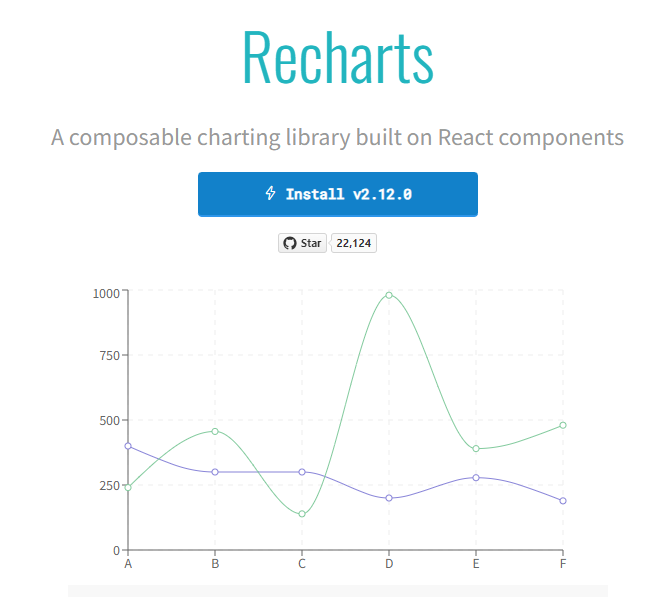 該庫的主要目的是幫助您輕鬆地在 React 應用程式中編寫圖表。 Recharts 的主要原則是。 1. 只需使用 React 元件進行部署即可。 2. 原生 SVG 支持,輕量級,僅依賴一些 D3 子模組。 3. 聲明性元件、圖表元件純粹是表示性的。 開始使用以下 npm 指令。 ``` npm install recharts ``` 您可以這樣使用它。 ``` <LineChart width={500} height={300} data={data} accessibilityLayer> <XAxis dataKey="name"/> <YAxis/> <CartesianGrid stroke="#eee" strokeDasharray="5 5"/> <Line type="monotone" dataKey="uv" stroke="#8884d8" /> <Line type="monotone" dataKey="pv" stroke="#82ca9d" /> <Tooltip/> </LineChart> ```  您可以閱讀[文件](https://recharts.org/en-US/guide)並查看有關[Storybook](https://recharts.org/en-US/storybook)的更多資訊。 他們提供了大量的選項來自訂它,這就是開發人員喜歡它的原因。他們也提供一般常見問題的[wiki](https://github.com/recharts/recharts/wiki)頁面。 您也可以在此處的codesandbox 上嘗試。 https://codesandbox.io/embed/kec3v?view=Editor+%2B+Preview&module=%2Fsrc%2Findex.tsx 該專案在 GitHub 上有 22k+ Stars,有 200k+ 開發人員使用。 https://github.com/recharts/recharts 明星 Recharts ⭐️ --- 8. [React Joyride](https://github.com/gilbarbara/react-joyride) - 在您的應用程式中建立導遊。 -------------------------------------------------------------------------------  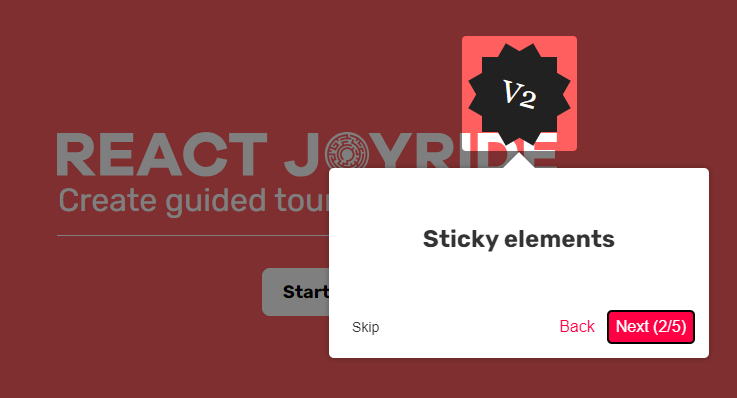 導覽是向新用戶展示您的應用程式或解釋新功能的絕佳方式。它改善了用戶體驗並可以創造個人化的觸感。 開始使用以下 npm 指令。 ``` npm i react-joyride ``` 您可以這樣使用它。 ``` import React, { useState } from 'react'; import Joyride from 'react-joyride'; /* * If your steps are not dynamic you can use a simple array. * Otherwise you can set it as a state inside your component. */ const steps = [ { target: '.my-first-step', content: 'This is my awesome feature!', }, { target: '.my-other-step', content: 'This another awesome feature!', }, ]; export default function App() { // If you want to delay the tour initialization you can use the `run` prop return ( <div> <Joyride steps={steps} /> ... </div> ); } ``` 它們還提供[元件列表](https://docs.react-joyride.com/custom-components)以及自訂預設用戶介面的簡單方法。 您可以閱讀[文件](https://docs.react-joyride.com/)並查看[演示](https://react-joyride.com/)。 您也可以嘗試[codesandbox](https://codesandbox.io/p/devbox/github/gilbarbara/react-joyride-demo/tree/main/?embed=1)上的東西。 他們在 GitHub 上有超過 6k 顆星,npm 套件每週下載量超過 25 萬次。 https://github.com/gilbarbara/react-joyride Star React Joyride ⭐️ --- 9. [SVGR](https://github.com/gregberge/svgr) - 將 SVG 轉換為 React 元件。 ------------------------------------------------------------------  SVGR 是一個將 SVG 轉換為 React 元件的通用工具。 它需要一個原始的 SVG 並將其轉換為隨時可用的 React 元件。 開始使用以下 npm 指令。 ``` npm install @svgr/core ``` 例如,您採用這個 SVG。 ``` <?xml version="1.0" encoding="UTF-8"?> <svg width="48px" height="1px" viewBox="0 0 48 1" version="1.1" xmlns="http://www.w3.org/2000/svg" xmlns:xlink="http://www.w3.org/1999/xlink" > <!-- Generator: Sketch 46.2 (44496) - http://www.bohemiancoding.com/sketch --> <title>Rectangle 5</title> <desc>Created with Sketch.</desc> <defs></defs> <g id="Page-1" stroke="none" stroke-width="1" fill="none" fill-rule="evenodd"> <g id="19-Separator" transform="translate(-129.000000, -156.000000)" fill="#063855" > <g id="Controls/Settings" transform="translate(80.000000, 0.000000)"> <g id="Content" transform="translate(0.000000, 64.000000)"> <g id="Group" transform="translate(24.000000, 56.000000)"> <g id="Group-2"> <rect id="Rectangle-5" x="25" y="36" width="48" height="1"></rect> </g> </g> </g> </g> </g> </g> </svg> ``` 執行SVGR後,將轉換為. ``` import * as React from 'react' const SvgComponent = (props) => ( <svg width="1em" height="1em" viewBox="0 0 48 1" {...props}> <path d="M0 0h48v1H0z" fill="currentColor" fillRule="evenodd" /> </svg> ) export default SvgComponent ``` 它使用[SVGO](https://github.com/svg/svgo)優化 SVG,並使用 Prettier 格式化程式碼。 將 HTML 轉換為 JSX 需要幾個步驟: 1. 將 SVG 轉換為 HAST (HTML AST) 2. 將 HAST 轉換為 Babel AST (JSX AST) 3. 使用 Babel 轉換 AST(重新命名屬性、更改屬性值…) 您可以在[Playground](https://react-svgr.com/playground/)閱讀[文件](https://react-svgr.com/docs/getting-started)並檢查內容。 該專案在 GitHub 上擁有 10k+ Stars,有超過 800 萬開發者使用,npm 上每週下載量超過 800k。 https://github.com/gregberge/svgr 明星 SVGR ⭐️ --- 10. [React Sortable Tree](https://github.com/frontend-collective/react-sortable-tree) - 用於巢狀資料和層次結構的拖放可排序元件。 ------------------------------------------------------------------------------------------------------------ 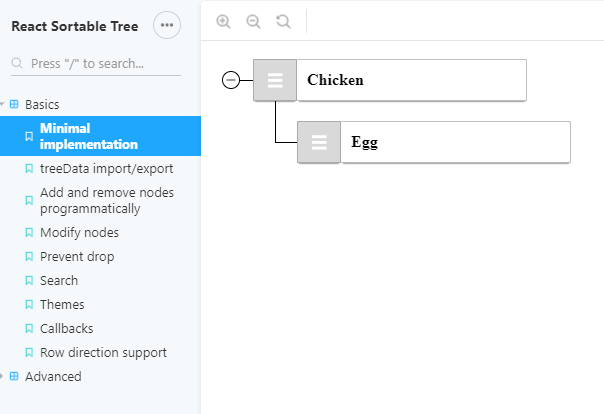 一個 React 元件,支援對分層資料進行拖放排序。  開始使用以下 npm 指令。 ``` npm install react-sortable-tree --save ``` 您可以這樣使用它。 ``` import React, { Component } from 'react'; import SortableTree from 'react-sortable-tree'; import 'react-sortable-tree/style.css'; // This only needs to be imported once in your app export default class Tree extends Component { constructor(props) { super(props); this.state = { treeData: [ { title: 'Chicken', children: [{ title: 'Egg' }] }, { title: 'Fish', children: [{ title: 'fingerline' }] }, ], }; } render() { return ( <div style={{ height: 400 }}> <SortableTree treeData={this.state.treeData} onChange={treeData => this.setState({ treeData })} /> </div> ); } } ``` 檢查由此獲得的各種[道具選項](https://github.com/frontend-collective/react-sortable-tree?tab=readme-ov-file#props)和[主題](https://github.com/frontend-collective/react-sortable-tree?tab=readme-ov-file#featured-themes)。 您可以閱讀[文件](https://github.com/frontend-collective/react-sortable-tree?tab=readme-ov-file#getting-started)並查看[Storybook](https://frontend-collective.github.io/react-sortable-tree/?path=/story/basics--minimal-implementation) ,以獲取一些基本和高級功能的演示。 它可能不會被積極維護(仍然沒有存檔),因此您也可以使用[維護的 fork 版本](https://github.com/nosferatu500/react-sortable-tree)。 該專案在 GitHub 上擁有超過 4,500 個 Star,並被超過 5,000 名開發人員使用。 https://github.com/frontend-collective/react-sortable-tree Star React 可排序樹 ⭐️ --- 11. [React Hot Toast](https://github.com/timolins/react-hot-toast) - 冒煙的 Hot React 通知。 --------------------------------------------------------------------------------------  React Hot Toast 透過簡單的自訂選項提供了驚人的 🔥 預設體驗。它利用 Promise API 進行自動加載,確保平穩過渡。 它重量輕,不到 5kb,但仍然可以存取,同時為開發人員提供了像`useToaster()`這樣的無頭鉤子。 首先將 Toaster 加入到您的應用程式中。它將負責渲染發出的所有通知。現在您可以從任何地方觸發 toast() ! 開始使用以下 npm 指令。 ``` npm install react-hot-toast ``` 這就是它的易用性。 ``` import toast, { Toaster } from 'react-hot-toast'; const notify = () => toast('Here is your toast.'); const App = () => { return ( <div> <button onClick={notify}>Make me a toast</button> <Toaster /> </div> ); }; ``` 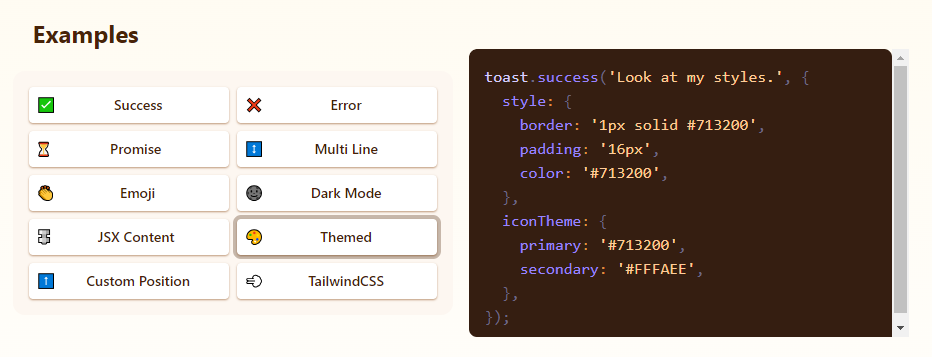  他們有很多自訂選項,但`useToaster()`掛鉤為您提供了一個無頭系統,可以為您管理通知狀態。這使得建立您的通知系統變得更加容易。 您可以閱讀[文件](https://react-hot-toast.com/docs)、[樣式指南](https://react-hot-toast.com/docs/styling)並查看[示範](https://react-hot-toast.com/)。 該專案在 GitHub 上有 8k+ Stars,有 230k+ 開發者使用。 https://github.com/timolins/react-hot-toast Star React Hot Toast ⭐️ --- 12. [Payload](https://github.com/payloadcms/payload) - 建立現代後端+管理 UI 的最佳方式。 --------------------------------------------------------------------------  Payload 是一個無頭 CMS 和應用程式框架。它旨在促進您的開發過程,但重要的是,當您的應用程式變得更加複雜時,不要妨礙您。 Payload 沒有黑魔法,完全開源,它既是一個應用程式框架,也是一個無頭 CMS。它確實是適用於 TypeScript 的 Rails,並且您會獲得一個管理面板。您可以使用此[YouTube 影片](https://www.youtube.com/watch?v=In_lFhzmbME)了解有關 Payload 的更多資訊。 https://www.youtube.com/watch?v=In\_lFhzmbME 您可以透過使用Payload來了解[其中涉及的概念](https://payloadcms.com/docs/getting-started/concepts)。  有效負載透過您選擇的資料庫適配器與您的資料庫進行互動。目前,Payload 正式支援兩種資料庫適配器: 1. MongoDB 與 Mongoose 2. Postgres 帶毛毛雨 開始使用以下命令。 ``` npx create-payload-app@latest ``` 您必須產生 Payload 金鑰並更新`server.ts`以初始化 Payload。 ``` import express from 'express' import payload from 'payload' require('dotenv').config() const app = express() const start = async () => { await payload.init({ secret: process.env.PAYLOAD_SECRET, express: app, }) app.listen(3000, async () => { console.log( "Express is now listening for incoming connections on port 3000." ) }) } start() ``` 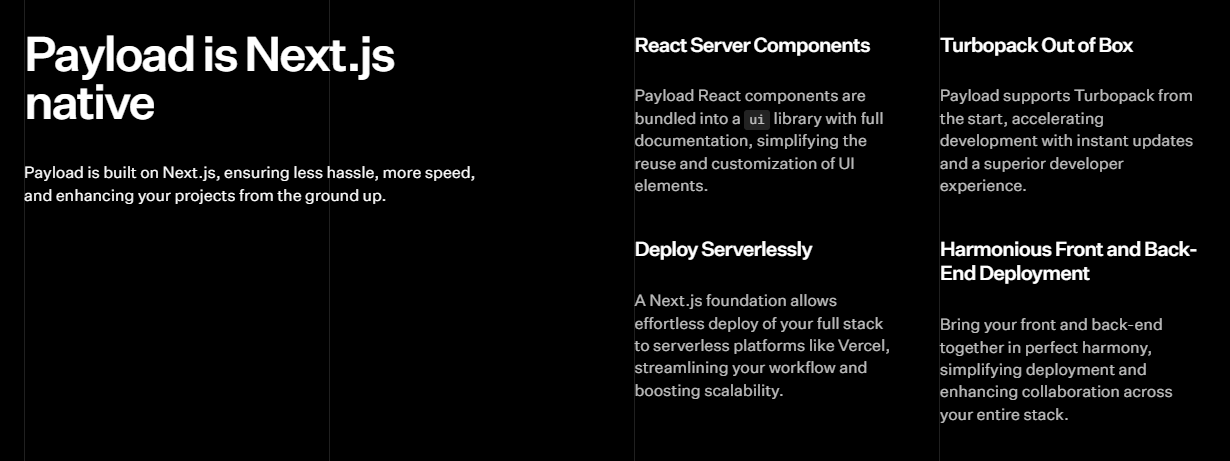 您可以閱讀[文件](https://payloadcms.com/docs/getting-started/what-is-payload)並查看[演示](https://demo.payloadcms.com/?_gl=1*9x0za3*_ga*NzEzMzkwNzIuMTcxMDE2NDk1MA..*_ga_FLQ5THRMZQ*MTcxMDE2NDk1MC4xLjEuMTcxMDE2NDk1MS4wLjAuMA..)。 他們還提供與 Payload + Stripe 無縫整合的[電子商務模板](https://github.com/payloadcms/payload/tree/main/templates/ecommerce)。此範本具有令人驚嘆的、功能齊全的前端,包括購物車、結帳流程、訂單管理等元件。 Payload 在 GitHub 上擁有 18k+ Stars,並且有超過 290 個版本,因此它們不斷改進,尤其是在資料庫支援方面。 https://github.com/payloadcms/payload 明星有效負載 ⭐️ --- 13. [React Player](https://github.com/cookpete/react-player) - 用於播放各種 URL 的 React 元件。 ------------------------------------------------------------------------------------- 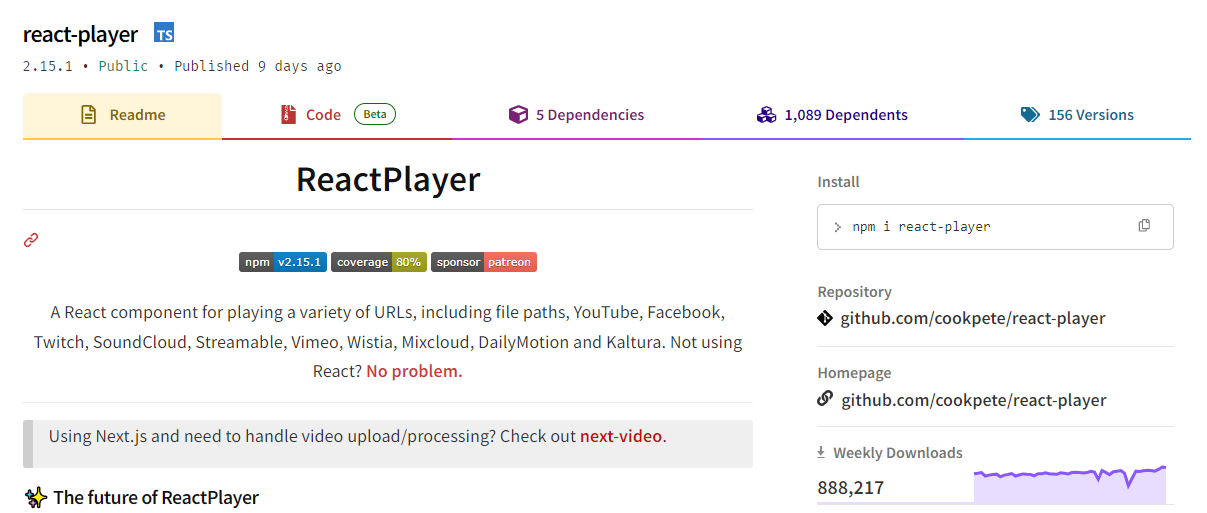 用於播放各種 URL 的 React 元件,包括檔案路徑、YouTube、Facebook、Twitch、SoundCloud、Streamable、Vimeo、Wistia、Mixcloud、DailyMotion 和 Kaltura。您可以看到[支援的媒體](https://github.com/cookpete/react-player?tab=readme-ov-file#supported-media)清單。 ReactPlayer 的維護工作由 Mux 接管,這使它們成為一個不錯的選擇。 開始使用以下 npm 指令。 ``` npm install react-player ``` 您可以這樣使用它。 ``` import React from 'react' import ReactPlayer from 'react-player' // Render a YouTube video player <ReactPlayer url='https://www.youtube.com/watch?v=LXb3EKWsInQ' /> // If you only ever use one type, use imports such as react-player/youtube to reduce your bundle size. // like this: import ReactPlayer from 'react-player/youtube' ``` 您也可以使用`react-player/lazy`為您傳入的URL 延遲載入適當的播放器。這會為您的輸出加入幾個reactPlayer 區塊,但會減少主包的大小。 ``` import React from 'react' import ReactPlayer from 'react-player/lazy' // Lazy load the YouTube player <ReactPlayer url='https://www.youtube.com/watch?v=ysz5S6PUM-U' /> ``` 您可以閱讀[文件](https://github.com/cookpete/react-player?tab=readme-ov-file#props)並查看[演示](https://cookpete.github.io/react-player/)。他們提供了大量的選項,包括加入字幕並以簡單的方式使其響應。 它們在 GitHub 上擁有超過 8000 顆星,被超過 135,000 名開發人員使用,並且 npm 軟體包[每週的下載量超過 800k](https://www.npmjs.com/package/react-player) 。 https://github.com/cookpete/react-player 明星 React 播放器 ⭐️ --- 14. [Victory](https://github.com/FormidableLabs/victory) - 用於建立互動式資料視覺化的 React 元件。 ----------------------------------------------------------------------------------  Victory 是一個可組合 React 元件的生態系統,用於建立互動式資料視覺化。 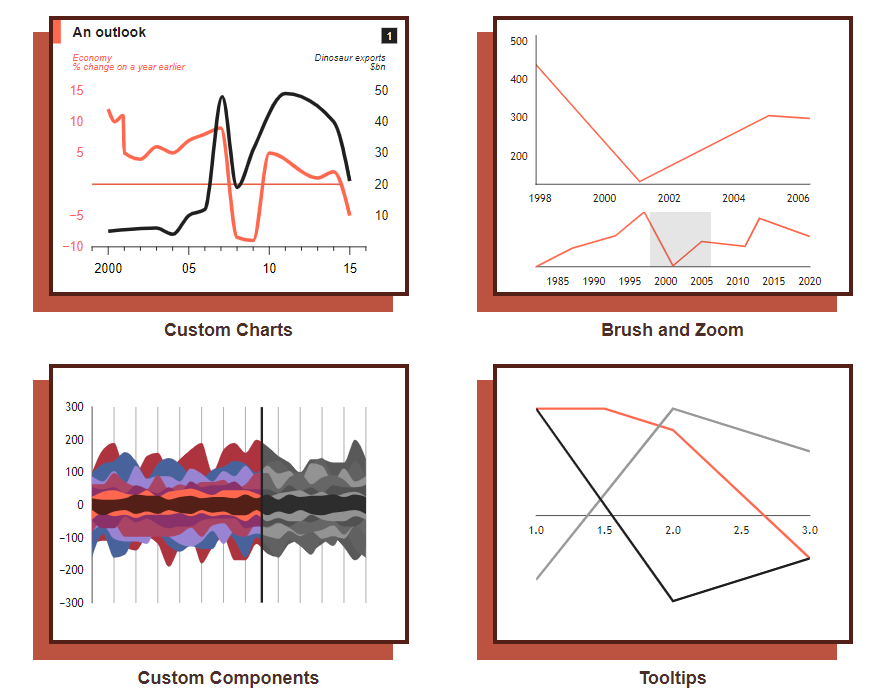 開始使用以下 npm 指令。 ``` npm i --save victory ``` 您可以這樣使用它。 ``` <VictoryChart domainPadding={{ x: 20 }} > <VictoryHistogram style={{ data: { fill: "#c43a31" } }} data={sampleHistogramDateData} bins={[ new Date(2020, 1, 1), new Date(2020, 4, 1), new Date(2020, 8, 1), new Date(2020, 11, 1) ]} /> </VictoryChart> ``` 這就是它的渲染方式。他們還提供通常有用的動畫和主題選項。 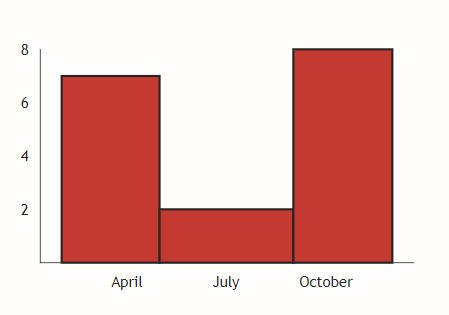 您可以閱讀[文件](https://commerce.nearform.com/open-source/victory/docs)並按照[教學](https://commerce.nearform.com/open-source/victory/docs/native)開始。他們提供大約 15 種不同的圖表選項。 它也可用於[React Native(文件)](https://commerce.nearform.com/open-source/victory/docs/native) ,所以這是一個優點。我還建議您查看他們的常見[問題解答](https://commerce.nearform.com/open-source/victory/docs/faq#frequently-asked-questions-faq),其中描述了常見問題的程式碼解決方案和解釋,例如樣式、註釋(標籤)、處理軸。 該專案在 GitHub 上擁有 10k+ Stars,並在 GitHub 上有 23k+ 開發人員使用。 https://github.com/FormidableLabs/victory 勝利之星 ⭐️ --- 15. [React Slick](https://github.com/akiran/react-slick) - React 輪播元件。 ----------------------------------------------------------------------  React Slick 是一個使用 React 建構的輪播元件。它是一個光滑的旋轉木馬的反應端口 開始使用以下 npm 指令。 ``` npm install react-slick --save ``` 這是使用自訂分頁的方法。 ``` import React, { Component } from "react"; import Slider from "react-slick"; import { baseUrl } from "./config"; function CustomPaging() { const settings = { customPaging: function(i) { return ( <a> <img src={`${baseUrl}/abstract0${i + 1}.jpg`} /> </a> ); }, dots: true, dotsClass: "slick-dots slick-thumb", infinite: true, speed: 500, slidesToShow: 1, slidesToScroll: 1 }; return ( <div className="slider-container"> <Slider {...settings}> <div> <img src={baseUrl + "/abstract01.jpg"} /> </div> <div> <img src={baseUrl + "/abstract02.jpg"} /> </div> <div> <img src={baseUrl + "/abstract03.jpg"} /> </div> <div> <img src={baseUrl + "/abstract04.jpg"} /> </div> </Slider> </div> ); } export default CustomPaging; ```  您可以閱讀有關可用的[prop 選項](https://react-slick.neostack.com/docs/api)和[方法](https://react-slick.neostack.com/docs/api#methods)的資訊。 您可以閱讀[文件](https://react-slick.neostack.com/docs/get-started)和所有帶有程式碼和輸出[的範例集](https://react-slick.neostack.com/docs/example/)。 他們在 GitHub 上有超過 11k 顆星,並且有超過 36 萬開發者在 GitHub 上使用它。 https://github.com/akiran/react-slick Star React Slick ⭐️ --- 16. [Medusa](https://github.com/medusajs/medusa) - 數位商務的建構模組。 -------------------------------------------------------------  Medusa 是一組商務模組和工具,可讓您建立豐富、可靠且高效能的商務應用程式,而無需重新發明核心商務邏輯。 這些模組可以客製化並用於建立高級電子商務商店、市場或任何需要基礎商務原語的產品。所有模組都是開源的,可以在 npm 上免費取得。 開始使用以下 npm 指令。 ``` npm install medusa-react @tanstack/[email protected] @medusajs/medusa ``` 將其包含在`app.ts`中。 只有 MedusaProvider 的子級才能從其鉤子中受益。因此,Storefront 元件及其子元件現在可以使用 Medusa React 公開的鉤子。 ``` import { MedusaProvider } from "medusa-react" import Storefront from "./Storefront" import { QueryClient } from "@tanstack/react-query" import React from "react" const queryClient = new QueryClient() const App = () => { return ( <MedusaProvider queryClientProviderProps={{ client: queryClient }} baseUrl="http://localhost:9000" > <Storefront /> </MedusaProvider> ) } export default App ``` 例如,這就是您如何使用突變來建立購物車。 ``` import { useCreateCart } from "medusa-react" const Cart = () => { const createCart = useCreateCart() const handleClick = () => { createCart.mutate({}) // create an empty cart } return ( <div> {createCart.isLoading && <div>Loading...</div>} {!createCart.data?.cart && ( <button onClick={handleClick}> Create cart </button> )} {createCart.data?.cart?.id && ( <div>Cart ID: {createCart.data?.cart.id}</div> )} </div> ) } export default Cart ``` 他們提供了一套電子商務模組(大量選項),例如折扣、價目表、禮品卡等。  它們還提供了一種簡單的管理員和客戶身份驗證方法,您可以在[文件](https://docs.medusajs.com/)中閱讀。 他們提供了[nextjs 入門模板](https://docs.medusajs.com/starters/nextjs-medusa-starter)和[Medusa React](https://docs.medusajs.com/medusa-react/overview)作為 SDK。 該專案在 GitHub 上有 22k+ Stars,有 4k+ 開發者使用。 https://github.com/medusajs/medusa 明星美杜莎 ⭐️ --- 17. [React Markdown](https://github.com/remarkjs/react-markdown) - React 的 Markdown 元件. --------------------------------------------------------------------------------------- 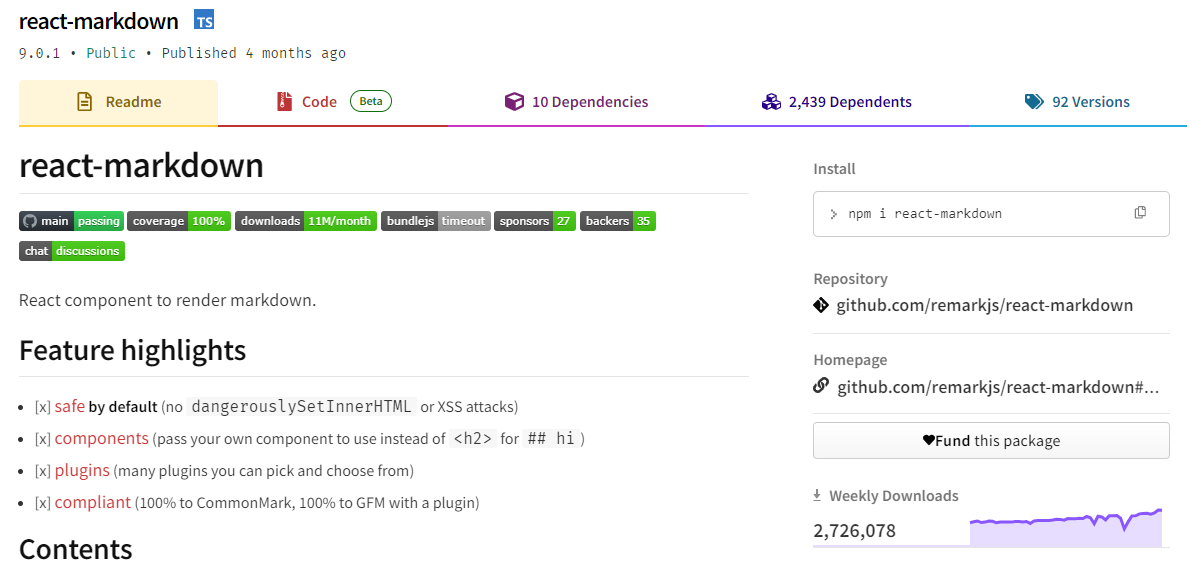 Markdown 至關重要,使用 React 渲染它對於各種場景都非常有用。 它提供了一個 React 元件,能夠安全地將一串 Markdown 渲染到 React 元素中。您可以透過傳遞外掛程式並指定要使用的元件而不是標準 HTML 元素來自訂 Markdown 的轉換。 開始使用以下 npm 指令。 ``` npm i react-markdown ``` 您可以這樣使用它。 ``` import React from 'react' import {createRoot} from 'react-dom/client' import Markdown from 'react-markdown' import remarkGfm from 'remark-gfm' const markdown = `Just a link: www.nasa.gov.` createRoot(document.body).render( <Markdown remarkPlugins={[remarkGfm]}>{markdown}</Markdown> ) ``` 等效的 JSX 是。 ``` <p> Just a link: <a href="http://www.nasa.gov">www.nasa.gov</a>. </p> ``` 他們還提供了一份[備忘錄](https://commonmark.org/help/)和一個十分鐘的逐步[教學](https://commonmark.org/help/tutorial/)。 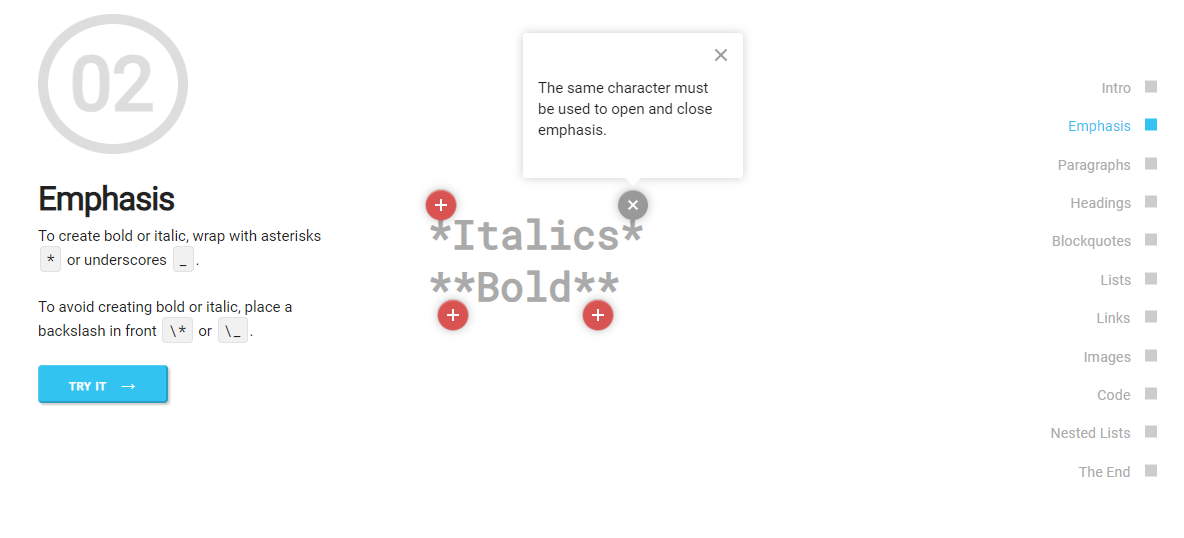 您可以閱讀[文件](https://github.com/remarkjs/react-markdown?tab=readme-ov-file#install)並查看[演示](https://remarkjs.github.io/react-markdown/)。 該專案在 GitHub 上有 12k+ Stars,[每週下載量超過 2700k](https://www.npmjs.com/package/react-markdown) ,並被 200k+ 開發人員使用,證明了它的真正有用性。 https://github.com/remarkjs/react-markdown Star React Markdown ⭐️ --- 18. [React JSONSchema Form](https://github.com/rjsf-team/react-jsonschema-form) - 用於從 JSON Schema 建立 Web 表單。 ------------------------------------------------------------------------------------------------------------ 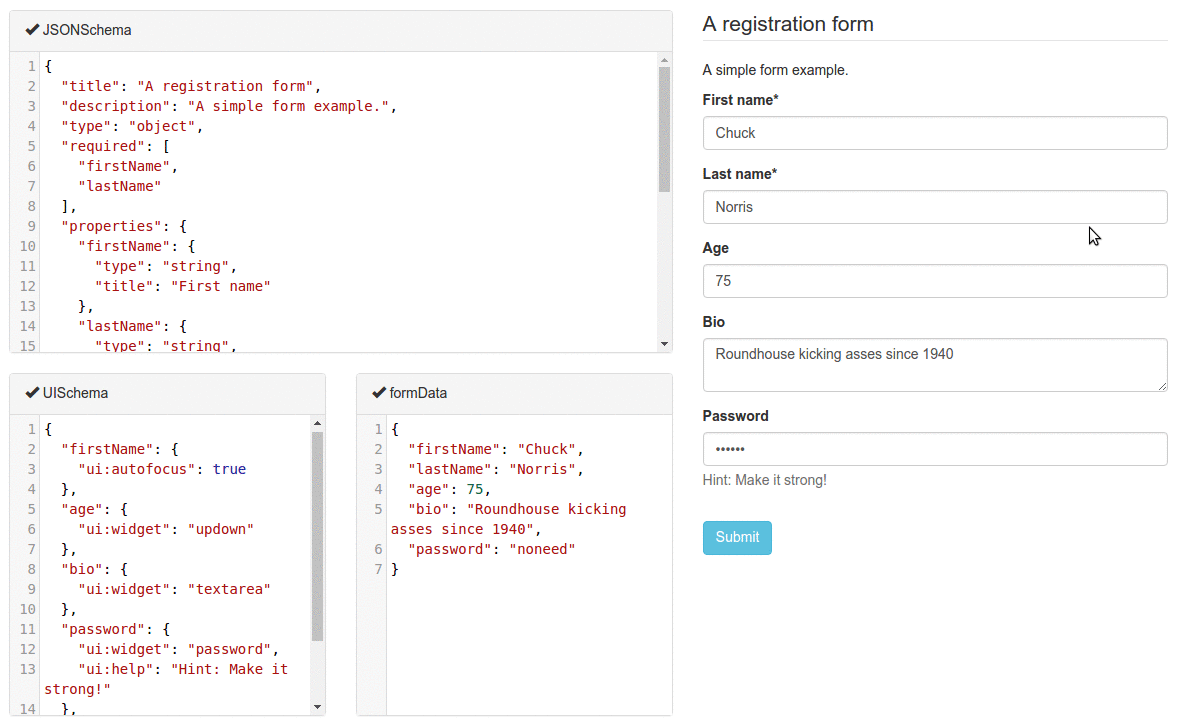 `react-jsonschema-form`會自動從 JSON Schema 產生 React 表單,使其非常適合僅使用 JSON schema 為任何資料產生表單。它提供了像 uiSchema 這樣的自訂選項來自訂預設主題之外的表單外觀。 開始使用以下 npm 指令。 ``` npm install @rjsf/core @rjsf/utils @rjsf/validator-ajv8 --save ``` 您可以這樣使用它。 ``` import { RJSFSchema } from '@rjsf/utils'; import validator from '@rjsf/validator-ajv8'; const schema: RJSFSchema = { title: 'Todo', type: 'object', required: ['title'], properties: { title: { type: 'string', title: 'Title', default: 'A new task' }, done: { type: 'boolean', title: 'Done?', default: false }, }, }; const log = (type) => console.log.bind(console, type); render( <Form schema={schema} validator={validator} onChange={log('changed')} onSubmit={log('submitted')} onError={log('errors')} />, document.getElementById('app') ); ``` 他們提供[高級定制](https://rjsf-team.github.io/react-jsonschema-form/docs/advanced-customization/)選項,包括定制小部件。 您可以閱讀[文件](https://rjsf-team.github.io/react-jsonschema-form/docs/)並查看[即時遊樂場](https://rjsf-team.github.io/react-jsonschema-form/)。 它在 GitHub 上擁有超過 13k 個 Star,並被 5k+ 開發人員使用。他們在`v5`上發布了 190 多個版本,因此他們正在不斷改進。 https://github.com/rjsf-team/react-jsonschema-form Star React JSONSchema 表單 ⭐️ --- 19. [Craft.js](https://github.com/prevwong/craft.js) - 建立可擴充的拖放頁面編輯器。 ---------------------------------------------------------------------  頁面編輯器可以增強使用者體驗,但從頭開始建立頁面編輯器可能會令人望而生畏。現有庫提供具有可編輯元件的預先建置編輯器,但自訂通常需要修改庫本身。 Craft.js 透過模組化頁面編輯器元件、透過拖放功能簡化自訂以及渲染管理來解決這個問題。在 React 中設計你的編輯器,無需複雜的插件系統,專注於你的特定需求和規格。 開始使用以下 npm 指令。 ``` npm install --save @craftjs/core ``` 他們還提供了有關如何入門的[簡短教程](https://craft.js.org/docs/guides/basic-tutorial)。我不會介紹它,因為它非常簡單且詳細。 您可以閱讀[文件](https://craft.js.org/docs/overview)並查看[即時演示](https://craft.js.org/)以及另一個[即時範例](https://craft.js.org/examples/basic)。 它在 GitHub 上有大約 6k+ Stars,但考慮到它們正在改進,仍然很有用。 https://github.com/prevwong/craft.js Star Craft.js ⭐️ --- 20. [Gatsby](https://github.com/gatsbyjs/gatsby) - 最好的基於 React 的框架,具有內建的效能、可擴展性和安全性。 ------------------------------------------------------------------------------------  Gatsby 是一個基於 React 的框架,使開發人員能夠建立閃電般快速的網站和應用程式,將動態渲染的靈活性與靜態網站生成的速度融為一體。 憑藉可自訂的 UI 和對各種資料來源的支援等功能,Gatsby 提供了無與倫比的控制和可擴展性。此外,它還可以自動進行效能最佳化,使其成為靜態網站的首選。 開始使用以下 npm 指令。 ``` npm init gatsby ``` 這就是如何在 Gatsby(反應元件)中使用`Link` 。 ``` import React from "react" import { Link } from "gatsby" const Page = () => ( <div> <p> Check out my <Link to="/blog">blog</Link>! </p> <p> {/* Note that external links still use `a` tags. */} Follow me on <a href="https://twitter.com/gatsbyjs">Twitter</a>! </p> </div> ) ``` 他們提供了一組[入門模板,](https://www.gatsbyjs.com/starters/)其中包含如何使用它、涉及的依賴項以及每個模板的演示。  您可以閱讀有關 Gatsby 的一些[常見概念,](https://www.gatsbyjs.com/docs/conceptual/gatsby-concepts/)例如 React Hydration、Gatsby 建置流程等。 您可以閱讀[文件](https://www.gatsbyjs.com/docs/)並查看入門[教學課程](https://www.gatsbyjs.com/docs/tutorial/)。 Gatsby 在 GitHub 上擁有超過 55,000 顆星,並被超過 240,000 名開發者使用 https://github.com/gatsbyjs/gatsby 明星蓋茲比 ⭐️ --- 21. [Chat UI Kit React](https://github.com/chatscope/chat-ui-kit-react) - 在幾分鐘內使用 React 建立您的聊天 UI。 -------------------------------------------------------------------------------------------------- 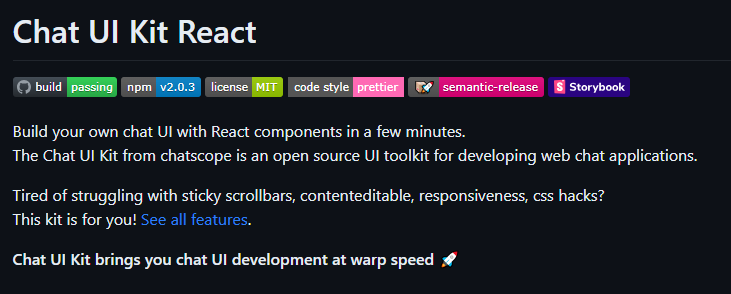 Chatscope 的聊天 UI 工具包是一個用於開發網頁聊天應用程式的開源 UI 工具包。 儘管該專案並未廣泛使用,但這些功能對於剛剛查看該專案的初學者來說還是很有用的。  開始使用以下 npm 指令。 ``` npm install @chatscope/chat-ui-kit-react ``` 這就是建立 GUI 的方法。 ``` import styles from '@chatscope/chat-ui-kit-styles/dist/default/styles.min.css'; import { MainContainer, ChatContainer, MessageList, Message, MessageInput } from '@chatscope/chat-ui-kit-react'; <div style={{ position:"relative", height: "500px" }}> <MainContainer> <ChatContainer> <MessageList> <Message model={{ message: "Hello my friend", sentTime: "just now", sender: "Joe" }} /> </MessageList> <MessageInput placeholder="Type message here" /> </ChatContainer> </MainContainer> </div> ``` 您可以閱讀[文件](https://chatscope.io/docs/)。 故事書中有更[詳細的文件](https://chatscope.io/storybook/react/?path=/docs/documentation-introduction--docs)。 它提供了一些方便的元件,例如[`TypingIndicator`](https://chatscope.io/storybook/react/?path=/docs/components-typingindicator--docs) 、 [`Multiline Incoming`](https://chatscope.io/storybook/react/?path=/story/components-message--multiline-incoming)等等。 我知道你們中的一些人更喜歡透過部落格來了解整個結構,因此你可以閱讀使用 Chat UI Kit React 的 Rollbar 的[如何將 ChatGPT 與 React 整合](https://rollbar.com/blog/how-to-integrate-chatgpt-with-react/)。 您可以看到的一些演示: - [聊天機器人使用者介面](https://mars.chatscope.io/) - [與朋友聊天](https://chatscope.io/demo/chat-friends/)- 看看這個!  https://github.com/chatscope/chat-ui-kit-react Star Chat UI Kit React ⭐️ --- 22. [Botonic](https://github.com/hubtype/botonic) - 用於建立會話應用程式的 React 框架。 -------------------------------------------------------------------------  Botonic 是一個全端 Javascript 框架,用於建立在多個平台上執行的聊天機器人和現代對話應用程式:Web、行動和訊息應用程式(Messenger、WhatsApp、Telegram 等)。它建構在 ⚛️ React、Serverless 和 Tensorflow.js 之上。 如果您不了解對話應用程式的概念,可以在[官方部落格](https://www.hubtype.com/blog/what-are-conversational-apps)上閱讀它們。 使用 Botonic,您可以建立包含最佳文字外介面(簡單性、自然語言互動)和圖形介面(多媒體、視覺上下文、豐富互動)的會話應用程式。 這是一個強大的組合,可以提供比僅依賴文字和 NLP 的傳統聊天機器人更好的用戶體驗。 這就是 Botonic 的簡單方式。 ``` export default class extends React.Component { static async botonicInit({ input, session, params, lastRoutePath }) { await humanHandOff(session)) } render() { return ( <Text> Thanks for contacting us! One of our agents will attend you as soon as possible. </Text> ) } } ``` 它們也支援 TypeScript,所以這是一個優點。 您可以看到一些使用 Botonic 建置的[範例](https://botonic.io/examples/)及其原始程式碼。 您可以閱讀[文件](https://botonic.io/docs/welcome)以及如何[從頭開始建立會話應用程式](https://botonic.io/docs/create-convapp)。 https://github.com/hubtype/botonic Star Botonic ⭐️ --- 23. [React Flowbite](https://github.com/themesberg/flowbite-react) - 為 Flowbite 和 Tailwind CSS 建構的 React 元件. ------------------------------------------------------------------------------------------------------------  每個人對他們想要用來建立網站的使用者介面都有不同的偏好。 Flowbite React 是 UI 元件的開源集合,在 React 中建置,具有來自 Tailwind CSS 的實用程式類,您可以將其用作使用者介面和網站的起點。 開始使用以下 npm 指令。 ``` npm i flowbite-react ``` 這是一起使用表格和鍵盤元件的方法。 ``` 'use client'; import { Kbd, Table } from 'flowbite-react'; import { MdKeyboardArrowDown, MdKeyboardArrowLeft, MdKeyboardArrowRight, MdKeyboardArrowUp } from 'react-icons/md'; function Component() { return ( <Table> <Table.Head> <Table.HeadCell>Key</Table.HeadCell> <Table.HeadCell>Description</Table.HeadCell> </Table.Head> <Table.Body className="divide-y"> <Table.Row className="bg-white dark:border-gray-700 dark:bg-gray-800"> <Table.Cell className="whitespace-nowrap font-medium text-gray-900 dark:text-white"> <Kbd>Shift</Kbd> <span>or</span> <Kbd>Tab</Kbd> </Table.Cell> <Table.Cell>Navigate to interactive elements</Table.Cell> </Table.Row> <Table.Row className="bg-white dark:border-gray-700 dark:bg-gray-800"> <Table.Cell className="whitespace-nowrap font-medium text-gray-900 dark:text-white"> <Kbd>Enter</Kbd> or <Kbd>Spacebar</Kbd> </Table.Cell> <Table.Cell>Ensure elements with ARIA role="button" can be activated with both key commands.</Table.Cell> </Table.Row> <Table.Row className="bg-white dark:border-gray-700 dark:bg-gray-800"> <Table.Cell className="whitespace-nowrap font-medium text-gray-900 dark:text-white"> <span className="inline-flex gap-1"> <Kbd icon={MdKeyboardArrowUp} /> <Kbd icon={MdKeyboardArrowDown} /> </span> <span> or </span> <span className="inline-flex gap-1"> <Kbd icon={MdKeyboardArrowLeft} /> <Kbd icon={MdKeyboardArrowRight} /> </span> </Table.Cell> <Table.Cell>Choose and activate previous/next tab.</Table.Cell> </Table.Row> </Table.Body> </Table> ); } ```  您可以閱讀[文件](https://www.flowbite-react.com/docs/getting-started/introduction)並查看[Storybook](https://storybook.flowbite-react.com/?path=/story/components-accordion--always-open)中的功能。您也可以查看[元件](https://www.flowbite-react.com/docs/components/accordion)清單。 在我看來,如果您想快速設定 UI,但又不想最終為高品質的開源專案使用預先定義的庫元件,那麼這很好。 該專案在 GitHub 上擁有超過 1,500 顆星,擁有超過 37,000 名開發者的用戶群,並受到社群的廣泛認可和信任,使其成為一個可靠的選擇。 https://github.com/themesberg/flowbite-react Star React Flowbite ⭐️ --- 24. [DND 套件](https://github.com/clauderic/dnd-kit)- 輕量級、高效能、可存取且可擴展的拖放功能。 -------------------------------------------------------------------------  這是一個強大的 React 拖放工具包,擁有可自訂的碰撞檢測、多個啟動器和自動滾動等功能。 它的設計考慮到了 React,提供了方便集成的鉤子,無需進行重大的架構更改。支援從清單到網格和虛擬化清單的各種用例,它既是動態的又是輕量級的,沒有外部相依性。 開始使用以下 npm 指令。 ``` npm install @dnd-kit/core ``` 這就是建立可拖放元件的方法。 `Example.jsx` ``` import React, {useState} from 'react'; import {DndContext} from '@dnd-kit/core'; import {Draggable} from './Draggable'; import {Droppable} from './Droppable'; function Example() { const [parent, setParent] = useState(null); const draggable = ( <Draggable id="draggable"> Go ahead, drag me. </Draggable> ); return ( <DndContext onDragEnd={handleDragEnd}> {!parent ? draggable : null} <Droppable id="droppable"> {parent === "droppable" ? draggable : 'Drop here'} </Droppable> </DndContext> ); function handleDragEnd({over}) { setParent(over ? over.id : null); } } ``` `Droppable.jsx` ``` import React from 'react'; import {useDroppable} from '@dnd-kit/core'; export function Droppable(props) { const {isOver, setNodeRef} = useDroppable({ id: props.id, }); const style = { opacity: isOver ? 1 : 0.5, }; return ( <div ref={setNodeRef} style={style}> {props.children} </div> ); } ``` `Draggable.jsx` ``` import React from 'react'; import {useDraggable} from '@dnd-kit/core'; import {CSS} from '@dnd-kit/utilities'; function Draggable(props) { const {attributes, listeners, setNodeRef, transform} = useDraggable({ id: props.id, }); const style = { // Outputs `translate3d(x, y, 0)` transform: CSS.Translate.toString(transform), }; return ( <button ref={setNodeRef} style={style} {...listeners} {...attributes}> {props.children} </button> ); } ``` 我將可拖曳元件放在可放置元件上。 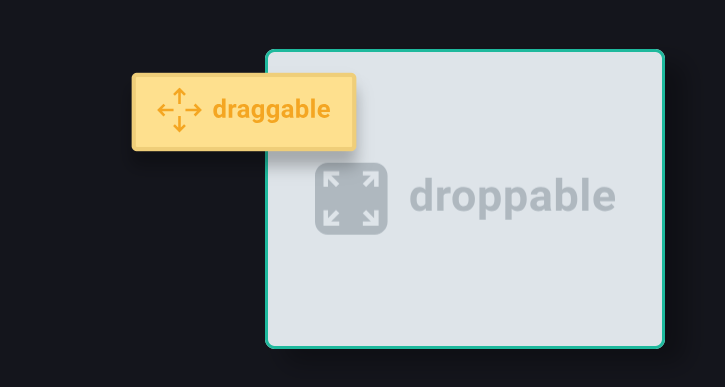 您可以閱讀[文件](https://docs.dndkit.com/)以及滑鼠和指標等[感測器的選項](https://docs.dndkit.com/introduction/installation#core-library)。 它在 GitHub 上擁有 10k+ Stars,並被 GitHub 上 47k+ 開發人員使用。 https://github.com/clauderic/dnd-kit 明星免打擾套件 ⭐️
我已經看過相當多的 React 教程,但是每當他們談論使用 React-router 進行導航時,他們都只展示使用 Link 元件的方式。一旦有人開始處理他/她自己的專案,他們遇到的第一個問題就是如何以程式設計方式進行路由,這基本上意味著除了點擊 \\ 中包含的內容之外的其他方式進行路由。成分。 這個部落格的主要目的是為那些來這裡尋找這個問題答案的人提供一個避難所。 --- 1.\\成分 ------ 我們可以使用 \\ 進行重定向只需傳遞我們想要重定向到的路由並渲染元件即可。它已經載入到react-router-dom 庫中。 ``` import { Redirect } from "react-router-dom"; ``` 使用此方法最簡單的方法是在元件狀態內維護重定向屬性。 ``` state = { redirect: null }; render() { if (this.state.redirect) { return <Redirect to={this.state.redirect} /> } return( // Your Code goes here ) } ``` 每當你想要重定向到另一個路徑時,你可以簡單地改變狀態來重新渲染元件,從而渲染\\成分。 ``` this.setState({ redirect: "/someRoute" }); ``` **筆記** 這是除 \\ 之外的建議導航方式。方法。 在帖子的最後詳細討論了。 這種方法的缺點是,當我們想要直接從 redux 操作重新導向時,我們無法這樣做。 --- 2.使用歷史鉤子 -------- 從 5.1.2 版本開始,react-router 附帶了一些新的鉤子,可以幫助我們存取路由器的狀態。 現在,我們只需要討論 useHistory 鉤子。 ``` import { useHistory } from "react-router-dom"; function App() { let history = useHistory(); } ``` 之後,我們可以使用 .push() 方法重定向到我們想要的任何路由。 ``` history.push('/someRoute') ``` --- 3.歷史道具 ------ 作為 \\ 的直接子級的每個元件元件接收歷史物件作為道具。這是保存 React Router 會話歷史記錄的同一個歷史記錄(庫)。因此,我們可以使用它的屬性來導航到所需的路徑。 ``` this.props.history.push("/first"); ``` 我們在這裡遇到的一個常見問題是,在不是 \\ 的直接子級的元件中元件中,不存在歷史道具。使用 withRouter 函數可以輕鬆解決這個問題。 ### 3.1.帶路由器 withRouter 是react-router-dom庫中提供的一個函數,它可以幫助我們存取不是 \\ 直接子級的元件中的歷史記錄道具成分。 使用 Router 導入 ``` import { withRouter } from "react-router-dom"; ``` 現在為了在我們的元件中取得歷史屬性,我們需要在匯出它時用 withRouter 包裝我們的元件。 ``` export default withRouter(yourComponent); ``` 我們現在可以像上面一樣存取歷史記錄來完成我們所需的導航。 --- 4.建立歷史 ------ 我們上面學到的方法可以涵蓋我們在建立 React 應用程式時遇到的大多數情況,那麼為什麼要使用第四種方法呢? 每次我們需要從 redux 操作重定向時,我們總是必須將歷史記錄傳遞給該操作,從而不必要地增加參數數量。因此,可以使用此方法來獲得更簡潔的程式碼。 在此方法中,我們建立自訂歷史記錄實例,可以將其匯入其他文件中以進行重定向。 ``` // Inside /utils/history.js import createHistory from "history/createBrowserHistory"; export default createHistory(); ``` 作為 \\使用它自己的歷史記錄並且不接受任何外部歷史記錄屬性,我們必須使用 \\而不是它。 ``` import { Router } from "react-router-dom"; import history from "./utils/history"; function App(){ return( <Router history={history}> // Your Routes go here <Router> ) } ``` 之後,我們可以將此歷史實例匯入到我們想要重新導向的任何檔案中。 ``` import history from "./utils/history"; history.push("/somePath"); ``` --- 筆記 -- 從本質上講,React 是一種建立 UI 的聲明式方法。 聲明式方法是一種表達計算邏輯而不描述其控制流或不描述幕後實際發生的情況的方法。 由於這個原因,推薦的導航方式除\\正在使用\\成分。 使用這裡提到的其他方法並沒有什麼壞處,只是它們並不完全符合 React 的願景。 --- 儲存庫 --- 我的 Github 個人資料上提供了上述方法的完整工作實作。如果有人想看到這些方法在專案中實際執行,請隨意探索。 {% github https://github.com/projectescape/blogs-reference %} --- --- 原文出處:https://dev.to/projectescape/programmatic-navigation-in-react-3p1l
下面的函數對於 Web 開發和 JavaScript 程式設計來說是基礎,它們簡化了任務,例如*使用新舊 console.log()***進行偵錯**、**操作 DOM 以及處理 JSON 資料。** 了解和使用這些函數就像*建立該語言的基礎支柱*一樣。 掌握這些工具也肯定會簡化編碼流程,進而帶來良好的開發人員體驗。 --- 長話短說 ---- **控制台和除錯** -> 控制台.log(...args) **定時** -> setTimeout(回呼, 延遲) -> setInterval(回呼, 間隔) **DOM 操作和事件處理** -> 查詢選擇器全部(選擇器) -> addEventListener(事件,回呼) **JSON 處理** -> JSON.parse(jsonString) -> JSON.stringify(物件) **陣列運算(高階函數)** -> forEach(回呼) -> 地圖(回呼) -> 過濾器(回調) -> 減少(回調,初始值) **陣列運算** -> 切片(開始,結束) -> 拼接(開始,刪除計數,...專案) ->indexOf(元素) -> 包含(元素) -> 排序(比較函數) -> 反向() -> isArray(值) **字串操作** -> 分割(分隔符號) -> 連接(分隔符號) -> toLowerCase(), toUpperCase() -> 修剪() --- 控制台和除錯: ------- ### 0️⃣1️⃣ console.log(...args) ⇒ 將訊息或物件輸出到控制台以進行偵錯。 ``` // console.log(...args) console.log("Hello World!"); ``` --- 定時: --- ### 0️⃣2️⃣ setTimeout(回呼、延遲) ⇒ 在指定的延遲(以毫秒為單位)後執行函數。 ### 0️⃣3️⃣ setInterval(回調,間隔) ⇒ 以指定的時間間隔重複執行某個功能。 ``` // setTimeout(callback, delay) setTimeout(function() { console.log("This message will appear after 3 seconds."); }, 3000); // Runs the anonymous function after 3000 milliseconds (3 seconds) // setInterval(callback, interval) function printCounter() { let count = 0; setInterval(function() { console.log("Count:", count++); }, 1000); } printCounter(); // Prints count every second ``` --- DOM 操作與事件處理: ------------ ### 0️⃣4️⃣ querySelectorAll(選擇器) ⇒ 傳回一個 NodeList,其中包含與指定選擇器相符的所有元素。 ### 0️⃣5️⃣ addEventListener(事件,回呼) ⇒ 將事件處理函數附加到 HTML 元素。 ``` // querySelectorAll(selector) console.log("querySelectorAll(selector)"); const container = document.getElementById('container'); const links = container.querySelectorAll('a'); // Accessing the href attribute of each link // Iterate over the NodeList links.forEach(link => { console.log(link.href); }); // addEventListener(event, callback) console.log("addEventListener(event, callback)"); const button = document.getElementById('myButton'); button.addEventListener('click', function() { console.log('Button clicked!'); }); ``` --- JSON 處理: -------- ### 0️⃣6️⃣ JSON.parse(jsonString) ⇒ 解析 JSON 字串並傳回 JavaScript 物件。 ### 0️⃣7️⃣ JSON.stringify(物件) ⇒ 將 JavaScript 物件轉換為 JSON 字串。 ``` // JSON.parse(jsonString) console.log("JSON.parse(jsonString)"); const jsonString = '{"name": "John", "age": 30, "city": "New York"}'; const jsonObject = JSON.parse(jsonString); console.log(jsonObject.name); // Output: John console.log(jsonObject.age); // Output: 30 console.log(jsonObject.city); // Output: New York // JSON.stringify(object) console.log("JSON.stringify(object)"); const person = { name: 'John', age: 30, city: 'New York' }; const jsonString2 = JSON.stringify(person); console.log(jsonString2); // Output: {"name":"John","age":30,"city":"New York"} ``` --- 陣列運算(高階函數): ----------- ### 0️⃣8️⃣ forEach(回呼) ⇒ 對每個陣列元素執行一次提供的函數。 ### 0️⃣9️⃣地圖(回調) ⇒ 使用對每個元素呼叫提供的函數的結果來建立一個新陣列。 ### 1️⃣0️⃣過濾器(回呼) ⇒ 建立一個新陣列,其中的元素滿足給定的條件。 ### 1️⃣1️⃣減少(回調,初始值) ⇒ 透過對每個元素應用函數將陣列縮減為單一值。 ``` const numbers = [1, 2, 3, 4, 5]; // forEach(callback) console.log("forEach:"); numbers.forEach(num => { console.log(num); }); // Output: // 1 // 2 // 3 // 4 // 5 // map(callback) const doubledNumbers = numbers.map(num => num * 2); // Output: [2, 4, 6, 8, 10] // filter(callback) const evenNumbers = numbers.filter(num => num % 2 === 0); // [2, 4] // reduce(callback, initialValue) const sum = numbers.reduce((accumulator, currentValue) => accumulator + currentValue, 0); // 15 ``` --- 陣列操作: ----- ### 1️⃣2️⃣片(開始,結束) ⇒ 傳回指定起始索引和結束索引之間的陣列部分的淺表副本。 ### 1️⃣3️⃣ 拼接(開始,刪除計數,...專案) ⇒ 透過刪除/取代元素和/或新增元素來變更陣列內容。 ### 1️⃣4️⃣indexOf(元素) ⇒ 傳回在陣列中可以找到給定元素的第一個索引,如果不存在則傳回 -1。 ### 1️⃣5️⃣包含(元素) ⇒ 判斷陣列是否包含某個元素,傳回 true 或 false。 ### 1️⃣6️⃣排序(比較函數) ⇒ 根據提供的函數或預設排序順序對陣列元素進行排序。 ### 1️⃣7️⃣反向() ⇒ 反轉陣列中元素的順序。 ### 1️⃣8️⃣ isArray(值) ⇒ 檢查給定值是否為陣列,傳回 true 或 false。 ``` // slice(start, end) const array = [1, 2, 3, 4, 5]; const slicedArray = array.slice(1, 4); console.log("slice:", slicedArray); // Output: [2, 3, 4] // splice(start, deleteCount, ...items) const spliceArray = [1, 2, 3, 4, 5]; spliceArray.splice(2, 2, 'a', 'b'); console.log("splice:", spliceArray); // Output: [1, 2, "a", "b", 5] // indexOf(element) const indexOfArray = ['apple', 'banana', 'cherry']; const indexOfCherry = indexOfArray.indexOf('cherry'); console.log("indexOf:", indexOfCherry); // Output: 2 // includes(element) const includesArray = [1, 2, 3, 4, 5]; const includesValue = includesArray.includes(3); console.log("includes:", includesValue); // Output: true // sort(compareFunction) const sortArray = [3, 1, 4, 1, 5]; sortArray.sort((a, b) => a - b); console.log("sort:", sortArray); // Output: [1, 1, 3, 4, 5] // reverse() const reverseArray = ['a', 'b', 'c', 'd']; reverseArray.reverse(); console.log("reverse:", reverseArray); // Output: ['d', 'c', 'b', 'a'] // isArray(value) const isArrayValue = [1, 2, 3]; const isArray = Array.isArray(isArrayValue); console.log("isArray:", isArray); // Output: true ``` --- 字串操作: ----- ### 1️⃣9️⃣分割(分隔符號) ⇒ 根據指定的分隔符號將字串分割為子字串陣列。 ### 2️⃣0️⃣加入(分隔符號) ⇒ 將陣列的所有元素連接成一個字串,並以指定的分隔符號分隔。 ### 2️⃣1️⃣ toLowerCase(), toUpperCase() ⇒ 將字串轉換為小寫或大寫。 ### 2️⃣2️⃣修剪() ⇒ 刪除字串兩端的空格。 ``` // split(separator) const sentence = "Hello, world! How are you?"; const words = sentence.split(' '); console.log("split:", words); // Output: ["Hello,", "world!", "How", "are", "you?"] // join(separator) const fruits = ['Apple', 'Banana', 'Orange']; const fruitString = fruits.join(', '); console.log("join:", fruitString); // Output: "Apple, Banana, Orange" // toLowerCase(), toUpperCase() const mixedCase = "Hello WoRLd"; const lowerCase = mixedCase.toLowerCase(); const upperCase = mixedCase.toUpperCase(); console.log("toLowerCase:", lowerCase); // Output: "hello world" console.log("toUpperCase:", upperCase); // Output: "HELLO WORLD" // trim() const stringWithWhitespace = " Hello, world! "; const trimmedString = stringWithWhitespace.trim(); console.log("trim:", trimmedString); // Output: "Hello, world!" ``` 🙌 最後的想法 ------- 當我們結束對上述功能的討論時,我請您分享您的見解。 **您認為在 Web 開發或主要是 JavaScript 專案中還需要哪些其他功能?** 請隨時在下面的評論中分享您的想法和有用的功能! 我希望你喜歡這篇文章! ❤️ 與我聯絡: [Linktree。](https://linktr.ee/arjuncodess/) 快樂編碼! 🚀 感謝22097! 🤗 --- 原文出處:https://dev.to/arjuncodess/18-javascript-functions-youll-use-99-of-the-time-2bl4
長話短說 ==== 我收集了您應該了解的 React 庫,以建立許多不同類型的專案並成為 React 奇才🧙♂️。 其中每一項都是獨一無二的,並且都有自己的用例。 別忘了給他們加星號🌟 讓我們開始吧!  --- 1. [CopilotKit](https://github.com/CopilotKit/CopilotKit) - 建立應用內人工智慧聊天機器人、代理程式和文字區域 ------------------------------------------------------------------------------------  將 AI 功能整合到 React 中是很困難的,這就是 Copilot 的用武之地。一個簡單快速的解決方案,可將可投入生產的 Copilot 整合到任何產品中! 您可以使用兩個 React 元件將關鍵 AI 功能整合到 React 應用程式中。它們還提供內建(完全可自訂)Copilot 原生 UX 元件,例如`<CopilotKit />` 、 `<CopilotPopup />` 、 `<CopilotSidebar />` 、 `<CopilotTextarea />` 。 開始使用以下 npm 指令。 ``` npm i @copilotkit/react-core @copilotkit/react-ui ``` Copilot Portal 是 CopilotKit 提供的元件之一,CopilotKit 是一個應用程式內人工智慧聊天機器人,可查看目前應用狀態並在應用程式內採取操作。它透過插件與應用程式前端和後端以及第三方服務進行通訊。 這就是整合聊天機器人的方法。 `CopilotKit`必須包裝與 CopilotKit 互動的所有元件。建議您也開始使用`CopilotSidebar` (您可以稍後切換到不同的 UI 提供者)。 ``` "use client"; import { CopilotKit } from "@copilotkit/react-core"; import { CopilotSidebar } from "@copilotkit/react-ui"; import "@copilotkit/react-ui/styles.css"; export default function RootLayout({children}) { return ( <CopilotKit url="/path_to_copilotkit_endpoint/see_below"> <CopilotSidebar> {children} </CopilotSidebar> </CopilotKit> ); } ``` 您可以使用此[快速入門指南](https://docs.copilotkit.ai/getting-started/quickstart-backend)設定 Copilot 後端端點。 之後,您可以讓 Copilot 採取行動。您可以閱讀如何提供[外部上下文](https://docs.copilotkit.ai/getting-started/quickstart-chatbot#provide-context)。您可以使用`useMakeCopilotReadable`和`useMakeCopilotDocumentReadable`反應掛鉤來執行此操作。 ``` "use client"; import { useMakeCopilotActionable } from '@copilotkit/react-core'; // Let the copilot take action on behalf of the user. useMakeCopilotActionable( { name: "setEmployeesAsSelected", // no spaces allowed in the function name description: "Set the given employees as 'selected'", argumentAnnotations: [ { name: "employeeIds", type: "array", items: { type: "string" } description: "The IDs of employees to set as selected", required: true } ], implementation: async (employeeIds) => setEmployeesAsSelected(employeeIds), }, [] ); ``` 您可以閱讀[文件](https://docs.copilotkit.ai/getting-started/quickstart-textarea)並查看[演示影片](https://github.com/CopilotKit/CopilotKit?tab=readme-ov-file#demo)。 您可以輕鬆整合 Vercel AI SDK、OpenAI API、Langchain 和其他 LLM 供應商。您可以按照本[指南](https://docs.copilotkit.ai/getting-started/quickstart-chatbot)將聊天機器人整合到您的應用程式中。 基本概念是在幾分鐘內建立可用於基於 LLM 的應用程式的 AI 聊天機器人。 用例是巨大的,作為開發人員,我們絕對應該在下一個專案中嘗試使用 CopilotKit。 https://github.com/CopilotKit/CopilotKit Star CopilotKit ⭐️ --- 2. [xyflow](https://github.com/xyflow/xyflow) - 使用 React 建立基於節點的 UI。 --------------------------------------------------------------------  XYFlow 是一個功能強大的開源程式庫,用於使用 React 或 Svelte 建立基於節點的 UI。它是一個 monorepo,提供[React Flow](https://reactflow.dev)和[Svelte Flow](https://svelteflow.dev) 。讓我們更多地了解可以使用 React flow 做什麼。  您可以觀看此影片,在 60 秒內了解 React Flow。 https://www.youtube.com/watch?v=aUBWE41a900 有些功能在專業模式下可用,但免費層中的功能足以形成一個非常互動的流程。 React 流程以 TypeScript 編寫並使用 Cypress 進行測試。 開始使用以下 npm 指令。 ``` npm install reactflow ``` 以下介紹如何建立兩個節點( `Hello`和`World` ,並透過邊連接。節點具有預先定義的初始位置以防止重疊,並且我們還應用樣式來確保有足夠的空間來渲染圖形。 ``` import ReactFlow, { Controls, Background } from 'reactflow'; import 'reactflow/dist/style.css'; const edges = [{ id: '1-2', source: '1', target: '2' }]; const nodes = [ { id: '1', data: { label: 'Hello' }, position: { x: 0, y: 0 }, type: 'input', }, { id: '2', data: { label: 'World' }, position: { x: 100, y: 100 }, }, ]; function Flow() { return ( <div style={{ height: '100%' }}> <ReactFlow nodes={nodes} edges={edges}> <Background /> <Controls /> </ReactFlow> </div> ); } export default Flow; ``` 這就是它的樣子。您還可以新增標籤、更改類型並使其具有互動性。 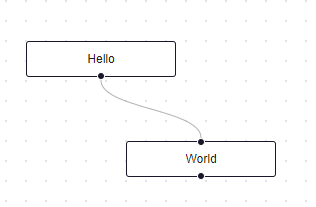 您可以在 React Flow 的 API 參考中查看[完整的選項清單](https://reactflow.dev/api-reference/react-flow)以及元件、鉤子和實用程式。 最好的部分是您還可以加入[自訂節點](https://reactflow.dev/learn/customization/custom-nodes)。在您的自訂節點中,您可以渲染您想要的一切。您可以定義多個來源和目標句柄並呈現表單輸入或圖表。您可以查看此[codesandbox](https://codesandbox.io/p/sandbox/pensive-field-z4kv3w?file=%2FApp.js&utm_medium=sandpack)作為範例。 您可以閱讀[文件](https://reactflow.dev/learn)並查看 Create React App、Next.js 和 Remix 的[範例 React Flow 應用程式](https://github.com/xyflow/react-flow-example-apps)。 React Flow 附帶了幾個額外的[插件](https://reactflow.dev/learn/concepts/plugin-components)元件,可以幫助您使用 Background、Minimap、Controls、Panel、NodeToolbar 和 NodeResizer 元件製作更高級的應用程式。 例如,您可能已經注意到許多網站的背景中有圓點,增強了美觀性。要實現此模式,您可以簡單地使用 React Flow 中的後台元件。 ``` import { Background } from 'reactflow'; <Background color="#ccc" variant={'dots'} /> // this will be under React Flow component. Just an example. ```  如果您正在尋找一篇快速文章,我建議您查看 Webkid 的[React Flow - A Library for Rendering Interactive Graphs](https://webkid.io/blog/react-flow-node-based-graph-library/) 。 React Flow 由 Webkid 開發和維護。 它在 GitHub 上有超過 19k 顆星,並且在`v11.10.4`上顯示它們正在不斷改進,npm 套件每週下載量超過 40 萬次。您可以輕鬆使用的最佳專案之一。  https://github.com/xyflow/xyflow 星 xyflow ⭐️ --- 3. [Zod](https://github.com/colinhacks/zod) + [React Hook Form](https://github.com/react-hook-form) - 致命的驗證組合。 -------------------------------------------------------------------------------------------------------------- 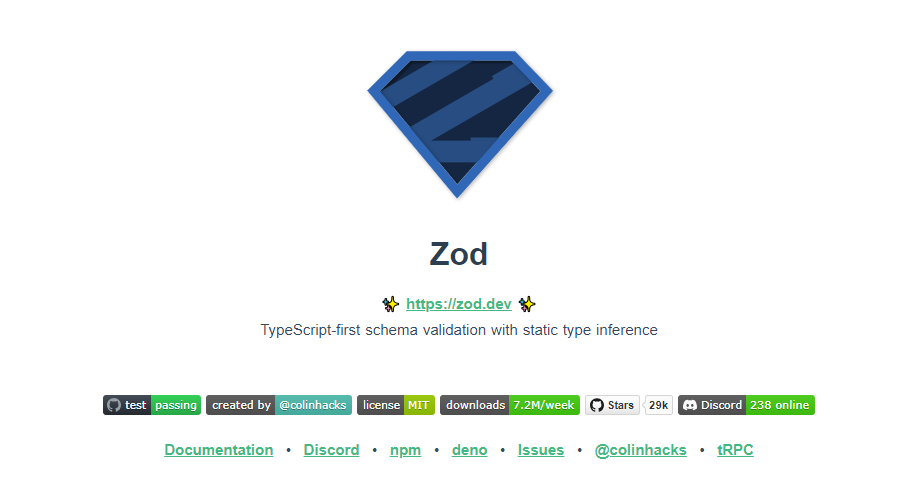 第一個問題是:為什麼我在同一個選項中包含 Zod 和 React Hook 表單?好吧,請閱讀它來找出答案。 Zod 的目標是透過最大限度地減少重複的類型聲明來對開發人員友好。使用 Zod,您聲明一次驗證器,Zod 將自動推斷靜態 TypeScript 類型。將更簡單的類型組合成複雜的資料結構很容易。 開始使用以下 npm 指令。 ``` npm install zod ``` 這是您在建立字串架構時自訂一些常見錯誤訊息的方法。 ``` const name = z.string({ required_error: "Name is required", invalid_type_error: "Name must be a string", }); ``` ``` // It does provide lots of options // validations z.string().min(5, { message: "Must be 5 or more characters long" }); z.string().max(5, { message: "Must be 5 or fewer characters long" }); z.string().length(5, { message: "Must be exactly 5 characters long" }); z.string().email({ message: "Invalid email address" }); z.string().url({ message: "Invalid url" }); z.string().emoji({ message: "Contains non-emoji characters" }); z.string().uuid({ message: "Invalid UUID" }); z.string().includes("tuna", { message: "Must include tuna" }); z.string().startsWith("https://", { message: "Must provide secure URL" }); z.string().endsWith(".com", { message: "Only .com domains allowed" }); z.string().datetime({ message: "Invalid datetime string! Must be UTC." }); z.string().ip({ message: "Invalid IP address" }); ``` 請閱讀[文件](https://zod.dev/)以了解有關 Zod 的更多資訊。 它適用於 Node.js 和所有現代瀏覽器。 現在,第二部分來了。 有很多可用的表單整合。 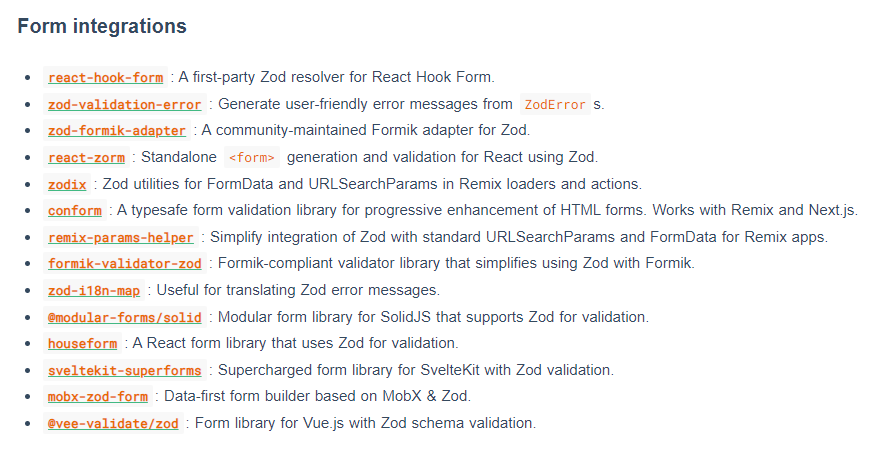 雖然 Zod 可以驗證物件,但如果沒有自訂邏輯,它不會影響您的用戶端和後端。 React-hook-form 是用於客戶端驗證的優秀專案。例如,它可以顯示輸入錯誤。  開始使用以下 npm 指令。 ``` npm install react-hook-form ``` 這就是如何使用`React Hook Form` 。 ``` import { useForm, SubmitHandler } from "react-hook-form" type Inputs = { example: string exampleRequired: string } export default function App() { const { register, handleSubmit, watch, formState: { errors }, } = useForm<Inputs>() const onSubmit: SubmitHandler<Inputs> = (data) => console.log(data) console.log(watch("example")) // watch input value by passing the name of it return ( /* "handleSubmit" will validate your inputs before invoking "onSubmit" */ <form onSubmit={handleSubmit(onSubmit)}> {/* register your input into the hook by invoking the "register" function */} <input defaultValue="test" {...register("example")} /> {/* include validation with required or other standard HTML validation rules */} <input {...register("exampleRequired", { required: true })} /> {/* errors will return when field validation fails */} {errors.exampleRequired && <span>This field is required</span>} <input type="submit" /> </form> ) } ``` 您甚至可以隔離重新渲染,從而提高整體效能。 您可以閱讀[文件](https://react-hook-form.com/get-started)。 兩者結合起來就是一個很好的組合。嘗試一下! 我透過 Shadcn 發現了它,它使用它作為表單元件的預設值。我自己在幾個專案中使用過它,效果非常好。它提供了很大的靈活性,這確實很有幫助。 https://github.com/colinhacks/zod Star Zod ⭐️ https://github.com/react-hook-form Star React Hook Form ⭐️ --- 4. [React DND](https://github.com/react-dnd/react-dnd) - 用於 React 的拖放。 ---------------------------------------------------------------------- 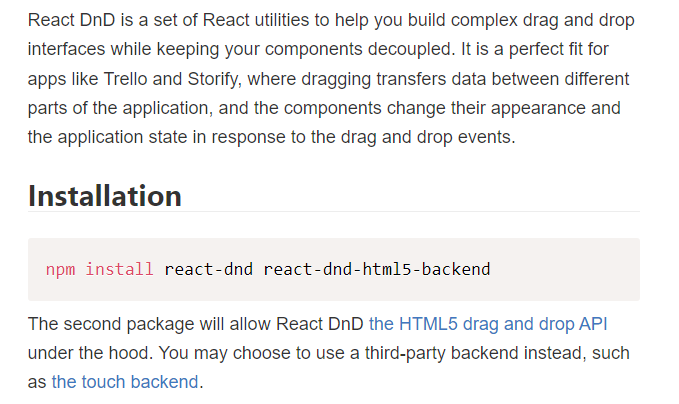 我還沒有完全實現拖放功能,而且我經常發現自己對選擇哪個選項感到困惑。我遇到的另一個選擇是[interactjs.io](https://interactjs.io/) ,根據我讀過的文件,它似乎非常有用。由於他們提供了詳細的範例,這非常容易。  但我現在只介紹 React DND。 開始使用以下 npm 指令。 ``` npm install react-dnd react-dnd-html5-backend ``` 除非您正在編寫自訂後端,否則您可能想要使用 React DnD 隨附的 HTML5 後端。 這是安裝`react-dnd-html5-backend`方法。閱讀[文件](https://react-dnd.github.io/react-dnd/docs/backends/html5)。 這是起點。 ``` import { HTML5Backend } from 'react-dnd-html5-backend' import { DndProvider } from 'react-dnd' export default class YourApp { render() { return ( <DndProvider backend={HTML5Backend}> /* Your Drag-and-Drop Application */ </DndProvider> ) } } ``` 透過這種方式,您可以非常輕鬆地實現卡片的拖放操作。 ``` // Let's make <Card text='Write the docs' /> draggable! import React from 'react' import { useDrag } from 'react-dnd' import { ItemTypes } from './Constants' export default function Card({ isDragging, text }) { const [{ opacity }, dragRef] = useDrag( () => ({ type: ItemTypes.CARD, item: { text }, collect: (monitor) => ({ opacity: monitor.isDragging() ? 0.5 : 1 }) }), [] ) return ( <div ref={dragRef} style={{ opacity }}> {text} </div> ) } ``` 請注意,HTML5 後端不支援觸控事件。因此它不適用於平板電腦和行動裝置。您可以將`react-dnd-touch-backend`用於觸控裝置。閱讀[文件](https://react-dnd.github.io/react-dnd/docs/backends/touch)。 ``` import { TouchBackend } from 'react-dnd-touch-backend' import { DndProvider } from 'react-dnd' class YourApp { <DndProvider backend={TouchBackend} options={opts}> {/* Your application */} </DndProvider> } ``` 這個codesandbox規定了我們如何正確使用React DND。 https://codesandbox.io/embed/3y5nkyw381?view=Editor+%2B+Preview&module=%2Fsrc%2Findex.tsx&hidenavigation=1 你可以看看React DND的[例子](https://react-dnd.github.io/react-dnd/examples)。 它們甚至有一個乾淨的功能,您可以使用 Redux 檢查內部發生的情況。 您可以透過為提供者新增 debugModeprop 來啟用[Redux DevTools](https://github.com/reduxjs/redux-devtools) ,其值為 true。 ``` <DndProvider debugMode={true} backend={HTML5Backend}> ``` 它提供了多種元件選項,我需要親自測試一下。總的來說,這看起來相當不錯,特別是如果你剛開始的話。 React DND 已獲得`MIT`許可,並在 GitHub 上擁有超過 20k Stars,這使其具有令人難以置信的可信度。 https://github.com/react-dnd/react-dnd Star React DND ⭐️ --- 5. [Cypress](https://github.com/cypress-io/cypress) - 快速測試瀏覽器中執行的內容。 --------------------------------------------------------------------  近年來已經證明了測試的重要性,而 Jest 和 Cypress 等選項使其變得異常簡單。 但我們只會介紹 Cypress,因為它本身就很方便。 只需一張圖片就能證明 Cypress 值得付出努力。 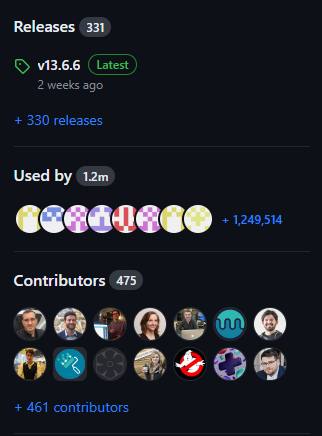 開始使用以下 npm 指令。 ``` npm install cypress -D ``` 如果您在專案中沒有使用 Node 或套件管理器,或者您想快速試用 Cypress,您始終可以[直接從 CDN 下載 Cypress](https://download.cypress.io/desktop) 。 一旦安裝並打開它。您必須使用`.cy.js`建立一個規範檔案。 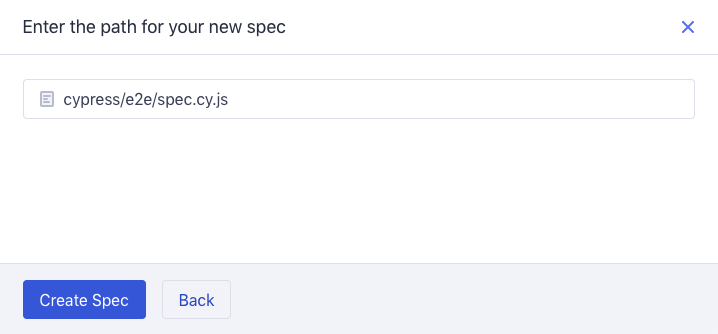 現在,您可以編寫並測試您的應用程式(範例程式碼)。 ``` describe('My First Test', () => { it('Does not do much!', () => { expect(true).to.equal(true) }) }) ``` Cypress 提供了多種選項,例如`cy.visit()`或`cy.contains()` 。由於我沒有廣泛使用 Cypress,因此您需要在其[文件](https://docs.cypress.io/guides/end-to-end-testing/writing-your-first-end-to-end-test)中進一步探索它。 如果它看起來很可怕,那麼請前往這個[為初學者解釋 Cypress 的](https://www.youtube.com/watch?v=u8vMu7viCm8&pp=ygUQY3lwcmVzcyB0dXRvcmlhbA%3D%3D)freeCodeCamp 教程。 Freecodecamp 影片確實是金礦 :D Cypress 在 GitHub 上擁有超過 45,000 顆星,並且在目前的 v13 版本中,它正在不斷改進。 https://github.com/cypress-io/cypress 星柏 ⭐️ --- [6.Refine](https://github.com/refinedev/refine) - 面向企業的開源 Retool。 ----------------------------------------------------------------- 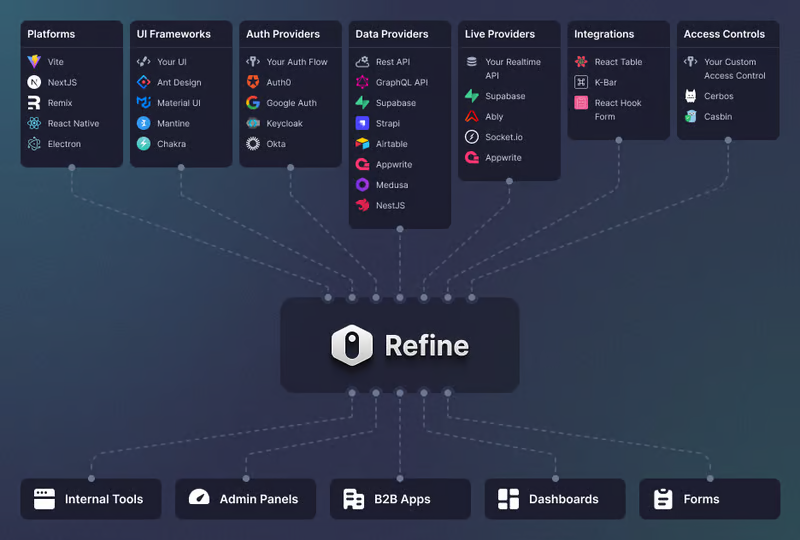 Refine 是一個元 React 框架,可以快速開發各種 Web 應用程式。 從內部工具到管理面板、B2B 應用程式和儀表板,它可作為建立任何類型的 CRUD 應用程式(例如 DevOps 儀表板、電子商務平台或 CRM 解決方案)的全面解決方案。  您可以在一分鐘內使用單一 CLI 命令進行設定。 它具有適用於 15 多個後端服務的連接器,包括 Hasura、Appwrite 等。 您可以查看可用的[整合清單](https://refine.dev/integrations/)。 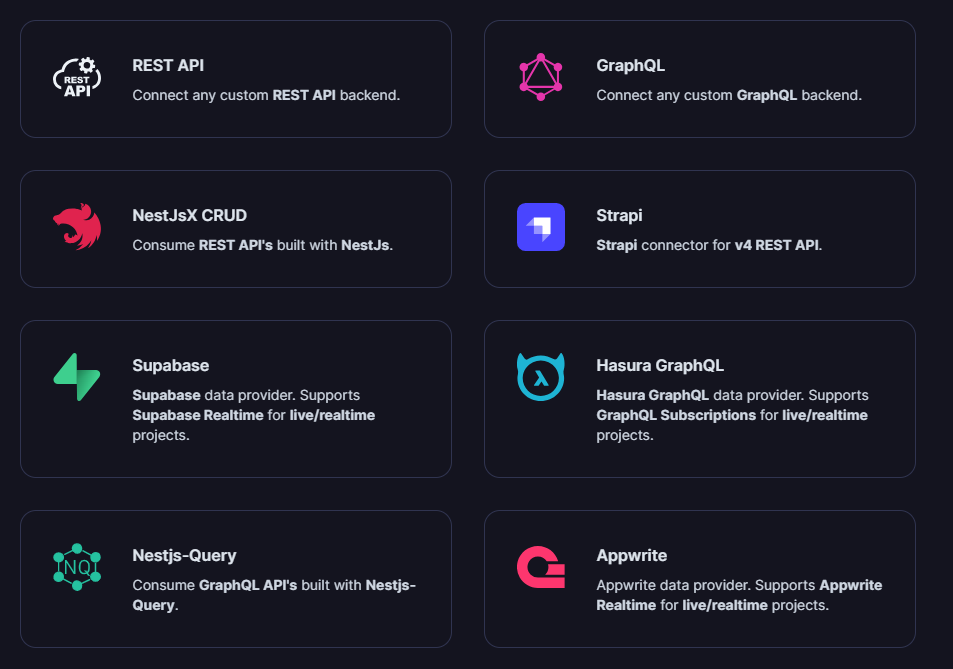 但最好的部分是,Refine `headless by design` ,從而提供無限的樣式和自訂選項。 由於該架構,您可以使用流行的 CSS 框架(如 TailwindCSS)或從頭開始建立樣式。 這是最好的部分,因為我們不希望最終受到與特定庫的兼容性的樣式限制,因為每個人都有自己的風格並使用不同的 UI。 開始使用以下 npm 指令。 ``` npm create refine-app@latest ``` 這就是使用 Refine 新增登入資訊的簡單方法。 ``` import { useLogin } from "@refinedev/core"; const { login } = useLogin(); ``` 使用 Refine 概述程式碼庫的結構。 ``` const App = () => ( <Refine dataProvider={dataProvider} resources={[ { name: "blog_posts", list: "/blog-posts", show: "/blog-posts/show/:id", create: "/blog-posts/create", edit: "/blog-posts/edit/:id", }, ]} > /* ... */ </Refine> ); ``` 您可以閱讀[文件](https://refine.dev/docs/)。 您可以看到一些使用 Refine 建立的範例應用程式: - [全功能管理面板](https://example.admin.refine.dev/) - [優化不同的用例場景](https://github.com/refinedev/refine/tree/master/examples)。 他們甚至提供模板,這就是為什麼這麼多用戶喜歡Refine。 你可以看到[模板](https://refine.dev/templates/)。  他們在 GitHub 上擁有大約 22k+ 顆星。 https://github.com/refinedev/refine 星際精煉 ⭐️ --- 7. [Tremor](https://github.com/tremorlabs/tremor) - React 元件來建立圖表和儀表板。 ----------------------------------------------------------------------  Tremor 提供了 20 多個開源 React 元件,用於建立基於 Tailwind CSS 的圖表和儀表板,使資料視覺化再次變得簡單。  開始使用以下 npm 指令。 ``` npm i @tremor/react ``` 這就是您如何使用 Tremor 快速建立東西。 ``` import { Card, ProgressBar } from '@tremor/react'; export default function Example() { return ( <Card className="mx-auto max-w-md"> <h4 className="text-tremor-default text-tremor-content dark:text-dark-tremor-content"> Sales </h4> <p className="text-tremor-metric font-semibold text-tremor-content-strong dark:text-dark-tremor-content-strong"> $71,465 </p> <p className="mt-4 flex items-center justify-between text-tremor-default text-tremor-content dark:text-dark-tremor-content"> <span>32% of annual target</span> <span>$225,000</span> </p> <ProgressBar value={32} className="mt-2" /> </Card> ); } ``` 這就是基於此生成的內容。  您可以閱讀[文件](https://www.tremor.so/docs/getting-started/installation)。其間,他們在引擎蓋下使用混音圖標。 從我見過的各種元件來看,這是一個很好的起點。相信我! Tremor 還提供了一個[乾淨的 UI 工具包](https://www.figma.com/community/file/1233953507961010067)。多麼酷啊!  Tremor 在 GitHub 上擁有超過 14k 顆星,並有超過 280 個版本,這意味著它正在不斷改進。 https://github.com/tremorlabs/tremor 星震 ⭐️ --- 8. [Watermelon DB](https://github.com/Nozbe/WatermelonDB) - 用於 React 和 React Native 的反應式和非同步資料庫。 ------------------------------------------------------------------------------------------------  我不知道為什麼資料庫有這麼多選項;甚至很難全部數清。但如果我們使用 React,Watermelon DB 是一個不錯的選擇。即使在 4k+ 提交之後,它們仍然處於`v0.28`版本,這是一個相當大的問題。 Rocket.chat 使用 Watermelon DB,這給了他們巨大的可信度。 開始使用以下 npm 指令。 ``` npm install @nozbe/watermelondb ``` 您需要做的第一件事是建立模型和後續遷移(閱讀文件)。 ``` import { appSchema, tableSchema } from '@nozbe/watermelondb' export default appSchema({ version: 1, tables: [ // We'll add to tableSchemas here ] }) ``` 根據文件,使用 WatermelonDB 時,您正在處理模型和集合。然而,在 Watermelon 之下有一個底層資料庫(SQLite 或 LokiJS),它使用不同的語言:表格和欄位。這些一起稱為資料庫模式。 您可以閱讀有關[CRUD 操作的](https://watermelondb.dev/docs/CRUD)[文件](https://watermelondb.dev/docs/Installation)和更多內容。 https://github.com/Nozbe/WatermelonDB 明星 WatermelonDB ⭐️ --- 9. [Evergreen UI](https://github.com/segmentio/evergreen) - 按 Segment 劃分的 React UI 框架。 --------------------------------------------------------------------------------------  沒有 UI 框架的清單幾乎是不可能的。有許多受歡迎的選項,例如 Material、Ant Design、Next UI 等等。 但我們正在報道 Evergreen,它本身就非常好。 開始使用以下 npm 指令。 ``` $ npm install evergreen-ui ``` [Evergreen Segment 網站](https://evergreen.segment.com/foundations)上顯示了任何使用者介面的基礎以及詳細的選項。 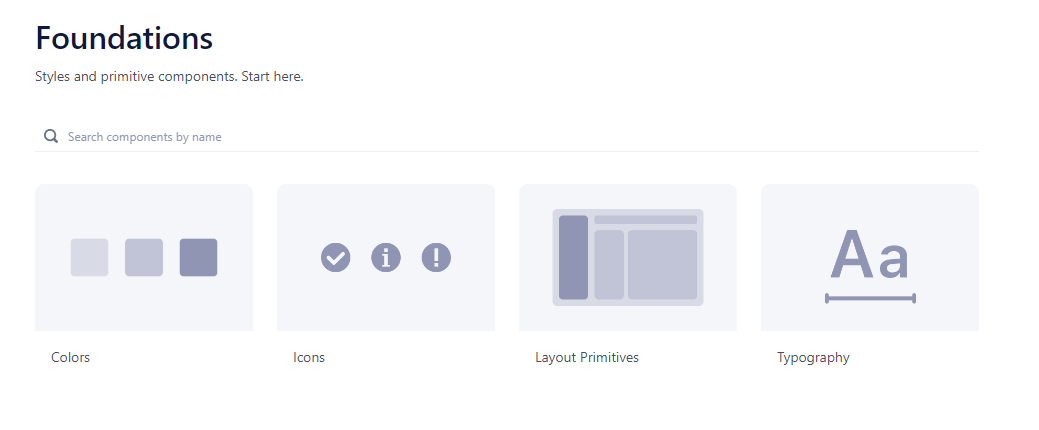 它提供了很多元件,其中一些非常好,例如`Tag Input`或`File uploader` 。  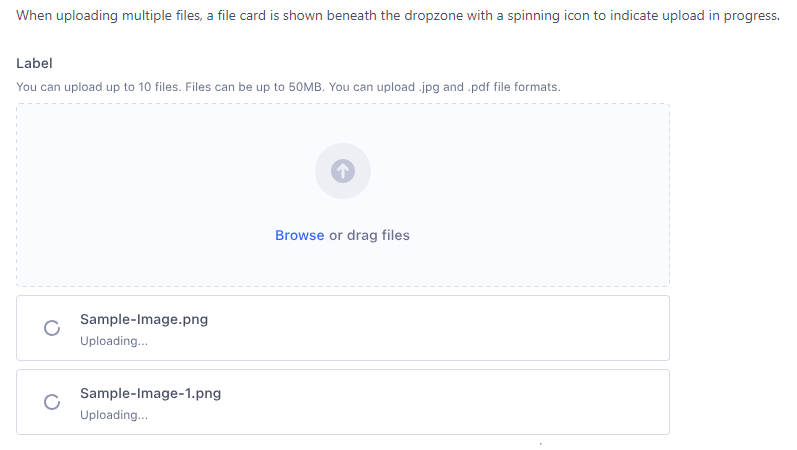 您可以看到 Evergreen UI 提供的所有[元件](https://evergreen.segment.com/components)。 https://github.com/segmentio/evergreen Star Evergreen UI ⭐️ --- 10. [React Spring](https://www.react-spring.dev/) - 流暢的動畫來提升 UI 和互動。 -------------------------------------------------------------------- 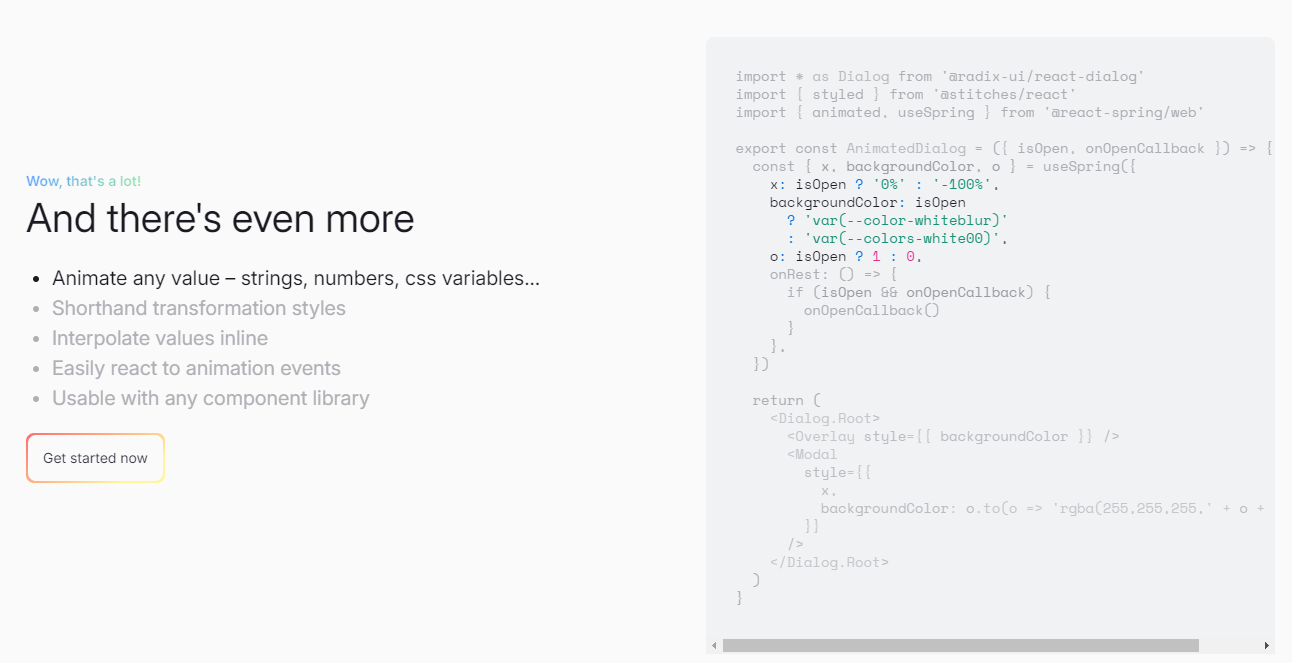  如果您喜歡 React-Motion 但感覺過渡不流暢,那是因為它專門使用 React 渲染。 如果你喜歡 Popmotion,但感覺自己的能力受到限制,那是因為它完全跳過了 React 渲染。 `react-spring`提供了兩種選擇,試試看! 開始使用以下 npm 指令。 ``` npm i @react-spring/web ``` 這就是導入高階元件來包裝動畫的方法。 ``` import { animated } from '@react-spring/web' // use it. export default function MyComponent() { return ( <animated.div style={{ width: 80, height: 80, background: '#ff6d6d', borderRadius: 8, }} /> ) } ``` 由於以下程式碼和框,我決定嘗試 React Spring。令人驚訝的是,我們可以使用 React Spring 做很多事情。 https://codesandbox.io/embed/mdovb?view=Editor+%2B+Preview&module=%2Fsrc%2Findex.tsx&hidenavigation=1 您可以閱讀[文件](https://www.react-spring.dev/docs/getting-started)。 他們還提供了很多您可以學習的[範例](https://www.react-spring.dev/examples)。  它提供了大量的選項,例如`useScroll` ,它允許您建立滾動連結動畫。 例如,這個codesandbox告訴了`useScroll`的用法。 https://codesandbox.io/embed/b07dmz?view=Editor+%2B+Preview&module=%2Fsrc%2Findex.tsx&hidenavigation=1 React Spring 在 GitHub 上有大約 27k+ Stars。 https://github.com/pmndrs/react-spring Star React Spring ⭐️ --- 11. [React Tweet](https://github.com/vercel/react-tweet) - 將推文嵌入到你的 React 應用程式中。 --------------------------------------------------------------------------------  `React Tweet`可讓您在使用 Next.js、Create React App、Vite 等時將推文嵌入到 React 應用程式中。 該函式庫不需要使用 Twitter API。推文可以靜態呈現,從而無需包含 iframe 和額外的客戶端 JavaScript。 它是 Vercel 的開源專案。 開始使用以下 npm 指令。 ``` npm i react-tweet ``` 為了顯示推文,我們需要從 Twitter 的 API 請求資料。透過此 API 進行速率限制具有挑戰性,但如果您僅依賴我們提供的 SWR 端點 ( `react-tweet.vercel.app/api/tweet/:id` ),這是可能的,因為伺服器的IP 位址向Twitter 發出了許多請求API。這也適用於 RSC,其中 API 端點不是必需的,但伺服器仍然從相同 IP 位址發送請求。 為了避免 API 限制,您可以使用 Redis 或 Vercel KV 等資料庫快取推文。例如,您可以使用 Vercel KV。 ``` import { Suspense } from 'react' import { TweetSkeleton, EmbeddedTweet, TweetNotFound } from 'react-tweet' import { fetchTweet, Tweet } from 'react-tweet/api' import { kv } from '@vercel/kv' async function getTweet( id: string, fetchOptions?: RequestInit ): Promise<Tweet | undefined> { try { const { data, tombstone, notFound } = await fetchTweet(id, fetchOptions) if (data) { await kv.set(`tweet:${id}`, data) return data } else if (tombstone || notFound) { // remove the tweet from the cache if it has been made private by the author (tombstone) // or if it no longer exists. await kv.del(`tweet:${id}`) } } catch (error) { console.error('fetching the tweet failed with:', error) } const cachedTweet = await kv.get<Tweet>(`tweet:${id}`) return cachedTweet ?? undefined } const TweetPage = async ({ id }: { id: string }) => { try { const tweet = await getTweet(id) return tweet ? <EmbeddedTweet tweet={tweet} /> : <TweetNotFound /> } catch (error) { console.error(error) return <TweetNotFound error={error} /> } } const Page = ({ params }: { params: { tweet: string } }) => ( <Suspense fallback={<TweetSkeleton />}> <TweetPage id={params.tweet} /> </Suspense> ) export default Page ``` 您可以直接使用它,方法非常簡單。 ``` <div className="dark"> <Tweet id="1629307668568633344" /> </div> ``` 如果您不喜歡使用 Twitter 主題,您也可以使用多個選項建立自己的[自訂主題](https://react-tweet.vercel.app/custom-theme)。 例如,您可以建立自己的推文元件,但沒有回覆按鈕,如下所示: ``` import type { Tweet } from 'react-tweet/api' import { type TwitterComponents, TweetContainer, TweetHeader, TweetInReplyTo, TweetBody, TweetMedia, TweetInfo, TweetActions, QuotedTweet, enrichTweet, } from 'react-tweet' type Props = { tweet: Tweet components?: TwitterComponents } export const MyTweet = ({ tweet: t, components }: Props) => { const tweet = enrichTweet(t) return ( <TweetContainer> <TweetHeader tweet={tweet} components={components} /> {tweet.in_reply_to_status_id_str && <TweetInReplyTo tweet={tweet} />} <TweetBody tweet={tweet} /> {tweet.mediaDetails?.length ? ( <TweetMedia tweet={tweet} components={components} /> ) : null} {tweet.quoted_tweet && <QuotedTweet tweet={tweet.quoted_tweet} />} <TweetInfo tweet={tweet} /> <TweetActions tweet={tweet} /> {/* We're not including the `TweetReplies` component that adds the reply button */} </TweetContainer> ) } ``` 您可以閱讀[文件](https://react-tweet.vercel.app/#installation)。 您可以查看[React Tweet 的演示,](https://react-tweet-next.vercel.app/light/1761133168772489698)以了解它如何在頁面上呈現。 它們已發布`v3.2`版本,這表明它們正在不斷改進,並且[每週下載量超過 46k+](https://www.npmjs.com/package/react-tweet) 。 https://github.com/vercel/react-tweet Star React 推文 ⭐️ --- 12. [React 360](https://github.com/facebookarchive/react-360) - 使用 React 建立令人驚嘆的 360 度和 VR 內容。 ----------------------------------------------------------------------------------------------  儘管 Facebook 已將其存檔,但許多開發人員仍然發現它足夠有用,因此繼續使用。 React 360 是一個函式庫,它利用大量 React Native 功能來建立在 Web 瀏覽器中執行的虛擬實境應用程式。 它使用 Three.js 進行渲染,並作為 npm 套件提供。透過將 WebGL 和 WebVR 等現代 API 與 React 的聲明性功能結合,React 360 有助於簡化建立跨平台 VR 體驗的過程。 開始使用以下 npm 指令。 ``` npm install -g react-360-cli ``` 涉及的事情有很多,但您可以使用 VrButton 加入重要的互動功能到您的 React VR 應用程式。 ``` import { AppRegistry, StyleSheet, Text, View, VrButton } from 'react-360'; state = { count: 0 }; _incrementCount = () => { this.setState({ count: this.state.count + 1 }) } <View style={styles.panel}> <VrButton onClick={this._incrementCount} style={styles.greetingBox}> <Text style={styles.greeting}> {`You have visited Simmes ${this.state.count} times`} </Text> </VrButton> </View> ``` 除了許多令人驚奇的東西之外,您還可以加入聲音。請參閱[使用 React 360 的 React Resources](https://reactresources.com/topics/react-360)範例。 您也可以閱讀 Log Rocket 撰寫的關於[使用 React 360 建立 VR 應用](https://blog.logrocket.com/building-a-vr-app-with-react-360/)程式的部落格。 這個codesandbox代表了我們可以使用React 360做什麼的一個常見範例。 https://codesandbox.io/embed/2bye27?view=Editor+%2B+Preview&module=%2Fsrc%2Findex.js&hidenavigation=1 https://github.com/facebookarchive/react-360 Star React 360 ⭐️ --- 13. [React Advanced Cropper](https://github.com/advanced-cropper/react-advanced-cropper) - 建立適合您網站的裁剪器。 -------------------------------------------------------------------------------------------------------   React Advanced Cropper 是一個高級庫,可讓您建立適合任何網站設計的裁剪器。這意味著您不僅可以更改裁剪器的外觀,還可以自訂其行為。 它們仍處於測試版本,這意味著 API 可能會在未來版本中發生變化。 簡單的用例是設計軟體和裁剪圖像表面以獲得進一步的見解。 他們有很多選擇,因此值得。 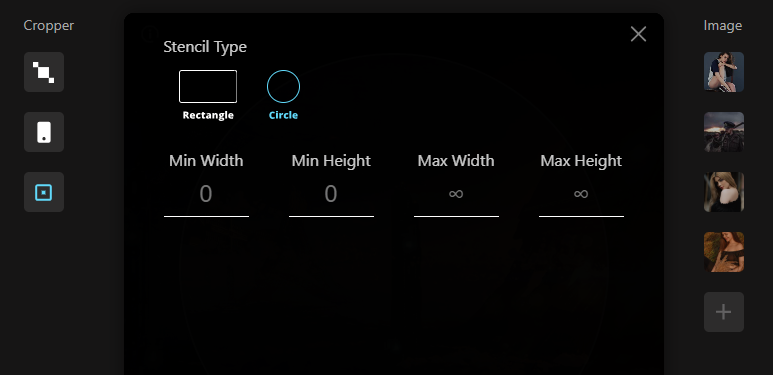  開始使用以下 npm 指令。 ``` npm install --save react-advanced-cropper ``` 您可以這樣使用它。 ``` import React, { useState } from 'react'; import { CropperRef, Cropper } from 'react-advanced-cropper'; import 'react-advanced-cropper/dist/style.css' export const GettingStartedExample = () => { const [image, setImage] = useState( 'https://images.unsplash.com/photo-1599140849279-1014532882fe?ixlib=rb-1.2.1&ixid=eyJhcHBfaWQiOjEyMDd9&auto=format&fit=crop&w=1300&q=80', ); const onChange = (cropper: CropperRef) => { console.log(cropper.getCoordinates(), cropper.getCanvas()); }; return ( <Cropper src={image} onChange={onChange} className={'cropper'} /> ) }; ``` 您可以閱讀[文件](https://advanced-cropper.github.io/react-advanced-cropper/docs/intro),它們提供了[20 多個自訂選項](https://github.com/advanced-cropper/react-advanced-cropper?tab=readme-ov-file#cropper)。 他們主要提供三種類型的[裁剪器選項](https://advanced-cropper.github.io/react-advanced-cropper/docs/guides/cropper-types/):固定、經典和混合以及範例和程式碼。 您可以使用 React Advanced Cropper 製作一些令人興奮的東西來向世界展示:) https://github.com/advanced-cropper/react-advanced-cropper Star React 進階裁剪器 ⭐️ --- 14. [Mobx](https://github.com/mobxjs/mobx) - 簡單、可擴展的狀態管理。 ---------------------------------------------------------  MobX 是一個經過驗證的基於訊號的函式庫,可透過函數反應式程式設計簡化和擴展狀態管理。它提供了靈活性,使您能夠獨立於任何 UI 框架來管理應用程式狀態。 這種方法會產生解耦、可移植且易於測試的程式碼。 以下是使用 MobX 的任何應用程式中處理事件的方式。  圖片來自文件 開始使用以下 npm 指令。 ``` npm install mobx-react --save // CDN is also available ``` 這就是它的樣子。 ``` import { observer } from "mobx-react" // ---- ES6 syntax ---- const TodoView = observer( class TodoView extends React.Component { render() { return <div>{this.props.todo.title}</div> } } ) // ---- ESNext syntax with decorator syntax enabled ---- @observer class TodoView extends React.Component { render() { return <div>{this.props.todo.title}</div> } } // ---- or just use function components: ---- const TodoView = observer(({ todo }) => <div>{todo.title}</div>) ``` 您可以使用 props、全域變數或使用 React Context 在觀察者中使用外部狀態。 您可以閱讀[有關 React Integration](https://mobx.js.org/react-integration.html)和[npm docs](https://www.npmjs.com/package/mobx-react#api-documentation)的文件。 您也可以閱讀[MobX 和 React 的 10 分鐘互動介紹](https://mobx.js.org/getting-started)。 MobX 在 GitHub 上擁有超過 27k 顆星,並在 GitHub 上被超過 140K 開發者使用。 https://github.com/mobxjs/mobx 明星 Mobx ⭐️ --- 15. [React Virtualized](https://github.com/bvaughn/react-virtualized) - 渲染大型清單和表格資料。 ------------------------------------------------------------------------------------  開始使用以下 npm 指令。 ``` npm install react-virtualized --save ``` 以下是如何在網格中使用 ColumnSizer 元件。探索演示(文件)以詳細了解可用選項。 ``` import React from 'react'; import ReactDOM from 'react-dom'; import {ColumnSizer, Grid} from 'react-virtualized'; import 'react-virtualized/styles.css'; // only needs to be imported once // numColumns, numRows, someCalculatedHeight, and someCalculatedWidth determined here... // Render your list ReactDOM.render( <ColumnSizer columnMaxWidth={100} columnMinWidth={50} columnCount={numColumns} width={someCalculatedWidth}> {({adjustedWidth, getColumnWidth, registerChild}) => ( <Grid ref={registerChild} columnWidth={getColumnWidth} columnCount={numColumns} height={someCalculatedHeight} cellRenderer={someCellRenderer} rowHeight={50} rowCount={numRows} width={adjustedWidth} /> )} </ColumnSizer>, document.getElementById('example'), ); ``` 您可以閱讀[文件](https://github.com/bvaughn/react-virtualized/tree/master/docs#documentation)和[演示](https://bvaughn.github.io/react-virtualized/#/components/List)。 他們提供了 React-window 作為輕量級的替代方案,但這個在發布和明星方面更受歡迎,所以我介紹了這個選項。您可以閱讀哪個選項更適合您: [React-Window 與 React-Virtualized 有何不同?](https://github.com/bvaughn/react-window?tab=readme-ov-file#how-is-react-window-different-from-react-virtualized) 。 它被超過 85,000 名開發人員使用,並在 GitHub 上擁有超過 25,000 顆星。它還擁有令人印象深刻的[170 萬+ 每週下載量](https://www.npmjs.com/package/react-virtualized)。 https://github.com/bvaughn/react-virtualized Star React 虛擬化 ⭐️ --- 16.React [Google Analytics](https://github.com/react-ga/react-ga) - React Google Analytics 模組。 ---------------------------------------------------------------------------------------------- 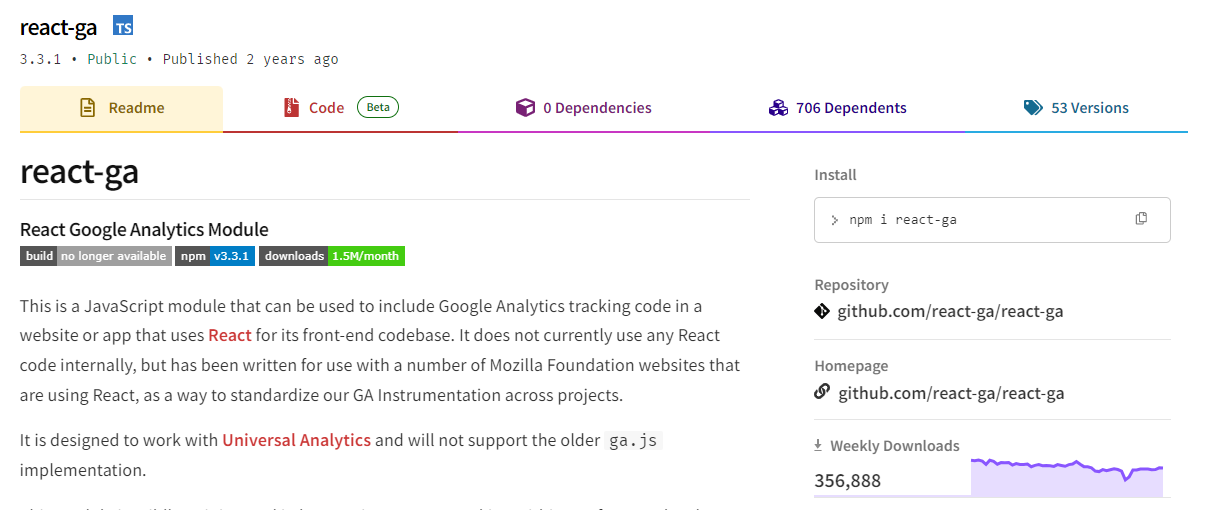 這是一個 JavaScript 模組,可用於在使用 React 作為前端程式碼庫的網站或應用程式中包含 Google Analytics 追蹤程式碼。 該模組對我們如何在前端程式碼中進行追蹤有一定的看法。我們的 API 比核心 Google Analytics 庫稍微詳細一些,以使程式碼更易於閱讀。 開始使用以下 npm 指令。 ``` npm install react-ga --save ``` 您可以這樣使用它。 ``` import ReactGA from 'react-ga'; ReactGA.initialize('UA-000000-01'); ReactGA.pageview(window.location.pathname + window.location.search); <!-- The core React library --> <script src="https://unpkg.com/[email protected]/dist/react.min.js"></script> <!-- The ReactDOM Library --> <script src="https://unpkg.com/[email protected]/dist/react-dom.min.js"></script> <!-- ReactGA library --> <script src="/path/to/bower_components/react-ga/dist/react-ga.min.js"></script> <script> ReactGA.initialize('UA-000000-01', { debug: true }); </script> ``` 執行`npm install` `npm start`並前往`port 8000 on localhost`後,您可以閱讀[文件](https://github.com/react-ga/react-ga?tab=readme-ov-file#installation)並查看[演示](https://github.com/react-ga/react-ga/tree/master/demo)。 它每週的下載量超過 35 萬次,在 GitHub 上擁有超過 5,000 顆星(已存檔)。 https://github.com/react-ga/react-ga Star React Google Analytics ⭐️ --- 17.react [-i18next](https://github.com/i18next/react-i18next) - React 的國際化做得很好。 ------------------------------------------------------------------------------- 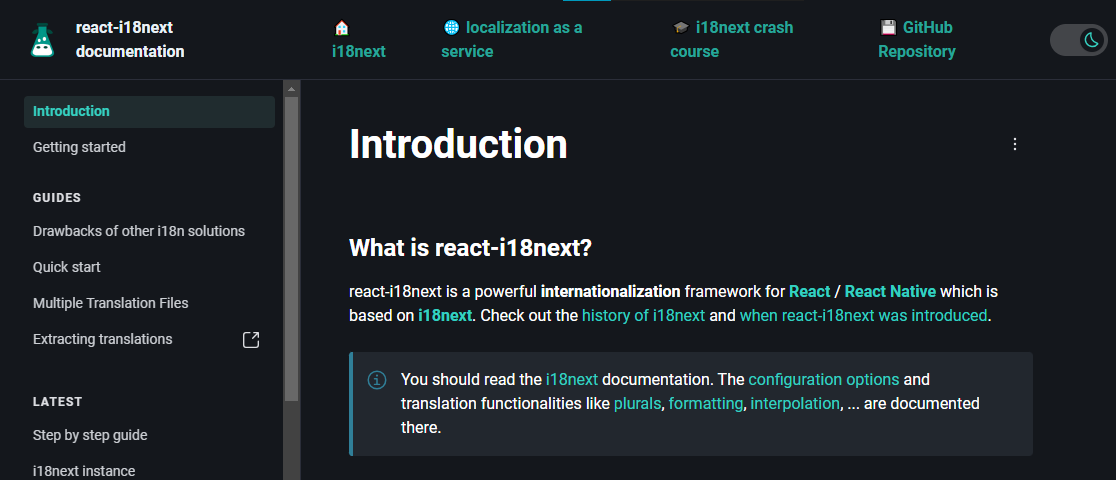 無需更改 webpack 配置或加入額外的 babel 轉譯器。 開始使用以下 npm 指令。 ``` npm i react-i18next ``` 我們來比較一下程式碼結構。 > 在使用react-i18next之前。 ``` ... <div>Just simple content</div> <div> Hello <strong title="this is your name">{name}</strong>, you have {count} unread message(s). <Link to="/msgs">Go to messages</Link>. </div> ... ``` > 使用react-i18next後。 ``` ... <div>{t('simpleContent')}</div> <Trans i18nKey="userMessagesUnread" count={count}> Hello <strong title={t('nameTitle')}>{{name}}</strong>, you have {{count}} unread message. <Link to="/msgs">Go to messages</Link>. </Trans> ... ``` 您可以閱讀[文件](https://react.i18next.com/)並前往[Codesandbox 的互動式遊樂場](https://codesandbox.io/s/1zxox032q)。 該工具已被超過 182,000 名開發人員使用,在 GitHub 上擁有超過 8,000 顆星。軟體包中令人印象深刻的 3400k+ 下載量進一步鞏固了它的可信度,使其成為您下一個 React 專案的絕佳選擇。 您也可以閱讀 Locize 關於[React Localization - Internationalize with i18next](https://locize.com/blog/react-i18next/)的部落格。 https://github.com/i18next/react-i18next 明星react-i18next ⭐️ --- 哇!如此長的有用專案清單。 我知道您有更多想法,分享它們,讓我們一起建造:D 現在就這些了! 在開展新專案時,開發人員經驗至關重要,這就是為什麼有些專案擁有龐大的社區,而有些則沒有。 React 社群非常龐大,所以成為這些社群的一部分,並使用這些開源專案將您的專案提升到一個新的水平。 祝你有美好的一天!直到下一次。 在 GitHub 上關注我。 https://github.com/Anmol-Baranwal 請關注 CopilotKit 以了解更多此類內容。 https://dev.to/copilotkit --- 原文出處:https://dev.to/copilotkit/libraries-you-should-know-if-you-build-with-react-1807
過去十年來,人工智慧世界取得了長足發展。 人工智慧無所不在,從語音助理到軟體開發,如果我們正確使用它,它會非常有幫助。 在這樣的世界中,製作 AI 應用程式是有利可圖的,因此我在這裡介紹 25 個開源專案,您可以使用它們來製作 AI 應用程式並將其提升到新的水平。 其中有一些令人興奮的概念,例如使用語音合成與 3D 角色進行互動式溝通。堅持到底。 將會有大量的資源、文章、專案想法、指南等可供參考。 讓我們涵蓋這一切! --- 1. [Taipy](https://github.com/Avaiga/taipy) - 將資料和人工智慧演算法整合到生產就緒的 Web 應用程式中。 ----------------------------------------------------------------------------  Taipy 是一個開源 Python 庫,可用於輕鬆的端到端應用程式開發,具有假設分析、智慧管道執行、內建調度和部署工具。 我相信你們大多數人都不明白 Taipy 用於為基於 Python 的應用程式建立 GUI 介面並改進資料流管理。 因此,您可以繪製資料集的圖表,並使用類似 GUI 的滑桿來提供使用其他實用功能來處理資料的選項。 雖然 Streamlit 是一種流行的工具,但在處理大型資料集時,其效能可能會顯著下降,這使得它在生產級使用上不切實際。 另一方面,Taipy 在不犧牲性能的情況下提供了簡單性和易用性。透過嘗試 Taipy,您將親身體驗其用戶友好的介面和高效的資料處理。 在底層,Taipy 利用各種函式庫來簡化開發並增強功能。 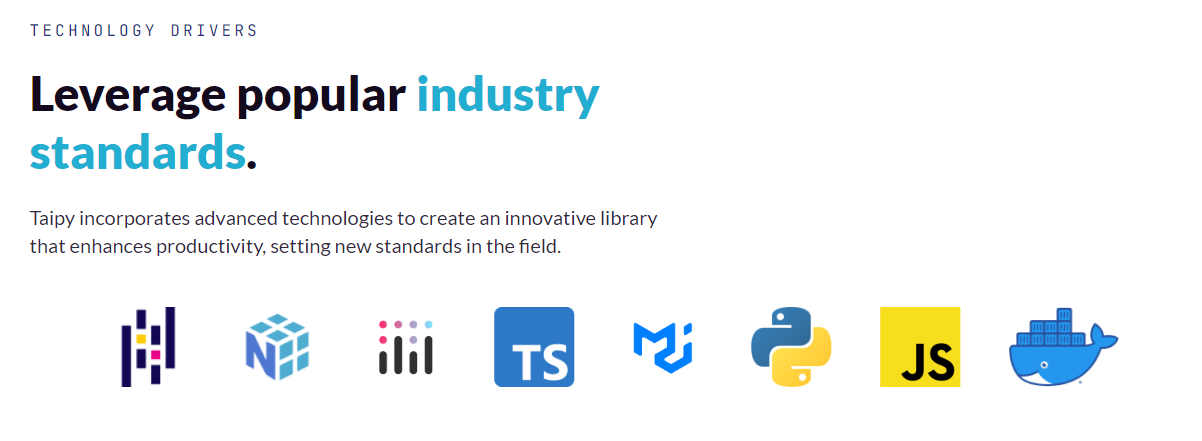 開始使用以下命令。 ``` pip install taipy ``` 我們來談談最新的[Taipy v3.1 版本](https://docs.taipy.io/en/latest/relnotes/)。 最新版本使得在 Taipy 的多功能零件物件中可視化任何 HTML 或 Python 物件成為可能。 這意味著[Folium](https://python-visualization.github.io/folium/latest/) 、 [Bokeh](https://bokeh.org/) 、 [Vega-Altair](https://altair-viz.github.io/)和[Matplotlib](https://matplotlib.org/)等程式庫現在可用於視覺化。 這也帶來了對[Plotly python 的](https://plotly.com/python/)原生支持,使繪製圖表變得更加容易。  他們還使用分散式運算提高了效能,但最好的部分是 Taipy,它的所有依賴項現在都與 Python 3.12 完全相容,因此您可以在使用 Taipy 進行專案的同時使用最新的工具和程式庫。 您可以閱讀[文件](https://docs.taipy.io/en/latest/)。 例如,您可以看到[聊天演示](https://docs.taipy.io/en/release-3.1/gallery/llm/5_chatbot/),它使用 OpenAI 的 GPT-4 API 來產生對您的訊息的回應。您可以輕鬆更改程式碼以使用任何其他 API 或模型。  另一個有用的事情是,Taipy 團隊提供了一個名為[Taipy Studio](https://docs.taipy.io/en/latest/manuals/studio/)的 VSCode 擴充功能來加速 Taipy 應用程式的建置。  您也可以使用 Taipy 雲端部署應用程式。 如果您想閱讀部落格來了解程式碼庫結構,您可以閱讀 HuggingFace 的[使用 Taipy 在 Python 中為您的 LLM 建立 Web 介面](https://huggingface.co/blog/Alex1337/create-a-web-interface-for-your-llm-in-python)。 嘗試新技術通常很困難,但 Taipy 提供了[10 多個演示教程](https://docs.taipy.io/en/release-3.1/gallery/),其中包含程式碼和適當的文件供您遵循。 例如,一些現場演示範例: - [新冠儀表板](https://covid-dashboard.taipy.cloud/Country) - [推文生成](https://tweet-generation.taipy.cloud/) - [資料視覺化](https://production-planning.taipy.cloud/Data-Visualization) - [即時人臉辨識](https://face-recognition.taipy.cloud/) Taipy 在 GitHub 上有 7k+ Stars,並且處於`v3`版本,因此它們正在不斷改進。  https://github.com/Avaiga/taipy Star Taipy ⭐️ --- 2. [Supabase](https://github.com/supabase/supabase) - 開源 Firebase 替代品。 ----------------------------------------------------------------------  要建立AI應用程式,您需要一個後端,而Supabase作為優秀的後端服務提供者可以滿足這一需求。 開始使用以下 npm 指令 (Next.js)。 ``` npx create-next-app -e with-supabase ``` 這就是使用 CRUD 操作的方式。 ``` import { createClient } from '@supabase/supabase-js' // Initialize const supabaseUrl = 'https://chat-room.supabase.co' const supabaseKey = 'public-anon-key' const supabase = createClient(supabaseUrl, supabaseKey) // Create a new chat room const newRoom = await supabase .from('rooms') .insert({ name: 'Supabase Fan Club', public: true }) // Get public rooms and their messages const publicRooms = await supabase .from('rooms') .select(` name, messages ( text ) `) .eq('public', true) // Update multiple users const updatedUsers = await supabase .from('users') .eq('account_type', 'paid') .update({ highlight_color: 'gold' }) ``` 您可以閱讀[文件](https://supabase.com/docs)。 您可以使用身份驗證、即時、邊緣功能、儲存等功能建立一個速度極快的應用程式。 Supabase 涵蓋了這一切! Supabase 也提供了幾個入門套件,例如[Nextjs 與 LangChain](https://github.com/langchain-ai/langchain-nextjs-template) 、 [Stripe 與 Nextjs](https://github.com/vercel/nextjs-subscription-payments)或[AI Chatbot](https://github.com/supabase-community/vercel-ai-chatbot) 。 Supabase 在 GitHub 上擁有超過 63,000 顆星,並且擁有大量提交超過 27,000 次的貢獻者。 https://github.com/supabase/supabase 明星 Supabase ⭐️ --- 3. [Chatwoot](https://github.com/chatwoot/chatwoot) - 即時聊天、電子郵件支援、全通路服務台並擁有您的資料。 --------------------------------------------------------------------------------  Chatwoot 連接流行的客戶溝通管道,如電子郵件、網站即時聊天、Facebook、Twitter、WhatsApp、Instagram、Line 等。這有助於您從單一儀表板跨管道提供一致的客戶體驗。 這在各種情況下都可能很重要,例如當您圍繞人工智慧應用程式建立社群時。  您可以閱讀[文件](https://www.chatwoot.com/docs/product)來發現各種整合選項,以便更輕鬆地管理整個生態系統。 他們在每個整合中都有非常詳細的文件和快照範例,例如[帶有 WhatsApp Cloud API 的 WhatsApp 通道](https://www.chatwoot.com/docs/product/channels/whatsapp/whatsapp-cloud)。您可以根據需要一鍵式或自架部署到 Heroku。 他們在 GitHub 上擁有 18k+ Stars,並且發布了`v3.6`版本。 https://github.com/chatwoot/chatwoot 明星 Chatwoot ⭐️ --- 4. [CopilotKit](https://github.com/CopilotKit/CopilotKit) - 在數小時內為您的產品提供 AI Copilot。 ------------------------------------------------------------------------------------  您可以使用兩個 React 元件將關鍵 AI 功能整合到 React 應用程式中。它們還提供內建(完全可自訂)Copilot 原生 UX 元件,例如`<CopilotKit />` 、 `<CopilotPopup />` 、 `<CopilotSidebar />` 、 `<CopilotTextarea />` 。 開始使用以下 npm 指令。 ``` npm i @copilotkit/react-core @copilotkit/react-ui @copilotkit/react-textarea ``` 這是整合 CopilotTextArea 的方法。 ``` import { CopilotTextarea } from "@copilotkit/react-textarea"; import { useState } from "react"; export function SomeReactComponent() { const [text, setText] = useState(""); return ( <> <CopilotTextarea className="px-4 py-4" value={text} onValueChange={(value: string) => setText(value)} placeholder="What are your plans for your vacation?" autosuggestionsConfig={{ textareaPurpose: "Travel notes from the user's previous vacations. Likely written in a colloquial style, but adjust as needed.", chatApiConfigs: { suggestionsApiConfig: { forwardedParams: { max_tokens: 20, stop: [".", "?", "!"], }, }, }, }} /> </> ); } ``` 您可以閱讀[文件](https://docs.copilotkit.ai/getting-started/quickstart-textarea)。 基本概念是在幾分鐘內建立可用於基於 LLM 的全端應用程式的 AI 聊天機器人。 https://github.com/CopilotKit/CopilotKit Star CopilotKit ⭐️ --- 5. [DALL·E Mini](https://github.com/borisdayma/dalle-mini) - 根據文字提示產生圖像。 ------------------------------------------------------------------------  OpenAI 擁有第一個令人印象深刻的模型,用於使用 DALL·E 生成圖像。 Craiyon/DALL·E mini 嘗試使用開源模型重現這些結果。 如果您想知道這個名字,DALL-E mini 應母公司的要求更名為 Craiyon,並以更易於存取的網路應用程式格式使用類似的技術。 您可以在[Craiyon](https://www.craiyon.com/)上使用該模型。 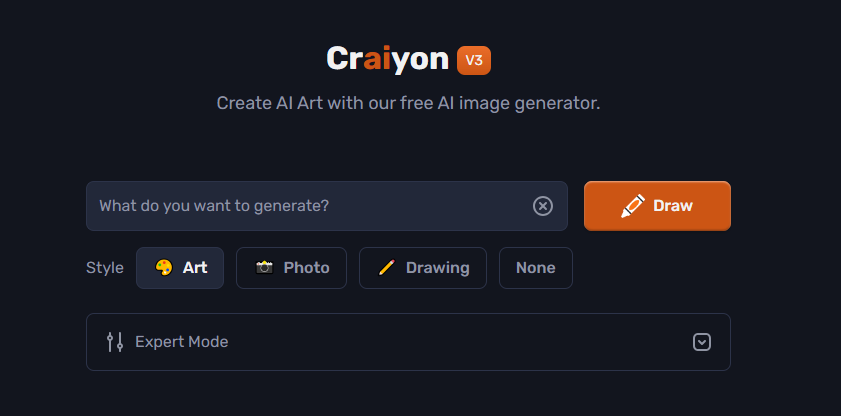 開始使用以下命令(用於開發)。 ``` pip install dalle-mini ``` 您可以閱讀[文件](https://github.com/borisdayma/dalle-mini?tab=readme-ov-file#development)。 您可以閱讀[DALL-E Mini 解釋](https://wandb.ai/dalle-mini/dalle-mini/reports/DALL-E-Mini-Explained-with-Demo--Vmlldzo4NjIxODA)來了解有關資料集、架構和所涉及演算法的更多資訊。 您可以閱讀[最佳真實感 AI 圖像和提示的終極指南](https://www.craiyon.com/blog/ultimate-guide-best-ai-art-photorealistic-images-and-prompts),以便更好地理解優質資源。 DALL·E Mini 在 GitHub 上擁有 14k+ Stars,目前處於`v0.1`版本。 https://github.com/borisdayma/dalle-mini 明星 DALL·E Mini ⭐️ --- 6. [Deepgram](https://github.com/deepgram) - 將語音 AI 建置到您的應用程式中。 ---------------------------------------------------------------  從新創公司到 NASA,Deepgram API 每天都用於轉錄和理解數百萬分鐘的音訊。快速、準確、可擴展且經濟高效。 它為開發人員提供語音到文字和音訊智慧模型。  儘管他們有免費增值模式,但免費套餐的限制足以讓您入門。 可視化效果更上一層樓。您可以檢查即時串流媒體回應或音訊檔案並比較音訊的智慧程度。  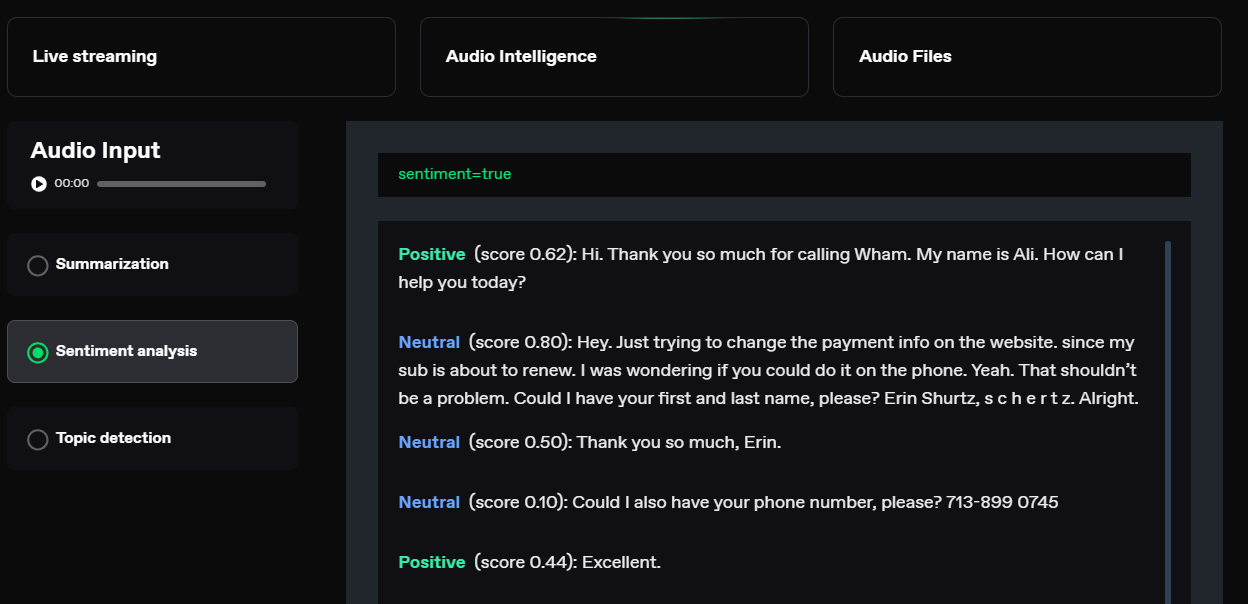 您可以閱讀[文件](https://developers.deepgram.com/docs/introduction)。 您也可以閱讀 Deepgram 撰寫的[關於如何將語音辨識新增至您的 React 和 Node.js 專案的](https://deepgram.com/learn/how-to-add-speech-recognition-to-your-react-project)範例部落格。 如果您想嘗試 API 來親自了解模型的靈活性,請查看他們的[API Playground](https://playground.deepgram.com/?smart_format=true&language=en&model=nova-2) 。 https://github.com/deepgram 明星 Deepgram ⭐️ --- 7. [InvokeAI](https://github.com/invoke-ai/InvokeAI) - 領先的穩定擴散模型創意引擎。 ---------------------------------------------------------------------  關於 InvokeAI 是 Stable Diffusion(開源文字到圖像和圖像到圖像生成器)的實現。 它可以在 Windows、Mac 和 Linux 機器上執行,並在 RAM 低至 4 GB 的 GPU 卡上執行。 此解決方案提供業界領先的WebUI,支援透過CLI進行終端使用,並作為多種商業產品的基礎。 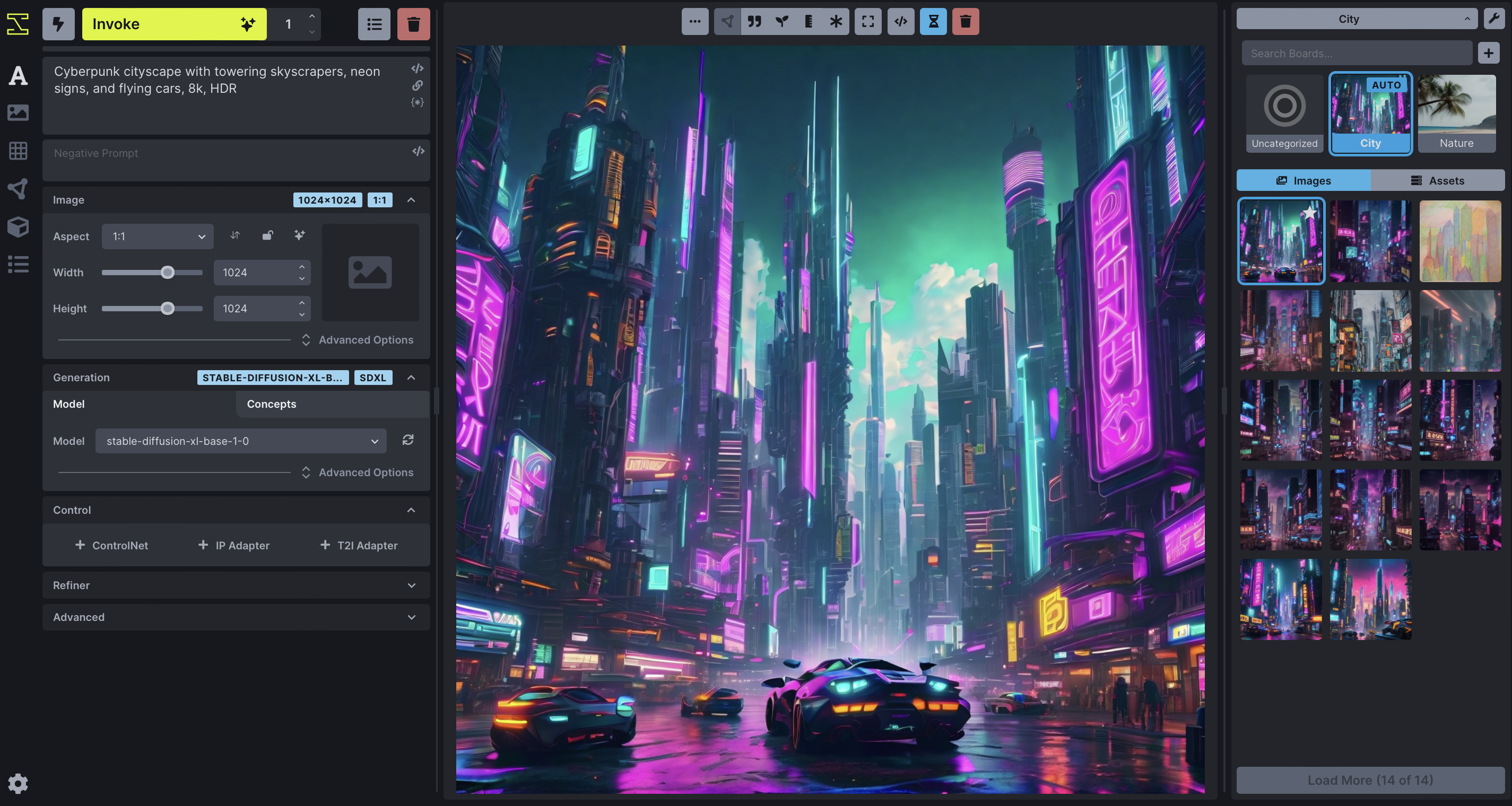 您可以閱讀有關[安裝和硬體要求](https://invoke-ai.github.io/InvokeAI/installation/INSTALLATION/)、[如何安裝不同型號](https://invoke-ai.github.io/InvokeAI/installation/050_INSTALLING_MODELS/)以及最重要的[自動安裝的資訊](https://invoke-ai.github.io/InvokeAI/installation/010_INSTALL_AUTOMATED/)。 令人興奮的功能是能夠使用另一個圖像生成圖像,如[文件](https://invoke-ai.github.io/InvokeAI/features/IMG2IMG/)中所述。 InvokeAI 在 GitHub 上有近 21k 顆星, https://github.com/invoke-ai/InvokeAI 明星 InvokeAI ⭐️ --- 8. [OpenAI](https://github.com/openai) - 您所需要的一切。 -------------------------------------------------  Gemini by Google 和 OpenAI 非常受歡迎,但我們在此列表中專注於 OpenAI。 如果您想了解更多訊息,可以在 Medium 上閱讀[Google AI Gemini API in web using React 🤖](https://generativeai.pub/google-gemini-api-in-web-using-react-7e5bf0bf0abc) 。這很簡單,也很切中要害。 透過 OpenAI,您可以使用 DALL·E(根據文字描述建立原創、逼真的圖像和藝術)、Whisper(語音辨識模型)和 GPT-4。在評論中告訴我們關於索拉的事吧! 您可以使用簡單的 API 開始建置。 ``` completion = openai.ChatCompletion.create( model="gpt-3.5-turbo", messages=[ {"role": "system", "content": "You are a helpful assistant."}, {"role": "user", "content": "What are some famous astronomical observatories?"} ] ) ``` 您可以閱讀[文件](https://platform.openai.com/docs/introduction)。它提供瞭如此多的選項來建立非常酷的東西! 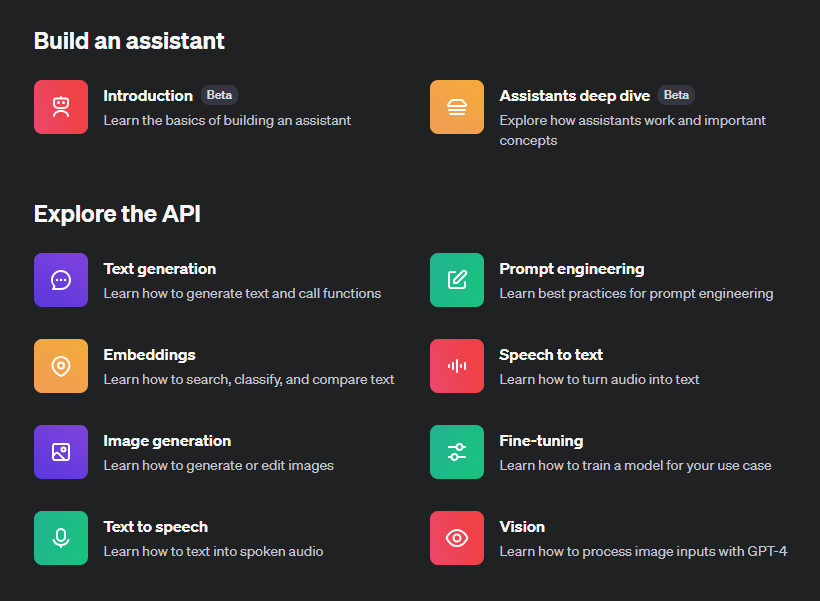 甚至 Stripe 也使用 GPT-4 來改善使用者體驗。 例如,您可以建立[Assistant 應用程式](https://platform.openai.com/docs/assistants/overview)並查看[API 遊樂場](https://platform.openai.com/playground/p/default-chat?model=text-davinci-003)以更好地理解它。 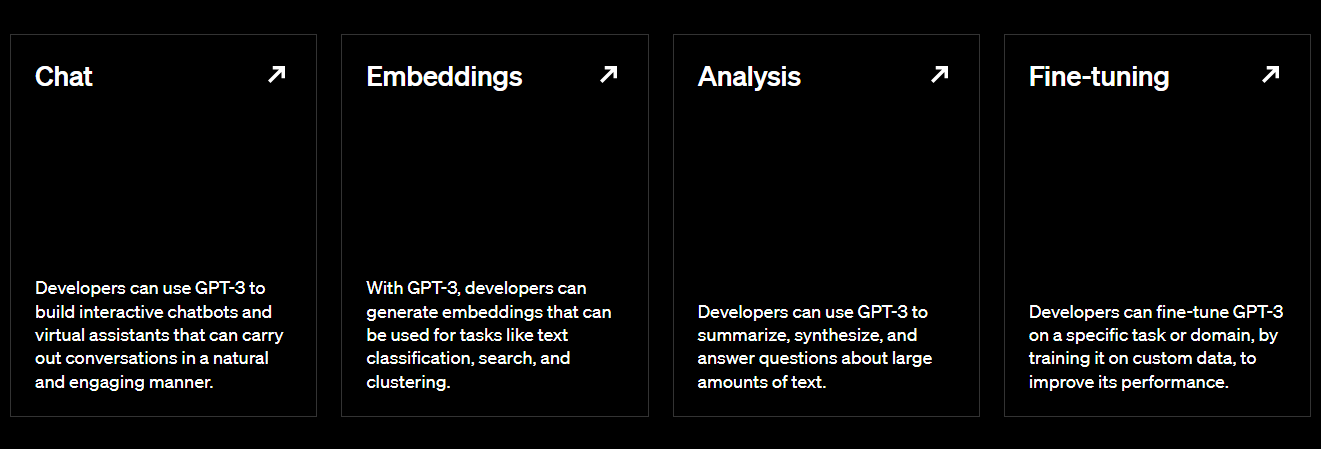 如果您需要指南,可以閱讀 Dzone 的[Integrating ChatGPT With ReactJS](https://dzone.com/articles/integrating-chatgpt-with-reactjs-a-comprehensive-g) 。 其間,OpenAI收購了Sora,獲得了壟斷地位。你怎麼認為? https://github.com/openai 明星 OpenAI ⭐️ --- 9. [DeepFaceLab](https://github.com/iperov/DeepFaceLab) - 用於建立深度贗品的領先軟體。 ------------------------------------------------------------------------  DeepFaceLab 是製作 Deepfakes 的頂級開源工具。 Deepfakes 是透過深度學習製作的經過修改的圖像和影片。它們經常被用來交換圖片或剪輯中的臉孔,有時是為了開玩笑,但也有出於有害的原因。 DeepFaceLab,用Python建置,是一個強大的deepfake工具。它可以改變媒體中的臉孔,甚至消除皺紋和老化跡象。 這些是您可以使用 DeepFaceLab 執行的一些操作。 - 換臉。  - [臉部抗衰老 - YouTube](https://www.youtube.com/watch?v=Ddx5B-84ebo) 。  - 更換頭部。  - 操縱嘴唇。 您可以使用這個基本教學來了解[如何有效地使用 DeepFaceLab](https://www.youtube.com/watch?v=kOIMXt8KK8M)來完成這些事情。 您可以在[YouTube](https://www.youtube.com/channel/UCGf4OlX_aTt8DlrgiH3jN3g/videos)上看到使用此 DeepLab 演算法的影片。 不幸的是,DeepFaceLab 中沒有「讓一切正常」按鈕,但值得根據您的特定需求了解其工作流程。 儘管它於 2023 年 11 月 9 日存檔,在 GitHub 上有近 44k+ 顆星,但由於其大量的教程和可靠的演算法,它仍然是您的 AI 應用程式的可靠選擇。 https://github.com/iperov/DeepFaceLab 明星 DeepFaceLab ⭐️ --- 10. [Detectron2](https://github.com/facebookresearch/detectron2) - 基於 PyTorch 的模組化物件偵測庫。 ----------------------------------------------------------------------------------------  Detectron2 是 Facebook AI Research 的下一代函式庫,提供最先進的偵測和分割演算法。它是 Detectron 和 maskrcnn-benchmark 的後繼者。 它支援 Facebook 上的多個電腦視覺研究專案和生產應用程式。 使用此[YouTube 教學](https://www.youtube.com/watch?v=eUSgtfK4ivk)將 Detectron2 與 Facebook 開發者倡導者的機器學習結合使用。 Detectron2 旨在支援各種最先進的物件偵測和分割模型,同時也適應不斷發展的前沿研究領域。 您可以閱讀[如何入門](https://detectron2.readthedocs.io/en/latest/tutorials/getting_started.html)以及 [元博客](https://ai.meta.com/blog/-detectron2-a-pytorch-based-modular-object-detection-library-/),其中深入介紹了 Detectron 的目標。 舊版的 Detectron 使用的是 Caffe,因此很難與後來結合 Caffe2 和 PyTorch 的程式碼變更一起使用。為了回應社群回饋,Facebook AI 發布了 Detectron2 作為更新的、更容易使用的版本。 Detectron2 配備了用於物件偵測的先進演算法,例如 DensePose 和全景特徵金字塔網路。 此外,Detectron2 還可以進行語義分割和全景分割,這有助於更準確地偵測和分割影像和影片中的物件。 Detectron2 不僅支援使用邊界框和實例分割遮罩進行物件偵測,還可以預測人體姿勢,與 Detectron 類似。 它們在 GitHub 儲存庫上擁有 28k+ Stars,並在 GitHub 上被 1.6k+ 開發人員使用。 https://github.com/facebookresearch/detectron2 Star Detectron2 ⭐️ --- [11.FastAI-](https://github.com/fastai/fastai)深度學習庫。 ---------------------------------------------------- 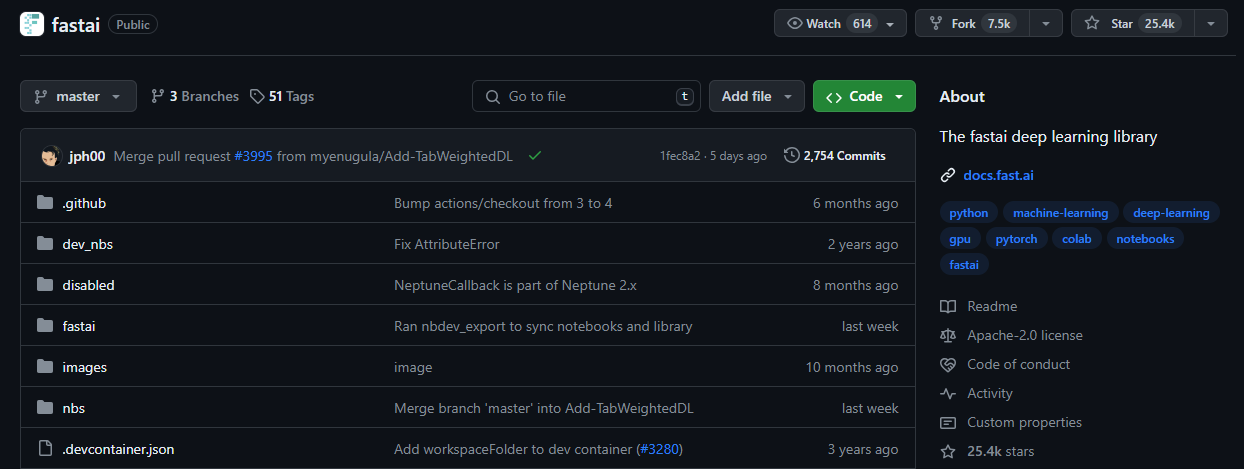 Fastai 是一個多功能的深度學習庫,旨在滿足從業者和研究人員的需求。它為從業者提供了高級元件,以便他們在常見的深度學習任務中快速獲得一流的結果。 同時,它為研究人員提供低階元件來實驗和開發新方法。 Detectron2 透過其分層架構實現了易用性和靈活性之間的平衡。 該架構將複雜的深度學習技術分解為可管理的抽象,簡潔地利用了 Python 的動態特性和 PyTorch 的靈活性。 它建構在較低層級 API 的層次結構之上,這些 API 提供可組合的建構塊。這樣,想要重寫部分高級 API 或加入特定行為以滿足其需求的用戶無需學習如何使用最低級別。 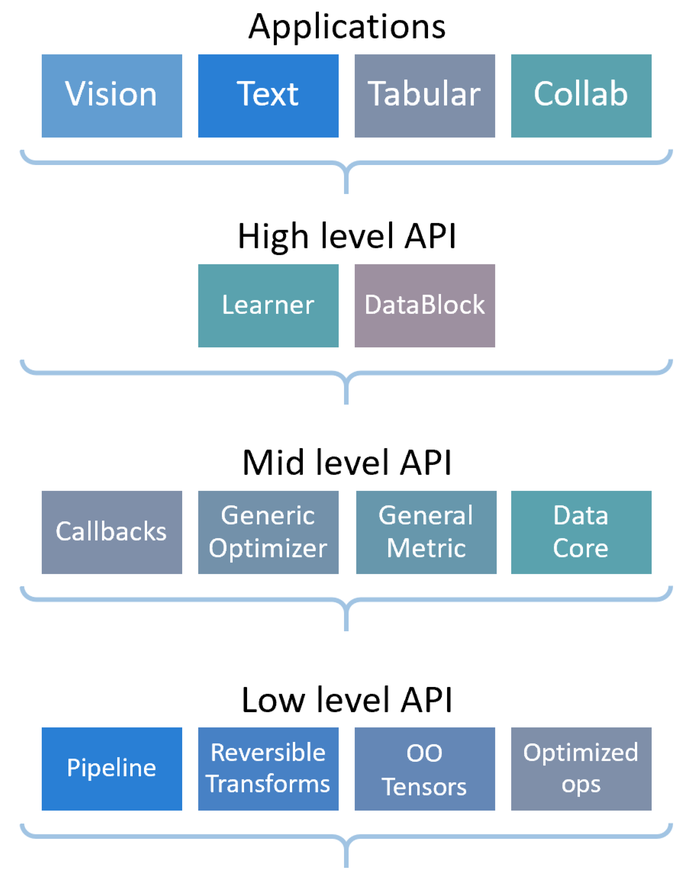 [安裝 pyTorch](https://pytorch.org/get-started/locally/)後即可開始使用以下命令。 ``` conda install -c fastai fastai ``` 您可以閱讀[文件](https://docs.fast.ai/)。 它們針對初學者、中級和專家的[教程](https://docs.fast.ai/tutorial.html)有不同的起點。 如果您想為 FastAI 做出貢獻,您應該閱讀他們的[程式碼風格指南](https://docs.fast.ai/dev/style.html)。 如果您更喜歡影片,可以在 YouTube 上觀看傑里米霍華德 (Jeremy Howard) 撰寫的[課程“0”:程式設計師實用深度學習 (fastai)](https://www.youtube.com/watch?v=gGxe2mN3kAg) 。 它們在 GitHub 上擁有超過 25,000 顆星,並已被 GitHub 上超過 16,000 名開發人員使用。 https://github.com/fastai/fastai 明星 FastAI ⭐️ --- 12.[穩定擴散](https://github.com/CompVis/stable-diffusion)- 潛在文字到影像擴散模型。 --------------------------------------------------------------------  > 什麼是穩定擴散? 穩定擴散是指生成模型中使用的一種技術,特別是在文字到圖像合成的背景下,其中將資訊從文字描述轉移到圖像的過程是逐漸且平滑地完成的。 在潛在文字到影像擴散模型中,穩定擴散可確保來自文字描述的訊息在整個模型的潛在空間中一致地擴散或傳播。這種擴散過程有助於產生與給定文字輸入相符的高品質和逼真的圖像。 穩定的擴散機制確保模型在生成過程中不會出現突然的跳躍或不穩定。我希望這能解決問題! 下載和採樣穩定擴散的簡單方法是使用[擴散器庫](https://github.com/huggingface/diffusers/tree/main#new--stable-diffusion-is-now-fully-compatible-with-diffusers)。 ``` # make sure you're logged in with `huggingface-cli login` from torch import autocast from diffusers import StableDiffusionPipeline pipe = StableDiffusionPipeline.from_pretrained( "CompVis/stable-diffusion-v1-4", use_auth_token=True ).to("cuda") prompt = "a photo of an astronaut riding a horse on mars" with autocast("cuda"): image = pipe(prompt)["sample"][0] image.save("astronaut_rides_horse.png") ``` 您可以閱讀[研究論文](https://ommer-lab.com/research/latent-diffusion-models/)以及有關[穩定擴散影像修改](https://github.com/CompVis/stable-diffusion?tab=readme-ov-file#image-modification-with-stable-diffusion)的更多資訊。 例如,這是輸入。  這是放大一點後的輸出。  Stable Diffusion v1 是一種特定的模型配置,它採用 860M UNet 和 CLIP ViT-L/14 文字編碼器進行擴散模型,並具有下採樣因子 8 自動編碼器。該模型在 256x256 影像上進行了預訓練,隨後在 512x512 影像上進行了微調。 他們在 GitHub 儲存庫上擁有大約 64k+ Stars。 https://github.com/CompVis/stable-diffusion 恆星穩定擴散 ⭐️ --- 13. [Mocap Drones](https://github.com/jyjblrd/Mocap-Drones) - 用於房間規模追蹤的低成本動作捕捉系統。 ---------------------------------------------------------------------------------  該專案需要 SFM(運動結構)OpenCV 模組,這需要您從原始程式碼編譯 OpenCV。 從`computer_code`目錄中,執行此命令來安裝節點相依性。 ``` yarn install yarn run dev // to start the web server. ``` 您將獲得前端介面的 URL 視圖。 開啟一個單獨的終端機視窗並執行命令`python3 api/index.py`來啟動後端伺服器。此伺服器負責接收攝影機串流並執行動作捕捉計算。 架構如下。  您可以觀看此[YouTube 影片](https://www.youtube.com/watch?v=0ql20JKrscQ)來了解 Mocap 無人機的工作原理,也可以觀看該專案所有者的[部落格](https://joshuabird.com/blog/post/mocap-drones)。 https://www.youtube.com/watch?v=0ql20JKrscQ 您可以閱讀[文件](https://github.com/jyjblrd/Mocap-Drones?tab=readme-ov-file#runing-the-code)。 這是一個最近的開源專案,在 GitHub 儲存庫上擁有 900 多個 star。 https://github.com/jyjblrd/Mocap-Drones 明星動捕無人機 ⭐️ --- 14. [Whisper Speech](https://github.com/collabora/WhisperSpeech) - 透過反轉 Whisper 建構的文字轉語音系統。 -------------------------------------------------------------------------------------------  該模型與穩定擴散類似,但用於語音,功能強大且高度可自訂。 該團隊確保使用經過適當許可的語音錄音,並且所有程式碼都是開源的,使該模型對於商業應用程式來說是安全的。 目前,這些模型是在英語 LibreLight 資料集上進行訓練的。 您可以進一步研究[架構](https://github.com/collabora/WhisperSpeech?tab=readme-ov-file#architecture)。  您可以聽到[範例聲音](https://github.com/collabora/WhisperSpeech/assets/107984/aa5a1e7e-dc94-481f-8863-b022c7fd7434)並使用[colab](https://colab.research.google.com/drive/1xxGlTbwBmaY6GKA24strRixTXGBOlyiw)自行嘗試。 它們相當新,在 GitHub 上有大約 3k+ 的星星。 https://github.com/collabora/WhisperSpeech 星語語音 ⭐️ --- 15. [eSpeak NG](https://github.com/espeak-ng/espeak-ng) - 支援一百多種語言和口音的語音合成器。 ----------------------------------------------------------------------------  eSpeak NG 是一款緊湊型開源軟體文字語音合成器,適用於 Linux、Windows、Android 和其他作業系統。它支援 100 多種語言和口音。它基於 Jonathan Duddington 建立的 eSpeak 引擎。 您可以閱讀各種系統上的[安裝指南](https://github.com/espeak-ng/espeak-ng/blob/master/docs/guide.md)。 對於類似 Debian 的發行版(例如 Ubuntu、Mint 等)。您可以使用此命令。 ``` sudo apt-get install espeak-ng ``` 您可以查看[支援的語言](https://github.com/espeak-ng/espeak-ng/blob/master/docs/languages.md)清單、閱讀[文件](https://github.com/espeak-ng/espeak-ng/tree/master?tab=readme-ov-file#documentation)並查看[功能](https://github.com/espeak-ng/espeak-ng/tree/master?tab=readme-ov-file#features)。 該模型將文字轉換為音素程式碼,表明其作為另一個語音合成引擎前端的潛在能力。 他們在 GitHub 上有 2700+ 顆星星, https://github.com/espeak-ng/espeak-ng 明星 eSpeak NG ⭐️ --- 16.[聊天機器人 UI](https://github.com/mckaywrigley/chatbot-ui) - 每個模型的人工智慧聊天。 ------------------------------------------------------------------------  我們都使用過 ChatGPT,這個專案可以幫助我們為任何 AI 聊天機器人設定使用者介面。少一麻煩! 你可以閱讀[安裝指南](https://github.com/mckaywrigley/chatbot-ui?tab=readme-ov-file#1-install-docker)來安裝 docker、supabase CLI 和其他東西。 您可以閱讀<a href="">文件</a>並查看[演示](https://twitter.com/mckaywrigley/status/1738273242283151777?s=20)。 這在底層使用了 Supabase (Postgres),這就是我們之前討論它的原因。 我沒有討論 Vercel AI 聊天機器人,因為它與此機器人相比是一個相當新的比較。 Chatbot UI 在 GitHub 上擁有大約 25k+ Stars,因此它仍然是開發人員為任何聊天機器人建立 UI 介面的首選。 https://github.com/mckaywrigley/chatbot-ui 明星聊天機器人 UI ⭐️ --- 17. [GPT-4 & LangChain](https://github.com/mayooear/gpt4-pdf-chatbot-langchain) - 用於大型 PDF 文件的 GPT4 和 LangChain 聊天機器人。 -------------------------------------------------------------------------------------------------------------------------- 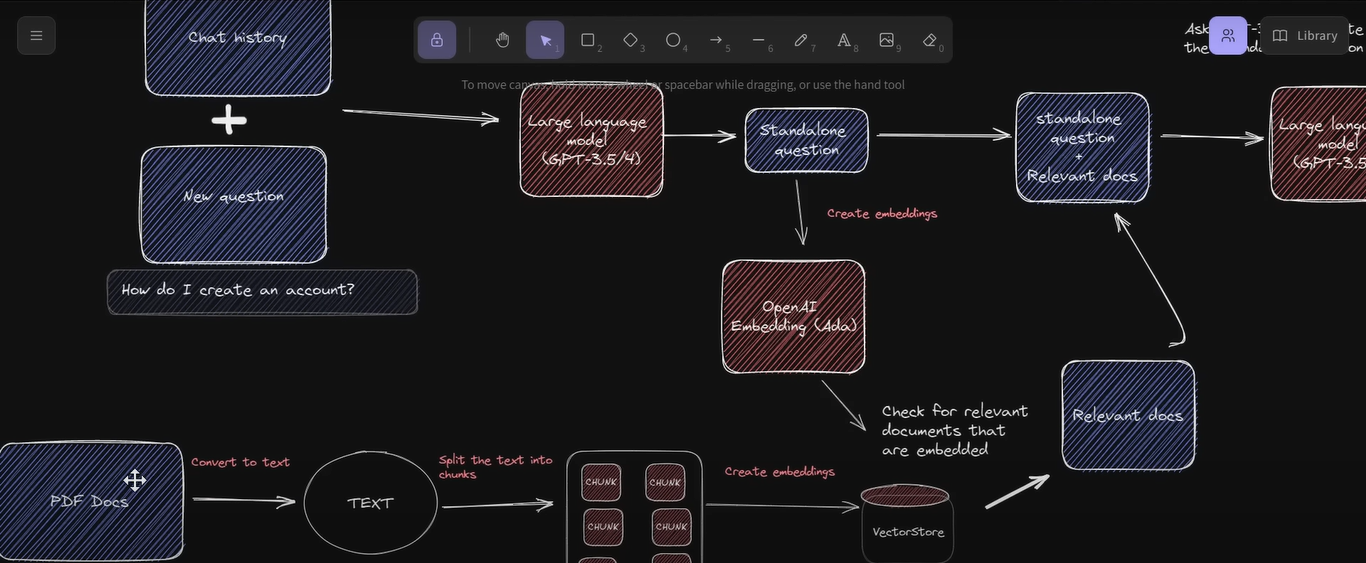 這可用於新的 GPT-4 API 來為多個大型 PDF 檔案建立 chatGPT 聊天機器人。 該系統是使用 LangChain、Pinecone、Typescript、OpenAI 和 Next.js 建構的。 LangChain 是一個簡化可擴展 AI/LLM 應用程式和聊天機器人開發的框架。 Pinecone 用作向量存儲,用於以文字格式儲存嵌入和 PDF,以便以後檢索類似文件。 您可以閱讀涉及複製、安裝依賴項和設定環境 API 金鑰[的開發指南](https://github.com/mayooear/gpt4-pdf-chatbot-langchain?tab=readme-ov-file#development)。 您可以觀看[YouTube 影片](https://www.youtube.com/watch?v=ih9PBGVVOO4),了解如何遵循和使用它。 他們在 GitHub 上擁有 14k+ Stars,僅提交了 34 次。在您的下一個人工智慧應用程式中嘗試! https://github.com/mayooear/gpt4-pdf-chatbot-langchain 明星 GPT-4 和 Langchain ⭐️ --- 18. [Amica](https://github.com/semperai/amica) - 允許您在瀏覽器中輕鬆與 3D 角色聊天。 ---------------------------------------------------------------------  Amica 是一個開源接口,用於透過語音合成和語音辨識與 3D 角色進行互動式通訊。 您可以匯入 VRM 文件,調整聲音以適合角色,並產生包含情緒表達的回應文字。 他們使用 Three.js、OpenAI、Whisper、Bakllava 等進行視覺處理。您可以閱讀[Amica 的工作原理](https://docs.heyamica.com/overview/how-amica-works)及其所涉及的[核心概念](https://docs.heyamica.com/overview/core-concepts)。 您可以克隆該存儲庫並使用它來[開始](https://docs.heyamica.com/getting-started/installation)。 ``` npm i npm run dev ``` 您可以閱讀[文件](https://docs.heyamica.com/)並查看[演示](https://amica.arbius.ai/),這真是太棒了:D  您可以觀看這段簡短的影片,了解它的功能。 https://www.youtube.com/watch?v=hUxAEnFiXH8 Amica 使用 Tauri 建立桌面應用程式。別擔心,我們在此清單的後面部分介紹了金牛座。 他們在 GitHub 上有 400 多個 Star,看起來非常容易使用。 https://github.com/semperai/amica Star Amica ⭐️ --- 19. [Hugging Face Transformers](https://github.com/huggingface/transformers) - 適用於 Pytorch、TensorFlow 和 JAX 的最先進的機器學習。 ----------------------------------------------------------------------------------------------------------------------  Hugging Face Transformers 可以輕鬆存取最先進的預訓練模型和演算法,用於文字分類、語言生成和問答等任務。該庫建置在 PyTorch 和 TensorFlow 之上,允許用戶以最少的努力將高級 NLP 功能無縫整合到他們的應用程式中。 憑藉大量預訓練模型和支援社區,Hugging Face Transformers 簡化了基於 NLP 的解決方案的開發。 這些模型可用於執行 100 多種語言的文本相關任務,例如文字分類、資訊擷取、問答、摘要、翻譯和文字生成。 它們還可以處理與影像相關的任務,例如影像分類、物件偵測和分割,以及與音訊相關的任務,例如語音辨識和音訊分類。 他們還可以執行各種模式的多任務處理,包括表格問答、光學字元辨識、從掃描文件中提取資訊、視訊分類和視覺問答。 您可以看到大量可用的[模型](https://huggingface.co/models)。 您可以瀏覽[文件](https://huggingface.co/docs/transformers/task_summary)以取得完整的目標並向您展示可以執行的各種任務的範例。 例如,使用管道的一種方法是用於影像分割。 ``` from transformers import pipeline segmenter = pipeline(task="image-segmentation") preds = segmenter( "https://huggingface.co/datasets/huggingface/documentation-images/resolve/main/pipeline-cat-chonk.jpeg" ) preds = [{"score": round(pred["score"], 4), "label": pred["label"]} for pred in preds] print(*preds, sep="\n") ``` Transformer 得到了 Jax、PyTorch 和 TensorFlow 這三個最廣泛使用的深度學習庫的支持,並且它們之間可以無縫整合。這種整合可以使用一個庫輕鬆訓練模型,然後加載它們以使用另一個庫進行推理。 它們在 GitHub 上擁有大約 120k+ 星,並被 142k+ 大量開發人員使用。試試看! https://github.com/huggingface/transformers 明星抱臉變形金剛 ⭐️ --- 20. [LLAMA](https://github.com/facebookresearch/llama) - LLaMA 模型的推理程式碼。 ------------------------------------------------------------------------  Llama 2 是 Facebook Research 開發的尖端技術,使個人、創作者、研究人員和各種規模的企業能夠使用大型語言模型負責任地實驗、創新和擴展他們的想法。 最新版本包括模型權重以及預訓練和微調 Llama 語言模型的起始程式碼,參數範圍從 7B 到 70B。 開始使用涵蓋以下步驟的[安裝指南](https://github.com/facebookresearch/llama?tab=readme-ov-file#quick-start)。 - 克隆並下載儲存庫。 - 安裝所需的依賴項。 - 從 Meta 網站註冊並下載模型。 - 執行提供的腳本來下載模型。 - 使用提供的命令在本地執行所需的模型。 您可以觀看由 ZeroToMastery 製作的關於什麼是美洲駝的[YouTube 影片](https://www.youtube.com/watch?v=OqZ0CSKzu10)。 您也可以在[Hugging Face](https://huggingface.co/meta-llama)和[Meta 官方頁面](https://llama.meta.com/)上查看型號清單和更多資訊。 Ollama 基於 llama,在 GitHub 上擁有 50k+ star。請參閱文件並使用此模型進行更多研究。 https://github.com/facebookresearch/llama 明星 LLAMA ⭐️ --- 21. [Fonoster](https://github.com/fonoster/fonoster) - Twilio 的開源替代品。 ---------------------------------------------------------------------  Fonoster Inc. 研究了一種創新的可編程電信堆棧,該堆疊將為企業提供完全基於雲端的實用程序,將電話服務與網路連接起來。 根據您想要實現的目標,有多種開始方法。 開始使用以下 npm 指令。 ``` npm install @fonoster/websdk // CDN is also available ``` 例如,您可以透過以下方式將 Fonoster 與 Google Speech API 結合使用。 (您將需要服務帳戶的金鑰) ``` npm install @fonoster/googleasr @fonoster/googletts ``` 這是您可以配置語音伺服器以使用插件的方法。 ``` const { VoiceServer } = require("@fonoster/voice"); const GoogleTTS = require("@fonoster/googletts"); const GoogleASR = require("@fonoster/googleasr"); const voiceServer = new VoiceServer(); const speechConfig = { keyFilename: "./google.json" }; // Set the server to use the speech APIS voiceServer.use(new GoogleTTS(speechConfig)); voiceServer.use(new GoogleASR(speechConfig)); voiceServer.listen(async(req, res) => { console.log(req); await res.answer(); // To use this verb you MUST have a TTS plugin const speech = await res.gather(); await res.say("You said " + speech); await res.hangup(); }); ``` 您可以閱讀[文件](https://fonoster.com/docs/overview/)。 他們提供了一個足以入門的免費套餐。 他們在 GitHub 上擁有大約 6k+ 顆星,並發布了 250 多個版本。 https://github.com/fonoster/fonoster 明星 Fonoster ⭐️ --- 22. [DIPY](https://github.com/dipy/dipy) - Python 中的 paragon 3D/4D+ 成像庫。 ------------------------------------------------------------------------  DIPY 是 Python 中領先的 3D/4D+ 成像庫。它包含用於空間歸一化、訊號處理、機器學習、統計分析和醫學影像視覺化的各種方法。 此外,它還包含計算解剖學的專門方法,包括擴散、灌注和結構成像。 您可以開始使用。 ``` pip install dipy // run this in python console import dipy print(dipy.get_info()) ``` 如果您使用的是 anaconda 或其他系統,您可以閱讀完整的[安裝指南](https://docs.dipy.org/stable/examples_built/quick_start/quick_start.html#sphx-glr-examples-built-quick-start-quick-start-py)。 您可以閱讀[文件](https://docs.dipy.org/stable/)並存取他們的[YouTube 頻道](https://www.youtube.com/c/diffusionimaginginpython)。 你可以看看詳細的[例子](https://docs.dipy.org/stable/examples_built/index.html)。  他們的下載量超過 428k,並且在 GitHub 儲存庫上擁有 600 多個 Star。 https://github.com/dipy/dipy 明星 DIPY ⭐️ --- 23. [Elastic Search](https://github.com/elastic/elasticsearch) - 免費開放式、分散式、RESTful 搜尋引擎。 ----------------------------------------------------------------------------------------   Elasticsearch 是一種分散式、RESTful 搜尋和分析引擎,能夠解決大量使用案例。 作為 Elastic Stack 的核心,它集中儲存您的資料,以實現閃電般的快速搜尋、微調的相關性以及可輕鬆擴展的強大分析。 他們闡述了使用 ElasticSearch 的用例。  Elasticsearch 使用標準 RESTful API 和 JSON。我們也使用多種語言(例如 Java、Python、.NET、SQL 和 PHP)來建立和維護客戶端。 該結構如下。 ``` const { Client } = require('@elastic/elasticsearch') const client = new Client({ node: 'http://localhost:9200' }) client .search({ index: 'social-*', body: { query: { match: { message: 'myProduct' } }, aggs: { top_10_states: { terms: { field: 'state', size: 10 } } } } }) .then(({ body }) => { const { hits } = body.hits console.log(hits) }) .catch(console.error) ``` 您可以閱讀<a href="">文件</a>並查看[功能清單](https://www.elastic.co/elasticsearch/features)。 儘管具有有用的功能,Elastic Search 的主要缺點是缺乏免費套餐。但是,您仍然可以利用免費試用版來探索和了解開源專案的架構。 Elastic Search 在 GitHub 上擁有超過 67k+ 的星星和近 1900 名貢獻者,並且處於`v8`版本中,正在不斷發展和改進。 https://github.com/elastic/elasticsearch 明星 Elastic Search ⭐️ --- 24. [Tauri](https://github.com/tauri-apps/tauri) - 使用 Web 前端建立更小、更快且安全的桌面應用程式。 ------------------------------------------------------------------------------  Tauri 是一個工具包,旨在幫助開發人員利用幾乎任何可用的前端框架為主要桌面平台建立應用程式。其核心是使用 Rust 開發的,而 CLI 利用 Node.js,提供了一種真正的多語言方法來開發和維護卓越的應用程式。 Tauri 應用程式中的使用者介面目前利用 Tao 作為 macOS、Windows、Linux、Android 和 iOS 上的視窗處理庫。 為了渲染您的應用程式,Tauri 使用 WRY,這是一個為系統 Web 視圖提供統一介面的程式庫。它在 macOS 和 iOS 上利用 WKWebView、在 Windows 上利用 WebView2、在 Linux 上利用 WebKitGTK 以及在 Android 上利用 Android System WebView。 您可以使用 Vite、HTML/CSS/JS、Next.js、Svelte 等等。 開始使用以下 npm 指令。 ``` npm create tauri-app@latest ``` 您可以閱讀[文件](https://tauri.app/v1/guides/getting-started/prerequisites)並查看 Tauri 提供的[功能清單](https://tauri.app/v1/guides/features/)。 您甚至可以使用 Tauri 建立自己的 CLI,這有多酷:) 團隊提供了[YouTube 影片](https://www.youtube.com/watch?v=UxTJeEbZX-0&t=2s),讓您了解更多關於 Tauri 的訊息。 他們在 GitHub 上擁有超過 75k 顆星星,並發布了 800 多個版本。 https://github.com/tauri-apps/tauri 金牛座之星 ⭐️ --- 25. [AutoGPT](https://github.com/Significant-Gravitas/AutoGPT) - 比 ChatGPT 更令人興奮。 ---------------------------------------------------------------------------------  AutoGPT 的核心在於其主要專案,即由大型語言模型 (LLM) 驅動的半自治代理,旨在為您執行任何任務。 AutoGPT 計畫由[四個主要部分](https://docs.agpt.co/#agent)組成: - 代理 – 也稱為“AutoGPT” - 基準 – 又稱 agbenchmark - 熔爐 - 前端 了解如何使用 OpenAI 金鑰[設定 AutoGPT](https://docs.agpt.co/autogpt/setup/) 。 您可以觀看[Fireship 發布的有關 AutoGPT 的 YouTube 影片](https://www.youtube.com/watch?v=_rGXIXyNqpk)。 https://www.youtube.com/watch?v=\_rGXIXyNqpk 您也可以觀看 Sentral Media 提供的[AutoGPT 教學](https://www.youtube.com/watch?v=FeIIaJUN-4A)。 您可以閱讀[文件](https://docs.agpt.co/)並查看[專案板](https://github.com/orgs/Significant-Gravitas/projects/1),以了解目前正在開發的內容。 即使您對 AI 不太了解,您也可以嘗試 AutoGPT 以了解如何節省時間並建立很酷的東西。 由於如此出色的用例和自動化功能,他們在 GitHub Repo 上擁有大約 159k+ 的星星。 https://github.com/Significant-Gravitas/AutoGPT 明星 AutoGPT ⭐️ --- 還沒結束。 現在,讓我們探索一些有價值的資源,這些資源將幫助您學習新概念並製作更好的人工智慧應用程式。 我們會保持簡單。不掛! - [人工智慧 (AI) 課程、書籍、視訊講座和論文](https://github.com/owainlewis/awesome-artificial-intelligence) - [機器學習/深度學習/AI + Web3 - 教程](https://github.com/TarrySingh/Artificial-Intelligence-Deep-Learning-Machine-Learning-Tutorials) - [ML 初學者](https://github.com/microsoft/ML-For-Beginners)- 12 週、26 節課程、52 個測驗,適合所有人的經典機器學習。 - [機器學習框架、函式庫和軟體](https://github.com/josephmisiti/awesome-machine-learning) - [如何製作人工智慧:逐步指南 - Revelo](https://www.revelo.com/blog/how-to-make-an-ai) 希望這將幫助您學習更多概念! --- 我希望您在列表中找到有用的東西。 我介紹了一些很棒的開源專案,它們可以將您的 AI 應用程式提升到一個新的水平。 人工智慧正在改變世界,最好與人工智慧保持朋友關係,而不是忽視它。 利用它來提高生產力,並抓住機會開發一些非凡的東西。 如果您想以最佳方式改進您的專案,有些開源專案比其他專案更有用,尤其是 Taipy 和 AutoGPT。 請發表評論,讓我們知道哪個專案最讓您感到驚訝。 祝你有美好的一天!直到下一次。 在 GitHub 上關注我。 https://github.com/Anmol-Baranwal 關注 Taipy 以了解更多此類內容。 https://dev.to/taipy --- 原文出處:https://dev.to/taipy/all-the-tools-i-need-to-build-a-perfect-ai-app-2oeh
通常,作為開發人員,我們會編寫類似類型的程式碼,陷入雖然舒適但有時感覺很平凡的模式。 然而,JavaScript 的世界是廣闊的,充滿了高級功能,當發現和使用這些功能時,可以將我們的開發工作變得更加令人興奮和充實。 在本指南中,我們將揭曉 25 個高級 JavaScript 功能,這些功能不僅能揭示這些隱藏的瑰寶,還能將您對 JavaScript 的掌握提升到前所未有的水平。 讓我們一起踏上這段發現之旅,將 JavaScript 的高級功能整合到我們的編碼庫中,以建立更有效率、更優雅、更強大的應用程式。是時候為我們的開發任務注入新的樂趣和創造力了。 1 — 迴圈和區塊語句的標籤 -------------- JavaScript 允許標記迴圈和區塊語句,從而可以使用`break`和`continue`進行精確控制。 ``` outerLoop: for (let i = 0; i < 5; i++) { innerLoop: for (let j = 0; j < 5; j++) { if (i === 2 && j === 2) break outerLoop; console.log(`i=${i}, j=${j}`); } } ``` 2 - 逗號運算符 --------- 逗號運算子允許按序列計算多個表達式,並傳回最後一個表達式的結果。 ``` let a = (1, 2, 3); // a = 3 ``` 3 — 字串格式化以外的標記範本文字 ------------------ 除了建立字串之外,標記範本還可用於 DSL(域特定語言)、清理使用者輸入或本地化。 ``` function htmlEscape(strings, ...values) { // Example implementation } ``` 4 — 區塊內的函數聲明 ------------ 儘管不推薦,但 JavaScript 允許在區塊內聲明函數,這可能會導致非嚴格模式下的不同行為。 ``` if (true) { function test() { return "Yes"; } } else { function test() { return "No"; } } test(); // Behavior varies depending on the environment ``` 5 — 無效運算符 --------- `void`運算子計算任何表達式,然後傳回未定義的值,這對於 JavaScript 的超連結很有用。 ``` void (0); // returns undefined ``` 6 — 用於快速數學的位元運算符 ---------------- 位運算符,例如`|`和`&` ,可以更快地執行一些數學運算,但會犧牲可讀性。 ``` let floor = 5.95 | 0; // Fast way to do Math.floor(5.95) ``` 7 — with 處理物件的語句 ---------------- `with`語句擴展了區塊的作用域鏈,讓您可以編寫更短的程式碼。但是,出於可讀性和效能方面的考慮,不建議這樣做。 ``` with(document.getElementById("myDiv").style) { background = "black"; color = "white"; } ``` [](https://skillshare.eqcm.net/QyLx6z) 與 Christian Heilmann 一起提高您的 JavaScript 技能 - 從今天開始編寫更乾淨、更快、更好的程式碼! 8 — 自動分號插入 (ASI) ---------------- JavaScript 嘗試修復缺少的分號,但依賴它可能會導致意外結果。 ``` let x = 1 let y = 2 [x, y] = [y, x] // Without proper semicolons, this could fail ``` 9 — 在屬性檢查操作員中 ------------- 檢查物件是否具有屬性,而無需直接存取其值。 ``` "toString" in {}; // true ``` 10——instanceof 與 typeof ----------------------- `instanceof`檢查原型鏈,而`typeof`傳回一個字串,指示未計算的操作數的類型。 ``` function Person() {} let person = new Person(); console.log(person instanceof Person); // true console.log(typeof person); // "object" ``` 11 — ES6 中的區塊級函數 ---------------- [ES6](https://www.webdevstory.com/mastering-es6-for-react/)允許函數具有區塊作用域,類似`let`和`const` 。 ``` { function test() { return "block scoped"; } } console.log(typeof test); // "function" in non-strict mode, "undefined" in strict mode ``` 12 — 偵錯器語句 ---------- 使用`debugger`語句暫停執行並開啟偵錯器。 ``` function problematicFunction() { debugger; // Execution pauses here if the developer tools are open } ``` **13 —**用於動態程式碼執行的`eval()` -------------------------- `eval`將字串作為 JavaScript 程式碼執行,但會帶來重大的安全性和效能影響。 ``` eval("let a = 1; console.log(a);"); // 1 ``` [](https://partners.inmotionhosting.com/k0EPWv) 利用 InMotion Hosting 的一系列計劃(從共享伺服器到 VPS 以及專用伺服器)為您的專案找到合適的託管解決方案。 **14 — 非標準**`__proto__`屬性 ------------------------- 雖然`__proto__`被廣泛支持用於設定物件的原型,但它是非標準的。請改用`Object.getPrototypeOf()`和`Object.setPrototypeOf()` 。 ``` let obj = {}; obj.__proto__ = Array.prototype; // Not recommended ``` 15 — document.write() 用於直接文件編輯 ------------------------------ `document.write()`直接寫入 HTML 文件,但使用它可能會產生負面影響,特別是同步載入外部腳本。 ``` document.write("<h1>Hello World!</h1>"); ``` 16 — 鍊式分配 --------- JavaScript 允許鍊式賦值,它可以在一個語句中將單一值指派給多個變數。 ``` let a, b, c; a = b = c = 5; // Sets all three variables to the value of 5 ``` 17 — 屬性存在的 in 運算符 ----------------- `in`運算子檢查屬性是否存在於物件中,而不存取屬性值。 ``` const car = { make: 'Toyota', model: 'Corolla' }; console.log('make' in car); // true ``` 18 — 物件屬性簡寫 ----------- 為物件指派屬性時,如果屬性名稱與變數名稱相同,則可以使用簡寫。 ``` const name = 'Alice'; const age = 25; const person = { name, age }; ``` 19 — 預設參數值和解構組合 --------------- 您可以將預設參數值與函數參數中的解構結合起來,以獲得更具可讀性和更靈活的函數定義。 ``` function createPerson({ name = 'Anonymous', age = 0 } = {}) { console.log(`Name: ${name}, Age: ${age}`); } createPerson({ name: 'Alice' }); // Name: Alice, Age: 0 createPerson(); // Name: Anonymous, Age: 0 ``` **20 — 使用**`Array.fill()`初始化陣列 ------------------------------ 使用`fill()`方法使用特定值快速初始化陣列。 ``` const initialArray = new Array(5).fill(0); // Creates an array [0, 0, 0, 0, 0] ``` [](https://amzn.to/3VhQFae) 利用可調式 LED 照明優化您的工作空間,提高工作效率和舒適度,為專注的工作會議創造理想的環境。 **21 —** `Array.includes()`用於存在檢查 --------------------------------- 使用`includes()`方法可以輕鬆檢查陣列中是否存在元素,這比使用`indexOf()`更具可讀性。 ``` const fruits = ['apple', 'banana', 'mango']; console.log(fruits.includes('banana')); // true ``` 22 — 解構別名 --------- `destructuring`物件時,可以使用別名將屬性指派給具有不同名稱的變數。 ``` const obj = { x: 1, y: 2 }; const { x: newX, y: newY } = obj; console.log(newX); // 1 ``` 23 — 預設值的空合併運算符 --------------- 使用`??`僅在處理`null`或`undefined`時提供預設值,而不是其他`falsy`值,例如 ``` const count = 0; console.log(count ?? 10); // 0, because count is not null or undefined ``` 24 — 動態函數名稱 ----------- 使用物件字面量中的計算屬性名稱建立具有動態名稱的函數。 ``` const dynamicName = 'func'; const obj = { [dynamicName]() { return 'Dynamic Function Name!'; } }; console.log(obj.func()); // "Dynamic Function Name!" ``` 25 — 私有類別字段 ----------- 使用 hash `#`前綴定義類別中的私有字段,該字段無法從類別外部存取。 ``` class Counter { #count = 0; increment() { this.#count++; } getCount() { return this.#count; } } ``` 簡單總結 --- 當我們結束 25 個 JavaScript 高階功能的探索時,JavaScript 的函式庫既龐大又強大。 我們深入研究的每個功能都為解決編碼挑戰開闢了新途徑,類似於在我們的工具包中加入創新工具。 這不僅增強了我們創造性、有效率地制定解決方案的能力,而且還強調了 JavaScript 的動態多功能性。 這些進階功能凸顯了持續學習在 Web 開發領域的關鍵角色。 接受這些細微差別並將它們整合到我們的日常編碼實踐中,使我們能夠提高我們的技能並為[網路技術的發展](https://www.simplilearn.com/what-is-web-1-0-web-2-0-and-web-3-0-with-their-difference-article)做出貢獻。 請記住,[掌握 JavaScript 的](https://www.webdevstory.com/javascript-essential-terms/)道路是一個持續的旅程,每一行程式碼都提供了發現非凡事物的機會。 讓我們不斷突破 JavaScript 所能實現的極限,保持好奇心並對未來的無限可能性保持開放。 ***支持我們的技術見解*** [](https://www.buymeacoffee.com/mmainulhasan) [](https://www.paypal.com/donate/?hosted_button_id=GDUQRAJZM3UR8) 注意:此頁面上的某些連結可能是附屬連結。如果您透過這些連結進行購買,我可能會賺取少量佣金,而您無需支付額外費用。感謝您的支持! --- 原文出處:https://dev.to/mmainulhasan/25-unnoticeable-features-of-javascript-15l1
如果 Node 是今天寫的,它會是什麼樣子?一言以蔽之: [**Deno**](https://deno.land/) 。 JS 執行時內建了 Typescript 並簡化了模組解析。最重要的是,它將安全性提升到了一個新的水平,並縮小了我們在後端編寫 javascript 的方式與瀏覽器之間的差距。 不久前 ... ------- 2009 年發布的 node 以令人難以置信的速度席捲了世界。儘管最初對在後端執行 javascript 持懷疑態度,但社區的支持是無與倫比的。很快,複雜的工具出現了,幾年後(2014 年),微軟發布了 Typescript,對 Javascript 進行了雙重押注。 如今,Node 是後端開發最受歡迎的選擇之一。基於事件的伺服器理念確保了高效能/吞吐量比。執行 Javascript 對許多開發人員來說是一種易於使用的工具。在某種程度上,可以說,Node 透過降低進入門檻實現了後端開發的民主化。在過去的五年裡,我一直很高興地使用 Node,但同時,我想知道未來在等待著什麼? 街區的新來者:Deno ----------- 如網站所述,Deno 專案於 2018 年啟動,為 Javascript 和 Typescript 提供安全的執行時間。它基本上由兩部分組成: TypeScript 前端和 Rust 後端。兩者之間的通訊是透過使用`TypedArrays`進行訊息傳遞來進行。  > Deno 是 JavaScript/TypeScript 執行時,具有安全的預設設定和出色的開發人員體驗。 — Deno 網站 在底層,我們找到了 Typescript 編譯器、V8 引擎和 Tokio 事件循環的快照版本。總而言之,以小於 10 MB 的二進位檔案或 Rust 箱子的形式提供。 API老化 ----- 早在 2010 年就取消了 Node 的承諾,這在早期階段對社群有所幫助。但隨著 JavaScript 開始變得越來越快並引入了等待和非同步功能,Node 的 API 開始老化。 今天我們付出了巨大的努力來讓他們加快速度,同時保持一致的版本控制。許多 API 呼叫仍必須包裝在建構函式(如`promisify`中才能與`Promise`語法一起使用。這個額外的步驟增加了開發的開銷並增加了應用程式中的樣板檔案。 相比之下,Promise 是 Deno 異步行為的本機綁定。 Rust 後端透過 Rust Futures 鏡像從 Typescript 前端接收的 Promise 物件。 Deno 中的非同步操作總是會傳回`Promise` 。 Node 的另一個值得注意的是它依賴`Buffer`物件來讀寫資料。為了實現瀏覽器介面的統一,Deno 在各處都使用了[`TypedArrays`](https://developer.mozilla.org/en-US/docs/Web/JavaScript/Typed_arrays) 。使用相同的資料結構時,在後端和前端讀寫檔案時保持一致會容易得多。 零設定的 TypeScript ------- 如果你使用 Typescript,你就會知道它是一個出色的工具。它引入了一個可以隨著應用程式的成長而強制執行的類型系統。這透過提供靈活性減少了傳統靜態類型的開銷。專案可以在請求中進行部分類型化,並且類型覆蓋範圍可以隨著應用程式的成長而擴展。 在 Node 中,Typescript 可以直接與`ts-node`一起使用,儘管在生產中必須小心。最安全、效能最好的選擇是使用`ts-node`進行開發。然後編譯為 javascript 以進行生產。開發的設定可能很複雜,尤其是與熱程式碼重新載入等其他功能一起使用時。 另一方面,Deno 完全是關於 Typescript 的。它使用編譯器的快照版本並捕獲未更改的檔案。你想執行 Typescript 程式碼嗎?只需執行 Deno 二進位檔案即可。沒有配置。沒有喧囂。是不是很簡單,當然它也支援javascript。 類似瀏覽器的套件解析 ---------- Node 目前的解析方案使模組解析過於複雜。該演算法在文件位置和命名方面提供了靈活性,但在複雜性方面做出了相當大的權衡。 `require`呼叫將先搜尋具有相同名稱和`.js` 、 `.json`或`.node`副檔名的檔案。如果指定的路徑不包含前導`'/'` 、 `'./'`或`'../'` node ,則假定該模組是核心模組或`node_modules`資料夾中的依賴項。如果名稱不匹配,核心模組 node 將檢查該位置的node\_modules。如果沒有找到任何內容,它將到達父目錄並繼續這樣做,直到到達檔案系統的根目錄。 此外,資料夾可以在`package.json`檔案中指定為模組。 `require`函數也知道開始檢查的所有資料夾的`package.json`檔案。一旦找到資料夾,Node 將在其中查找`index.js`或`index.node`檔案。不必提供檔案副檔名的自由和`package.json`的靈活性會顯著增加複雜性並降低效能。 Deno 透過提供兩種類型的模組解析(相對解析和基於 URL 解析)來簡化演算法: ``` import * from "https://deno.land/std/testing/asserts.ts"; ``` 另外,解析演算法不使用`package.json`檔案或`node_modules`資料夾。它使用 ES 模組導入而不是`require` 。這使我們能夠使用現代方法進行程式碼管理,而無需預編譯器,並使我們再次更接近 Javascript 在瀏覽器中的使用方式。 分散式套件管理 ------- 目前,無伺服器的採用率每年翻倍。開發人員通常將單體應用程式拆分為微服務。現在我們將微服務拆分為功能。為什麼?嗯,一方面,沒有人願意處理編排,除非我們也有。另一方面,分散式系統更加靈活,可以更快地改變。最重要的是,應用程式正在成為由更小且獨立的部分組成的系統。 典型的 JavaScript 後端應用程式僅使用 0.3% 的程式碼。其餘部分由`node_modules`資料夾中的套件組成。而且許多在執行時幾乎不被使用。同時,整個生態系統依賴一個集中的套件管理器: `npm` 。 **Deno**帶來了一種分散式套件管理方法。套件可以透過 URL 解析並隨後捕獲。應用程式更輕,更少依賴單一的集中式套件註冊表。 關於安全 ---- 在進行後端開發時,我希望安全性能夠在盒子之外發揮作用。我最不想考慮的是存取網路或檔案系統的 linter 檔案或 node 模組。 在 Deno 中,內部函數不能像在 Node 中那樣任意呼叫 V8 API。 Deno 的 API 和 JS 引擎之間的通訊是集中且統一的,基於類型化陣列的訊息傳遞。 > 除非特別允許,否則腳本無法存取檔案、環境或網路。 — 德諾.蘭 只有當使用者明確指定時,使用 Deno 執行的腳本才能存取檔案系統和網路。更好的是,可以使用 —allow 標誌在檔案、資料夾層級或網路路徑層級授予權限。這為開發人員提供了對執行時發生的讀寫操作的精細控制。 ``` $ deno --allow-net https://deno.land/std/examples/echo_server.ts ``` 與應用於從`npn`提取的依賴項的「信任」策略相比,預設的安全性是一項重大升級。借助 Deno,您可以執行和開發應用程式,並確信它們會執行預期的操作。 加起來 --- 如果 Node 在今天建置, **Deno**就是它的樣子。它提高了安全性、簡化了模組解析並執行 Typescript。 當我寫這篇文章時,我們仍處於 0.33 版本並且正在快速發展。我確信您來到這裡是因為您在某種程度上使用了 Node 或 Javascript。如果你像我一樣,你可能會喜歡它。但正如他們所說,愛某樣東西真正意味著放手。 我期待看到 Deno 超越單純的腳本執行時,並聽到生產中的第一次經驗。只要開發人員繼續顛覆自己,我們總是能期待更快、更簡單、更可靠的軟體。 最初發佈於[bogdanned.com](https://bogdanned.com/blog) 。 --- 原文出處:https://dev.to/bogdanned/on-deno-and-the-future-of-node-1l0p
長話短說 ==== 在本文中,您將學習如何建立由 AI 驅動的 PowerPoint 應用程式,該應用程式可以搜尋網路以自動製作有關任何主題的簡報。 我們將介紹使用: - 用於應用程式框架的 Next.js 🖥️ - 法學碩士 OpenAI 🧠 - LangChain 和 Tavily 的網路搜尋人工智慧代理🤖 - 使用 CopilotKit 將 AI 整合到您的應用程式中 🪁  --- CopilotKit:為您的應用程式建立人工智慧副駕駛 --------------------------- CopilotKit 是[開源人工智慧副駕駛平台。](https://github.com/CopilotKit/CopilotKit)我們可以輕鬆地將強大的人工智慧整合到您的 React 應用程式中。 建造: - ChatBot:上下文感知的應用內聊天機器人,可以在應用程式內執行操作 💬 - CopilotTextArea:人工智慧驅動的文字字段,具有上下文感知自動完成和插入功能📝 - 聯合代理:應用程式內人工智慧代理,可以與您的應用程式和使用者互動🤖  {% cta https://github.com/CopilotKit/CopilotKit %} Star CopilotKit ⭐️ {% endcta %} 現在回到文章。 (本文是我們三週前發表的一篇文章的進展,但您無需閱讀該文章即可理解這一點)。 --- **先決條件** -------- 在開始建立應用程式之前,讓我們先查看建置應用程式所需的依賴項或套件 `copilotkit/react-core` :CopilotKit 前端包,帶有 React hooks,用於向副駕駛提供應用程式狀態和操作(AI 功能) `copilotkit/react-ui` :聊天機器人側邊欄 UI 的 CopilotKit 前端包 `copilotkit/react-textarea` :CopilotKit 前端包,用於在演講者筆記中進行人工智慧輔助文字編輯。 `LangChainJS` :一個用於開發由語言模型支援的應用程式的框架。 `Tavily Search API` :幫助將法學碩士和人工智慧應用程式連接到可信賴的即時知識的 API。 安裝所有專案包和依賴項 ----------- 在安裝所有專案包和依賴項之前,我們首先在終端機上執行以下命令來建立 Nextjs 專案。 ``` npx create-next-app@latest ``` 然後系統會提示您選擇一些選項。請隨意標記它們,如下所示。 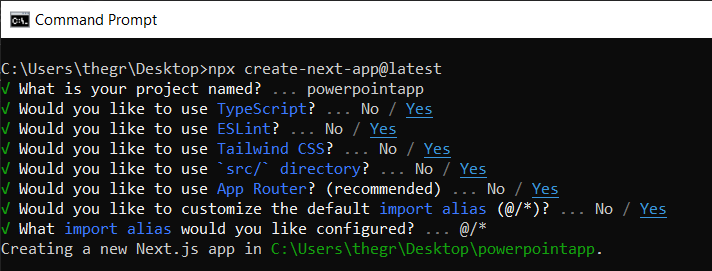 之後,使用您選擇的文字編輯器開啟新建立的 Nextjs 專案。然後在命令列中執行以下命令來安裝所有專案包和依賴項。 ``` npm i @copilotkit/backend @copilotkit/shared @langchain/langgraph @copilotkit/react-core @copilotkit/react-ui @copilotkit/react-textarea @heroicons/react ``` **建立 PowerPoint 應用程式前端** ------------------------ 讓我們先建立一個名為`Slide.tsx`的檔案。該文件將包含顯示和編輯投影片內容的程式碼,包括其`title` 、 `body text` 、 `background image`和`spoken narration text` 。 要建立該文件,請前往`/[root]/src/app`並建立一個名為`components`的資料夾。在 Components 資料夾中,建立`Slide.tsx`檔案。 之後,在文件頂部加入以下程式碼。程式碼定義了兩個名為`SlideModel`和`SlideProps`的 TypeScript 介面。 ``` "use client"; // Define an interface for the model of a slide, specifying the expected structure of a slide object. export interface SlideModel { title: string; content: string; backgroundImageDescription: string; spokenNarration: string; } // Define an interface for the properties of a component or function that manages slides. export interface SlideProps { slide: SlideModel; partialUpdateSlide: (partialSlide: Partial<SlideModel>) => void; } ``` 接下來,在上面的程式碼下面加入以下程式碼。程式碼定義了一個名為`Slide`功能元件,它接受`SlideProps`類型的 props。 ``` // Define a functional component named Slide that accepts props of type SlideProps. export const Slide = (props: SlideProps) => { // Define a constant for the height of the area reserved for speaker notes. const heightOfSpeakerNotes = 150; // Construct a URL for the background image using the description from slide properties, dynamically fetching an image from Unsplash. const backgroundImage = 'url("https://source.unsplash.com/featured/?' + encodeURIComponent(props.slide.backgroundImageDescription) + '")'; // Return JSX for the slide component. return ( <> {/* Slide content container with dynamic height calculation to account for speaker notes area. */} <div className="w-full relative bg-slate-200" style={{ height: `calc(100vh - ${heightOfSpeakerNotes}px)`, // Calculate height to leave space for speaker notes. }} > {/* Container for the slide title with centered alignment and styling. */} <div className="h-1/5 flex items-center justify-center text-5xl text-white text-center z-10" > {/* Textarea for slide title input, allowing dynamic updates. */} <textarea className="text-2xl bg-transparent text-black p-4 text-center font-bold uppercase italic line-clamp-2 resize-none flex items-center" style={{ border: "none", outline: "none", }} value={props.slide.title} placeholder="Title" onChange={(e) => { props.partialUpdateSlide({ title: e.target.value }); }} /> </div> {/* Container for the slide content with background image. */} <div className="h-4/5 flex" style={{ backgroundImage, backgroundSize: "cover", backgroundPosition: "center", }} > {/* Textarea for slide content input, allowing dynamic updates and styled for readability. */} <textarea className="w-full text-3xl text-black font-medium p-10 resize-none bg-red mx-40 my-8 rounded-xl text-center" style={{ lineHeight: "1.5", }} value={props.slide.content} placeholder="Body" onChange={(e) => { props.partialUpdateSlide({ content: e.target.value }); }} /> </div> </div> {/* Textarea for entering spoken narration with specified height and styling for consistency. */} <textarea className=" w-9/12 h-full bg-transparent text-5xl p-10 resize-none bg-gray-500 pr-36" style={{ height: `${heightOfSpeakerNotes}px`, background: "none", border: "none", outline: "none", fontFamily: "inherit", fontSize: "inherit", lineHeight: "inherit", }} value={props.slide.spokenNarration} onChange={(e) => { props.partialUpdateSlide({ spokenNarration: e.target.value }); }} /> </> ); }; ``` 之後,我們現在會建立一個名為`Presentation.tsx`的檔案。 該文件將包含初始化和更新投影片狀態、渲染目前投影片以及根據目前狀態動態啟用或停用按鈕實現導覽和投影片管理操作的程式碼。 要建立該文件,請將另一個文件新增至元件資料夾中,並將其命名為`Presentation.tsx` ,然後使用下列程式碼在檔案頂部匯入`React hooks` 、 `icons` 、 `SlideModel`和`Slide`元件。 ``` "use client"; import { useCallback, useMemo, useState } from "react"; import { BackwardIcon, ForwardIcon, PlusIcon, SparklesIcon, TrashIcon } from "@heroicons/react/24/outline"; import { SlideModel, Slide } from "./Slide"; ``` 之後,在上面的程式碼下面加入以下程式碼。程式碼定義了一個`ActionButton`功能元件,它將呈現具有可自訂屬性的按鈕元素。 ``` export const ActionButton = ({ disabled, onClick, className, children, }: { disabled: boolean; onClick: () => void; className?: string; children: React.ReactNode; }) => { return ( <button disabled={disabled} className={`bg-blue-500 text-white font-bold py-2 px-4 rounded ${disabled ? "opacity-50 cursor-not-allowed" : "hover:bg-blue-700"} ${className}`} onClick={onClick} > {children} </button> ); }; ``` 然後在上面的程式碼下面加入下面的程式碼。程式碼定義了一個名為「Presentation」的功能元件,用於初始化投影片的狀態並定義一個用於更新目前投影片的函數。 ``` // Define the Presentation component as a functional component. export const Presentation = () => { // Initialize state for slides with a default first slide and a state to track the current slide index. const [slides, setSlides] = useState<SlideModel[]>([ { title: `Welcome to our presentation!`, // Title of the first slide. content: 'This is the first slide.', // Content of the first slide. backgroundImageDescription: "hello", // Description for background image retrieval. spokenNarration: "This is the first slide. Welcome to our presentation!", // Spoken narration text for the first slide. }, ]); const [currentSlideIndex, setCurrentSlideIndex] = useState(0); // Current slide index, starting at 0. // Use useMemo to memoize the current slide object to avoid unnecessary recalculations. const currentSlide = useMemo(() => slides[currentSlideIndex], [slides, currentSlideIndex]); // Define a function to update the current slide. This function uses useCallback to memoize itself to prevent unnecessary re-creations. const updateCurrentSlide = useCallback( (partialSlide: Partial<SlideModel>) => { // Update the slides state by creating a new array with the updated current slide. setSlides((slides) => [ ...slides.slice(0, currentSlideIndex), // Copy all slides before the current one. { ...slides[currentSlideIndex], ...partialSlide }, // Merge the current slide with the updates. ...slides.slice(currentSlideIndex + 1), // Copy all slides after the current one. ]); }, [currentSlideIndex, setSlides] // Dependencies for useCallback. ); // The JSX structure for the Presentation component. return ( <div className="relative"> {/* Render the current slide by passing the currentSlide and updateCurrentSlide function as props. */} <Slide slide={currentSlide} partialUpdateSlide={updateCurrentSlide} /> {/* Container for action buttons located at the top-left corner of the screen. */} <div className="absolute top-0 left-0 mt-6 ml-4 z-30"> {/* Action button to add a new slide. Disabled state is hardcoded to true for demonstration. */} <ActionButton disabled={true} onClick={() => { // Define a new slide object. const newSlide: SlideModel = { title: "Title", content: "Body", backgroundImageDescription: "random", spokenNarration: "The speaker's notes for this slide.", }; // Update the slides array to include the new slide. setSlides((slides) => [ ...slides.slice(0, currentSlideIndex + 1), newSlide, ...slides.slice(currentSlideIndex + 1), ]); // Move to the new slide by updating the currentSlideIndex. setCurrentSlideIndex((i) => i + 1); }} className="rounded-r-none" > <PlusIcon className="h-6 w-6" /> {/* Icon for the button. */} </ActionButton> {/* Another action button, currently disabled and without functionality. */} <ActionButton disabled={true} onClick={async () => { }} // Placeholder async function. className="rounded-l-none ml-[1px]" > <SparklesIcon className="h-6 w-6" /> {/* Icon for the button. */} </ActionButton> </div> {/* Container for action buttons at the top-right corner for deleting slides, etc. */} <div className="absolute top-0 right-0 mt-6 mr-24"> <ActionButton disabled={slides.length === 1} // Disable button if there's only one slide. onClick={() => {}} // Placeholder function for the button action. className="ml-5 rounded-r-none" > <TrashIcon className="h-6 w-6" /> {/* Icon for the button. */} </ActionButton> </div> {/* Display current slide number and total slides at the bottom-right corner. */} <div className="absolute bottom-0 right-0 mb-20 mx-24 text-xl" style={{ textShadow: "1px 1px 0 #ddd, -1px -1px 0 #ddd, 1px -1px 0 #ddd, -1px 1px 0 #ddd", }} > Slide {currentSlideIndex + 1} of {slides.length} {/* Current slide and total slides. */} </div> {/* Container for navigation buttons (previous and next) at the bottom-right corner. */} <div className="absolute bottom-0 right-0 mb-6 mx-24"> {/* Button to navigate to the previous slide. */} <ActionButton className="rounded-r-none" disabled={ currentSlideIndex === 0 || true} // Example condition to disable button; 'true' is just for demonstration. onClick={() => { setCurrentSlideIndex((i) => i - 1); // Update currentSlideIndex to move to the previous slide. }} > <BackwardIcon className="h-6 w-6" /> {/* Icon for the button. */} </ActionButton> {/* Button to navigate to the next slide. */} <ActionButton className="mr-[1px] rounded-l-none" disabled={ true || currentSlideIndex + 1 === slides.length} // Example condition to disable button; 'true' is just for demonstration. onClick={async () => { setCurrentSlideIndex((i) => i + 1); // Update currentSlideIndex to move to the next slide. }} > <ForwardIcon className="h-6 w-6" /> {/* Icon for the button. */} </ActionButton> </div> </div> ); }; ``` 要在瀏覽器上呈現 PowerPoint 應用程式,請前往`/[root]/src/app/page.tsx`檔案並新增以下程式碼。 ``` "use client"; import "./style.css"; import { Presentation } from "./components/Presentation"; export default function AIPresentation() { return ( <Presentation /> ); } ``` 如果您想要在 Powerpoint 應用程式前端新增樣式,請在`/[root]/src/app`資料夾中建立名為`style.css`的檔案。 然後導航[到此 gist 文件](https://gist.github.com/TheGreatBonnie/e7c0b790a2e2af3e669810539ba54fed),複製 CSS 程式碼,並將其新增至 style.css 檔案。 最後,在命令列上執行命令`npm run dev` ,然後導航到 http://localhost:3000/。 現在您應該在瀏覽器上查看 PowerPoint 應用程式,如下所示。  **將 PowerPoint 應用程式與 CopilotKit 後端集成** -------------------------------------- 讓我們先在根目錄中建立一個名為`.env.local`的檔案。然後在保存 ChatGPT 和 Tavily Search API 金鑰的檔案中加入下面的環境變數。 ``` OPENAI_API_KEY="Your ChatGPT API key" TAVILY_API_KEY="Your Tavily Search API key" ``` 若要取得 ChatGPT API 金鑰,請導覽至 https://platform.openai.com/api-keys。  若要取得 Tavilly Search API 金鑰,請導覽至 https://app.tavily.com/home  之後,轉到`/[root]/src/app`並建立一個名為`api`的資料夾。在`api`資料夾中,建立一個名為`copilotkit`的資料夾。 在`copilotkit`資料夾中,建立一個名為`research.ts`的檔案。然後導航到[該 Research.ts gist 文件](https://gist.github.com/TheGreatBonnie/58dc21ebbeeb8cbb08df665db762738c),複製程式碼,並將其新增至**`research.ts`**檔案中 接下來,在`/[root]/src/app/api/copilotkit`資料夾中建立一個名為`route.ts`的檔案。該文件將包含設定後端功能來處理 POST 請求的程式碼。它有條件地包括對給定主題進行研究的“研究”操作。 現在在文件頂部導入以下模組。 ``` import { CopilotBackend, OpenAIAdapter } from "@copilotkit/backend"; // For backend functionality with CopilotKit. import { researchWithLangGraph } from "./research"; // Import a custom function for conducting research. import { AnnotatedFunction } from "@copilotkit/shared"; // For annotating functions with metadata. ``` 在上面的程式碼下面,定義一個執行時環境變數和一個註解的函數,以便使用下面的程式碼進行研究。 ``` // Define a runtime environment variable, indicating the environment where the code is expected to run. export const runtime = "edge"; // Define an annotated function for research. This object includes metadata and an implementation for the function. const researchAction: AnnotatedFunction<any> = { name: "research", // Function name. description: "Call this function to conduct research on a certain topic. Respect other notes about when to call this function", // Function description. argumentAnnotations: [ // Annotations for arguments that the function accepts. { name: "topic", // Argument name. type: "string", // Argument type. description: "The topic to research. 5 characters or longer.", // Argument description. required: true, // Indicates that the argument is required. }, ], implementation: async (topic) => { // The actual function implementation. console.log("Researching topic: ", topic); // Log the research topic. return await researchWithLangGraph(topic); // Call the research function and return its result. }, }; ``` 然後在上面的程式碼下加入下面的程式碼來定義處理POST請求的非同步函數。 ``` // Define an asynchronous function that handles POST requests. export async function POST(req: Request): Promise<Response> { const actions: AnnotatedFunction<any>[] = []; // Initialize an array to hold actions. // Check if a specific environment variable is set, indicating access to certain functionality. if (process.env["TAVILY_API_KEY"]) { actions.push(researchAction); // Add the research action to the actions array if the condition is true. } // Instantiate CopilotBackend with the actions defined above. const copilotKit = new CopilotBackend({ actions: actions, }); // Use the CopilotBackend instance to generate a response for the incoming request using an OpenAIAdapter. return copilotKit.response(req, new OpenAIAdapter()); } ``` **將 PowerPoint 應用程式與 CopilotKit 前端集成** -------------------------------------- 讓我們先導入`/[root]/src/app/components/Slide.tsx`檔案頂部的`useMakeCopilotActionable`掛鉤。 ``` import { useMakeCopilotActionable } from "@copilotkit/react-core"; ``` 在 Slide 函數中,新增以下程式碼,該程式碼使用`useMakeCopilotActionable`掛鉤來設定一個名為`updateSlide`的操作,該操作具有特定參數以及根據提供的值更新投影片的實作。 ``` useMakeCopilotActionable({ // Defines the action name. This is a unique identifier for the action within the application. name: "updateSlide", // Describes what the action does. In this case, it updates the current slide. description: "Update the current slide.", // Details the arguments that the action accepts. Each argument has a name, type, description, and a flag indicating if it's required. argumentAnnotations: [ { name: "title", // The argument name. type: "string", // The data type of the argument. description: "The title of the slide. Should be a few words long.", // Description of the argument. required: true, // Indicates that this argument must be provided for the action to execute. }, { name: "content", type: "string", description: "The content of the slide. Should generally consists of a few bullet points.", required: true, }, { name: "backgroundImageDescription", type: "string", description: "What to display in the background of the slide. For example, 'dog', 'house', etc.", required: true, }, { name: "spokenNarration", type: "string", description: "The spoken narration for the slide. This is what the user will hear when the slide is shown.", required: true, }, ], // The implementation of the action. This is a function that will be called when the action is executed. implementation: async (title, content, backgroundImageDescription, spokenNarration) => { // Calls a function passed in through props to partially update the slide with new values for the specified properties. props.partialUpdateSlide({ title, content, backgroundImageDescription, spokenNarration, }); }, }, [props.partialUpdateSlide]); // Dependencies array for the custom hook or function. This ensures that the action is re-initialized only when `props.partialUpdateSlide` changes. ``` 之後,請前往`/[root]/src/app/components/Presentation.tsx`檔案並使用下面的程式碼匯入頂部的 CopilotKit 前端套件。 ``` import { useCopilotContext } from "@copilotkit/react-core"; import { CopilotTask } from "@copilotkit/react-core"; import { useMakeCopilotActionable, useMakeCopilotReadable } from "@copilotkit/react-core"; ``` 在演示函數中,加入以下程式碼,該程式碼使用`useMakeCopilotReadable`掛鉤加入`Slides`和`currentSlide`幻燈片陣列作為應用程式內聊天機器人的上下文。掛鉤使副駕駛可以讀取簡報中的整個幻燈片集合以及當前幻燈片的資料。 ``` useMakeCopilotReadable("These are all the slides: " + JSON.stringify(slides)); useMakeCopilotReadable( "This is the current slide: " + JSON.stringify(currentSlide) ); ``` 在`useMakeCopilotReadable`掛鉤下方,新增以下程式碼,該程式碼使用`useCopilotActionable`掛鉤來設定名為`appendSlide`的操作,其中包含說明和加入多張幻燈片的實作函數。 ``` useMakeCopilotActionable( { // Defines the action's metadata. name: "appendSlide", // Action identifier. description: "Add a slide after all the existing slides. Call this function multiple times to add multiple slides.", // Specifies the arguments that the action takes, including their types, descriptions, and if they are required. argumentAnnotations: [ { name: "title", // The title of the new slide. type: "string", description: "The title of the slide. Should be a few words long.", required: true, }, { name: "content", // The main content or body of the new slide. type: "string", description: "The content of the slide. Should generally consist of a few bullet points.", required: true, }, { name: "backgroundImageDescription", // Description for fetching or generating the background image of the new slide. type: "string", description: "What to display in the background of the slide. For example, 'dog', 'house', etc.", required: true, }, { name: "spokenNarration", // Narration text that will be read aloud during the presentation of the slide. type: "string", description: "The text to read while presenting the slide. Should be distinct from the slide's content, and can include additional context, references, etc. Will be read aloud as-is. Should be a few sentences long, clear, and smooth to read.", required: true, }, ], // The function to execute when the action is triggered. It creates a new slide with the provided details and appends it to the existing slides array. implementation: async (title, content, backgroundImageDescription, spokenNarration) => { const newSlide: SlideModel = { // Constructs the new slide object. title, content, backgroundImageDescription, spokenNarration, }; // Updates the slides state by appending the new slide to the end of the current slides array. setSlides((slides) => [...slides, newSlide]); }, }, [setSlides] // Dependency array for the hook. This action is dependent on the `setSlides` function, ensuring it reinitializes if `setSlides` changes. ); ``` 在上面的程式碼下方,定義一個名為`context`的變數,該變數使用名為`useCopilotContext`的自訂掛鉤從 copilot 上下文中檢索當前上下文。 ``` const context = useCopilotContext(); ``` 之後,定義一個名為`generateSlideTask`的函數,它包含一個名為`CopilotTask`的類別。 `CopilotTask`類別定義用於產生與簡報的整體主題相關的新投影片的指令 ``` const generateSlideTask = new CopilotTask({ instructions: "Make the next slide related to the overall topic of the presentation. It will be inserted after the current slide. Do NOT carry any research", }); ``` 然後在上面的程式碼下面初始化一個名為`generateSlideTaskRunning`的狀態變數,預設值為false。 ``` const [generateSlideTaskRunning, **setGenerateSlideTaskRunning**] = useState(false); ``` 之後,使用下面的程式碼更新簡報元件中的操作按鈕,以透過新增、刪除和導覽投影片來新增動態互動。 ``` // The JSX structure for the Presentation component. return ( <div className="relative"> {/* Renders the current slide using a Slide component with props for the slide data and a method to update it. */} <Slide slide={currentSlide} partialUpdateSlide={updateCurrentSlide} /> {/* Container for action buttons positioned at the top left corner of the relative parent */} <div className="absolute top-0 left-0 mt-6 ml-4 z-30"> {/* ActionButton to add a new slide. It is disabled when a generateSlideTask is running to prevent concurrent modifications. */} <ActionButton disabled={generateSlideTaskRunning} onClick={() => { const newSlide: SlideModel = { title: "Title", content: "Body", backgroundImageDescription: "random", spokenNarration: "The speaker's notes for this slide.", }; // Inserts the new slide immediately after the current slide and updates the slide index to point to the new slide. setSlides((slides) => [ ...slides.slice(0, currentSlideIndex + 1), newSlide, ...slides.slice(currentSlideIndex + 1), ]); setCurrentSlideIndex((i) => i + 1); }} className="rounded-r-none" > <PlusIcon className="h-6 w-6" /> </ActionButton> {/* ActionButton to generate a new slide based on the current context, also disabled during task running. */} <ActionButton disabled={generateSlideTaskRunning} onClick={async () => { setGenerateSlideTaskRunning(true); // Indicates the task is starting. await generateSlideTask.run(context); // Executes the task with the current context. setGenerateSlideTaskRunning(false); // Resets the flag when the task is complete. }} className="rounded-l-none ml-[1px]" > <SparklesIcon className="h-6 w-6" /> </ActionButton> </div> {/* Container for action buttons at the top right, including deleting the current slide and potentially other actions. */} <div className="absolute top-0 right-0 mt-6 mr-24"> {/* ActionButton for deleting the current slide, disabled if a task is running or only one slide remains. */} <ActionButton disabled={generateSlideTaskRunning || slides.length === 1} onClick={() => { console.log("delete slide"); // Removes the current slide and resets the index to the beginning as a simple handling strategy. setSlides((slides) => [ ...slides.slice(0, currentSlideIndex), ...slides.slice(currentSlideIndex + 1), ]); setCurrentSlideIndex((i) => 0); }} className="ml-5 rounded-r-none" > <TrashIcon className="h-6 w-6" /> </ActionButton> </div> {/* Display showing the current slide index and the total number of slides. */} <div className="absolute bottom-0 right-0 mb-20 mx-24 text-xl" style={{ textShadow: "1px 1px 0 #ddd, -1px -1px 0 #ddd, 1px -1px 0 #ddd, -1px 1px 0 #ddd", }} > Slide {currentSlideIndex + 1} of {slides.length} </div> {/* Navigation buttons to move between slides, disabled based on the slide index or if a task is running. */} <div className="absolute bottom-0 right-0 mb-6 mx-24"> {/* Button to move to the previous slide, disabled if on the first slide or a task is running. */} <ActionButton className="rounded-r-none" disabled={generateSlideTaskRunning || currentSlideIndex === 0} onClick={() => { setCurrentSlideIndex((i) => i - 1); }} > <BackwardIcon className="h-6 w-6" /> </ActionButton> {/* Button to move to the next slide, disabled if on the last slide or a task is running. */} <ActionButton className="mr-[1px] rounded-l-none" disabled={generateSlideTaskRunning || currentSlideIndex + 1 === slides.length} onClick={async () => { setCurrentSlideIndex((i) => i + 1); }} > <ForwardIcon className="h-6 w-6" /> </ActionButton> </div> </div> ); ``` 現在讓我們轉到`/[root]/src/app/page.tsx`文件,使用下面的程式碼匯入 CopilotKit 前端包和文件頂部的樣式。 ``` import { CopilotKit, } from "@copilotkit/react-core"; import { CopilotSidebar } from "@copilotkit/react-ui"; import "@copilotkit/react-ui/styles.css"; import "@copilotkit/react-textarea/styles.css"; ``` 然後使用`CopilotKit`和`CopilotSidebar`來包裝Presentation元件,如下所示。 ``` export default function AIPresentation() { return ( <CopilotKit url="/api/copilotkit/"> <CopilotSidebar instructions="Help the user create and edit a powerpoint-style presentation. IMPORTANT NOTE: SOMETIMES you may want to research a topic, before taking further action. BUT FIRST ASK THE USER if they would like you to research it. If they answer 'no', do your best WITHOUT researching the topic first." defaultOpen={true} labels={{ title: "Presentation Copilot", initial: "Hi you! 👋 I can help you create a presentation on any topic.", }} clickOutsideToClose={false} > <Presentation /> </CopilotSidebar> </CopilotKit> ); } ``` 之後,執行開發伺服器並導航到 http://localhost:3000/。您應該會看到應用程式內聊天機器人已整合到 PowerPoint Web 應用中。  最後,給右側的聊天機器人一個提示,例如“在 JavaScript 上建立 PowerPoint 簡報”,聊天機器人將開始產生回應,完成後,使用底部的前進按鈕瀏覽產生的幻燈片。 注意:如果聊天機器人沒有立即產生投影片,請根據其回應給予適當的後續提示。  結論 -- 總而言之,您可以使用 CopilotKit 建立應用內 AI 聊天機器人,該機器人可以查看當前應用程式狀態並在應用程式內執行操作。 AI 聊天機器人可以與您的應用程式前端、後端和第三方服務對話。 完整的原始碼:https://github.com/TheGreatBonnie/aipoweredpowerpointapp --- 原文出處:https://dev.to/copilotkit/how-to-build-an-ai-powered-powerpoint-generator-langchain-copilotkit-openai-nextjs-4c76
他們說有些人就是喜歡混亂。 大家好👋🏼,我是格雷厄姆「喜歡混亂」TheDev,這次我帶著另一個愚蠢的網路實驗回來了(如果你願意,你可以[直接跳到遊戲](#the-game))。 一切都是那麼天真地開始,「我可以寫一個貪吃蛇遊戲嗎?」。 但是,一如既往,我肩膀上的小惡魔低聲說「讓它變得更難」......所以我想「沒有 JavaScript,用純 CSS 來做」。 他再次嘰嘰喳喳地說:「噗,還是太簡單了,而且你最近做了太多 CSS 東西,用原始的、無樣式的 HTML 來做吧」。 我轉向另一邊肩膀,想聽聽天使的想法,希望得到更明智的結果。 然後我想起天使從來沒有在我身邊... 所以這就是,snake,純 HTML 格式(用一點 PHP 技巧來支援它)。 這是正確的! - 沒有 JavaScript - 沒有圖片 - 沒有CSS - 沒有 Cookie 不過,我想澄清一下(因為我不想被指責為點擊誘餌),我正在使用 PHP 渲染此 HTML。 雖然可以僅使用文件以純 HTML 形式完成此操作,無需後端語言,但它需要 640,345,228,142,352,307,046,244,325,015,114,448,670,890, 662,773,914,918,117,331,955,996,440,709,549,671,345,290,477,020,322,434,911,210,797,593,280,795,101, 545,372,667,251,627,877,890,009,349,763,765,710,326,350,331,533,965,349,868,386,831,339,352,024,373, 788,157,786,791,506,311,858,702,618,270,169,819,740,062,983,025,308,591,298,346,162,272,304,558,339, 520,759,611,505,302,236,086,810,433,297,255,194,852,674,432,232,438,669,948,422,404,232,599,805,551,610,635,942,376,961,399 ,231,917,134,063,858,996,537,970,147,827,206,606,320,217,379,472,010,321,356,624,613,809,077,942,304,597,360,699,567,595,836, 096,158,715,129,913,822,286,578,579,549,361,617,654,480,453,222,007,825,818,400,848,436,415,591,229,454,275,384,803,558,374,5 18,022,675,900,061,399,560,145,595,206,127,211,192,918,105,032,491,008,000,000,000,000,000,000,000,000,000,000,000,000,000,00 0,000,000,000,000,000,000,000,000,000,000,000,000,000,000,000 個文件。 所以請原諒使用 PHP 產生下一頁的「捷徑」(對於那些在技術 Twitter 上花費太多時間的人,也請原諒我使用「死」語言!😱🤣)。 不管怎樣,序言太多了,我知道你為什麼來這裡,你想看到它的實際效果! 玩 HTML 貪吃蛇(有警告!) ---------------- 在桌面 PC 上的 Chrome 上執行...對於我來說,在 Firefox 和 iOS 上的任何瀏覽器上執行速度太快...您將在本文後面了解原因。 所以基本上,在桌面版 Chrome 中玩吧! 關鍵是: - ALT + I向上, - ALT + J向左, - ALT + K向下, - ALT + L向右, - ALT + O開始新遊戲(一旦你輸了)。 在 Mac 上,我相信是Control + Option而不是Alt ! 如果你想知道為什麼奇怪的鍵而不是 WASD,不幸的是ALT + D已經在 Windows 上的 Chrome 中使用,所以我不得不選擇「安全」鍵。 **最後一個警告:**我們用於實現此功能的技巧之一會用大量 URL 淹沒您的瀏覽器歷史記錄...您已被警告! ### 遊戲 **遺憾的是,這無法在 codepen 中執行,因此您必須[在我的網站上玩 HTML Snake](https://grahamthe.dev/demos/snake/) 。** 當你玩完後,回來看看我用了什麼技巧來完成這個工作(並在評論中分享你的最高分!)。 問題 1:取得遊戲勾選 ----------- 對於遊戲,您*通常*需要有一個“遊戲勾選”。每個刻度是當一個動作發生或您計算一個新的遊戲狀態然後渲染新的遊戲狀態。 但這提出了我們的第一個問題,我們如何能夠在沒有 JavaScript 的情況下自動更新頁面? 嗯,在 HTML 中執行此操作實際上非常簡單,我們只需將[`<meta http-equiv="refresh"`](https://developer.mozilla.org/en-US/docs/Web/HTML/Element/meta#http-equiv)設為較低值即可。 因此,我們從 0.35 秒刷新時間開始,然後隨著您的分數攀升,將刷新時間加快至 0.2 秒。 「元刷新」允許我們做的是指示瀏覽器載入頁面的 HTML 後,等待 X 秒,然後載入另一個 URL。 透過設定較低的刷新時間,然後更改我們在每次刷新時重定向到的 URL(稍後會詳細介紹),我們有一種方法可以讓頁面自行更改,即使您不按任何按鈕! 以下是格式的簡單範例: ``` <meta http-equiv="refresh" content="[time];url=[url-to-redirect-to]"> ``` **附註:**這是我之前提到的它不適用於其他瀏覽器的地方。他們不排除部分第二次刷新時間,因此刷新是即時的,使得遊戲太快而無法玩。 但僅元刷新不足以使遊戲正常執行,我們需要某種方法來保存遊戲狀態並將蛇方向的變化傳達給伺服器。 為此,我們使用另一個直接的技巧:URL 編碼的 GET 參數。 問題 2:管理遊戲狀態 ----------- 因為我們不能使用 POST 請求或類似的東西,所以我們需要另一個機制來管理瀏覽器和伺服器之間的遊戲狀態。 起初,我使用多個 GET 參數來管理狀態,因此 URL 如下所示: ``` url?playing=1&x=2&y=6&foodx=3&foody=6&dir=left. ``` 這一直工作得很好,直到我需要為蛇儲存多個點(它佔據的每個方塊的 x,y 座標)。 雖然我確實讓它與一些 hacky x,y 座標列表和解析一起工作(例如`snake=1,1,2,1` ,蛇位於x=1,y=1 和x=2,y=1),但這是凌亂的。 因此,我們轉向我們的好朋友: [`urlencode()`](https://www.php.net/manual/en/function.urlencode.php)和[`json_encode()`](https://www.php.net/manual/en/function.json-encode.php) 。 一起使用時,我可以取得一個陣列(或在本例中為多維陣列),將其轉換為 JSON,然後將其轉換為 URL 的有效字元。 讓我解釋: ### 在 URL 中儲存複雜資料 以下是我用於遊戲狀態的資料範例: ``` $state = array( 'width' => $width, 'height' => $height, 'snake' => array(array('x' => 5, 'y' => 5)), 'food' => array('x' => 7, 'y' => 7), 'direction' => 'right', 'score' => 0, 'state' => true ); ``` 要將這些資料儲存在 URL 中,我們可以使用以下命令: ``` $url = urlencode(json_encode($state)); ``` 透過 JSON 編碼我們的陣列,然後用 URL 友好的字符替換無效字符,這以 URL 友好(儘管不是人類友好!)的方式為我們提供了狀態: ``` %7B%22width%22%3A20%2C%22height%22%3A20%2C%22snake%22%3A%5B%7B%22x%22%3A19%2C%22y%22%3A5%7D%5D%2C%22food%22%3A%7B%22x%22%3A4%2C%22y%22%3A11%7D%2C%22direction%22%3A%22right%22%2C%22score%22%3A0%2C%22state%22%3Afalse%7D ``` 現在我們有一個機制可以將遊戲狀態傳遞到瀏覽器並備份到伺服器。 ### 最大 URL 長度 那些了解自己的東西的人會知道這裡有一個問題。 URL 長度有最大限制! 在 Chrome 中是 2083 個字元。 如果您玩遊戲的時間足夠長,您實際上會達到字元限制,因為為了儲存 x,y 位置對,我們每次使用超過 10 個字元。 但這是一個愚蠢的演示,所以我只想說:讓我知道如果你讓你的蛇足夠長,會發生什麼錯誤! 哦,在現實世界中,**您不應該對 URL 中的參數進行 JSON 編碼**,我們就這樣吧! 我們有狀態和遊戲標記,現在怎麼辦? ----------------- 這就對了! 嗯,差不多了。 我們需要將按鍵資訊傳達給伺服器。 ### 問題3:改變蛇的方向 這是最後一個問題(也是我們最終在 URL 中顯示遊戲狀態的原因),我們需要向伺服器傳達按鍵訊息以更改蛇的方向。 #### 問題 3a:按下按鈕 在我們將按鍵傳達給伺服器之前,我們需要某種方法來實際捕獲它們。 請記住,我們沒有 JS 來捕獲按鍵操作。 我們也不能使用`<button>`元素,因為它們需要 JS 才能運作。 所以我們剩下的就是不起眼的錨元素( `<a>` )。 但讓某人點擊錨點會讓遊戲變得很難玩。 幸運的是,HTML 中內建了一種名為[`accesskey`的](https://developer.mozilla.org/en-US/docs/Web/HTML/Global_attributes/accesskey)東西。 它們允許我們將一個字元指派給一個錨點,然後可以透過捷徑(ALT + Windows 上 Chrome 中的字元)存取這些字元。 這為我們提供了允許鍵盤控制的機制,我們只需要 4 個具有不同方向的連結(錨點)作為 URL,然後為每個連結分配一個`accesskey` 。 **重要提示:**應謹慎使用`accesskey` ,如果您選擇輔助科技 (AT) 使用者使用的按鍵,則可能會產生幹擾。 #### 問題 3b:方向 現在我們有了一種按鍵方法,以及一種將按鍵操作傳達給伺服器的方法,我們需要一種方法來管理按鍵操作,以便它們更新蛇的方向。 幸運的是,我們透過 URL 傳遞的狀態物件中已經有了一個`direction`屬性。 因此,我們要做的就是建立 4 個不同的 URL,每個方向一個。然後我們將這些加入到連結中就完成了。 ``` $encodedState = urlencode(json_encode($state)); <a href="index.php?state=<?php echo $encodedState; ?>&direction=up" accesskey="i">up (ALT + I)</a><br/> <a href="index.php?state=<?php echo $encodedState; ?>&direction=left" accesskey="j">left (ALT + J)</a> <a href="index.php?state=<?php echo $encodedState; ?>&direction=right" accesskey="l">right (ALT + L)</a> <a href="index.php?state=<?php echo $encodedState; ?>&direction=down" accesskey="k">down (ALT + K)</a> ``` 現在,例如,當您按ALT + K時,將單擊第四個連結,我們將當前狀態+新方向發送到伺服器! 現在剩下的就是獲取該資訊併計算下一個遊戲狀態。 ### 遊戲邏輯 最後,謎題的最後一部分是一些遊戲邏輯。 例如,在生成食物位置時,我們需要檢查它是否不在蛇已經佔據的圖塊上,因此我們有以下函數: ``` function generateFoodPosition($width, $height, $snake) { do { $food = array( 'x' => rand(0, $width - 1), 'y' => rand(0, $height - 1)); } while ( in_array($food, $snake) ); return $food; } ``` 還有一個移動蛇的功能 ``` function moveSnake($state) { $newHead = array('x' => $state['snake'][0]['x'], 'y' => $state['snake'][0]['y']); // Update snake's head position based on direction switch ($state['direction']) { case 'up': $newHead['y']--; break; case 'down': $newHead['y']++; break; case 'left': $newHead['x']--; break; case 'right': $newHead['x']++; break; } // Check if snake has collided with the wall or itself if ($newHead['x'] < 0 || $newHead['x'] >= $state['width'] || $newHead['y'] < 0 || $newHead['y'] >= $state['height'] || in_array($newHead, array_slice($state['snake'], 1))) { $state['state'] = false; return $state; // Game over } // Check if snake has eaten the food if ($newHead['x'] == $state['food']['x'] && $newHead['y'] == $state['food']['y']) { $state['score'] += 10; // Generate new food position $state['food'] = generateFoodPosition($state['width'], $state['height'], $state['snake']); } else { // Remove tail segment array_pop($state['snake']); } // Move snake array_unshift($state['snake'], $newHead); return $state; } ``` 以及建構遊戲板的循環。 ``` for ($y = 0; $y < 20; $y++) { echo "\r\n"; for ($x = 0; $x < 20; $x++) { if ($x == $state['food']['x'] && $y == $state['food']['y']) { echo '🍎'; } elseif (in_array(array('x' => $x, 'y' => $y), $state['snake'])) { echo '🟩'; }else{ echo '⬜'; } } } ``` 但我不會詳細介紹這些內容,因為您可以輕鬆找到(並找到更簡潔的方法)、找到其他人編寫的(更好的)程式碼並適應您的需求。 這是一個包裝 ------ 現在你已經知道了,我們使用元刷新、存取鍵和在 URL 中編碼複雜資料的技巧建立了一個遊戲。 這些東西對你的日常生活有用嗎?不,可能不會。 他們是否會在一個奇怪的邊緣情況下拯救你的屁股,完成這個工作,有能力使用黑客來交付產品情況?可能吧。 什麼?您沒想到我會提供您有用的教學嗎?你現在應該更清楚了。 但是,話雖如此,如果您確實喜歡這篇文章,或者奇蹟般地學到了一些新東西,請在下面給我留言,這真的意義重大! 祝大家週末愉快! 💗 --- 原文出處:https://dev.to/grahamthedev/snakein-pure-html-no-js-no-css-no-images-2ccg
在开发中我们常常会遇到这样一个问题,代码如下: ```ts const arr = [ "a", "b", "c", "d", "e", "f", "g", "h", "i", "j", "k", "l", "m", "n", "o", "p", "q", "r", "s", "t", "u", "v", "w", "x", "y", "z", ]; const func = (str) => { // ... } ``` 我们想要传入一个参数到`str`,而且这个参数必须是`arr`数组中的某一个元素,这时我们希望的是可以直接得到这个`arr`的联合类型,接下来一般我们会使用传统的方法去声明类型,如下: ```ts type Strs = "a" | "b" | "c" | "d" | "e" | "f" | "g" | "h" | "i" | "j" | "k" | "l" | "m" | "n" | "o" | "p" | "q" | "r" | "s" | "t" | "u" | "v" | "w" | "x" | "y" | "z"; const func = (str: Strs) => { // ... } ``` 先不说这样的写法很笨,写的时候就已经很ex了,我们希望的是`Strs`可以根据上面`arr`的值来自动生成一个联合类型,这时我们可以有一个技巧来解决这个问题,就是先将`str`转换为元组: ```ts const arr = [ "a", "b", "c", // ... ] as const; ``` 没转换前`arr`的类型为`string[]`: ![1.png][1] 转换成元组后: ![2.png][2] 然后我们就可以使用`typeof`来生成一个联合类型: ![3.png][3] 最后我们给入参定义这个类型: ![4.png][4] 最后大功告成😎。 [1]: https://www.zowlsat.com/usr/uploads/2024/03/2120669339.png [2]: https://www.zowlsat.com/usr/uploads/2024/03/31248959.png [3]: https://www.zowlsat.com/usr/uploads/2024/03/111818700.png [4]: https://www.zowlsat.com/usr/uploads/2024/03/3214248489.png
我可能不是唯一一個對瀏覽器的預設`<input type="checkbox">`感到沮喪的開發人員。 首先:**它不可擴展。**在此範例中,字體大小已縮放至`200%` ,但複選框仍保持其根大小,即`13.333333px` :  在本教程中,我們將剖析瀏覽器的預設複選框,看看是否可以做得更好。 --- 首先,我們需要使用`appearance:none`清除預設樣式並設定初始大小 - 這將是一個相對單位`em` : ``` [type=checkbox] { appearance: none; aspect-ratio: 1; box-sizing: border-box; font-size: 1em; width: 1em; } ``` `background-color`應該適應深色模式,因此我們將檢查它是否與任何[系統顏色](https://developer.mozilla.org/en-US/docs/Web/CSS/system-color)相符。它似乎與`Field`系統顏色匹配,所以讓我們使用它。 對於 Chrome 中的邊框顏色,它與系統顏色`ButtonBorder`匹配,但由於 Safari 使用*更輕的*`ButtonBorder` ,我們將使用適用於兩種瀏覽器的`GrayCanvas` 。 我們將加入一些 CSS 自訂屬性,稍後我們將使用它們來建立變體。 對於`border-radius`和`margin` ,我們將使用預設值,但將它們轉換為相對單位`em` 。 `border-width`似乎使用以下公式進行縮放: ``` (4/3) / root size ``` 由於根大小為`13.333333px` ,我們現在有: ``` [type=checkbox] { --_bdw: calc(1em * (4/3) / 13.333333); appearance: none; aspect-ratio: 1; background: var(--_bg, Field); border: var(--_bdw) solid var(--_bdc, GrayText); border-radius: var(--_bdrs, .2em); box-sizing: border-box; font-size: 1em; margin: var(--_m, .1875em .1875em .1875em .25em); position: relative; width: 1em; } ``` 讓我們看看它是否可擴展:  好的!深色模式呢?  這就是為什麼我**喜歡**系統顏色!接下來,讓我們新增瀏覽器在**未選取的**複選框上使用的相同懸停效果。 我們將混合`CanvasText` ,它在淺色模式下為黑色,在深色模式下為白色,並簡單地更新我們在上一步中加入的`--_bdc`屬性: ``` @media (hover: hover) { &:not(:checked):hover { --_bdc: color-mix(in srgb, GrayText 60%, CanvasText 40%); } } ``` --- 複選標記 ---- 現在是複選標記。我們**可以**在`::after`元素中使用旋轉的 CSS 方塊來做到這一點: ``` [type=checkbox]::after { border-color: GrayText; border-style: solid; border-width: 0 0.15em 0.15em 0; box-sizing: border-box; content: ''; aspect-ratio: 1 / 1.8; rotate: 40deg; width: 0.375em; } ```  雖然這工作得很好,但我更喜歡在蒙版中使用 SVG,因為它更靈活。為此,我們將為遮罩加入一個屬性,並為`::after`元素的背景加入另一個`--_bga` ,該屬性將是複選標記的**顏色**。 ``` [role=checkbox] { --_bga: Field; --_mask: url('data:image/svg+xml,<svg xmlns="http://www.w3.org/2000/svg" viewBox="0 0 24 24" stroke-width="3" stroke="%23000" fill="none" stroke-linecap="round" stroke-linejoin="round"> <path d="M5 12l5 5l10 -10"/></svg>'); &::after { background: var(--_bga, transparent); content: ""; inset: 0; position: absolute; mask: var(--_mask) no-repeat center / contain; -webkit-mask: var(--_mask) no-repeat center / contain; } } ``` 所以,我們現在**確實**有一個複選標記,只是看不到它,因為蒙版顏色設定為`transparent` 。 讓我們使用`:checked` -state 更新點擊時複選框的顏色。但在此之前,我們需要先弄清楚**哪種**顏色! Safari 是唯一支援系統顏色`AccentColor`瀏覽器,因此我們需要為此建立自己的變數`--_accent` ,在 Mac 上對應於`#0075ff` : ``` [type=checkbox] { --_accent: #0075ff; &:checked { --_bdc: transparent; --_bg: var(--_accent); --_bga: Field; } } ``` 讓我們看看我們建構了什麼:  還有深色模式?我們需要先更新`--_accent`屬性,因為`AccentColor`尚未在所有瀏覽器中運作: ``` @media (prefers-color-scheme: dark) { --_accent: #99C8FF; } ``` 讓我們檢查:  涼爽的!現在我們需要加入的是`:checked:hover` -state,它類似於我們之前新增的 border-hover: ``` @media (hover: hover) { &:checked:hover { --_bg: color-mix(in srgb, var(--_accent) 60%, CanvasText 40%); } } ``` 讓我們比較一下它在 Chrome、Safari 和 Firefox 中的外觀:  看來我們通過考驗了! --- 變體 -- 建立變體非常簡單:您只需要更新一些屬性。例子: ``` .rounded { --_bdrs: 50%; } .square { --_bdrs: 0; } ``` 然後在 HTML 中: ``` <input type="checkbox" class="rounded"> <input type="checkbox" class="square"> ```  — 或全力以赴並建立*老式*複選框:  > **關於圓形複選框的註釋:**這是*不好的*做法,正如您可以在[這篇精彩的文章](https://tonsky.me/blog/checkbox/)中讀到的那樣。不過,也有一些例外,例如這個「影像選擇器」:  開關 -- 對於開關,我們將加入一個`role="switch"` ,所以它是: ``` <input type="checkbox" role="switch"> ``` 蘋果最近加入了[自己的 switch-control](https://dev.to/madsstoumann/a-first-look-at-apples-new-switch-control-3pnd) ,但`role="switch"`是跨瀏覽器的。同樣,我們只需要更新我們之前建立的許多屬性: ``` [role=switch] { --_bdc--hover: transparent; --_bdrs: 1em; --_bg: #d1d1d1; --_bga: Field; --_mask: none; aspect-ratio: 1.8 / 1; border: 0; display: grid; padding: .125em; place-content: center start; width: 1.8em; &::after { border-radius: 50%; height: .75em; inset: unset; position: static; width: .75em; } &:checked { --_bg: var(--_bg--checked, var(--_accent)); justify-content: end; } } ``` 這給了我們:  --- 示範 -- 就是這樣!下面是帶有演示的 Codepen: https://codepen.io/stoumann/pen/OJqQNgm --- 駭客與縫合 ----- 以下是我在 Codepen 上使用複選框所做的一系列工作: ### 複選框電影院 選擇座位。還可以修改為在火車、飛機上選擇座位...... https://codepen.io/stoumann/pen/eYXpEBa ### 天際線複選框 點擊窗戶打開公寓裡的燈… https://codepen.io/stoumann/pen/KKbGJqd ### 按數字繪畫 先選擇一種顏色(使用`<input type="radio">` ),然後按一下對應的數字(複選框)... https://codepen.io/stoumann/pen/VwRejpR ### 點對點 不需要 JavaScript,但我把它留在那裡供你玩… https://codepen.io/stoumann/pen/zYbNRNL ### 來自地獄的條款和條件 檢查全部… https://codepen.io/stoumann/pen/GRwRjYP --- 每日 toggle ---- Alvaro Montoro 正在建立大量開關/撥動開關 - 2024 年每天一個。請[在此處](https://codepen.io/collection/aMPYMo)查看。 --- 原文出處:https://dev.to/madsstoumann/styling-checkboxes-and-switches-pf0
歡迎使用我們精選的 JavaScript 技巧集合,它將幫助您優化程式碼、使其更具可讀性並節省您的時間。 讓我們深入研究 JavaScript 的功能和超越傳統的技巧,並發現這種強大的程式語言的全部潛力。 ### 1. 使用!!轉換為布林值 使用雙重否定快速將任何值轉換為布林值。 ``` let truthyValue = !!1; // true let falsyValue = !!0; // false ``` ### 2. 預設功能參數 設定函數參數的預設值以避免未定義的錯誤。 ``` function greet(name = "Guest") { return `Hello, ${name}!`; } ``` ### 3. 短 if-else 的三元運算符 `if-else`語句的簡寫。 ``` let price = 100; let message = price > 50 ? "Expensive" : "Cheap"; ``` ### 4. 動態字串的範本文字 使用模板文字在字串中嵌入表達式。 ``` let item = "coffee"; let price = 15; console.log(`One ${item} costs $${price}.`); ``` ### 5. 解構賦值 輕鬆從物件或陣列中提取屬性。 ``` let [x, y] = [1, 2]; let {name, age} = {name: "Alice", age: 30}; ``` ### 6. 用於陣列和物件克隆的擴展運算符 克隆陣列或物件而不引用原始陣列或物件。 ``` let originalArray = [1, 2, 3]; let clonedArray = [...originalArray]; ``` ### 7. 短路評估 使用邏輯運算子進行條件執行。 ``` let isValid = true; isValid && console.log("Valid!"); ``` ### 8. 可選連結 (?.) 如果引用為`nullish`則可以安全地存取巢狀物件屬性,而不會出現錯誤。 ``` let user = {name: "John", address: {city: "New York"}}; console.log(user?.address?.city); // "New York" ``` ### 9. 空合併運算子 (??) 使用`??`為`null`或`undefined`提供預設值。 ``` let username = null; console.log(username ?? "Guest"); // "Guest" ``` [](https://try.monday.com/9xf9ftaa4i2f) ### 10. 使用`map` 、 `filter`和`reduce`進行陣列操作 無需傳統循環即可處理陣列的優雅方法。 ``` // Map let numbers = [1, 2, 3, 4]; let doubled = numbers.map(x => x * 2); // Filter const evens = numbers.filter(x => x % 2 === 0); // Reduce const sum = numbers.reduce((accumulator, currentValue) => accumulator + currentValue, 0); ``` ### 11.標記模板文字 使用模板文字進行函數呼叫以進行自訂字串處理。 ``` function highlight(strings, ...values) { return strings.reduce((prev, current, i) => `${prev}${current}${values[i] || ''}`, ''); } let price = 10; console.log(highlight`The price is ${price} dollars.`); ``` ### 12.使用Object.entries()和Object.fromEntries() 將物件轉換為陣列並返回以方便操作。 ``` let person = {name: "Alice", age: 25}; let entries = Object.entries(person); let newPerson = Object.fromEntries(entries); ``` ### 13. 唯一元素的集合物件 使用 Set 儲存任何類型的唯一值。 ``` let numbers = [1, 1, 2, 3, 4, 4]; let uniqueNumbers = [...new Set(numbers)]; ``` ### 14. 物件中的動態屬性名稱 在物件文字表示法中使用方括號來建立動態屬性名稱。 ``` let dynamicKey = 'name'; let person = {[dynamicKey]: "Alice"}; ``` ### 15. 使用bind()進行函數柯里化 建立一個新函數,在呼叫時將其 this 關鍵字設定為提供的值。 ``` function multiply(a, b) { return a * b; } let double = multiply.bind(null, 2); console.log(double(5)); // 10 ``` ### 16. 使用 Array.from() 從類別陣列物件建立陣列 將類似陣列或可迭代的物件轉換為真正的陣列。 ``` let nodeList = document.querySelectorAll('div'); let nodeArray = Array.from(nodeList); ``` ### 17. 可迭代物件的 for...of 循環 直接迭代可迭代物件(包括陣列、映射、集合等)。 ``` for (let value of ['a', 'b', 'c']) { console.log(value); } ``` ### 18. 使用 Promise.all() 實作並發 Promise 同時執行多個 Promise 並等待所有的都解決。 ``` let promises = [fetch(url1), fetch(url2)]; Promise.all(promises) .then(responses => console.log('All done')); ``` ### 19. 函數參數的剩餘參數 將任意數量的參數捕獲到陣列中。 ``` function sum(...nums) { return nums.reduce((acc, current) => acc + current, 0); } ``` [](https://imp.i384100.net/c/3922519/1320997/14726) ### 20. 用於性能優化的記憶 儲存函數結果以避免冗餘處理。 ``` const memoize = (fn) => { const cache = {}; return (...args) => { let n = args[0]; // assuming single argument for simplicity if (n in cache) { console.log('Fetching from cache'); return cache[n]; } else { console.log('Calculating result'); let result = fn(n); cache[n] = result; return result; } }; }; ``` ### 21. 使用 ^ 交換值 使用 XOR 以位元運算子交換兩個變數的值,無需使用臨時變數。 ``` let a = 1, b = 2; a ^= b; b ^= a; a ^= b; // a = 2, b = 1 ``` ### 22. 使用 flat() 展平陣列 使用`flat()`方法輕鬆展平巢狀陣列,並將展平深度作為可選參數。 ``` let nestedArray = [1, [2, [3, [4]]]]; let flatArray = nestedArray.flat(Infinity); ``` ### 23. 用一元加法轉換為數字 使用一元加運算子快速將字串或其他值轉換為數字。 ``` let str = "123"; let num = +str; // 123 as a number ``` ### 24. HTML 片段的模板字串 使用模板字串建立 HTML 片段,使動態 HTML 生成更加清晰。 ``` let items = ['apple', 'orange', 'banana']; let html = `<ul>${items.map(item => `<li>${item}</li>`).join('')}</ul>`; ``` ### 25. 使用 Object.assign() 合併物件 將多個來源物件合併到一個目標物件中,有效地組合它們的屬性。 ``` let obj1 = { a: 1 }, obj2 = { b: 2 }; let merged = Object.assign({}, obj1, obj2); ``` [](https://amzn.to/3UXGIyx) 使用符合人體工學的滑鼠優化您的編程設置,專為舒適和長時間的編碼會話而定制。 ### 26. 預設值短路 處理潛在的未定義或空變數時,使用邏輯運算子指派預設值。 ``` let options = userOptions || defaultOptions; ``` ### 27. 使用括號表示法動態存取物件屬性 使用括號表示法動態存取物件的屬性,當屬性名稱儲存在變數中時非常有用。 ``` let property = "name"; let value = person[property]; // Equivalent to person.name ``` ### 28. 使用 Array.includes() 進行存在檢查 使用includes() 檢查陣列是否包含某個值,它是indexOf 的更清晰的替代方法。 ``` if (myArray.includes("value")) { // Do something } ``` ### 29. Function.prototype.bind() 的強大功能 將函數綁定到上下文(此值)並部分套用參數,以建立更多可重複使用和模組化的程式碼。 ``` const greet = function(greeting, punctuation) { return `${greeting}, ${this.name}${punctuation}`; }; const greetJohn = greet.bind({name: 'John'}, 'Hello'); console.log(greetJohn('!')); // "Hello, John!" ``` ### 30.防止物件修改 使用`Object.freeze()`防止物件進行修改,使其不可變。對於更深層的不變性,請考慮更徹底地強制不變性的函式庫。 ``` let obj = { name: "Immutable" }; Object.freeze(obj); obj.name = "Mutable"; // Fails silently in non-strict mode ``` 我希望這些 JavaScript 技巧為您提供如何進行[JavaScript 程式設計的](https://www.w3schools.com/js/)新視角。 從利用模板文字的簡潔功能到掌握`map` 、 `filter`和`reduce`的效率,這些 JavaScript 技巧將豐富您的開發工作流程並激發您的下一個專案。 讓這些 JavaScript 技巧不僅可以完善您目前的專案,還可以在您的[程式設計之旅](https://www.webdevstory.com/programming-roadmap/)中激發未來創新的靈感。 ***支持我們的技術見解*** [](https://www.buymeacoffee.com/mmainulhasan) [](https://www.paypal.com/donate/?hosted_button_id=GDUQRAJZM3UR8) 注意:此頁面上的某些連結可能是附屬連結。如果您透過這些連結進行購買,我可能會賺取少量佣金,而無需您支付額外費用。感謝您的支持! --- 原文出處:https://dev.to/mmainulhasan/30-javascript-tricky-hacks-gfc
🔑 關鍵概念 ------ 什麼是可重複使用的 React 元件?您可以將它們視為建置塊。 它們是獨立的程式碼片段,可以在整個網站中重複使用,以節省您的時間和精力。 它們可以是從簡單按鈕到複雜表單的任何內容。 **為什麼要使用可重複使用的元件?** 隨著您的網站的發展,您可以透過組合現有元件輕鬆加入新功能。這使您的程式碼更具可擴展性和適應性。 您可以**在未來的專案中使用可重複使用的程式碼,**而無需從頭開始重新編寫。 --- 🧩 如何寫出乾淨、可重複使用的 React 元件 ------------------------ 在編寫乾淨的可重複使用 React 元件時,需要記住以下*兩個最重要的*事情:  **1. 🩼避免副作用。**不要將與外部資料互動的邏輯(例如進行 API 呼叫)直接放入可重複使用元件中。相反,將此邏輯作為`props`傳遞給元件。 例如,如果一個按鈕不僅僅是看起來漂亮,例如從網路獲取資料,**那麼它可能無法重複使用。** 在您掌握透過最佳實踐傳遞 props 的概念之前,我不會向您展示這方面的範例。繼續閱讀。 這是一個可重複使用的按鈕元件。但它缺乏最佳實踐。我將在範例部分向您展示原因。 ``` // This is a reusable button component (bad practice!) const Button = () => { return ( <button> Click Me </button> ); } ``` **2. 🗃️使用 props。** Props 是傳遞給元件以自訂其行為和外觀的參數。這允許您將相同的元件用於不同的目的。 ``` // This is a button component that can change its color const Button = ({ color }) => { return ( <button style={{ backgroundColor: color }}> Click Here </button> ); } ``` 這仍然是一個不好的做法,因為您有一個名為「點擊這裡」的固定標籤。如果您想更改按鈕上的文本,例如“註冊”,那麼您必須返回按鈕元件並進行更改。 這意味著每次我們想要使用不同的文字時,我們都必須返回並編輯程式碼。換句話說,它不再可重複使用。 **💪 挑戰:**那麼解決方案是什麼? 你已經有了答案。但如果您不這樣做,我將在範例部分向您展示。 **🌴提示:**考慮一下您可能希望如何在不同情況下使用該元件,並將其設計得靈活且適應性強。 🍃可重複使用 React 元件的範例 ------------------ 以下是可重複使用 React 元件的一些常見範例,以及一些幫助您入門的程式碼範例: **1. 按鈕:**具有不同樣式和功能的基本按鈕。 ``` // Button component import React from "react"; const Button = ({ color, label, onClick }) => { return ( <button className={`padding-2 shadow-none hover:shadow background-light-${color} hover:background-dark-${color}`} onClick={onClick} > {label} </button> ); }; export default Button; // Using the Button component <Button color="blue" label="Click Here" onClick={() => console.log("Button clicked!")} /> ``` 正如你所看到的,我沒有在按鈕元件中寫“Click Here”。我想讓我的按鈕可重複使用,因此它不知道有關自訂樣式或文字的任何資訊。 因此,我將它們作為 props(例如,顏色、標籤、onClick)傳遞,以便將來更改它們,而無需觸摸原始按鈕元件。希望這能說清楚。 > **🪜解決方案:**您需要將每個功能作為可重複使用元件中的`props`傳遞 - 就是這樣。 **2. 導覽列:**在整個網站上提供一致導覽的導覽列。 ``` // Navbar component import React from "react"; const Navbar = ({ isLoggedIn }) => { return ( <div className="navbar"> <div className="navbar-container"> <div className="navbar-logo"> <img src={logo} alt="logo" /> </div> <div className="navbar-links"> <a href="/">Home</a> <a href="/about">About</a> <a href="/contact">Contact</a> {isLoggedIn ? ( <a href="/profile">Profile</a> ) : ( <a href="/login">Login</a> )} </div> </div> </div> ); }; export default Navbar; // Using the Navbar component <Navbar isLoggedIn={true} /> ``` 如您所見,我通過了`<Navbar isLoggedIn={true} />` 此行利用`Navbar`元件並傳遞值為 true 的`isLoggedIn`屬性,表示使用者已登入。這將顯示「個人資料」連結並隱藏「登入」連結。 與按鈕元件類似,導覽列元件是可重複使用的,並接受 props 來自訂其行為。完美的! **3. 為什麼在按鈕元件中呼叫 API 是不好的做法** 現在,您已經了解了 React 中可重複使用元件的所有內容。 讓我們透過解決一個複雜的問題來更深入地研究。 考慮這樣的場景,您有一個執行 API 呼叫的按鈕。按鈕元件的程式碼可以如下: ``` import React from "react"; import doAPICall from "../api" const SaveButton = () => { return ( <button onClick={() => { doAPICall(); }} > Save </button> ); } export default SaveButton ``` 很明顯,您不能在多個地方重複使用上述按鈕,因為該按鈕元件內部包含副作用( `doAPICall()` )。 為了使該元件可重複使用,首先,您必須提取副作用並將其作為 prop 傳遞給按鈕元件,如下所示: ``` const App = () => { function doAPICall() { // Does an API call to save the current state of the app. } return ( <div> <SaveButton onClick={doAPICall}/> </div> ) } ``` 按鈕元件將如下所示: ``` const SaveButton = ({ onClick }) => { return ( <button onClick={onClick} > Save </button> ); } ``` 正如您所看到的,現在可以在您想要透過點擊按鈕儲存資料的所有位置重複使用上面的按鈕。該按鈕現在可以在多個地方像這樣使用: ``` const App = () => { function saveUser() { // Does an API call to save the user. } function saveProject() { // Does an API call to save the project. } return ( <div> <SaveButton onClick={saveUser}/> <SaveButton onClick={saveProject}/> </div> ) } ``` 您也可以透過使用 prop 來控制標籤,使按鈕元件更具可重複使用性,如下所示: ``` const App = () => { function saveUser() { // Does an API call to save the user. } function saveProject() { // Does an API call to save the project. } return ( <div> <SaveButton onClick={saveUser} label="Save user" /> <SaveButton onClick={saveProject} label="Save project" /> </div> ) } ``` 按鈕元件將如下所示: ``` const SaveButton = ({ onClick, label }) => { return ( <button onClick={onClick} > {label} </button> ); } ``` **🫧 推薦:🤖🦾 [Figma AI:](https://psxid.figma.com/8g4g75niz3sg-7v0ro9)** 如果您需要快速設計簡報或網站,Figma AI 可以提供現成的範本。並且它可以與[Figma](https://psxid.figma.com/pq1612tcamkx)順利配合。只要告訴它你想要什麼,畫一點,然後繁榮——你的想法就變成現實了!  您可以嘗試[Figma AI](https://psxid.figma.com/8g4g75niz3sg-7v0ro9) ,目前它對所有人免費。 --- 👏結論 --- 恭喜!您已經成功學習如何使用最佳實踐建立乾淨的可重複使用 React 元件。 請記住,**可重複使用元件是健壯的 React 開發的建置塊**。透過練習可重複使用元件,您可以建立更乾淨、更有效率、更易於維護的 React 應用程式。 您練習得越多,您就越能更好地辨識在專案中使用它們的機會! 如果您喜歡這篇文章,您可能也會喜歡我的[𝕏](https://twitter.com/shahancd)帳戶,以了解更多有關前端開發的課程。 **閱讀更多:**[前端開發的未來](https://dev.to/codewithshahan/the-future-of-frontend-development-1amd) --- 原文出處:https://dev.to/codewithshahan/writing-clean-reusable-components-in-react-best-practices-2gka
我使用正規表示式的經驗 =========== 我一直遠離正規表示式。在我第一年的電腦科學實驗室中,有一個涉及正規表示式的練習。我想那是我第一次被介紹給它。我當時認為這很酷,但看起來太難了,所以我一直在避免它,或者只是在谷歌上搜尋如何解決某個正規表示式問題。但我*終於*花了一些時間來正確學習它🎉  在閱讀了一些資源並涉獵之後,可以肯定地說我不再害怕正規表示式了!我發現自己在我所做的許多編碼練習中都使用了它。所需要的只是練習!以下是我根據我學到的正規表示式和我使用的資源編寫的備忘單(帶有範例) 備忘錄 === 我已經包含了一些我學到的 Javascript 中不可用的正規表示式。對於這些,我都註解掉了。如果需要的話請記住「g」修飾符!對於我的範例,我省略了修飾符。 ``` let regex; /* matching a specific string */ regex = /hello/; // looks for the string between the forward slashes (case-sensitive)... matches "hello", "hello123", "123hello123", "123hello"; doesn't match for "hell0", "Hello" regex = /hello/i; // looks for the string between the forward slashes (case-insensitive)... matches "hello", "HelLo", "123HelLO" regex = /hello/g; // looks for multiple occurrences of string between the forward slashes... /* wildcards */ regex = /h.llo/; // the "." matches any one character other than a new line character... matches "hello", "hallo" but not "h\nllo" regex = /h.*llo/; // the "*" matches any character(s) zero or more times... matches "hello", "heeeeeello", "hllo", "hwarwareallo" /* shorthand character classes */ regex = /\d/; // matches any digit regex = /\D/; // matches any non-digit regex = /\w/; // matches any word character (a-z, A-Z, 0-9, _) regex = /\W/; // matches any non-word character regex = /\s/; // matches any white space character (\r (carriage return),\n (new line), \t (tab), \f (form feed)) regex = /\S/; // matches any non-white space character /* specific characters */ regex = /[aeiou]/; // matches any character in square brackets regex = /[ck]atherine/; // matches catherine or katherine regex = /[^aeiou]/; // matches anything except the characters in square brackets /* character ranges */ regex = /[a-z]/; // matches all lowercase letters regex = /[A-Z]/; // matches all uppercase letters regex = /[e-l]/; // matches lowercase letters e to l (inclusive) regex = /[F-P]/; // matches all uppercase letters F to P (inclusive) regex = /[0-9]/; // matches all digits regex = /[5-9]/; // matches any digit from 5 to 9 (inclusive) regex = /[a-zA-Z]/; // matches all lowercase and uppercase letters regex = /[^a-zA-Z]/; // matches non-letters /* matching repetitions using quantifiers */ regex = /(hello){4}/; // matches "hellohellohellohello" regex = /hello{3}/; // matches "hellooo" and "helloooo" but not "helloo" regex = /\d{3}/; // matches 3 digits ("312", "122", "111", "12312321" but not "12") regex = /\d{3,7}/; // matches digits that occur between 3 and 7 times (inclusive) regex = /\d{3,}/; // matches digits that occur at least 3 times /* matching repetitions using star and plus */ regex = /ab*c/; // matches zero or more repetitions of "b" (matches "abc", "abbbbc", "ac") regex = /ab+c/; // matches one or more repetitions of "b" (matches "abc", "abbbbc", but not "ac") /* matching beginning and end items */ regex = /^[A-Z]\w*/; // matches "H", "Hello", but not "hey" regex = /\w*s$/; // matches "cats", "dogs", "avocados", but not "javascript" /* matching word boundaries positions of word boundaries: 1. before the first character in string (if first character is a word character) 2. after the last character in the string, if the last character is a word character 3. between two characters in string, where one is a word character and the other isn't */ regex = /\bmeow\b/; // matches "hey meow lol", "hey:meow:lol", but not "heymeow lol" /* groups */ regex = /it is (ice )?cold outside/; // matches "it is ice cold outside" and "it is cold outside" regex = /it is (?:ice )?cold outside/; // same as above except it is a non-capturing group regex = /do (cats) like taco \1/; // matches "do cats like taco cats" regex = /do (cats) like (taco)\? do \2 \1 like you\?/; // matches "do cats like taco? do taco cats like you?" //branch reset group (available in Perl, PHP, R, Delphi... commented out because this is a js file) // regex = /(?|(cat)|(dog))\1/; // matches "catcat" and "dogdog" /* alternative matching */ regex = /i like (tacos|boba|guacamole)\./; // matches "i like tacos.", "i like boba.", and "i like guacamole." /* forward reference (available in Perl, PHP, Java, Ruby, etc... commented out because this is a js file) */ // regex = /(\2train|(choo))+/; // matches "choo", "choochoo", "chootrain", choochootrain", but not "train" /* lookaheads */ regex = /z(?=a)/; // positive lookahead... matches the "z" before the "a" in pizza" but not the first "z" regex = /z(?!a)/; // negative lookahead... matches the first "z" but not the "z" before the "a" /* lookbehinds */ regex = /(?<=[aeiou])\w/; // positive lookbehind... matches any word character that is preceded by a vowel regex = /(?<![aeiou])\w/; // negative lookbehind... matches any word character that is not preceded by a vowel /* functions I find useful */ regex.test("hello"); // returns true if found a match, false otherwise regex.exec("hello"); // returns result array, null otherwise "football".replace(/foot/,"basket"); // replaces matches with second argument ``` 感謝 Sarthak 建立了我的備忘錄的[GitHub 要點](https://gist.github.com/sarthology/b269c4ab81832c03f80eb48920f1abce),也感謝 Xian-an 將其翻譯成[中文](https://gist.github.com/cxa/901e1862cd9ddf5c721cea6f7807d77a)👏 資源 == - 「正規表示式」挑戰是[FreeCodeCamp](https://freecodecamp.org)上「Javascript 演算法和資料結構認證」的一部分 - [MDN 正規表示式文件](https://developer.mozilla.org/en-US/docs/Web/JavaScript/Guide/Regular_Expressions) - [正規表示式](https://regexone.com/) - [Regex101](https://regex101.com/)用於測試(您也可以使用 Chrome 開發者控制台) - [HackerRank](https://hackerrank.com/)正規表示式挑戰練習  就是這樣,夥計們!希望這對您有幫助☺️ --- 原文出處:https://dev.to/catherinecodes/a-regex-cheatsheet-for-all-those-regex-haters-and-lovers--2cj1
您可以使用無數的框架和函式庫來改進您的全端應用程式。 我們將介紹令人興奮的概念,例如應用程式內通知、使用 React 製作影片、從為開發人員提供的電子郵件 API 到在瀏覽器中建立互動式音樂。 那我們就開始吧。 (不要忘記為這些庫加註星標以表示您的支持)。  https://github.com/CopilotKit/CopilotKit --- 1. [CopilotKit](https://github.com/CopilotKit/CopilotKit) - 在數小時內為您的產品提供 AI Copilot。 ------------------------------------------------------------------------------------  您可以使用兩個 React 元件將關鍵 AI 功能整合到 React 應用程式中。它們還提供內建(完全可自訂)Copilot 原生 UX 元件,例如`<CopilotKit />` 、 `<CopilotPopup />` 、 `<CopilotSidebar />` 、 `<CopilotTextarea />` 。 開始使用以下 npm 指令。 ``` npm i @copilotkit/react-core @copilotkit/react-ui @copilotkit/react-textarea ``` 這是整合 CopilotTextArea 的方法。 ``` import { CopilotTextarea } from "@copilotkit/react-textarea"; import { useState } from "react"; export function SomeReactComponent() { const [text, setText] = useState(""); return ( <> <CopilotTextarea className="px-4 py-4" value={text} onValueChange={(value: string) => setText(value)} placeholder="What are your plans for your vacation?" autosuggestionsConfig={{ textareaPurpose: "Travel notes from the user's previous vacations. Likely written in a colloquial style, but adjust as needed.", chatApiConfigs: { suggestionsApiConfig: { forwardedParams: { max_tokens: 20, stop: [".", "?", "!"], }, }, }, }} /> </> ); } ``` 您可以閱讀[文件](https://docs.copilotkit.ai/getting-started/quickstart-textarea)。 基本概念是在幾分鐘內建立可用於基於 LLM 的全端應用程式的 AI 聊天機器人。 https://github.com/CopilotKit/CopilotKit --- 2. [Storybook](https://github.com/storybookjs/storybook) - UI 開發、測試和文件變得簡單。 --------------------------------------------------------------------------- 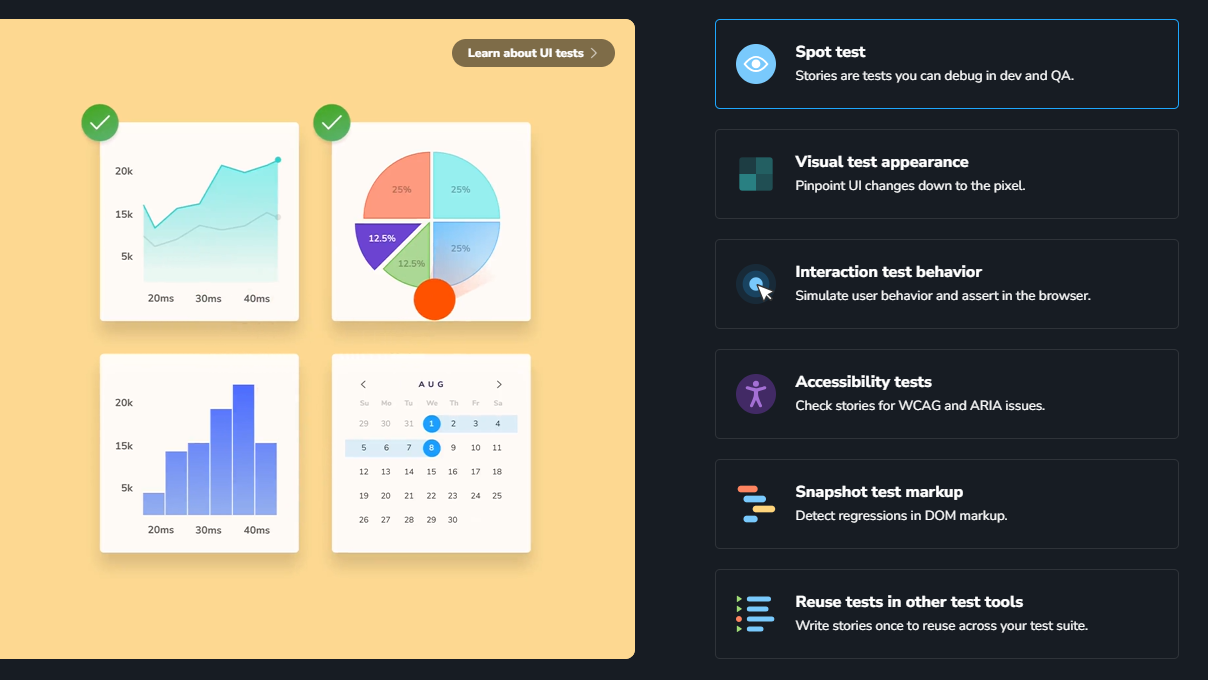 Storybook 是一個用於獨立建立 UI 元件和頁面的前端工作坊。它有助於 UI 開發、測試和文件編制。 他們在 GitHub 上有超過 57,000 次提交、81,000 多個 star 和 1300 多個版本。 這是您為專案建立簡單元件的方法。 ``` import type { Meta, StoryObj } from '@storybook/react'; import { YourComponent } from './YourComponent'; //👇 This default export determines where your story goes in the story list const meta: Meta<typeof YourComponent> = { component: YourComponent, }; export default meta; type Story = StoryObj<typeof YourComponent>; export const FirstStory: Story = { args: { //👇 The args you need here will depend on your component }, }; ``` 您可以閱讀[文件](https://storybook.js.org/docs/get-started/setup)。 如今,UI 除錯起來很痛苦,因為它們與業務邏輯、互動狀態和應用程式上下文糾纏在一起。 Storybook 提供了一個獨立的 iframe 來渲染元件,而不會受到應用程式業務邏輯和上下文的干擾。這可以幫助您將開發重點放在元件的每個變體上,甚至是難以觸及的邊緣情況。 https://github.com/storybookjs/storybook --- 3. [Appwrite](https://github.com/appwrite/appwrite) - 您的後端減少麻煩。 ---------------------------------------------------------------   Appwrite 的開源平台可讓您將身份驗證、資料庫、函數和儲存體新增至您的產品中,並建立任何規模的任何應用程式、擁有您的資料並使用您喜歡的編碼語言和工具。 他們有很好的貢獻指南,甚至不厭其煩地詳細解釋架構。 開始使用以下 npm 指令。 ``` npm install appwrite ``` 您可以像這樣建立一個登入元件。 ``` "use client"; import { useState } from "react"; import { account, ID } from "./appwrite"; const LoginPage = () => { const [loggedInUser, setLoggedInUser] = useState(null); const [email, setEmail] = useState(""); const [password, setPassword] = useState(""); const [name, setName] = useState(""); const login = async (email, password) => { const session = await account.createEmailSession(email, password); setLoggedInUser(await account.get()); }; const register = async () => { await account.create(ID.unique(), email, password, name); login(email, password); }; const logout = async () => { await account.deleteSession("current"); setLoggedInUser(null); }; if (loggedInUser) { return ( <div> <p>Logged in as {loggedInUser.name}</p> <button type="button" onClick={logout}> Logout </button> </div> ); } return ( <div> <p>Not logged in</p> <form> <input type="email" placeholder="Email" value={email} onChange={(e) => setEmail(e.target.value)} /> <input type="password" placeholder="Password" value={password} onChange={(e) => setPassword(e.target.value)} /> <input type="text" placeholder="Name" value={name} onChange={(e) => setName(e.target.value)} /> <button type="button" onClick={() => login(email, password)}> Login </button> <button type="button" onClick={register}> Register </button> </form> </div> ); }; export default LoginPage; ``` 您可以閱讀[文件](https://appwrite.io/docs)。 Appwrite 可以非常輕鬆地建立具有開箱即用的擴充功能的可擴展後端應用程式。 https://github.com/appwrite/appwrite --- 4. [Wasp](https://github.com/wasp-lang/wasp) - 用於 React、node.js 和 prisma 的類似 Rails 的框架。 --------------------------------------------------------------------------------------- 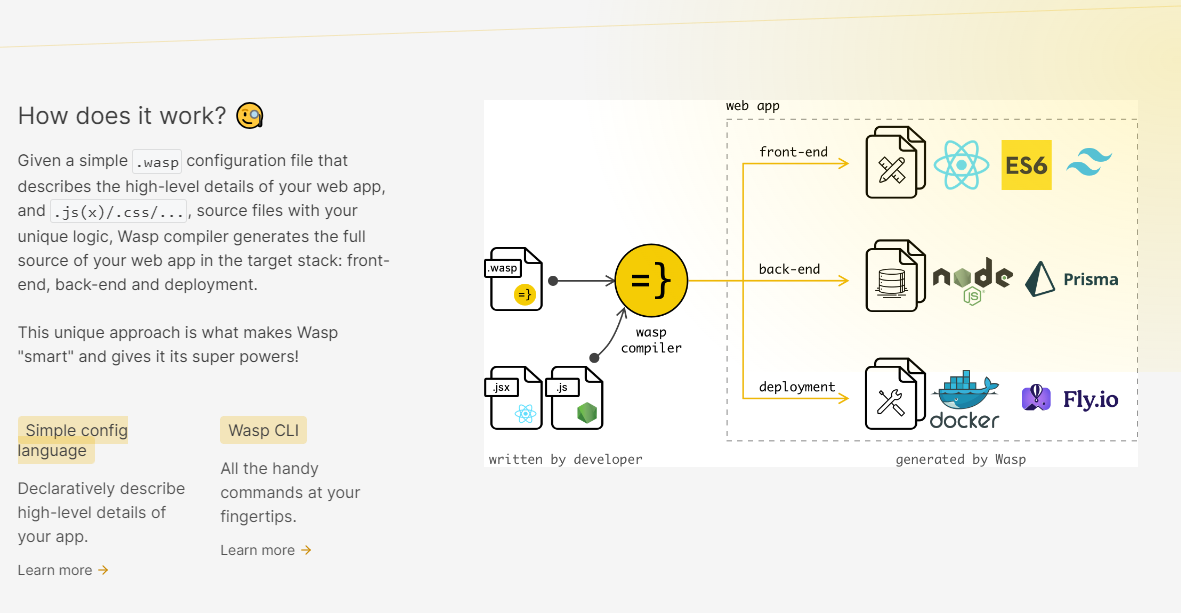 使用 React 和 Node.js 開發全端 Web 應用程式的最快方法。這不是一個想法,而是一種建立瘋狂快速全端應用程式的不同方法。 這是將其整合到元件中的方法。 ``` import getRecipes from "@wasp/queries/getRecipes"; import { useQuery } from "@wasp/queries"; import type { User } from "@wasp/entities"; export function HomePage({ user }: { user: User }) { // Due to full-stack type safety, `recipes` will be of type `Recipe[]` here. const { data: recipes, isLoading } = useQuery(getRecipes); // Calling our query here! if (isLoading) { return <div>Loading...</div>; } return ( <div> <h1>Recipes</h1> <ul> {recipes ? recipes.map((recipe) => ( <li key={recipe.id}> <div>{recipe.title}</div> <div>{recipe.description}</div> </li> )) : 'No recipes defined yet!'} </ul> </div> ); } ``` 您可以閱讀[文件](https://wasp-lang.dev/docs)。 https://github.com/wasp-lang/wasp --- 5. [Novu](https://github.com/novuhq/novu) - 將應用程式內通知新增至您的應用程式! --------------------------------------------------------------  Novu 提供開源通知基礎架構和功能齊全的嵌入式通知中心。 這就是如何使用`React`建立 novu 元件以用於應用程式內通知。 ``` import { NovuProvider, PopoverNotificationCenter, NotificationBell, } from "@novu/notification-center"; function App() { return ( <> <NovuProvider subscriberId={process.env.REACT_APP_SUB_ID} applicationIdentifier={process.env.REACT_APP_APP_ID} > <PopoverNotificationCenter> {({ unseenCount }) => <NotificationBell unseenCount={unseenCount} />} </PopoverNotificationCenter> </NovuProvider> </> ); } export default App; ``` 您可以閱讀[文件](https://docs.novu.co/getting-started/introduction)。 https://github.com/novuhq/novu --- 6. [Remotion](https://github.com/remotion-dev/remotion) - 使用 React 以程式設計方式製作影片。 -------------------------------------------------------------------------------  使用 React 建立真正的 MP4 影片,使用伺服器端渲染和參數化擴展影片製作。 開始使用以下 npm 指令。 ``` npm init video ``` 它為您提供了一個幀號和一個空白畫布,您可以在其中使用 React 渲染任何您想要的內容。 這是一個範例 React 元件,它將當前幀渲染為文字。 ``` import { AbsoluteFill, useCurrentFrame } from "remotion"; export const MyComposition = () => { const frame = useCurrentFrame(); return ( <AbsoluteFill style={{ justifyContent: "center", alignItems: "center", fontSize: 100, backgroundColor: "white", }} > The current frame is {frame}. </AbsoluteFill> ); }; ``` 您可以閱讀[文件](https://www.remotion.dev/docs/)。 過去兩年,remotion 團隊因製作 GitHub Wrapped 而聞名。 https://github.com/remotion-dev/remotion --- [7.NocoDB](https://github.com/nocodb/nocodb) - Airtable 的替代品。 ------------------------------------------------------------- 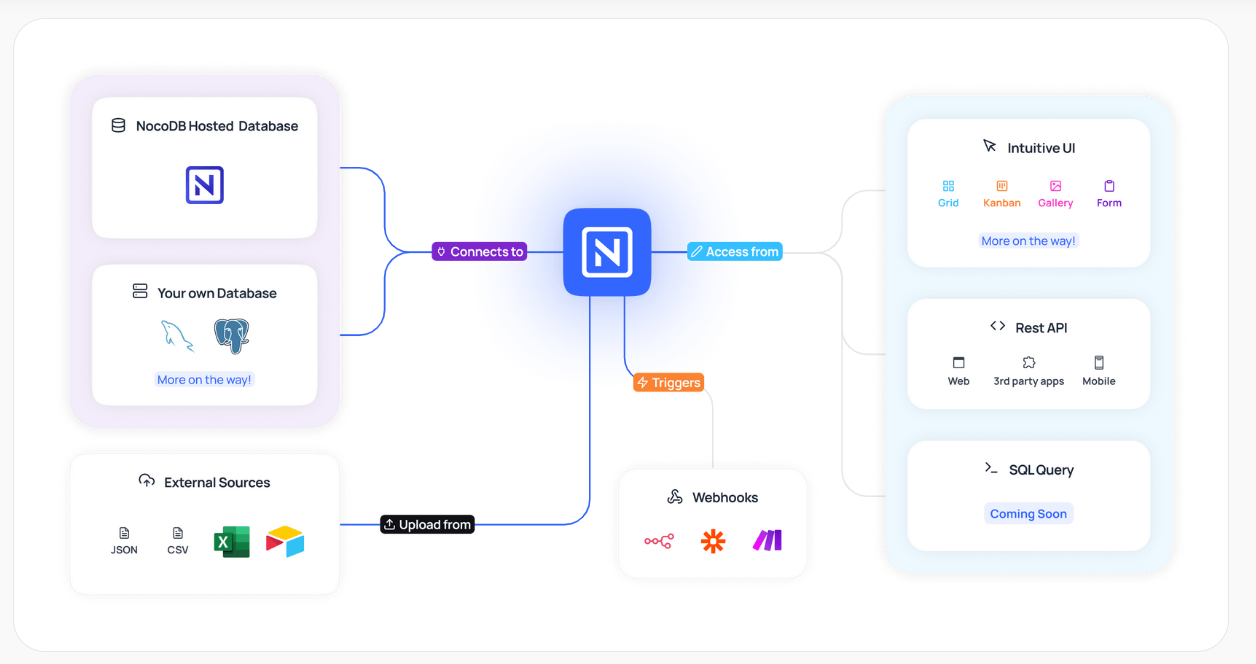 Airtable 的免費開源替代品是 NocoDB。它可以使用任何 MySQL、PostgreSQL、SQL Server、SQLite 或 MariaDB 資料庫製作智慧型電子表格。 其主要目標是讓強大的計算工具得到更廣泛的使用。 開始使用以下 npx 指令。 ``` npx create-nocodb-app ``` 您可以閱讀[文件](https://docs.nocodb.com/)。 NocoDB 的建立是為了為世界各地的數位企業提供強大的開源和無程式碼資料庫介面。 您可以非常快速地將airtable資料匯入NocoDB。 https://github.com/nocodb/nocodb --- 8.[新穎](https://github.com/steven-tey/novel)- 所見即所得編輯器,具有人工智慧自動完成功能。 ------------------------------------------------------------------- 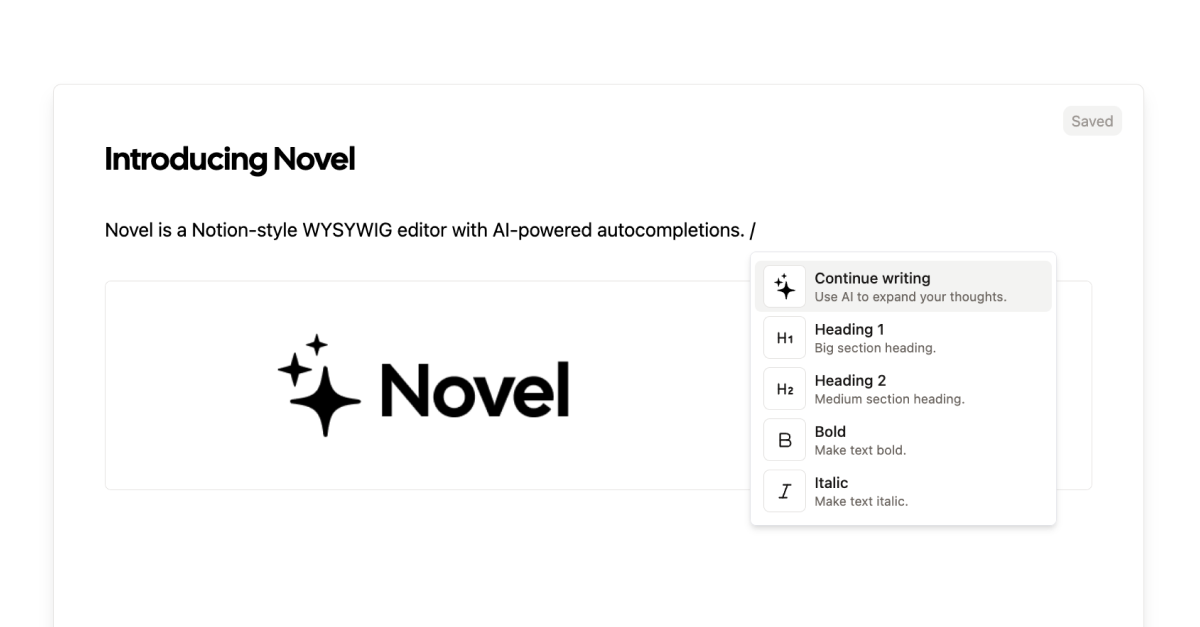 它使用`Next.js` 、 `Vercel AI SDK` 、 `Tiptap`作為文字編輯器。 開始使用以下 npm 指令。 ``` npm i novel ``` 您可以這樣使用它。有多種選項可用於改進您的應用程式。 ``` import { Editor } from "novel"; export default function App() { return <Editor />; } ``` https://github.com/steven-tey/novel --- 9. [Blitz](https://github.com/blitz-js/blitz) - 缺少 NextJS 的全端工具包。 -----------------------------------------------------------------  Blitz 繼承了 Next.js 的不足,為全球應用程式的交付和擴展提供了經過實戰考驗的函式庫和約定。 開始使用以下 npm 指令。 ``` npm install -g blitz ``` 這就是您如何使用 Blitz 建立新頁面。 ``` const NewProjectPage: BlitzPage = () => { const router = useRouter() const [createProjectMutation] = useMutation(createProject) return ( <div> <h1>Create New Project</h1> <ProjectForm submitText="Create Project" schema={CreateProject} onSubmit={async (values) => { // This is equivalent to calling the server function directly const project = await createProjectMutation(values) // Notice the 'Routes' object Blitz provides for routing router.push(Routes.ProjectsPage({ projectId: project.id })) }} /> </div> ); }; NewProjectPage.authenticate = true NewProjectPage.getLayout = (page) => <Layout>{page}</Layout> export default NewProjectPage ``` 您可以閱讀[文件](https://blitzjs.com/docs/get-started)。 它使建築物改善了數倍。  https://github.com/blitz-js/blitz --- 10. [Supabase](https://github.com/supabase/supabase) - 開源 Firebase 替代品。 -----------------------------------------------------------------------  我們大多數人都已經預料到 SUPABASE 會出現在這裡,因為它實在是太棒了。 開始使用以下 npm 指令 (Next.js)。 ``` npx create-next-app -e with-supabase ``` 這是使用 supabase 建立用戶的方法。 ``` import { createClient } from '@supabase/supabase-js' // Initialize const supabaseUrl = 'https://chat-room.supabase.co' const supabaseKey = 'public-anon-key' const supabase = createClient(supabaseUrl, supabaseKey) // Create a new user const { user, error } = await supabase.auth.signUp({ email: '[email protected]', password: 'example-password', }) ``` 您可以閱讀[文件](https://supabase.com/docs)。 您可以使用身份驗證、即時、邊緣功能、儲存等功能建立一個速度極快的應用程式。 Supabase 涵蓋了這一切! 他們還提供了一些入門套件,例如 AI 聊天機器人和 Stripe 訂閱。 https://github.com/supabase/supabase --- [11.Refine](https://github.com/refinedev/refine) - 企業開源重組工具。 ------------------------------------------------------------ 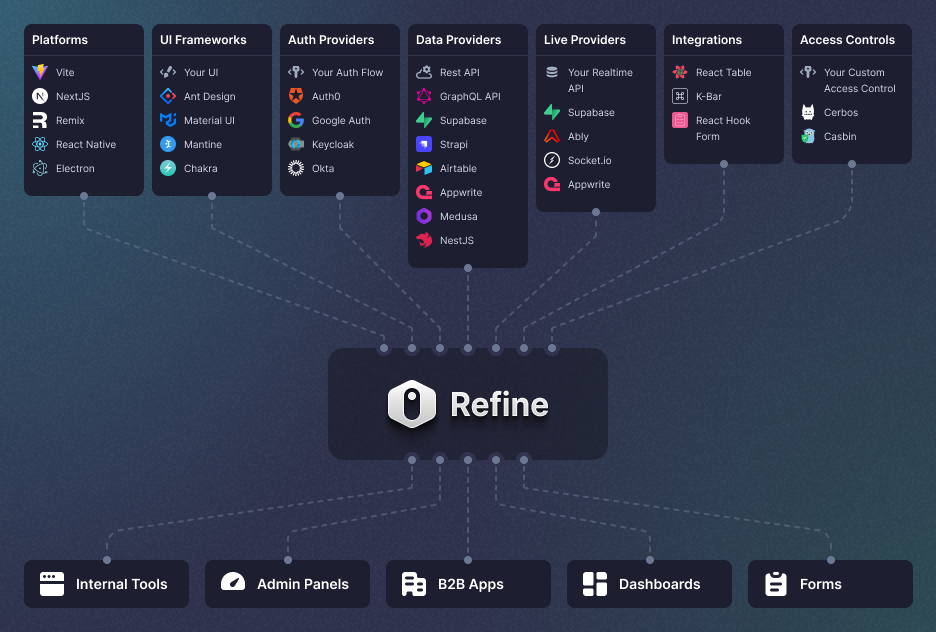 建立具有無與倫比的靈活性的管理面板、儀表板和 B2B 應用程式 您可以在一分鐘內使用單一 CLI 命令進行設定。 它具有適用於 15 多個後端服務的連接器,包括 Hasura、Appwrite 等。 開始使用以下 npm 指令。 ``` npm create refine-app@latest ``` 這就是使用 Refine 新增登入資訊的簡單方法。 ``` import { useLogin } from "@refinedev/core"; const { login } = useLogin(); ``` 您可以閱讀[文件](https://refine.dev/docs/)。 https://github.com/refinedev/refine --- 12. [Zenstack](https://github.com/zenstackhq/zenstack) - 資料庫到 API 和 UI 只需幾分鐘。 -----------------------------------------------------------------------------  TypeScript 工具包,透過強大的存取控制層增強 Prisma ORM,並釋放其全端開發的全部功能。 開始使用以下 npx 指令。 ``` npx zenstack@latest init ``` 這是透過伺服器適配器建立 RESTful API 的方法。 ``` // pages/api/model/[...path].ts import { requestHandler } from '@zenstackhq/next'; import { enhance } from '@zenstackhq/runtime'; import { getSessionUser } from '@lib/auth'; import { prisma } from '@lib/db'; // Mount Prisma-style APIs: "/api/model/post/findMany", "/api/model/post/create", etc. // Can be configured to provide standard RESTful APIs (using JSON:API) instead. export default requestHandler({ getPrisma: (req, res) => enhance(prisma, { user: getSessionUser(req, res) }), }); ``` 您可以閱讀[文件](https://zenstack.dev/docs/welcome)。 https://github.com/zenstackhq/zenstack --- 13. [Buildship](https://github.com/rowyio/buildship) - 低程式碼視覺化後端建構器。 --------------------------------------------------------------------  對於您正在使用無程式碼應用程式建構器(FlutterFlow、Webflow、Framer、Adalo、Bubble、BravoStudio...)或前端框架(Next.js、React、Vue...)建立的應用程式,您需要一個後端來支援可擴展的 API、安全工作流程、自動化等。BuildShip 為您提供了一種完全視覺化的方式,可以在易於使用的完全託管體驗中可擴展地建立這些後端任務。 這意味著您不需要在雲端平台上爭論或部署東西、執行 DevOps 等。只需立即建置和交付 🚀 https://github.com/rowyio/buildship --- 14. [Taipy](https://github.com/Avaiga/taipy) - 將資料和人工智慧演算法整合到生產就緒的 Web 應用程式中。 -----------------------------------------------------------------------------  Taipy 是一個開源 Python 庫,用於輕鬆的端到端應用程式開發, 具有假設分析、智慧管道執行、內建調度和部署工具。 開始使用以下命令。 ``` pip install taipy ``` 這是一個典型的Python函數,也是過濾器場景中使用的唯一任務。 ``` def filter_genre(initial_dataset: pd.DataFrame, selected_genre): filtered_dataset = initial_dataset[initial_dataset['genres'].str.contains(selected_genre)] filtered_data = filtered_dataset.nlargest(7, 'Popularity %') return filtered_data ``` 您可以閱讀[文件](https://docs.taipy.io/en/latest/)。 他們還有很多可供您建立的[演示應用程式教學](https://docs.taipy.io/en/latest/knowledge_base/demos/)。 https://github.com/Avaiga/taipy --- 15. [LocalForage](https://github.com/localForage/localForage) - 改進了離線儲存。 ------------------------------------------------------------------------  LocalForage 是一個 JavaScript 函式庫,它透過使用非同步資料儲存和簡單的、類似 localStorage 的 API 來改善 Web 應用程式的離線體驗。它允許開發人員儲存多種類型的資料而不僅僅是字串。 開始使用以下 npm 指令。 ``` npm install localforage ``` 只需包含 JS 檔案並開始使用 localForage。 ``` <script src="localforage.js"></script> ``` 您可以閱讀[文件](https://localforage.github.io/localForage/#installation)。 https://github.com/localForage/localForage --- 16. [Zod](https://github.com/colinhacks/zod) - 使用靜態類型推斷的 TypeScript-first 模式驗證。 -------------------------------------------------------------------------------  Zod 的目標是透過最大限度地減少重複的類型聲明來對開發人員友好。使用 Zod,您聲明一次驗證器,Zod 將自動推斷靜態 TypeScript 類型。將更簡單的類型組合成複雜的資料結構很容易。 開始使用以下 npm 指令。 ``` npm install zod ``` 這是您在建立字串架構時自訂一些常見錯誤訊息的方法。 ``` const name = z.string({ required_error: "Name is required", invalid_type_error: "Name must be a string", }); ``` 您可以閱讀[文件](https://zod.dev/)。 它適用於 Node.js 和所有現代瀏覽器 https://github.com/colinhacks/zod --- 17.[多普勒](https://github.com/DopplerHQ)- 管理你的秘密。 -----------------------------------------------  您可以透過在具有開發、暫存和生產環境的專案中組織機密來消除機密蔓延。 開始使用以下指令 (MacOS)。 ``` $ brew install dopplerhq/cli/doppler $ doppler --version ``` 這是安裝 Doppler CLI[的 GitHub Actions 工作流程](https://github.com/DopplerHQ/cli-action)。 您可以閱讀[文件](https://docs.doppler.com/docs/start)。 ``` name: Example action on: [push] jobs: my-job: runs-on: ubuntu-latest steps: - name: Install CLI uses: dopplerhq/cli-action@v3 - name: Do something with the CLI run: doppler secrets --only-names env: DOPPLER_TOKEN: ${{ secrets.DOPPLER_TOKEN }} ``` https://github.com/DopplerHQ --- 18. [FastAPI](https://github.com/tiangolo/fastapi) - 高效能、易於學習、快速編碼、可用於生產。 -------------------------------------------------------------------------  FastAPI 是一個現代、快速(高效能)的 Web 框架,用於基於標準 Python 類型提示使用 Python 3.8+ 建立 API。 開始使用以下命令。 ``` $ pip install fastapi ``` 這是您開始使用 FastAPI 的方式。 ``` from typing import Union from fastapi import FastAPI app = FastAPI() @app.get("/") def read_root(): return {"Hello": "World"} @app.get("/items/{item_id}") def read_item(item_id: int, q: Union[str, None] = None): return {"item_id": item_id, "q": q} ``` 您的編輯器將自動完成屬性並了解它們的類型,這是使用 FastAPI 的最佳功能之一。 您可以閱讀[文件](https://fastapi.tiangolo.com/)。 https://github.com/tiangolo/fastapi --- 19. [Flowise](https://github.com/FlowiseAI/Flowise) - 拖放 UI 來建立您的客製化 LLM 流程。 ----------------------------------------------------------------------------  Flowise 是一款開源 UI 視覺化工具,用於建立客製化的 LLM 編排流程和 AI 代理程式。 開始使用以下 npm 指令。 ``` npm install -g flowise npx flowise start OR npx flowise start --FLOWISE_USERNAME=user --FLOWISE_PASSWORD=1234 ``` 這就是整合 API 的方式。 ``` import requests url = "/api/v1/prediction/:id" def query(payload): response = requests.post( url, json = payload ) return response.json() output = query({ question: "hello!" )} ``` 您可以閱讀[文件](https://docs.flowiseai.com/)。 https://github.com/FlowiseAI/Flowise --- 20. [Scrapy](https://github.com/scrapy/scrapy) - Python 的快速進階網頁爬行和抓取框架.. ------------------------------------------------------------------------  Scrapy 是一個快速的高級網路爬行和網頁抓取框架,用於爬行網站並從頁面中提取結構化資料。它可用於多種用途,從資料探勘到監控和自動化測試。 開始使用以下命令。 ``` pip install scrapy ``` 建造並執行您的網路蜘蛛。 ``` pip install scrapy cat > myspider.py <<EOF import scrapy class BlogSpider(scrapy.Spider): name = 'blogspider' start_urls = ['https://www.zyte.com/blog/'] def parse(self, response): for title in response.css('.oxy-post-title'): yield {'title': title.css('::text').get()} for next_page in response.css('a.next'): yield response.follow(next_page, self.parse) EOF scrapy runspider myspider.py ``` 您可以閱讀[文件](https://scrapy.org/doc/)。 它擁有大約 50k+ 的星星,因此對於網頁抓取來說具有巨大的可信度。 https://github.com/scrapy/scrapy --- 21. [Tone](https://github.com/Tonejs/Tone.js) - 在瀏覽器中製作互動式音樂。 -------------------------------------------------------------  開始使用以下 npm 指令。 ``` npm install tone ``` 這是您開始使用 Tone.js 的方法 ``` // To import Tone.js: import * as Tone from 'tone' //create a synth and connect it to the main output (your speakers) const synth = new Tone.Synth().toDestination(); //play a middle 'C' for the duration of an 8th note synth.triggerAttackRelease("C4", "8n"); ``` 您可以閱讀[文件](https://github.com/Tonejs/Tone.js?tab=readme-ov-file#installation)。 https://github.com/Tonejs/Tone.js --- 22. [Spacetime](https://github.com/spencermountain/spacetime) - 輕量級 javascript 時區庫。 -----------------------------------------------------------------------------------  您可以計算遠端時區的時間;支持夏令時、閏年和半球。按季度、季節、月份、週來定位時間.. 開始使用以下 npm 指令。 ``` npm install spacetime ``` 您可以這樣使用它。 ``` <script src="https://unpkg.com/spacetime"></script> <script> var d = spacetime('March 1 2012', 'America/New_York') //set the time d = d.time('4:20pm') d = d.goto('America/Los_Angeles') d.time() //'1:20pm' </script> ``` https://github.com/spencermountain/spacetime --- 23. [Mermaid](https://github.com/mermaid-js/mermaid) - 從類似 markdown 的文字產生圖表。 ----------------------------------------------------------------------------  您可以使用 Markdown with Mermaid 等文字產生流程圖或序列圖等圖表。 這就是建立圖表的方法。 ``` sequenceDiagram Alice->>John: Hello John, how are you? loop Healthcheck John->>John: Fight against hypochondria end Note right of John: Rational thoughts! John-->>Alice: Great! John->>Bob: How about you? Bob-->>John: Jolly good! ``` 它將做出如下圖。 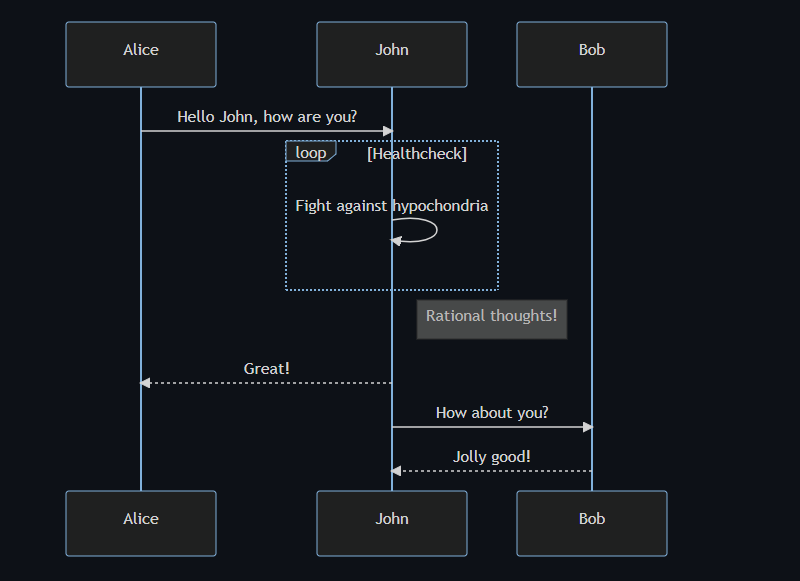 您可以閱讀[VS Code](https://docs.mermaidchart.com/plugins/visual-studio-code)的[文件](https://mermaid.js.org/intro/getting-started.html)和外掛程式。 請參閱[即時編輯器](https://mermaid.live/edit#pako:eNpVkE1PwzAMhv9KlvM-2AZj62EIxJd24ADXXLzEbaKlcUkdUDX1v5MONomcnNevXz32UWoyKAvZ4mfCoPHRQRWhVuHeO42T7XZHNhTiFb0nMdRjYelbQETRUbpTwRM1uQ2erbaoDyqI_AbnZfjZVZYFVOBCy8J2DWlLwUQHKmAwKrwRo4gnF5Xid-gd2FEAL9hSyp12pMIpNcee2ArxEhH4LG-3D7TPoAPcnhL_4WVxcgHZkfedqIjMSI5ljbEGZ_LyxwFaSbZYo5JFLg3Eg5Iq9NkHiemjC1oWHBOOZWoM8PlQ_8Un45iiLErwbRY9gcH8PUrumuHKlWs5J2oKpasGPUWfZcvctMVsNrSnlWOb9lNN9ax1xkJk-7VZzVaL1RoWS1zdLuFmuTR6P9-sy8X1vDS3V_MFyL7vfwD_bJ1W)中的範例。 https://github.com/mermaid-js/mermaid --- 24.[公共 API](https://github.com/public-apis/public-apis) - 20 多個類別的 1400 多個 API。 -------------------------------------------------------------------------------  我們主要使用外部 API 來建立應用程式,在這裡您可以找到所有 API 的清單。網站連結在最後。 它在 GitHub 上擁有大約 279k+ 顆星。  從儲存庫取得網站連結非常困難。所以,我把它貼在這裡。 網址 - [Collective-api.vercel.app/](https://collective-api.vercel.app/) https://github.com/public-apis/public-apis --- 25. [Framer Motion](https://github.com/framer/motion) - 像魔法一樣的動畫。 -----------------------------------------------------------------  可用的最強大的動畫庫之一。 Framer 使用簡單的聲明性語法意味著您編寫的程式碼更少。更少的程式碼意味著您的程式碼庫更易於閱讀和維護。 您可以建立事件和手勢,並且使用 Framer 的社區很大,這意味著良好的支援。 開始使用以下 npm 指令。 ``` npm install framer-motion ``` 您可以這樣使用它。 ``` import { motion } from "framer-motion" <motion.div whileHover={{ scale: 1.2 }} whileTap={{ scale: 1.1 }} drag="x" dragConstraints={{ left: -100, right: 100 }} /> ``` 您可以閱讀[文件](https://www.framer.com/motion/introduction/)。 https://github.com/framer/motion --- 26.[順便說一句](https://github.com/btw-so/btw)- 在幾分鐘內建立您的個人部落格。 ----------------------------------------------------------  順便說一句,您可以註冊並使用,而無需安裝任何東西。您也可以使用開源版本自行託管。  使用順便說一句建立的[範例部落格](https://www.siddg.com/about)。 https://github.com/btw-so/btw --- 27. [Formbricks](https://github.com/formbricks/formbricks) - 開源調查平台。 --------------------------------------------------------------------  Formbricks 提供免費、開源的測量平台。透過精美的應用程式內、網站、連結和電子郵件調查收集用戶旅程中每個點的回饋。在 Formbricks 之上建置或利用預先建置的資料分析功能。 開始使用以下 npm 指令。 ``` npm install @formbricks/js ``` 這就是您開始使用 formbricks 的方法。 ``` import formbricks from "@formbricks/js"; if (typeof window !== "undefined") { formbricks.init({ environmentId: "claV2as2kKAqF28fJ8", apiHost: "https://app.formbricks.com", }); } ``` 您可以閱讀[文件](https://formbricks.com/docs/getting-started/quickstart-in-app-survey)。 https://github.com/formbricks/formbricks --- 28. [Stripe](https://github.com/stripe) - 支付基礎設施。 -------------------------------------------------  數以百萬計的各種規模的公司在線上和親自使用 Stripe 來接受付款、發送付款、自動化財務流程並最終增加收入。 開始使用以下 npm 指令 (React.js)。 ``` npm install @stripe/react-stripe-js @stripe/stripe-js ``` 這就是使用鉤子的方法。 ``` import React, {useState} from 'react'; import ReactDOM from 'react-dom'; import {loadStripe} from '@stripe/stripe-js'; import { PaymentElement, Elements, useStripe, useElements, } from '@stripe/react-stripe-js'; const CheckoutForm = () => { const stripe = useStripe(); const elements = useElements(); const [errorMessage, setErrorMessage] = useState(null); const handleSubmit = async (event) => { event.preventDefault(); if (elements == null) { return; } // Trigger form validation and wallet collection const {error: submitError} = await elements.submit(); if (submitError) { // Show error to your customer setErrorMessage(submitError.message); return; } // Create the PaymentIntent and obtain clientSecret from your server endpoint const res = await fetch('/create-intent', { method: 'POST', }); const {client_secret: clientSecret} = await res.json(); const {error} = await stripe.confirmPayment({ //`Elements` instance that was used to create the Payment Element elements, clientSecret, confirmParams: { return_url: 'https://example.com/order/123/complete', }, }); if (error) { // This point will only be reached if there is an immediate error when // confirming the payment. Show error to your customer (for example, payment // details incomplete) setErrorMessage(error.message); } else { // Your customer will be redirected to your `return_url`. For some payment // methods like iDEAL, your customer will be redirected to an intermediate // site first to authorize the payment, then redirected to the `return_url`. } }; return ( <form onSubmit={handleSubmit}> <PaymentElement /> <button type="submit" disabled={!stripe || !elements}> Pay </button> {/* Show error message to your customers */} {errorMessage && <div>{errorMessage}</div>} </form> ); }; const stripePromise = loadStripe('pk_test_6pRNASCoBOKtIshFeQd4XMUh'); const options = { mode: 'payment', amount: 1099, currency: 'usd', // Fully customizable with appearance API. appearance: { /*...*/ }, }; const App = () => ( <Elements stripe={stripePromise} options={options}> <CheckoutForm /> </Elements> ); ReactDOM.render(<App />, document.body); ``` 您可以閱讀[文件](https://github.com/stripe/react-stripe-js?tab=readme-ov-file#minimal-example)。 您幾乎可以整合任何東西。它有一個巨大的選項清單。  https://github.com/stripe --- 29. [Upscayl](https://github.com/upscayl/upscayl) - 開源 AI 影像升級器。 ----------------------------------------------------------------  適用於 Linux、MacOS 和 Windows 的免費開源 AI Image Upscaler 採用 Linux 優先概念建構。 它可能與全端無關,但它對於升級圖像很有用。  透過最先進的人工智慧,Upscayl 可以幫助您將低解析度影像變成高解析度。清脆又鋒利! https://github.com/upscayl/upscayl --- 30.[重新發送](https://github.com/resend)- 為開發人員提供的電子郵件 API。 -------------------------------------------------------  您可以使用 React 建立和傳送電子郵件。 2023 年最受炒作的產品之一。 開始使用以下 npm 指令。 ``` npm install @react-email/components -E ``` 這是將其與 next.js 專案整合的方法。 ``` import { EmailTemplate } from '@/components/email-template'; import { Resend } from 'resend'; const resend = new Resend(process.env.RESEND_API_KEY); export async function POST() { const { data, error } = await resend.emails.send({ from: '[email protected]', to: '[email protected]', subject: 'Hello world', react: EmailTemplate({ firstName: 'John' }), }); if (error) { return Response.json({ error }); } return Response.json(data); } ``` 您可以閱讀[文件](https://resend.com/docs/introduction)。 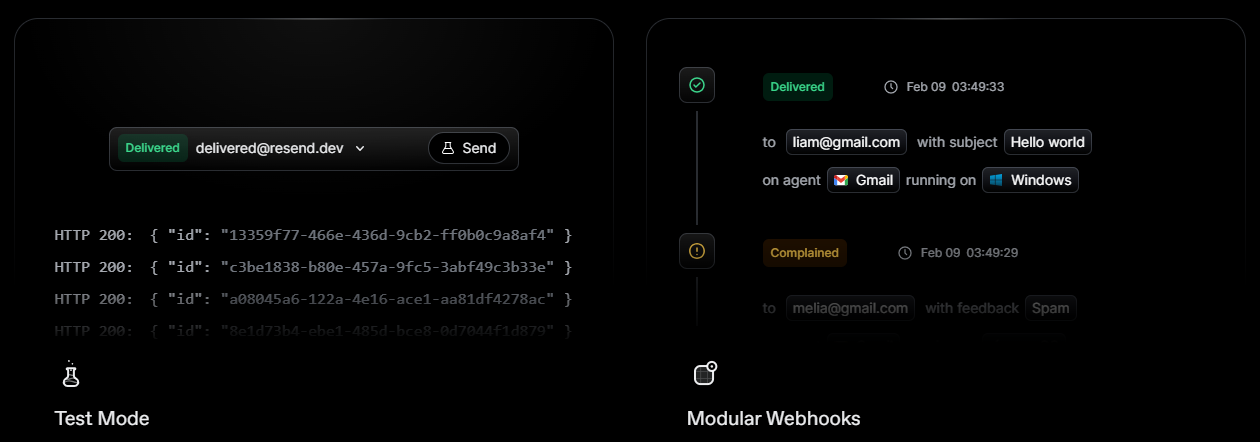 基本概念是一個簡單、優雅的介面,讓您可以在幾分鐘內開始發送電子郵件。它可以透過適用於您最喜歡的程式語言的 SDK 直接融入您的程式碼中。 https://github.com/resend --- 哇!如此長的專案清單。 我知道您有更多想法,分享它們,讓我們一起建造:D 如今建立全端應用程式並不難,但每個應用程式都可以透過有效地使用優秀的開源專案來解決任何問題來增加這一獨特因素。 例如,您可以建立一些提供通知或建立 UI 流來抓取資料的東西。 我希望其中一些內容對您的開發之旅有用。他們擁有一流的開發人員經驗;你可以依賴他們。 由於您將要建造東西,因此您可以在這裡找到一些[瘋狂的想法](https://github.com/florinpop17/app-ideas)。 祝你有美好的一天!直到下一次。 --- 原文出處:https://dev.to/copilotkit/im-building-a-full-stack-app-here-are-the-libraries-im-going-to-use-51nk
目錄 == - [介紹](#introduction) - [技術堆疊](#tech-stack) - [特徵](#features) - [設定 Next.js 應用程式](#step-1-setting-up-the-nextjs-application) - [安裝所需的套件](#step-2-installing-required-packages) - [設定 Redis 連接](#step-3-setting-up-redis-connection) - [配置 BullMQ 佇列](#step-4-configuring-bullmq-queue) - [Next.js 儀器設置](#step-5-nextjs-instrumentation-setup) - [設定 Bright Data 的抓取瀏覽器](#step-6-setting-up-bright-datas-scraping-browser) - [Bright Data 的抓取瀏覽器是什麼?](#what-is-bright-datas-scraping-browser) - [設定 Bright Data 抓取瀏覽器的步驟](#steps-to-set-up-bright-datas-scraping-browser) - [使用 Puppeteer 實作抓取邏輯](#implementing-the-scraping-logic-with-puppeteer) - [航班搜尋功能](#flight-search-feature) - [顯示航班搜尋結果](#displaying-flight-search-results) - [探索完整的指南和程式碼庫](#discover-the-complete-guide-and-codebase) - [在 YouTube 上觀看詳細說明](#watch-the-detailed-explanation-on-youtube) - [在 GitHub 上探索完整程式碼](#explore-the-full-code-on-github) - [結論](#conclusion) 介紹 == 在不斷發展的 Web 開發領域,有效收集、處理和顯示外部來源資料的能力變得越來越有價值。無論是市場研究、競爭分析或客戶洞察,網路抓取在釋放網路資料的巨大潛力方面都發揮著至關重要的作用。 這篇部落格文章介紹了建立強大的 Next.js 應用程式的綜合指南,該應用程式旨在從領先的旅行搜尋引擎之一 Kayak 抓取航班資料。透過利用 Next.js 的強大功能以及 BullMQ、Redis 和 Puppeteer 等現代技術。 技術堆疊 ==== - [Next.js](https://nextjs.org/docs) - [順風CSS](https://tailwindcss.com/docs) - [下一個介面](https://nextui.org/docs) - [健康)狀況](https://zustand.surge.sh/) - [條紋](https://stripe.com/docs) - [Bright Data 的抓取瀏覽器](https://brdta.com/kishansheth21) - [打字稿](https://www.typescriptlang.org/docs) - [雷迪斯](https://redis.io/documentation) - [BullMQ](https://docs.bullmq.io/) - [傀儡師](https://pptr.dev/) - [智威湯遜](https://jwt.io/introduction) - [阿克西奧斯](https://axios-http.com/docs/intro) - [PostgreSQL](https://www.postgresql.org/docs) - [棱鏡](https://www.prisma.io/docs) 特徵 == - 🚀 帶有 Tailwind CSS 的 Next.js 14 應用程式目錄 - 體驗由最新 Next.js 14 提供支援的時尚現代的 UI,並使用 Tailwind CSS 進行設計,以實現完美的外觀和感覺。 - 🔗 API 路由和伺服器操作 - 深入研究與 Next.js 14 的 API 路由和伺服器操作的無縫後端集成,確保高效的資料處理和伺服器端邏輯執行。 - 🕷 使用 Puppeteer Redis 和 BullMQ 進行抓取 - 利用 Puppeteer 的強大功能進行進階 Web 抓取,並使用 Redis 和 BullMQ 管理佇列和作業以實現強大的後端操作。 - 🔑 用於身份驗證和授權的 JWT 令牌 - 使用 JWT 令牌保護您的應用程式,為整個平台提供可靠的身份驗證和授權方法。 - 💳 支付網關 Stripe - 整合 Stripe 進行無縫支付處理,為預訂旅行、航班和飯店提供安全、輕鬆的交易。 - ✈️ 使用 Stripe 支付網關預訂旅行、航班和飯店 - 使用我們的 Stripe 支援的支付系統,讓您的旅遊預訂體驗變得輕鬆。 - 📊 從多個網站抓取即時資料 - 從多個來源抓取即時資料,保持領先,讓您的應用程式更新最新資訊。 - 💾 使用 Prisma 將抓取的資料儲存在 PostgreSQL 中 - 利用 PostgreSQL 和 Prisma 高效儲存和管理抓取的資料,確保可靠性和速度。 - 🔄 用於狀態管理的 Zustand - 透過 Zustand 簡化狀態邏輯並增強效能,在您的應用程式中享受流暢且可管理的狀態管理。 - 😈 該應用程式的最佳功能 - 使用 Bright Data 的抓取瀏覽器抓取不可抓取的資料。  Bright Data的抓取瀏覽器為我們提供了自動驗證碼解決功能,可以幫助我們抓取不可抓取的資料。 第 1 步:設定 Next.js 應用程式 --------------------- 1. **建立 Next.js 應用程式**:首先建立一個新的 Next.js 應用程式(如果您還沒有)。您可以透過在終端機中執行以下命令來完成此操作: ``` npx create-next-app@latest booking-app ``` 2. **導航到您的應用程式目錄**:變更為您新建立的應用程式目錄: ``` cd booking-app ``` 步驟2:安裝所需的軟體包 ------------ 您需要安裝多個軟體包,包括 Redis、BullMQ 和 Puppeteer Core。執行以下命令來安裝它們: ``` npm install ioredis bullmq puppeteer-core ``` - `ioredis`是 Node.js 的強大 Redis 用戶端,支援與 Redis 進行通訊。 - `bullmq`以 Redis 作為後端來管理作業和訊息佇列。 - `puppeteer-core`可讓您控制外部瀏覽器以進行抓取。 步驟3:設定Redis連接 ------------- 在適當的目錄(例如`lib/` )中建立一個檔案(例如`redis.js` )來配置 Redis 連線: ``` // lib/redis.js import Redis from 'ioredis'; // Use REDIS_URL from environment or fallback to localhost const REDIS_URL = process.env.REDIS_URL || 'redis://localhost:6379'; const connection = new Redis(REDIS_URL); export { connection }; ``` 步驟4:配置BullMQ佇列 -------------- 透過在 Redis 配置所在的相同目錄中建立另一個檔案(例如, `queue.js` )來設定 BullMQ 佇列: ``` // lib/queue.js import { Queue } from 'bullmq'; import { connection } from './redis'; export const importQueue = new Queue('importQueue', { connection, defaultJobOptions: { attempts: 2, backoff: { type: 'exponential', delay: 5000, }, }, }); ``` 第 5 步:Next.js 儀器設置 ------------------ Next.js 允許偵測,可以在 Next.js 配置中啟用。您還需要建立一個用於作業處理的工作文件。 1.**在 Next.js 中啟用 Instrumentation** :將以下內容新增至`next.config.js`以啟用 Instrumentation: ``` // next.config.js module.exports = { experimental: { instrumentationHook: true, }, }; ``` 2.**建立用於作業處理的 Worker** :在您的應用程式中,建立一個檔案 ( `instrumentation.js` ) 來處理作業處理。該工作人員將使用 Puppeteer 來執行抓取任務: ``` // instrumentation.js export const register = async () => { if (process.env.NEXT_RUNTIME === 'nodejs') { const { Worker } = await import('bullmq'); const puppeteer = await import('puppeteer-core'); const { connection } = await import('./lib/redis'); const { importQueue } = await import('./lib/queue'); new Worker('importQueue', async (job) => { // Job processing logic with Puppeteer goes here }, { connection, concurrency: 10, removeOnComplete: { count: 1000 }, removeOnFail: { count: 5000 }, }); } }; ``` 第 6 步:設定 Bright Data 的抓取瀏覽器 --------------------------- 在設定 Bright 資料抓取瀏覽器之前,我們先來談談什麼是抓取瀏覽器。 ### Bright Data 的抓取瀏覽器是什麼? Bright Data 的抓取瀏覽器是一款用於自動網頁抓取的尖端工具,旨在與 Puppeteer、Playwright 和 Selenium 無縫整合。它提供了一套網站解鎖功能,包括代理輪換、驗證碼解決等,以提高抓取效率。它非常適合需要互動的複雜網頁抓取,透過在 Bright Data 基礎架構上託管無限的瀏覽器會話來實現可擴展性。如欲了解更多詳情,請造訪[光明資料](https://brdta.com/kishansheth21)。 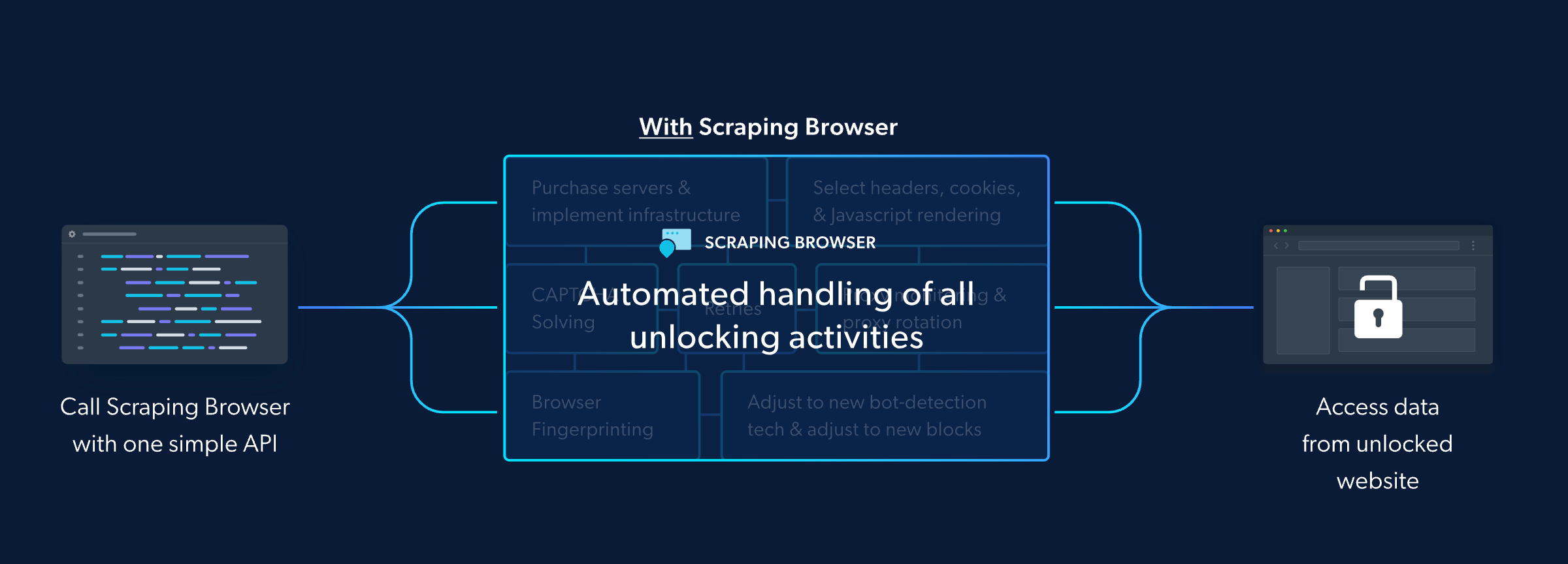 <a id="steps-to-set-up-bright-datas-scraping-browser"></a> #### 第 1 步:導覽至 Bright Data 網站 首先造訪[Brightdata.com](https://brdta.com/kishansheth21) 。這是您存取 Bright Data 提供的豐富網頁抓取資源和工具的入口。  #### 第 2 步:建立帳戶 造訪 Bright Data 網站後,註冊並建立一個新帳戶。系統將提示您輸入基本資訊以啟動並執行您的帳戶。 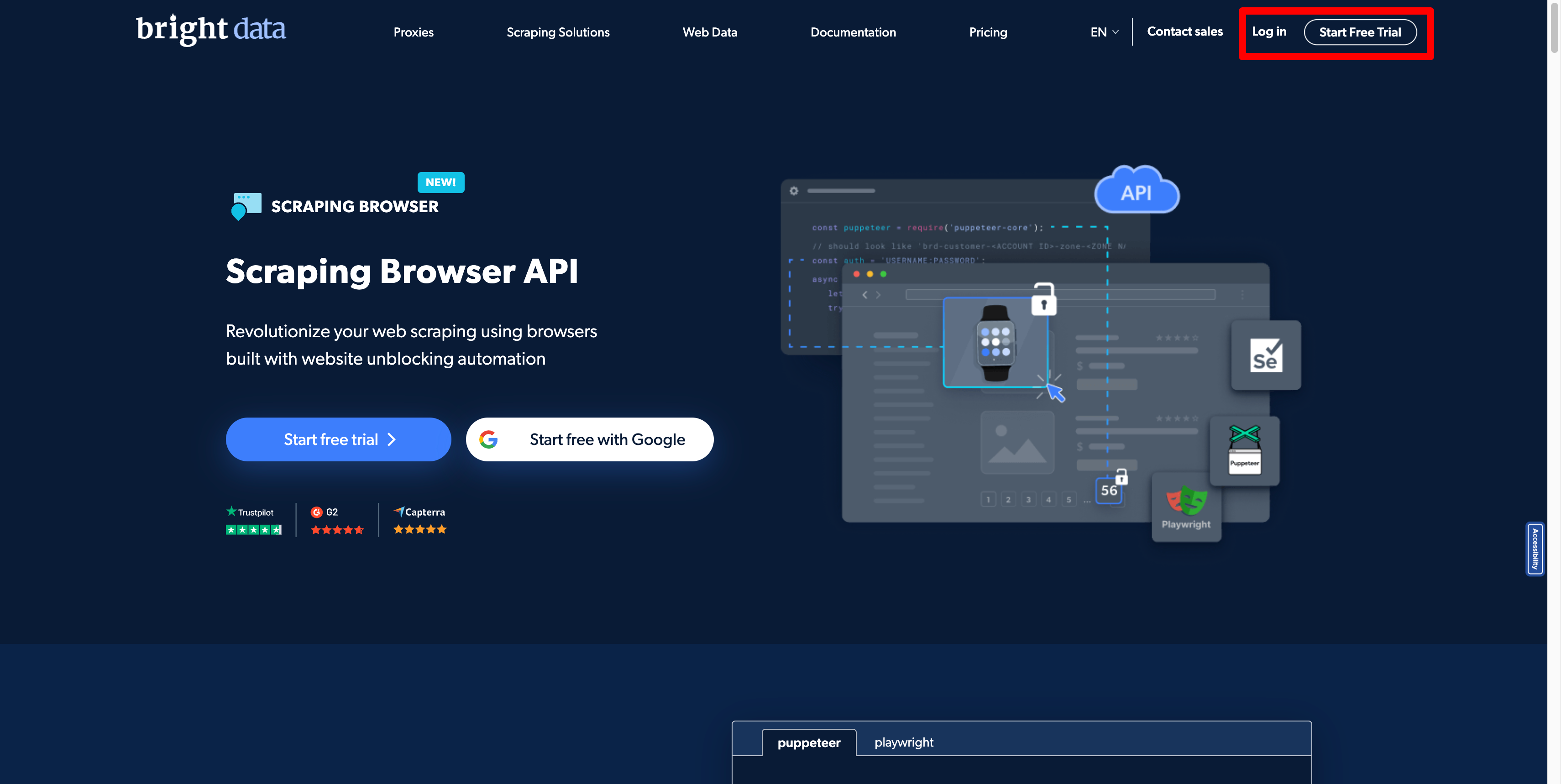 #### 第 3 步:選擇您的產品 在產品選擇頁面上,尋找代理商和抓取基礎設施產品。本產品專為滿足您的網路抓取需求而設計,提供強大的資料擷取工具和功能。  #### 第 4 步:新增代理 在「代理程式和抓取基礎設施」頁面中,您會找到一個「新增按鈕」。點擊此按鈕開始將新的抓取瀏覽器新增到您的工具包的過程。  #### 第五步:選擇抓取瀏覽器 將出現一個下拉列表,您應該從中選擇抓取瀏覽器選項。這告訴 Bright Data 您打算設定一個新的抓取瀏覽器環境。  #### 第 6 步:為您的抓取瀏覽器命名 為您的新抓取瀏覽器指定一個唯一的名稱。這有助於稍後辨識和管理它,特別是如果您計劃對不同的抓取專案使用多個瀏覽器。 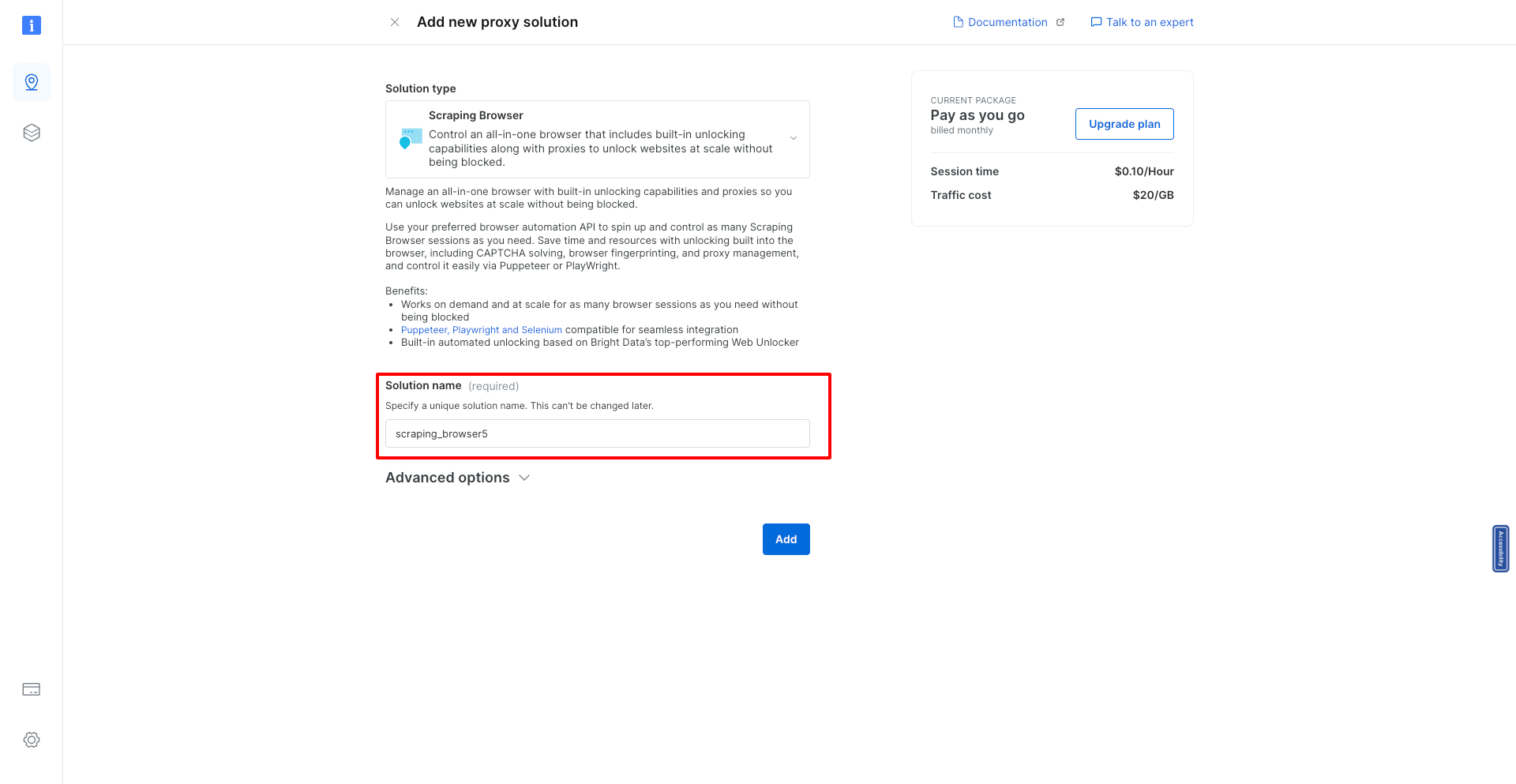 #### 步驟7:新增瀏覽器 命名您的瀏覽器後,按一下「新增」按鈕。此操作完成了新的抓取瀏覽器的建立。 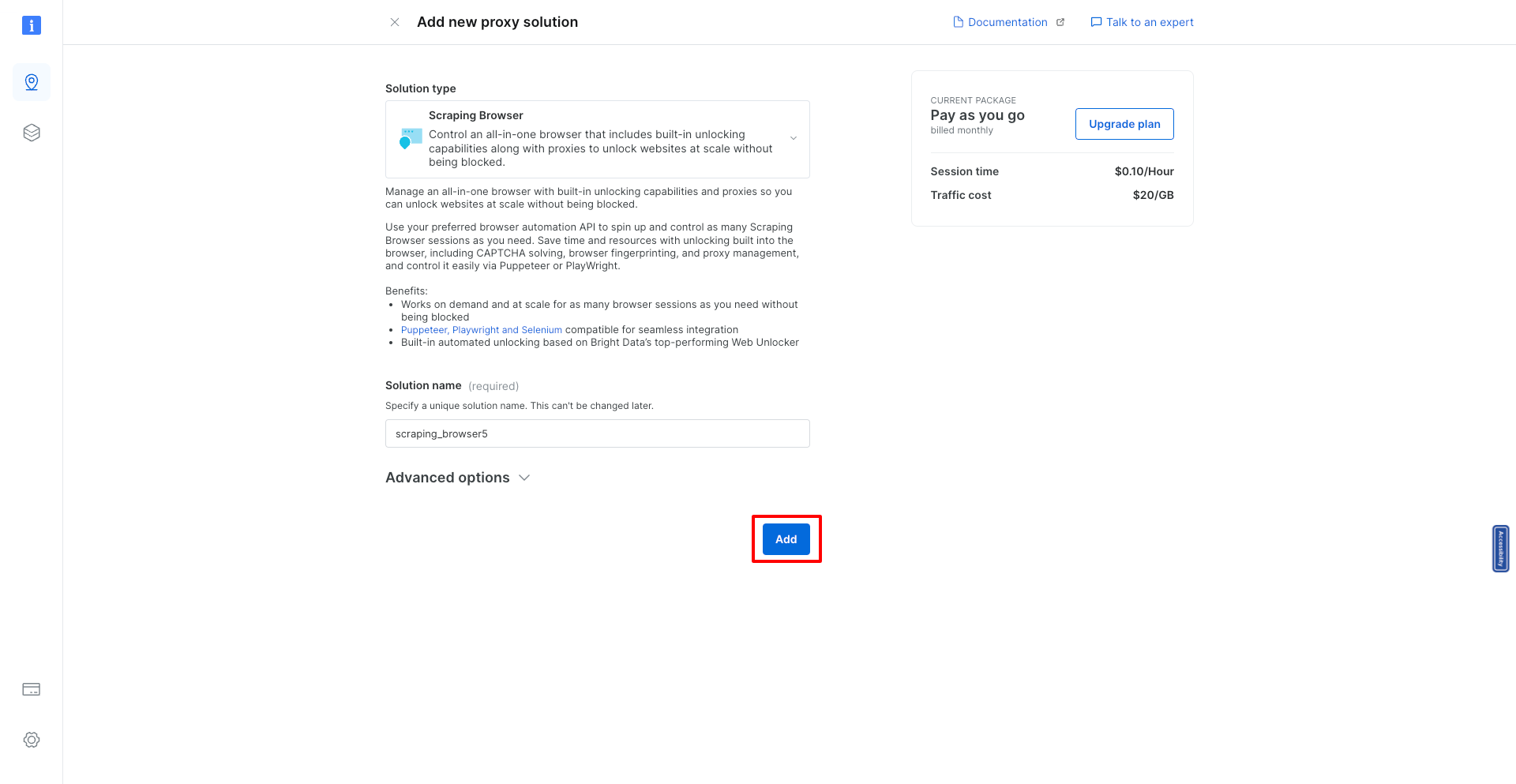 #### 第 8 步:查看您的抓取瀏覽器詳細訊息 新增抓取瀏覽器後,您將被導向到一個頁面,您可以在其中查看新建立的抓取瀏覽器的所有詳細資訊。這些資訊對於整合和使用至關重要。 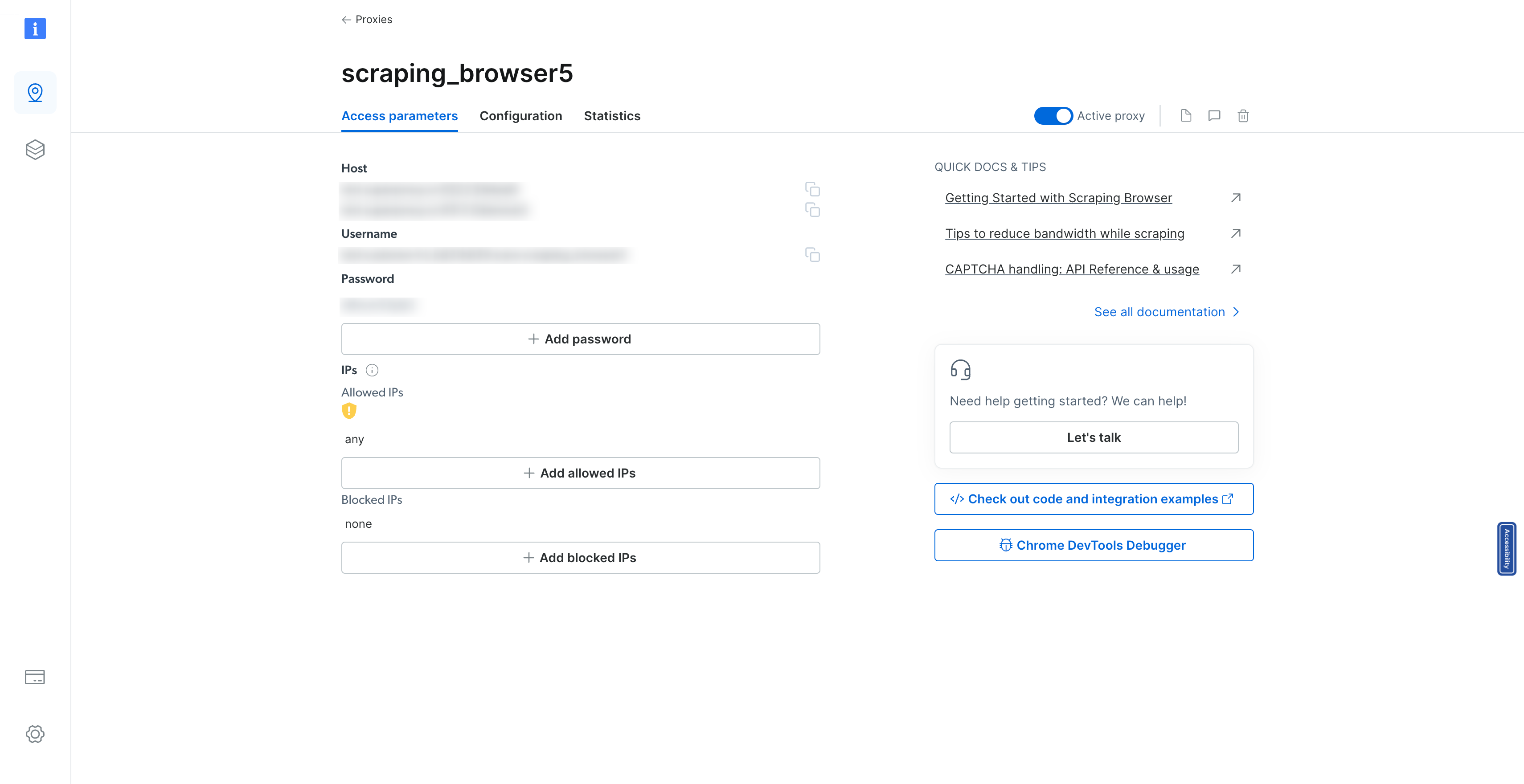 #### 第 9 步:存取程式碼和整合範例 尋找“查看程式碼和整合範例”按鈕。點擊此按鈕將為您提供如何跨多種程式語言和程式庫整合和使用抓取瀏覽器的全面視圖。對於希望自訂抓取設定的開發人員來說,此資源非常寶貴。 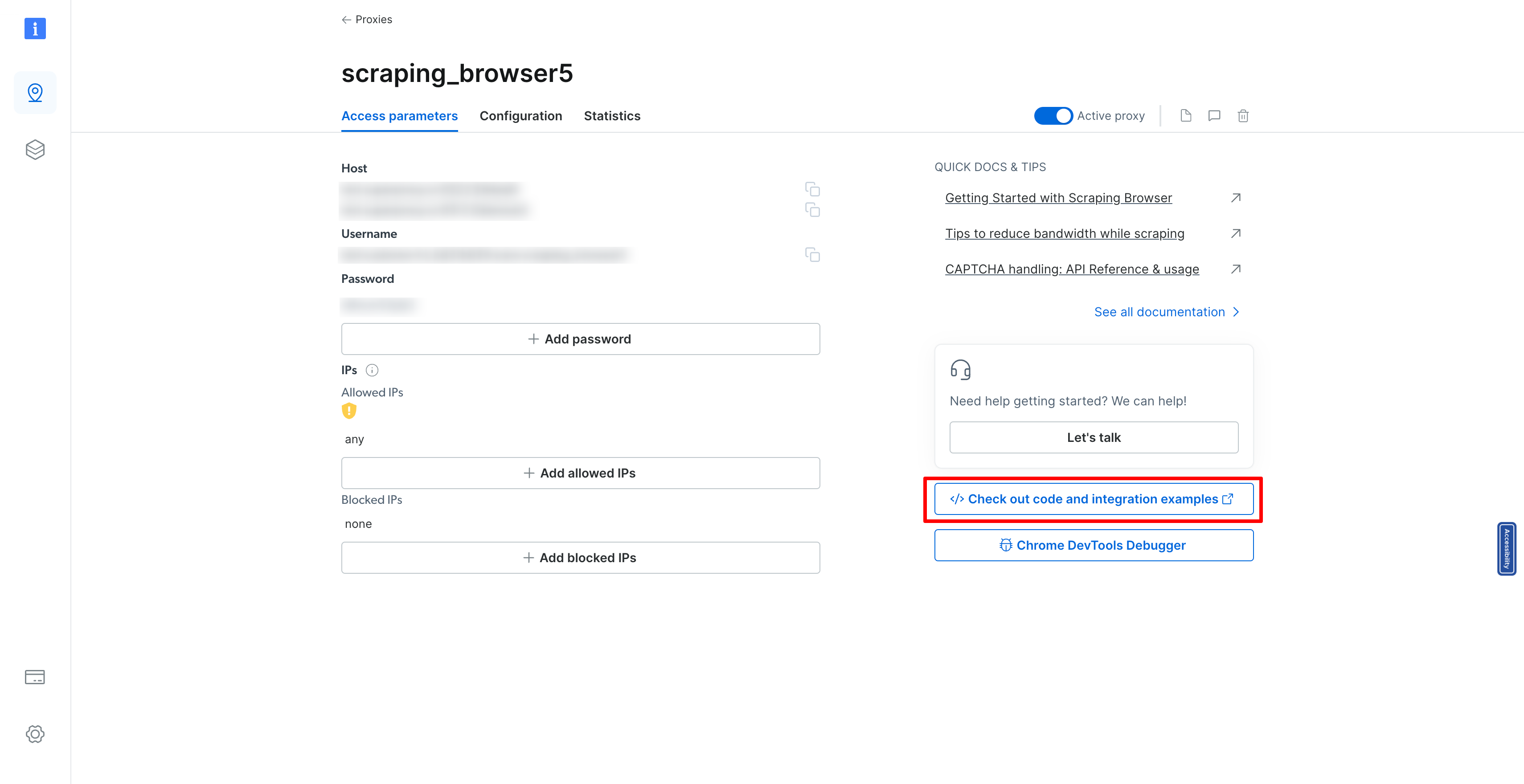 #### 第 10 步:整合您的抓取瀏覽器 最後,複製 SRS\_WS\_ENDPOINT 變數。這是一條關鍵訊息,您需要將其整合到原始程式碼中,以便您的應用程式能夠與您剛剛設定的抓取瀏覽器進行通訊。 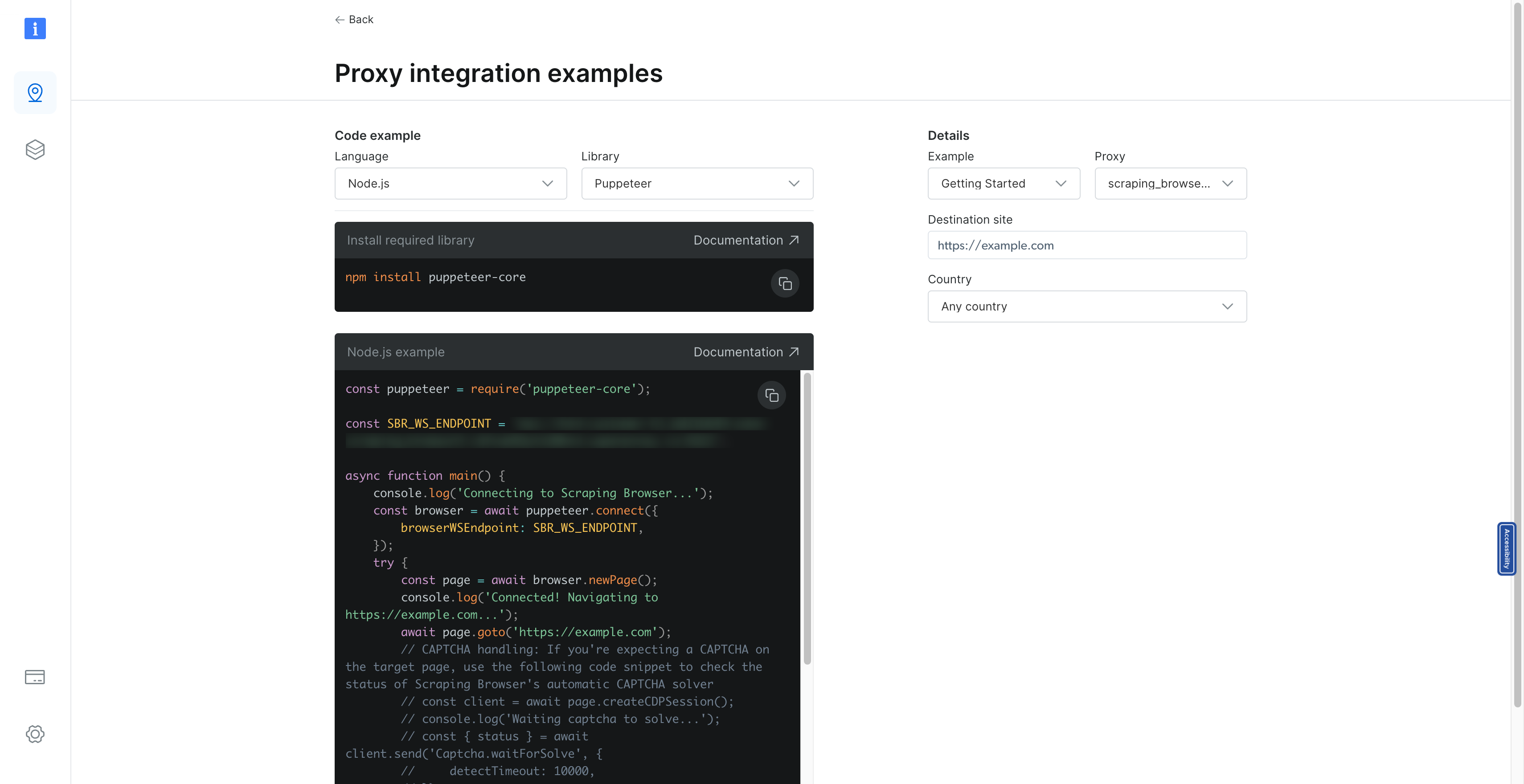 透過遵循這些詳細步驟,您已在 Bright Data 平台中成功建立了一個抓取瀏覽器,準備好處理您的網頁抓取任務。請記住,Bright Data 提供廣泛的文件和支持,幫助您最大限度地提高抓取專案的效率和效果。無論您是在收集市場情報、進行研究還是監控競爭格局,新設定的抓取瀏覽器都是資料收集庫中的強大工具。 ### 第 7 步:使用 Puppeteer 實作抓取邏輯 從我們上次設定用於抓取航班資料的 Next.js 應用程式的地方開始,下一個關鍵步驟是實現實際的抓取邏輯。此過程涉及利用 Puppeteer 連接到瀏覽器實例、導航到目標 URL(在我們的範例中為 Kayak)並抓取必要的飛行資料。提供的程式碼片段概述了實現此目標的複雜方法,與我們先前建立的 BullMQ 工作設定無縫整合。讓我們分解這個抓取邏輯的元件,並了解它如何適合我們的應用程式。 #### 建立與瀏覽器的連接 我們抓取過程的第一步是透過 Puppeteer 建立與瀏覽器的連線。這是透過利用`puppeteer.connect`方法來完成的,該方法使用 WebSocket 端點 ( `SBR_WS_ENDPOINT` ) 連接到現有的瀏覽器實例。此環境變數應設定為您正在使用的抓取瀏覽器服務的 WebSocket URL,例如 Bright Data: ``` const browser = await puppeteer.connect({ browserWSEndpoint: SBR_WS_ENDPOINT, }); ``` #### 開啟新頁面並導航到目標 URL 連線後,我們在瀏覽器中建立一個新頁面並導航到作業資料中指定的目標 URL。此 URL 是我們打算從中抓取航班資料的特定 Kayak 搜尋結果頁面: ``` const page = await browser.newPage(); await page.goto(job.data.url); ``` #### 抓取航班資料 我們邏輯的核心在於從頁面中抓取航班資料。我們透過使用`page.evaluate`來實現這一點,這是一種 Puppeteer 方法,允許我們在瀏覽器上下文中執行腳本。在此腳本中,我們等待必要的元素加載,然後繼續收集航班資訊: - **Flight Selector** :我們以`.nrc6-wrapper`類別為目標元素,其中包含航班詳細資訊。 - **資料擷取**:對於每個航班元素,我們提取詳細訊息,例如航空公司徽標、出發和到達時間、航班持續時間、航空公司名稱和價格。出發和到達時間經過清理,以刪除最後不必要的數值,確保我們準確地捕捉時間。 - **價格處理**:價格在刪除所有非數字字元後提取為整數,確保其可用於數值運算或比較。 擷取的資料被建構成飛行物件陣列,每個物件都包含上述詳細資訊: ``` const scrappedFlights = await page.evaluate(async () => { // Data extraction logic const flights = []; // Process each flight element // ... return flights; }); ``` #### 錯誤處理和清理 我們的抓取邏輯被包裝在一個 try-catch 區塊中,以在抓取過程中優雅地處理任何潛在的錯誤。無論結果如何,我們都會確保瀏覽器在finally區塊中正確關閉,從而保持資源效率並防止潛在的記憶體洩漏: ``` try { // Scraping logic } catch (error) { console.log({ error }); } finally { await browser.close(); console.log("Browser closed successfully."); } ``` #### 整個程式碼 ``` const SBR_WS_ENDPOINT = process.env.SBR_WS_ENDPOINT; export const register = async () => { if (process.env.NEXT_RUNTIME === "nodejs") { const { Worker } = await import("bullmq"); const puppeteer = await import("puppeteer"); const { connection } = await import("./lib/redis"); const { importQueue } = await import("./lib/queue"); new Worker( "importQueue", async (job) => { const browser = await puppeteer.connect({ browserWSEndpoint: SBR_WS_ENDPOINT, }); try { const page = await browser.newPage(); console.log("in flight scraping"); console.log("Connected! Navigating to " + job.data.url); await page.goto(job.data.url); console.log("Navigated! Scraping page content..."); const scrappedFlights = await page.evaluate(async () => { await new Promise((resolve) => setTimeout(resolve, 5000)); const flights = []; const flightSelectors = document.querySelectorAll(".nrc6-wrapper"); flightSelectors.forEach((flightElement) => { const airlineLogo = flightElement.querySelector("img")?.src || ""; const [rawDepartureTime, rawArrivalTime] = ( flightElement.querySelector(".vmXl")?.innerText || "" ).split(" – "); // Function to extract time and remove numeric values at the end const extractTime = (rawTime: string): string => { const timeWithoutNumbers = rawTime .replace(/[0-9+\s]+$/, "") .trim(); return timeWithoutNumbers; }; const departureTime = extractTime(rawDepartureTime); const arrivalTime = extractTime(rawArrivalTime); const flightDuration = ( flightElement.querySelector(".xdW8")?.children[0]?.innerText || "" ).trim(); const airlineName = ( flightElement.querySelector(".VY2U")?.children[1]?.innerText || "" ).trim(); // Extract price const price = parseInt( ( flightElement.querySelector(".f8F1-price-text")?.innerText || "" ) .replace(/[^\d]/g, "") .trim(), 10 ); flights.push({ airlineLogo, departureTime, arrivalTime, flightDuration, airlineName, price, }); }); return flights; }); } catch (error) { console.log({ error }); } finally { await browser.close(); console.log("Browser closed successfully."); } }, { connection, concurrency: 10, removeOnComplete: { count: 1000 }, removeOnFail: { count: 5000 }, } ); } }; ``` ### 步驟8:航班搜尋功能 基於我們的航班資料抓取功能,讓我們將全面的航班搜尋功能整合到我們的 Next.js 應用程式中。此功能將為使用者提供一個動態介面,透過指定出發地、目的地和日期來搜尋航班。利用強大的 Next.js 框架以及現代 UI 庫和狀態管理,我們建立了引人入勝且響應迅速的航班搜尋體驗。 #### 航班搜尋功能的關鍵組成部分 1. **動態城市選擇**:此功能包括來源和目的地輸入的自動完成功能,由預先定義的城市機場程式碼清單提供支援。當使用者輸入時,應用程式會過濾並顯示匹配的城市,透過更輕鬆地尋找和選擇機場來增強用戶體驗。 2. **日期選擇**:使用者可以透過日期輸入選擇預期的航班日期,為規劃旅行提供彈性。 3. **抓取狀態監控**:啟動抓取作業後,應用程式透過定期 API 呼叫來監控作業的狀態。這種非同步檢查允許應用程式使用抓取過程的狀態更新 UI,確保使用者了解進度和結果。 #### 航班搜尋元件的完整程式碼 ``` "use client"; import { useAppStore } from "@/store"; import { USER_API_ROUTES } from "@/utils/api-routes"; import { cityAirportCode } from "@/utils/city-airport-codes"; import { Button, Input, Listbox, ListboxItem } from "@nextui-org/react"; import axios from "axios"; import Image from "next/image"; import { useRouter } from "next/navigation"; import React, { useEffect, useRef, useState } from "react"; import { FaCalendarAlt, FaSearch } from "react-icons/fa"; const SearchFlights = () => { const router = useRouter(); const { setScraping, setScrapingType, setScrappedFlights } = useAppStore(); const [loadingJobId, setLoadingJobId] = useState<number | undefined>(undefined); const [source, setSource] = useState(""); const [sourceOptions, setSourceOptions] = useState< { city: string; code: string; }[] >([]); const [destination, setDestination] = useState(""); const [destinationOptions, setDestinationOptions] = useState< { city: string; code: string; }[] >([]); const [flightDate, setFlightDate] = useState(() => { const today = new Date(); return today.toISOString().split("T")[0]; }); const handleSourceChange = (query: string) => { const matchingCities = Object.entries(cityAirportCode) .filter(([, city]) => city.toLowerCase().includes(query.toLowerCase())) .map(([code, city]) => ({ code, city })) .splice(0, 5); setSourceOptions(matchingCities); }; const destinationChange = (query: string) => { const matchingCities = Object.entries(cityAirportCode) .filter(([, city]) => city.toLowerCase().includes(query.toLowerCase())) .map(([code, city]) => ({ code, city })) .splice(0, 5); setDestinationOptions(matchingCities); }; const startScraping = async () => { if (source && destination && flightDate) { const data = await axios.get(`${USER_API_ROUTES.FLIGHT_SCRAPE}?source=${source}&destination=${destination}&date=${flightDate}`); if (data.data.id) { setLoadingJobId(data.data.id); setScraping(true); setScrapingType("flight"); } } }; useEffect(() => { if (loadingJobId) { const checkIfJobCompleted = async () => { try { const response = await axios.get(`${USER_API_ROUTES.FLIGHT_SCRAPE_STATUS}?jobId=${loadingJobId}`); if (response.data.status) { set ScrappedFlights(response.data.flights); clearInterval(jobIntervalRef.current); setScraping(false); setScrapingType(undefined); router.push(`/flights?data=${flightDate}`); } } catch (error) { console.log(error); } }; jobIntervalRef.current = setInterval(checkIfJobCompleted, 3000); } return () => clearInterval(jobIntervalRef.current); }, [loadingJobId]); return ( <div className="h-[90vh] flex items-center justify-center"> <div className="absolute left-0 top-0 h-[100vh] w-[100vw] max-w-[100vw] overflow-hidden overflow-x-hidden"> <Image src="/flight-search.png" fill alt="Search" /> </div> <div className="absolute h-[50vh] w-[60vw] flex flex-col gap-5"> {/* UI and functionality for flight search */} </div> </div> ); }; export default SearchFlights; ``` ### 步驟9:航班搜尋頁面UI  ### 顯示航班搜尋結果 成功抓取飛行資料後,下一個關鍵步驟是以使用者友善的方式將這些結果呈現給使用者。 Next.js 應用程式中的 Flights 元件就是為此目的而設計的。 ``` "use client"; import { useAppStore } from "@/store"; import { USER_API_ROUTES } from "@/utils/api-routes"; import { Button } from "@nextui-org/react"; import axios from "axios"; import Image from "next/image"; import { useRouter, useSearchParams } from "next/navigation"; import React from "react"; import { FaChevronLeft } from "react-icons/fa"; import { MdOutlineFlight } from "react-icons/md"; const Flights = () => { const router = useRouter(); const searchParams = useSearchParams(); const date = searchParams.get("date"); const { scrappedFlights, userInfo } = useAppStore(); const getRandomNumber = () => Math.floor(Math.random() * 41); const bookFLight = async (flightId: number) => {}; return ( <div className="m-10 px-[20vw] min-h-[80vh]"> <Button className="my-5" variant="shadow" color="primary" size="lg" onClick={() => router.push("/search-flights")} > <FaChevronLeft /> Go Back </Button> <div className="flex-col flex gap-5"> {scrappedFlights.length === 0 && ( <div className="flex items-center justify-center py-5 px-10 mt-10 rounded-lg text-red-500 bg-red-100 font-medium"> No Flights found. </div> )} {scrappedFlights.map((flight: any) => { const seatsLeft = getRandomNumber(); return ( <div key={flight.id} className="grid grid-cols-12 border bg-gray-200 rounded-xl font-medium drop-shadow-md" > <div className="col-span-9 bg-white rounded-l-xl p-10 flex flex-col gap-5"> <div className="grid grid-cols-4 gap-4"> <div className="flex flex-col gap-3 font-medium"> <div> <div className="relative w-20 h-16"> <Image src={flight.logo} alt="airline name" fill /> </div> </div> <div>{flight.name}</div> </div> <div className="col-span-3 flex justify-between"> <div className="flex flex-col gap-2"> <div className="text-blue-600">From</div> <div> <span className="text-3xl"> <strong>{flight.departureTime}</strong> </span> </div> <div>{flight.from}</div> </div> <div className="flex flex-col items-center justify-center gap-2"> <div className="bg-violet-100 w-max p-3 text-4xl text-blue-600 rounded-full"> <MdOutlineFlight /> </div> <div> <span className="text-lg"> <strong>Non-stop</strong> </span> </div> <div>{flight.duration}</div> </div> <div className="flex flex-col gap-2"> <div className="text-blue-600">To</div> <div> <span className="text-3xl"> <strong>{flight.arrivalTime}</strong> </span> </div> <div>{flight.to}</div> </div> </div> </div> <div className="flex justify-center gap-10 bg-violet-100 p-3 rounded-lg"> <div className="flex"> <span>Airplane </span> <span className="text-blue-600 font-semibold"> Boeing 787 </span> </div> <div className="flex"> <span>Travel Class: </span> <span className="text-blue-600 font-semibold">Economy</span> </div> </div> <div className="flex justify-between font-medium"> <div> Refundable <span className="text-blue-600"> $5 ecash</span> </div> <div className={`${ seatsLeft > 20 ? "text-green-500" : "text-red-500" }`} > Only {seatsLeft} Seats Left </div> <div className="cursor-pointer">Flight Details</div> </div> </div> <div className="col-span-3 bg-violet-100 rounded-r-xl h-full flex flex-col items-center justify-center gap-5"> <div> <div> <span className="line-through font-light"> ${flight.price + 140} </span> </div> <div className="flex items-center gap-2"> <span className="text-5xl font-bold">${flight.price}</span> <span className="text-blue-600">20% OFF</span> </div> </div> <Button variant="ghost" radius="full" size="lg" color="primary" onClick={() => { if (userInfo) bookFLight(flight.id); }} > {userInfo ? "Book Now" : "Login to Book"} </Button> </div> </div> ); })} </div> </div> ); }; export default Flights; ``` #### 航班搜尋結果  ### 探索完整的指南和程式碼庫 上面共享的部分和程式碼片段僅代表使用 Next.js 建立強大的航班資料抓取和搜尋應用程式所需的完整功能和程式碼的一小部分。為了掌握這個專案的全部內容,包括高級功能、優化和最佳實踐,我邀請您更深入地研究我的線上綜合資源。 #### 在 YouTube 上觀看詳細說明 有關引導您完成此應用程式的開發過程、編碼細微差別和功能的逐步影片指南,請觀看我的 YouTube 影片。本教程旨在讓您更深入地了解這些概念,讓您按照自己的步調進行操作並獲得對 Next.js 應用程式開發的寶貴見解。 https://www.youtube.com/watch?v=ZWVhk0fxHM0 #### 在 GitHub 上探索完整程式碼 如果您渴望探索完整的程式碼,請造訪我的 GitHub 儲存庫。在那裡,您將找到完整的程式碼庫,包括讓該應用程式在您自己的電腦上執行所需的所有元件、實用程式和設定說明。 https://github.com/koolkishan/nextjs-travel-planner ### 結論 使用 Next.js 建立飛行資料抓取和搜尋工具等綜合應用程式展示了現代 Web 開發工具和框架的強大功能和多功能性。無論您是希望提高技能的經驗豐富的開發人員,還是渴望深入 Web 開發的初學者,這些資源都是為您的旅程量身定制的。在 YouTube 上觀看詳細教程,在 GitHub 上探索完整程式碼,並加入對話以增強您的開發專業知識並為充滿活力的開發者社群做出貢獻。 --- 原文出處:https://dev.to/kishansheth/nextjs-14-booking-app-with-live-data-scraping-using-scraping-browser-610
> **2019 年 9 月 25 日更新:**感謝[ラナ・kuaru](https://twitter.com/rana_kualu)的辛勤工作,本文現已提供日文版。請點擊下面的連結查看他們的工作。如果您知道本文被翻譯成其他語言,請告訴我,我會將其發佈在這裡。 [🇯🇵 閱讀日語](https://qiita.com/rana_kualu/items/7b62898d373901466f5c) > **2019 年 7 月 8 日更新:**我最近發現大約兩年前發佈在法語留言板上的[這篇非常相似的文章](https://bookmarks.ecyseo.net/?EAWvDw)。如果您有興趣學習一些 shell 命令——並且您*會說 français* ,那麼它是對我下面的文章的一個很好的補充。 直到大約一年前,我幾乎只在 macOS 和 Ubuntu 作業系統中工作。在這兩個作業系統上, `bash`是我的預設 shell。在過去的六、七年裡,我對`bash`工作原理有了大致的了解,並想為那些剛入門的人概述一些更常見/有用的命令。如果您認為您了解有關`bash`所有訊息,請無論如何看看下面的內容 - 我已經提供了一些提示和您可能忘記的標誌的提醒,這可以讓您的工作更輕鬆一些。 下面的命令或多或少以敘述風格排列,因此如果您剛開始使用`bash` ,您可以從頭到尾完成操作。事情到最後通常會變得不那麼常見並且變得更加困難。 <a name="toc"></a> 目錄 -- - [基礎](#the-basics) ``` - [First Commands, Navigating the Filesystem](#first-commands) ``` ``` - [`pwd / ls / cd`](#pwd-ls-cd) ``` ``` - [`; / && / &`](#semicolon-andand-and) ``` ``` - [Getting Help](#getting-help) ``` ``` - [`-h`](#minus-h) ``` ``` - [`man`](#man) ``` ``` - [Viewing and Editing Files](#viewing-and-editing-files) ``` ``` - [`head / tail / cat / less`](#head-tail-cat-less) ``` ``` - [`nano / nedit`](#nano-nedit) ``` ``` - [Creating and Deleting Files and Directories](#creating-and-deleting-files) ``` ``` - [`touch`](#touch) ``` ``` - [`mkdir / rm / rmdir`](#mkdir-rm-rmdir) ``` ``` - [Moving and Copying Files, Making Links, Command History](#moving-and-copying-files) ``` ``` - [`mv / cp / ln`](#mv-cp-ln) ``` ``` - [Command History](#command-history) ``` ``` - [Directory Trees, Disk Usage, and Processes](#directory-trees-disk-usage-processes) ``` ``` - [`mkdir –p / tree`](#mkdir--p-tree) ``` ``` - [`df / du / ps`](#df-du-ps) ``` ``` - [Miscellaneous](#basic-misc) ``` ``` - [`passwd / logout / exit`](#passwd-logout-exit) ``` ``` - [`clear / *`](#clear-glob) ``` - [中間的](#intermediate) ``` - [Disk, Memory, and Processor Usage](#disk-memory-processor) ``` ``` - [`ncdu`](#ncdu) ``` ``` - [`top / htop`](#top-htop) ``` ``` - [REPLs and Software Versions](#REPLs-software-versions) ``` ``` - [REPLs](#REPLs) ``` ``` - [`-version / --version / -v`](#version) ``` ``` - [Environment Variables and Aliases](#env-vars-aliases) ``` ``` - [Environment Variables](#env-vars) ``` ``` - [Aliases](#aliases) ``` ``` - [Basic `bash` Scripting](#basic-bash-scripting) ``` ``` - [`bash` Scripts](#bash-scripts) ``` ``` - [Custom Prompt and `ls`](#custom-prompt-ls) ``` ``` - [Config Files](#config-files) ``` ``` - [Config Files / `.bashrc`](#config-bashrc) ``` ``` - [Types of Shells](#types-of-shells) ``` ``` - [Finding Things](#finding-things) ``` ``` - [`whereis / which / whatis`](#whereis-which-whatis) ``` ``` - [`locate / find`](#locate-find) ``` ``` - [Downloading Things](#downloading-things) ``` ``` - [`ping / wget / curl`](#ping-wget-curl) ``` ``` - [`apt / gunzip / tar / gzip`](#apt-gunzip-tar-gzip) ``` ``` - [Redirecting Input and Output](#redirecting-io) ``` ``` - [`| / > / < / echo / printf`](#pipe-gt-lt-echo-printf) ``` ``` - [`0 / 1 / 2 / tee`](#std-tee) ``` - [先進的](#advanced) ``` - [Superuser](#superuser) ``` ``` - [`sudo / su`](#sudo-su) ``` ``` - [`!!`](#click-click) ``` ``` - [File Permissions](#file-permissions) ``` ``` - [File Permissions](#file-permissions-sub) ``` ``` - [`chmod / chown`](#chmod-chown) ``` ``` - [User and Group Management](#users-groups) ``` ``` - [Users](#users) ``` ``` - [Groups](#groups) ``` ``` - [Text Processing](#text-processing) ``` ``` - [`uniq / sort / diff / cmp`](#uniq-sort-diff-cmp) ``` ``` - [`cut / sed`](#cut-sed) ``` ``` - [Pattern Matching](#pattern-matching) ``` ``` - [`grep`](#grep) ``` ``` - [`awk`](#awk) ``` ``` - [Copying Files Over `ssh`](#ssh) ``` ``` - [`ssh / scp`](#ssh-scp) ``` ``` - [`rsync`](#rsync) ``` ``` - [Long-Running Processes](#long-running-processes) ``` ``` - [`yes / nohup / ps / kill`](#yes-nohup-ps-kill) ``` ``` - [`cron / crontab / >>`](#cron) ``` ``` - [Miscellaneous](#advanced-misc) ``` ``` - [`pushd / popd`](#pushd-popd) ``` ``` - [`xdg-open`](#xdg-open) ``` ``` - [`xargs`](#xargs) ``` - [獎勵:有趣但大多無用的東西](#bonus) ``` - [`w / write / wall / lynx`](#w-write-wall-lynx) ``` ``` - [`nautilus / date / cal / bc`](#nautilus-date-cal-bc) ``` --- <a name="the-basics"></a> 基礎 == <a name="first-commands"></a> 第一個指令,瀏覽檔案系統 ------------ 現代檔案系統具有目錄(資料夾)樹,其中目錄要么是*根目錄*(沒有父目錄),要么是*子目錄*(包含在單一其他目錄中,我們稱之為“父目錄”)。向後遍歷檔案樹(從子目錄到父目錄)將始終到達根目錄。有些檔案系統有多個根目錄(如 Windows 的磁碟機: `C:\` 、 `A:\`等),但 Unix 和類別 Unix 系統只有一個名為`\`的根目錄。 <a name="pwd-ls-cd"></a> ### `pwd / ls / cd` [\[ 返回目錄 \]](#toc) 在檔案系統中工作時,使用者始終*在*某個目錄中工作,我們稱之為當前目錄或*工作目錄*。使用`pwd`列印使用者的工作目錄: ``` [ andrew@pc01 ~ ]$ pwd /home/andrew ``` 使用`ls`列出該目錄的內容(檔案和/或子目錄等): ``` [ andrew@pc01 ~ ]$ ls Git TEST jdoc test test.file ``` > **獎金:** > > 使用`ls -a`顯示隱藏(“點”)文件 > > 使用`ls -l`顯示文件詳細訊息 > > 組合多個標誌,如`ls -l -a` > > 有時您可以連結諸如`ls -la`之類的標誌,而不是`ls -l -a` 使用`cd`更改到不同的目錄(更改目錄): ``` [ andrew@pc01 ~ ]$ cd TEST/ [ andrew@pc01 TEST ]$ pwd /home/andrew/TEST [ andrew@pc01 TEST ]$ cd A [ andrew@pc01 A ]$ pwd /home/andrew/TEST/A ``` `cd ..`是「 `cd`到父目錄」的簡寫: ``` [ andrew@pc01 A ]$ cd .. [ andrew@pc01 TEST ]$ pwd /home/andrew/TEST ``` `cd ~`或只是`cd`是「 `cd`到我的主目錄」的簡寫(通常`/home/username`或類似的東西): ``` [ andrew@pc01 TEST ]$ cd [ andrew@pc01 ~ ]$ pwd /home/andrew ``` > **獎金:** > > `cd ~user`表示「 `cd`到`user`的主目錄 > > 您可以使用`cd ../..`等跳轉多個目錄等級。 > > 使用`cd -`返回到最近的目錄 > > `.`是「此目錄」的簡寫,因此`cd .`不會做太多事情 <a name="semicolon-andand-and"></a> ### `; / && / &` [\[ 返回目錄 \]](#toc) 我們在命令列中輸入的內容稱為*命令*,它們總是執行儲存在電腦上某處的一些機器碼。有時這個機器碼是一個內建的Linux命令,有時它是一個應用程式,有時它是你自己寫的一些程式碼。有時,我們會想依序執行一個指令。為此,我們可以使用`;` (分號): ``` [ andrew@pc01 ~ ]$ ls; pwd Git TEST jdoc test test.file /home/andrew ``` 上面的分號表示我首先 ( `ls` ) 列出工作目錄的內容,然後 ( `pwd` ) 列印其位置。連結命令的另一個有用工具是`&&` 。使用`&&`時,如果左側命令失敗,則右側命令將不會執行。 `;`和`&&`都可以在同一行中多次使用: ``` # whoops! I made a typo here! [ andrew@pc01 ~ ]$ cd /Giit/Parser && pwd && ls && cd -bash: cd: /Giit/Parser: No such file or directory # the first command passes now, so the following commands are run [ andrew@pc01 ~ ]$ cd Git/Parser/ && pwd && ls && cd /home/andrew/Git/Parser README.md doc.sh pom.xml resource run.sh shell.sh source src target ``` ....但是與`;` ,即使第一個命令失敗,第二個命令也會執行: ``` # pwd and ls still run, even though the cd command failed [ andrew@pc01 ~ ]$ cd /Giit/Parser ; pwd ; ls -bash: cd: /Giit/Parser: No such file or directory /home/andrew Git TEST jdoc test test.file ``` `&`看起來與`&&`類似,但實際上實現了完全不同的功能。通常,當您執行長時間執行的命令時,命令列將等待該命令完成,然後才允許您輸入另一個命令。在命令後面加上`&`可以防止這種情況發生,並允許您在舊命令仍在執行時執行新命令: ``` [ andrew@pc01 ~ ]$ cd Git/Parser && mvn package & cd [1] 9263 ``` > **額外的好處:**當我們在命令後使用`&`來「隱藏」它時,我們說該作業(或「進程」;這些術語或多或少可以互換)是「後台的」。若要查看目前正在執行的背景作業,請使用`jobs`指令: > ````bash \[ andrew@pc01 ~ \]$ 職位 \[1\]+ 執行 cd Git/Parser/ && mvn package & ``` <a name="getting-help"></a> ## Getting Help <a name="minus-h"></a> ### `-h` [[ Back to Table of Contents ]](#toc) Type `-h` or `--help` after almost any command to bring up a help menu for that command: ``` \[ andrew@pc01 ~ \]$ du --help 用法:你\[選項\]...\[檔案\]... 或: du \[選項\]... --files0-from=F 對目錄遞歸地總結文件集的磁碟使用情況。 長期權的強制性參數對於短期權也是強制性的。 -0, --null 以 NUL 結束每個輸出行,而不是換行符 -a, --all 計算所有檔案的寫入計數,而不僅僅是目錄 ``` --apparent-size print apparent sizes, rather than disk usage; although ``` ``` the apparent size is usually smaller, it may be ``` ``` larger due to holes in ('sparse') files, internal ``` ``` fragmentation, indirect blocks, and the like ``` -B, --block-size=SIZE 在列印前按 SIZE 縮放大小;例如, ``` '-BM' prints sizes in units of 1,048,576 bytes; ``` ``` see SIZE format below ``` … ``` <a name="man"></a> ### `man` [[ Back to Table of Contents ]](#toc) Type `man` before almost any command to bring up a manual for that command (quit `man` with `q`): ``` LS(1) 使用者指令 LS(1) 姓名 ``` ls - list directory contents ``` 概要 ``` ls [OPTION]... [FILE]... ``` 描述 ``` List information about the FILEs (the current directory by default). ``` ``` Sort entries alphabetically if none of -cftuvSUX nor --sort is speci- ``` ``` fied. ``` ``` Mandatory arguments to long options are mandatory for short options ``` ``` too. ``` … ``` <a name="viewing-and-editing-files"></a> ## Viewing and Editing Files <a name="head-tail-cat-less"></a> ### `head / tail / cat / less` [[ Back to Table of Contents ]](#toc) `head` outputs the first few lines of a file. The `-n` flag specifies the number of lines to show (the default is 10): ``` 列印前三行 ===== \[ andrew@pc01 ~ \]$ 頭 -n 3 c 這 文件 有 ``` `tail` outputs the last few lines of a file. You can get the last `n` lines (like above), or you can get the end of the file beginning from the `N`-th line with `tail -n +N`: ``` 從第 4 行開始列印文件末尾 ============== \[ andrew@pc01 ~ \]$ tail -n +4 c 確切地 六 線 ``` `cat` concatenates a list of files and sends them to the standard output stream (usually the terminal). `cat` can be used with just a single file, or multiple files, and is often used to quickly view them. (**Be warned**: if you use `cat` in this way, you may be accused of a [_Useless Use of Cat_ (UUOC)](http://bit.ly/2SPHE4V), but it's not that big of a deal, so don't worry too much about it.) ``` \[ andrew@pc01 ~ \]$ 貓 a 歸檔一個 \[ andrew@pc01 ~ \]$ 貓 ab 歸檔一個 文件b ``` `less` is another tool for quickly viewing a file -- it opens up a `vim`-like read-only window. (Yes, there is a command called `more`, but `less` -- unintuitively -- offers a superset of the functionality of `more` and is recommended over it.) Learn more (or less?) about [less](http://man7.org/linux/man-pages/man1/less.1.html) and [more](http://man7.org/linux/man-pages/man1/more.1.html) at their `man` pages. <a name="nano-nedit"></a> ### `nano / nedit` [[ Back to Table of Contents ]](#toc) `nano` is a minimalistic command-line text editor. It's a great editor for beginners or people who don't want to learn a million shortcuts. It was more than sufficient for me for the first few years of my coding career (I'm only now starting to look into more powerful editors, mainly because defining your own syntax highlighting in `nano` can be a bit of a pain.) `nedit` is a small graphical editor, it opens up an X Window and allows point-and-click editing, drag-and-drop, syntax highlighting and more. I use `nedit` sometimes when I want to make small changes to a script and re-run it over and over. Other common CLI (command-line interface) / GUI (graphical user interface) editors include `emacs`, `vi`, `vim`, `gedit`, Notepad++, Atom, and lots more. Some cool ones that I've played around with (and can endorse) include Micro, Light Table, and VS Code. All modern editors offer basic conveniences like search and replace, syntax highlighting, and so on. `vi(m)` and `emacs` have more features than `nano` and `nedit`, but they have a much steeper learning curve. Try a few different editors out and find one that works for you! <a name="creating-and-deleting-files"></a> ## Creating and Deleting Files and Directories <a name="touch"></a> ### `touch` [[ Back to Table of Contents ]](#toc) `touch` was created to modify file timestamps, but it can also be used to quickly create an empty file. You can create a new file by opening it with a text editor, like `nano`: ``` \[ andrew@pc01 前 \]$ ls \[ andrew@pc01 ex \]$ 奈米 a ``` _...editing file..._ ``` \[ andrew@pc01 前 \]$ ls A ``` ...or by simply using `touch`: ``` \[ andrew@pc01 ex \]$ touch b && ls ab ``` > **Bonus**: > > Background a process with \^z (Ctrl+z) > > ```bash > [ andrew@pc01 ex ]$ nano a > ``` > > _...editing file, then hit \^z..._ > > ```bash > Use fg to return to nano > > [1]+ Stopped nano a > [ andrew@pc01 ex ]$ fg > ``` > > _...editing file again..._ --- > **Double Bonus:** > > Kill the current (foreground) process by pressing \^c (Ctrl+c) while it’s running > > Kill a background process with `kill %N` where `N` is the job index shown by the `jobs` command <a name="mkdir-rm-rmdir"></a> ### `mkdir / rm / rmdir` [[ Back to Table of Contents ]](#toc) `mkdir` is used to create new, empty directories: ``` \[ andrew@pc01 ex \]$ ls && mkdir c && ls ab ABC ``` You can remove any file with `rm` -- but be careful, this is non-recoverable! ``` \[ andrew@pc01 ex \]$ rm a && ls 西元前 ``` You can add an _"are you sure?"_ prompt with the `-i` flag: ``` \[ andrew@pc01 前 \]$ rm -ib rm:刪除常規空文件“b”? y ``` Remove an empty directory with `rmdir`. If you `ls -a` in an empty directory, you should only see a reference to the directory itself (`.`) and a reference to its parent directory (`..`): ``` \[ andrew@pc01 ex \]$ rmdir c && ls -a 。 .. ``` `rmdir` removes empty directories only: ``` \[ andrew@pc01 ex \]$ cd .. && ls 測試/ \*.txt 0.txt 1.txt a a.txt bc \[ andrew@pc01 ~ \]$ rmdir 測試/ rmdir:無法刪除“test/”:目錄不為空 ``` ...but you can remove a directory -- and all of its contents -- with `rm -rf` (`-r` = recursive, `-f` = force): ``` \[ andrew@pc01 ~ \]$ rm –rf 測試 ``` <a name="moving-and-copying-files"></a> ## Moving and Copying Files, Making Links, Command History <a name="mv-cp-ln"></a> ### `mv / cp / ln` [[ Back to Table of Contents ]](#toc) `mv` moves / renames a file. You can `mv` a file to a new directory and keep the same file name or `mv` a file to a "new file" (rename it): ``` \[ andrew@pc01 ex \]$ ls && mv ae && ls A B C D BCDE ``` `cp` copies a file: ``` \[ andrew@pc01 ex \]$ cp e e2 && ls BCDE E2 ``` `ln` creates a hard link to a file: ``` ln 的第一個參數是 TARGET,第二個參數是 NEW LINK ================================= \[ andrew@pc01 ex \]$ ln bf && ls bcde e2 f ``` `ln -s` creates a soft link to a file: ``` \[ andrew@pc01 ex \]$ ln -sbg && ls BCDE E2 FG ``` Hard links reference the same actual bytes in memory which contain a file, while soft links refer to the original file name, which itself points to those bytes. [You can read more about soft vs. hard links here.](http://bit.ly/2D0W8cN) <a name="command-history"></a> ### Command History [[ Back to Table of Contents ]](#toc) `bash` has two big features to help you complete and re-run commands, the first is _tab completion_. Simply type the first part of a command, hit the \<tab\> key, and let the terminal guess what you're trying to do: ``` \[ andrew@pc01 目錄 \]$ ls 另一個長檔名 這是一個長檔名 一個新檔名 \[ andrew@pc01 目錄 \]$ ls t ``` _...hit the TAB key after typing `ls t` and the command is completed..._ ``` \[ andrew@pc01 dir \]$ ls 這是檔名 這是長檔名 ``` You may have to hit \<TAB\> multiple times if there's an ambiguity: ``` \[ andrew@pc01 目錄 \]$ ls a \[ andrew@pc01 目錄 \]$ ls an 一個新檔名另一個長檔名 ``` `bash` keeps a short history of the commands you've typed previously and lets you search through those commands by typing \^r (Ctrl+r): ``` \[ andrew@pc01 目錄 \] ``` _...hit \^r (Ctrl+r) to search the command history..._ ``` (反向搜尋)``: ``` _...type 'anew' and the last command containing this is found..._ ``` (reverse-i-search)`anew': 觸碰新檔名 ``` <a name="directory-trees-disk-usage-processes"></a> ## Directory Trees, Disk Usage, and Processes <a name="mkdir--p-tree"></a> ### `mkdir –p / tree` [[ Back to Table of Contents ]](#toc) `mkdir`, by default, only makes a single directory. This means that if, for instance, directory `d/e` doesn't exist, then `d/e/f` can't be made with `mkdir` by itself: ``` \[ andrew@pc01 ex \]$ ls && mkdir d/e/f ABC mkdir:無法建立目錄「d/e/f」:沒有這樣的檔案或目錄 ``` But if we pass the `-p` flag to `mkdir`, it will make all directories in the path if they don't already exist: ``` \[ andrew@pc01 ex \]$ mkdir -pd/e/f && ls A B C D ``` `tree` can help you better visualise a directory's structure by printing a nicely-formatted directory tree. By default, it prints the entire tree structure (beginning with the specified directory), but you can restrict it to a certain number of levels with the `-L` flag: ``` \[ andrew@pc01 前 \]$ 樹 -L 2 。 |-- 一個 |-- b |-- c `--d ``` `--e ``` 3個目錄,2個文件 ``` You can hide empty directories in `tree`'s output with `--prune`. Note that this also removes "recursively empty" directories, or directories which aren't empty _per se_, but which contain only other empty directories, or other recursively empty directories: ``` \[ andrew@pc01 ex \]$ 樹 --prune 。 |-- 一個 `--b ``` <a name="df-du-ps"></a> ### `df / du / ps` [[ Back to Table of Contents ]](#toc) `df` is used to show how much space is taken up by files for the disks or your system (hard drives, etc.). ``` \[ andrew@pc01 前 \]$ df -h 已使用的檔案系統大小 可用 使用% 安裝於 udev 126G 0 126G 0% /dev tmpfs 26G 2.0G 24G 8% /執行 /dev/mapper/ubuntu--vg-root 1.6T 1.3T 252G 84% / … ``` In the above command, `-h` doesn't mean "help", but "human-readable". Some commands use this convention to display file / disk sizes with `K` for kilobytes, `G` for gigabytes, and so on, instead of writing out a gigantic integer number of bytes. `du` shows file space usage for a particular directory and its subdirectories. If you want to know how much space is free on a given hard drive, use `df`; if you want to know how much space a directory is taking up, use `du`: ``` \[ andrew@pc01 ex \]$ 你 4 ./d/e/f 8./d/e 12 ./天 4./c 20 . ``` `du` takes a `--max-depth=N` flag, which only shows directories `N` levels down (or fewer) from the specified directory: ``` \[ andrew@pc01 ex \]$ du -h --max-深度=1 12K./天 4.0K./c 20K。 ``` `ps` shows all of the user's currently-running processes (aka. jobs): ``` \[ andrew@pc01 前 \]$ ps PID TTY 時間 CMD 16642 分/15 00:00:00 ps 25409 點/15 00:00:00 重擊 ``` <a name="basic-misc"></a> ## Miscellaneous <a name="passwd-logout-exit"></a> ### `passwd / logout / exit` [[ Back to Table of Contents ]](#toc) Change your account password with `passwd`. It will ask for your current password for verification, then ask you to enter the new password twice, so you don't make any typos: ``` \[ andrew@pc01 目錄 \]$ 密碼 更改安德魯的密碼。 (目前)UNIX 密碼: 輸入新的 UNIX 密碼: 重新輸入新的 UNIX 密碼: passwd:密碼更新成功 ``` `logout` exits a shell you’ve logged in to (where you have a user account): ``` \[ andrew@pc01 目錄 \]$ 註銷 ────────────────────────────────────────────────── ── ────────────────────────────── 會話已停止 ``` - Press <return> to exit tab ``` ``` - Press R to restart session ``` ``` - Press S to save terminal output to file ``` ``` `exit` exits any kind of shell: ``` \[ andrew@pc01 ~ \]$ 退出 登出 ────────────────────────────────────────────────── ── ────────────────────────────── 會話已停止 ``` - Press <return> to exit tab ``` ``` - Press R to restart session ``` ``` - Press S to save terminal output to file ``` ``` <a name="clear-glob"></a> ### `clear / *` [[ Back to Table of Contents ]](#toc) Run `clear` to move the current terminal line to the top of the screen. This command just adds blank lines below the current prompt line. It's good for clearing your workspace. Use the glob (`*`, aka. Kleene Star, aka. wildcard) when looking for files. Notice the difference between the following two commands: ``` \[ andrew@pc01 ~ \]$ ls Git/Parser/source/ PArrayUtils.java PFile.java PSQLFile.java PWatchman.java PDateTimeUtils.java PFixedWidthFile.java PStringUtils.java PXSVFile.java PDelimitedFile.java PNode.java PTextFile.java Parser.java \[ andrew@pc01 ~ \]$ ls Git/Parser/source/PD\* Git/Parser/source/PDateTimeUtils.java Git/Parser/source/PDelimitedFile.java ``` The glob can be used multiple times in a command and matches zero or more characers: ``` \[ andrew@pc01 ~ \]$ ls Git/Parser/source/P *D* m\* Git/Parser/source/PDateTimeUtils.java Git/Parser/source/PDelimitedFile.java ``` <a name="intermediate"></a> # Intermediate <a name="disk-memory-processor"></a> ## Disk, Memory, and Processor Usage <a name="ncdu"></a> ### `ncdu` [[ Back to Table of Contents ]](#toc) `ncdu` (NCurses Disk Usage) provides a navigable overview of file space usage, like an improved `du`. It opens a read-only `vim`-like window (press `q` to quit): ``` \[ andrew@pc01 ~ \]$ ncdu ncdu 1.11 ~ 使用箭頭鍵導航,按 ?求助 \--- /home/安德魯 ------------------------------------------- ------------------ 148.2 MiB \[##########\] /.m2 91.5 MiB \[######\] /.sbt 79.8 MiB \[######\] /.cache 64.9 MiB \[####\] /.ivy2 40.6 MiB \[##\] /.sdkman 30.2 MiB \[##\] /.local 27.4 MiB \[#\] /.mozilla 24.4 MiB \[#\] /.nanobackups 10.2 MiB \[ \] .confout3.txt ``` 8.4 MiB [ ] /.config ``` ``` 5.9 MiB [ ] /.nbi ``` ``` 5.8 MiB [ ] /.oh-my-zsh ``` ``` 4.3 MiB [ ] /Git ``` ``` 3.7 MiB [ ] /.myshell ``` ``` 1.7 MiB [ ] /jdoc ``` ``` 1.5 MiB [ ] .confout2.txt ``` ``` 1.5 MiB [ ] /.netbeans ``` ``` 1.1 MiB [ ] /.jenv ``` 564.0 KiB \[ \] /.rstudio-desktop 磁碟使用總量:552.7 MiB 表觀大小:523.6 MiB 專案:14618 ``` <a name="top-htop"></a> ### `top / htop` [[ Back to Table of Contents ]](#toc) `top` displays all currently-running processes and their owners, memory usage, and more. `htop` is an improved, interactive `top`. (Note: you can pass the `-u username` flag to restrict the displayed processes to only those owner by `username`.) ``` \[ andrew@pc01 ~ \]$ htop 1 \[ 0.0%\] 9 \[ 0.0%\] 17 \[ 0.0%\] 25 \[ 0.0%\] 2 \[ 0.0%\] 10 \[ 0.0%\] 18 \[ 0.0%\] 26 \[ 0.0%\] 3 \[ 0.0%\] 11 \[ 0.0%\] 19 \[ 0.0%\] 27 \[ 0.0%\] 4 \[ 0.0%\] 12 \[ 0.0%\] 20 \[ 0.0%\] 28 \[ 0.0%\] 5 \[ 0.0%\] 13 \[ 0.0%\] 21 \[| 1.3%\] 29 \[ 0.0%\] 6 \[ 0.0%\] 14 \[ 0.0%\] 22 \[ 0.0%\] 30 \[| 0.6%\] 7 \[ 0.0%\] 15 \[ 0.0%\] 23 \[ 0.0%\] 31 \[ 0.0%\] 8 \[ 0.0%\] 16 \[ 0.0%\] 24 \[ 0.0%\] 32 \[ 0.0%\] Mem\[|||||||||||||||||||1.42G/252G\] 任務:188、366 個; 1 執行 交換電壓\[| 2.47G/256G\]平均負載:0.00 0.00 0.00 ``` Uptime: 432 days(!), 00:03:55 ``` PID USER PRI NI VIRT RES SHR S CPU% MEM% TIME+ 指令 9389 安德魯 20 0 23344 3848 2848 R 1.3 0.0 0:00.10 htop 10103 根 20 0 3216M 17896 2444 S 0.7 0.0 5h48:56 /usr/bin/dockerd ``` 1 root 20 0 181M 4604 2972 S 0.0 0.0 15:29.66 /lib/systemd/syst ``` 533 根 20 0 44676 6908 6716 S 0.0 0.0 11:19.77 /lib/systemd/syst 546 根 20 0 244M 0 0 S 0.0 0.0 0:01.39 /sbin/lvmetad -f 1526 根 20 0 329M 2252 1916 S 0.0 0.0 0:00.00 /usr/sbin/ModemMa 1544 根 20 0 329M 2252 1916 S 0.0 0.0 0:00.06 /usr/sbin/ModemMa F1Help F2Setup F3SearchF4FilterF5Tree F6SortByF7Nice -F8Nice +F9Kill F10Quit ``` <a name="REPLs-software-versions"></a> ## REPLs and Software Versions <a name="REPLs"></a> ### REPLs [[ Back to Table of Contents ]](#toc) A **REPL** is a Read-Evaluate-Print Loop, similar to the command line, but usually used for particular programming languages. You can open the Python REPL with the `python` command (and quit with the `quit()` function): ``` \[ andrew@pc01 ~ \]$ python Python 3.5.2(默認,2018 年 11 月 12 日,13:43:14)... > > > 辭職() ``` Open the R REPL with the `R` command (and quit with the `q()` function): ``` \[ andrew@pc01 ~ \]$ R R版3.5.2(2018-12-20)--「蛋殼冰屋」... > q() 儲存工作區影像? \[是/否/c\]: 否 ``` Open the Scala REPL with the `scala` command (and quit with the `:quit` command): ``` \[ andrew@pc01 ~ \]$ scala 歡迎使用 Scala 2.11.12 ... 斯卡拉>:退出 ``` Open the Java REPL with the `jshell` command (and quit with the `/exit` command): ``` \[ andrew@pc01 ~ \]$ jshell |歡迎使用 JShell——版本 11.0.1 ... jshell> /退出 ``` Alternatively, you can exit any of these REPLs with \^d (Ctrl+d). \^d is the EOF (end of file) marker on Unix and signifies the end of input. <a name="version"></a> ### `-version / --version / -v` [[ Back to Table of Contents ]](#toc) Most commands and programs have a `-version` or `--version` flag which gives the software version of that command or program. Most applications make this information easily available: ``` \[ andrew@pc01 ~ \]$ ls --version ls (GNU coreutils) 8.25 ... \[ andrew@pc01 ~ \]$ ncdu -版本 NCDU 1.11 \[ andrew@pc01 ~ \]$ python --version Python 3.5.2 ``` ...but some are less intuitive: ``` \[ andrew@pc01 ~ \]$ sbt scalaVersion … \[資訊\]2.12.4 ``` Note that some programs use `-v` as a version flag, while others use `-v` to mean "verbose", which will run the application while printing lots of diagnostic or debugging information: ``` SCP(1) BSD 通用指令手冊 SCP(1) 姓名 ``` scp -- secure copy (remote file copy program) ``` … -v 詳細模式。導致 scp 和 ssh(1) 列印偵錯訊息 ``` about their progress. This is helpful in debugging connection, ``` ``` authentication, and configuration problems. ``` … ``` <a name="env-vars-aliases"></a> ## Environment Variables and Aliases <a name="env-vars"></a> ### Environment Variables [[ Back to Table of Contents ]](#toc) **Environment variables** (sometimes shortened to "env vars") are persistent variables that can be created and used within your `bash` shell. They are defined with an equals sign (`=`) and used with a dollar sign (`$`). You can see all currently-defined env vars with `printenv`: ``` \[ andrew@pc01 ~ \]$ printenv SPARK\_HOME=/usr/local/spark 術語=xterm … ``` Set a new environment variable with an `=` sign (don't put any spaces before or after the `=`, though!): ``` \[ andrew@pc01 ~ \]$ myvar=你好 ``` Print a specific env var to the terminal with `echo` and a preceding `$` sign: ``` \[ andrew@pc01 ~ \]$ echo $myvar 你好 ``` Environment variables which contain spaces or other whitespace should be surrounded by quotes (`"..."`). Note that reassigning a value to an env var overwrites it without warning: ``` \[ andrew@pc01 ~ \]$ myvar="你好,世界!" && 回顯 $myvar 你好世界! ``` Env vars can also be defined using the `export` command. When defined this way, they will also be available to sub-processes (commands called from this shell): ``` \[ andrew@pc01 ~ \]$ export myvar="另一" && echo $myvar 另一個 ``` You can unset an environment variable by leaving the right-hand side of the `=` blank or by using the `unset` command: ``` \[ andrew@pc01 ~ \]$ 取消設定 mynewvar \[ andrew@pc01 ~ \]$ echo $mynewvar ``` <a name="aliases"></a> ### Aliases [[ Back to Table of Contents ]](#toc) **Aliases** are similar to environment variables but are usually used in a different way -- to replace long commands with shorter ones: ``` \[ andrew@pc01 apidocs \]$ ls -l -a -h -t 總計 220K drwxr-xr-x 5 安德魯 安德魯 4.0K 12 月 21 日 12:37 。 -rw-r--r-- 1 安德魯 安德魯 9.9K 十二月 21 12:37 help-doc.html -rw-r--r-- 1 安德魯 安德魯 4.5K 12 月 21 日 12:37 script.js … \[ andrew@pc01 apidocs \]$ 別名 lc="ls -l -a -h -t" \[ andrew@pc01 apidocs \]$ lc 總計 220K drwxr-xr-x 5 安德魯 安德魯 4.0K 12 月 21 日 12:37 。 -rw-r--r-- 1 安德魯 安德魯 9.9K 十二月 21 12:37 help-doc.html -rw-r--r-- 1 安德魯 安德魯 4.5K 12 月 21 日 12:37 script.js … ``` You can remove an alias with `unalias`: ``` \[ andrew@pc01 apidocs \]$ unalias lc \[ andrew@pc01 apidocs \]$ lc 目前未安裝程式“lc”。 … ``` > **Bonus:** > > [Read about the subtle differences between environment variables and aliases here.](http://bit.ly/2TDG8Tx) > > [Some programs, like **git**, allow you to define aliases specifically for that software.](http://bit.ly/2TG8X1A) <a name="basic-bash-scripting"></a> ## Basic `bash` Scripting <a name="bash-scripts"></a> ### `bash` Scripts [[ Back to Table of Contents ]](#toc) `bash` scripts (usually ending in `.sh`) allow you to automate complicated processes, packaging them into reusable functions. A `bash` script can contain any number of normal shell commands: ``` \[ andrew@pc01 ~ \]$ echo "ls && touch file && ls" > ex.sh ``` A shell script can be executed with the `source` command or the `sh` command: ``` \[ andrew@pc01 ~ \]$ 源 ex.sh 桌面 Git TEST c ex.sh 專案測試 桌面 Git TEST c ex.sh 檔案專案測試 ``` Shell scripts can be made executable with the `chmod` command (more on this later): ``` \[ andrew@pc01 ~ \]$ echo "ls && touch file2 && ls" > ex2.sh \[ andrew@pc01 ~ \]$ chmod +x ex2.sh ``` An executable shell script can be run by preceding it with `./`: ``` \[ andrew@pc01 ~ \]$ ./ex2.sh 桌面 Git TEST c ex.sh ex2.sh 檔案專案測試 桌面 Git TEST c ex.sh ex2.sh 檔案 file2 專案測試 ``` Long lines of code can be split by ending a command with `\`: ``` \[ andrew@pc01 ~ \]$ echo "for i in {1..3}; do echo \\ > \\"歡迎\\$i次\\";完成” > ex3.sh ``` Bash scripts can contain loops, functions, and more! ``` \[ andrew@pc01 ~ \]$ 源 ex3.sh 歡迎1次 歡迎2次 歡迎3次 ``` <a name="custom-prompt-ls"></a> ### Custom Prompt and `ls` [[ Back to Table of Contents ]](#toc) Bash scripting can make your life a whole lot easier and more colourful. [Check out this great bash scripting cheat sheet.](https://devhints.io/bash) `$PS1` (Prompt String 1) is the environment variable that defines your main shell prompt ([learn about the other prompts here](http://bit.ly/2SPgsmT)): ``` \[ andrew@pc01 ~ \]$ printf "%q" $PS1 $'\\n\\\[\\E\[1m\\\]\\\[\\E\[30m\\\]\\A'$'\\\[\\E\[37m\\\]|\\\[\\E\[36m\\\]\\u\\\[\\E\[37m \\\]@\\\[\\E\[34m\\\]\\h'$'\\\[\\E\[32m\\\]\\W\\\[\\E\[37m\\\]|'$'\\\[\\E(B\\E\[m\\\] ' ``` You can change your default prompt with the `export` command: ``` \[ andrew@pc01 ~ \]$ export PS1="\\n此處指令> " 此處指令> echo $PS1 \\n此處指令> ``` ...[you can add colours, too!](http://bit.ly/2TMbEit): ``` 此處指令> export PS1="\\e\[1;31m\\n程式碼: \\e\[39m" (這應該是紅色的,但在 Markdown 中可能不會這樣顯示) =============================== 程式碼:回顯$PS1 \\e\[1;31m\\n程式碼: \\e\[39m ``` You can also change the colours shown by `ls` by editing the `$LS_COLORS` environment variable: ``` (同樣,這些顏色可能不會出現在 Markdown 中) =========================== 程式碼:ls 桌面 Git TEST c ex.sh ex2.sh ex3.sh 檔案 file2 專案測試 程式碼:匯出 LS\_COLORS='di=31:fi=0:ln=96:or=31:mi=31:ex=92' 程式碼:ls 桌面 Git TEST c ex.sh ex2.sh ex3.sh 檔案 file2 專案測試 ``` <a name="config-files"></a> ## Config Files <a name="config-bashrc"></a> ### Config Files / `.bashrc` [[ Back to Table of Contents ]](#toc) If you tried the commands in the last section and logged out and back in, you may have noticed that your changes disappeared. _config_ (configuration) files let you maintain settings for your shell or for a particular program every time you log in (or run that program). The main configuration file for a `bash` shell is the `~/.bashrc` file. Aliases, environment variables, and functions added to `~/.bashrc` will be available every time you log in. Commands in `~/.bashrc` will be run every time you log in. If you edit your `~/.bashrc` file, you can reload it without logging out by using the `source` command: ``` \[ andrew@pc01 ~ \]$ nano ~/.bashrc ``` _...add the line `echo “~/.bashrc loaded!”` to the top of the file_... ``` \[ andrew@pc01 ~ \]$ 源 ~/.bashrc ~/.bashrc 已載入! ``` _...log out and log back in..._ ``` 最後登入:2019 年 1 月 11 日星期五 10:29:07 從 111.11.11.111 ~/.bashrc 已加載! \[ 安德魯@pc01 ~ \] ``` <a name="types-of-shells"></a> ### Types of Shells [[ Back to Table of Contents ]](#toc) _Login_ shells are shells you log in to (where you have a username). _Interactive_ shells are shells which accept commands. Shells can be login and interactive, non-login and non-interactive, or any other combination. In addition to `~/.bashrc`, there are a few other scripts which are `sourced` by the shell automatically when you log in or log out. These are: - `/etc/profile` - `~/.bash_profile` - `~/.bash_login` - `~/.profile` - `~/.bash_logout` - `/etc/bash.bash_logout` Which of these scripts are sourced, and the order in which they're sourced, depend on the type of shell opened. See [the bash man page](https://linux.die.net/man/1/bash) and [these](http://bit.ly/2TGCwA8) Stack Overflow [posts](http://bit.ly/2TFHFsf) for more information. Note that `bash` scripts can `source` other scripts. For instance, in your `~/.bashrc`, you could include the line: ``` 來源~/.bashrc\_addl ``` ...which would also `source` that `.bashrc_addl` script. This file can contain its own aliases, functions, environment variables, and so on. It could, in turn, `source` other scripts, as well. (Be careful to avoid infinite loops of script-sourcing!) It may be helpful to split commands into different shell scripts based on functionality or machine type (Ubuntu vs. Red Hat vs. macOS), for example: - `~/.bash_ubuntu` -- configuration specific to Ubuntu-based machines - `~/.bashrc_styles` -- aesthetic settings, like `PS1` and `LS_COLORS` - `~/.bash_java` -- configuration specific to the Java language I try to keep separate `bash` files for aesthetic configurations and OS- or machine-specific code, and then I have one big `bash` file containing shortcuts, etc. that I use on every machine and every OS. Note that there are also _different shells_. `bash` is just one kind of shell (the "Bourne Again Shell"). Other common ones include `zsh`, `csh`, `fish`, and more. Play around with different shells and find one that's right for you, but be aware that this tutorial contains `bash` shell commands only and not everything listed here (maybe none of it) will be applicable to shells other than `bash`. <a name="finding-things"></a> ## Finding Things <a name="whereis-which-whatis"></a> ### `whereis / which / whatis` [[ Back to Table of Contents ]](#toc) `whereis` searches for "possibly useful" files related to a particular command. It will attempt to return the location of the binary (executable machine code), source (code source files), and `man` page for that command: ``` \[ andrew@pc01 ~ \]$ whereis ls ls: /bin/ls /usr/share/man/man1/ls.1.gz ``` `which` will only return the location of the binary (the command itself): ``` \[ andrew@pc01 ~ \]$ 其中 ls /bin/ls ``` `whatis` prints out the one-line description of a command from its `man` page: ``` \[ andrew@pc01 ~ \]$ 什麼是哪裡是哪個什麼是 whereis (1) - 尋找指令的二進位、原始檔和手冊頁文件 which (1) - 定位指令 Whatis (1) - 顯示一行手冊頁描述 ``` `which` is useful for finding the "original version" of a command which may be hidden by an alias: ``` \[ andrew@pc01 ~ \]$ 別名 ls="ls -l" “original” ls 已被上面定義的別名“隱藏” =========================== \[ andrew@pc01 ~ \]$ ls 總計 36 drwxr-xr-x 2 安德魯 andrew 4096 Jan 9 14:47 桌面 drwxr-xr-x 4 安德魯 安德魯 4096 十二月 6 10:43 Git … 但我們仍然可以使用返回的位置來呼叫「原始」ls ======================= \[ andrew@pc01 ~ \]$ /bin/ls 桌面 Git TEST c ex.sh ex2.sh ex3.sh 檔案 file2 專案測試 ``` <a name="locate-find"></a> ### `locate / find` [[ Back to Table of Contents ]](#toc) `locate` finds a file anywhere on the system by referring to a semi-regularly-updated cached list of files: ``` \[ andrew@pc01 ~ \]$ 找到 README.md /home/andrew/.config/micro/plugins/gotham-colors/README.md /home/andrew/.jenv/README.md /home/andrew/.myshell/README.md … ``` Because it's just searching a list, `locate` is usually faster than the alternative, `find`. `find` iterates through the file system to find the file you're looking for. Because it's actually looking at the files which _currently_ exist on the system, though, it will always return an up-to-date list of files, which is not necessarily true with `locate`. ``` \[ andrew@pc01 ~ \]$ find ~/ -iname "README.md" /home/andrew/.jenv/README.md /home/andrew/.config/micro/plugins/gotham-colors/README.md /home/andrew/.oh-my-zsh/plugins/ant/README.md … ``` `find` was written for the very first version of Unix in 1971, and is therefore much more widely available than `locate`, which was added to GNU in 1994. `find` has many more features than `locate`, and can search by file age, size, ownership, type, timestamp, permissions, depth within the file system; `find` can search using regular expressions, execute commands on files it finds, and more. When you need a fast (but possibly outdated) list of files, or you’re not sure what directory a particular file is in, use `locate`. When you need an accurate file list, maybe based on something other than the files’ names, and you need to do something with those files, use `find`. <a name="downloading-things"></a> ## Downloading Things <a name="ping-wget-curl"></a> ### `ping / wget / curl` [[ Back to Table of Contents ]](#toc) `ping` attempts to open a line of communication with a network host. Mainly, it's used to check whether or not your Internet connection is down: ``` \[ andrew@pc01 ~ \]$ ping google.com PING google.com (74.125.193.100) 56(84) 位元組資料。 使用 32 位元組資料 Ping 74.125.193.100: 來自 74.125.193.100 的回覆:位元組=32 時間<1ms TTL=64 … ``` `wget` is used to easily download a file from the Internet: ``` \[ andrew@pc01 ~ \]$ wget \\ > http://releases.ubuntu.com/18.10/ubuntu-18.10-desktop-amd64.iso ``` `curl` can be used just like `wget` (don’t forget the `--output` flag): ``` \[ andrew@pc01 ~ \]$ 捲曲 \\ > http://releases.ubuntu.com/18.10/ubuntu-18.10-desktop-amd64.iso \\ > \--輸出ubuntu.iso ``` `curl` and `wget` have their own strengths and weaknesses. `curl` supports many more protocols and is more widely available than `wget`; `curl` can also send data, while `wget` can only receive data. `wget` can download files recursively, while `curl` cannot. In general, I use `wget` when I need to download things from the Internet. I don’t often need to send data using `curl`, but it’s good to be aware of it for the rare occasion that you do. <a name="apt-gunzip-tar-gzip"></a> ### `apt / gunzip / tar / gzip` [[ Back to Table of Contents ]](#toc) Debian-descended Linux distributions have a fantastic package management tool called `apt`. It can be used to install, upgrade, or delete software on your machine. To search `apt` for a particular piece of software, use `apt search`, and install it with `apt install`: ``` \[ andrew@pc01 ~ \]$ apt 搜尋漂白位 ...bleachbit/bionic、bionic 2.0-2 全部 從系統中刪除不需要的文件 您需要“sudo”來安裝軟體 ============== \[ andrew@pc01 ~ \]$ sudo apt installbleachbit ``` Linux software often comes packaged in `.tar.gz` ("tarball") files: ``` \[ andrew@pc01 ~ \]$ wget \\ > https://github.com/atom/atom/releases/download/v1.35.0-beta0/atom-amd64.tar.gz ``` ...these types of files can be unzipped with `gunzip`: ``` \[ andrew@pc01 ~ \]$gunzipatom-amd64.tar.gz && ls 原子 amd64.tar ``` A `.tar.gz` file will be `gunzip`-ped to a `.tar` file, which can be extracted to a directory of files using `tar -xf` (`-x` for "extract", `-f` to specify the file to "untar"): ``` \[ andrew@pc01 ~ \]$ tar -xfatom-amd64.tar && mv \\ 原子-beta-1.35.0-beta0-amd64 原子 && ls 原子atom-amd64.tar ``` To go in the reverse direction, you can create (`-c`) a tar file from a directory and zip it (or unzip it, as appropriate) with `-z`: ``` \[ andrew@pc01 ~ \]$ tar -zcf 壓縮.tar.gz 原子 && ls 原子atom-amd64.tar壓縮.tar.gz ``` `.tar` files can also be zipped with `gzip`: ``` \[ andrew@pc01 ~ \]$ gzipatom-amd64.tar && ls 原子 原子-amd64.tar.gz 壓縮.tar.gz ``` <a name="redirecting-io"></a> ## Redirecting Input and Output <a name="pipe-gt-lt-echo-printf"></a> ### `| / > / < / echo / printf` [[ Back to Table of Contents ]](#toc) By default, shell commands read their input from the standard input stream (aka. stdin or 0) and write to the standard output stream (aka. stdout or 1), unless there’s an error, which is written to the standard error stream (aka. stderr or 2). `echo` writes text to stdout by default, which in most cases will simply print it to the terminal: ``` \[ andrew@pc01 ~ \]$ 回顯“你好” 你好 ``` The pipe operator, `|`, redirects the output of the first command to the input of the second command: ``` 'wc'(字數)傳回檔案中的行數、字數、位元組數 ======================== \[ andrew@pc01 ~ \]$ echo "範例文件" |廁所 ``` 1 2 17 ``` ``` `>` redirects output from stdout to a particular location ``` \[ andrew@pc01 ~ \]$ echo "test" > 文件 && 頭文件 測試 ``` `printf` is an improved `echo`, allowing formatting and escape sequences: ``` \[ andrew@pc01 ~ \]$ printf "1\\n3\\n2" 1 3 2 ``` `<` gets input from a particular location, rather than stdin: ``` 'sort' 依字母/數字順序對檔案的行進行排序 ======================== \[ andrew@pc01 ~ \]$ sort <(printf "1\\n3\\n2") 1 2 3 ``` Rather than a [UUOC](#viewing-and-editing-files), the recommended way to send the contents of a file to a command is to use `<`. Note that this causes data to "flow" right-to-left on the command line, rather than (the perhaps more natural, for English-speakers) left-to-right: ``` \[ andrew@pc01 ~ \]$ printf "1\\n3\\n2" > 文件 && 排序 < 文件 1 2 3 ``` <a name="std-tee"></a> ### `0 / 1 / 2 / tee` [[ Back to Table of Contents ]](#toc) 0, 1, and 2 are the standard input, output, and error streams, respectively. Input and output streams can be redirected with the `|`, `>`, and `<` operators mentioned previously, but stdin, stdout, and stderr can also be manipulated directly using their numeric identifiers: Write to stdout or stderr with `>&1` or `>&2`: ``` \[ andrew@pc01 ~ \]$ 貓測試 回顯“標準輸出”>&1 回顯“標準錯誤”>&2 ``` By default, stdout and stderr both print output to the terminal: ``` \[ andrew@pc01 ~ \]$ ./測試 標準錯誤 標準輸出 ``` Redirect stdout to `/dev/null` (only print output sent to stderr): ``` \[ andrew@pc01 ~ \]$ ./test 1>/dev/null 標準錯誤 ``` Redirect stderr to `/dev/null` (only print output sent to stdout): ``` \[ andrew@pc01 ~ \]$ ./test 2>/dev/null 標準輸出 ``` Redirect all output to `/dev/null` (print nothing): ``` \[ andrew@pc01 ~ \]$ ./test &>/dev/null ``` Send output to stdout and any number of additional locations with `tee`: ``` \[ andrew@pc01 ~ \]$ ls && echo "測試" | tee 文件1 文件2 文件3 && ls 文件0 測試 文件0 文件1 文件2 文件3 ``` <a name="advanced"></a> # Advanced <a name="superuser"></a> ## Superuser <a name="sudo-su"></a> ### `sudo / su` [[ Back to Table of Contents ]](#toc) You can check what your username is with `whoami`: ``` \[ andrew@pc01 abc \]$ whoami 安德魯 ``` ...and run a command as another user with `sudo -u username` (you will need that user's password): ``` \[ andrew@pc01 abc \]$ sudo -u 測試觸摸 def && ls -l 總計 0 -rw-r--r-- 1 次測試 0 Jan 11 20:05 def ``` If `–u` is not provided, the default user is the superuser (usually called "root"), with unlimited permissions: ``` \[ andrew@pc01 abc \]$ sudo touch ghi && ls -l 總計 0 -rw-r--r-- 1 次測試 0 Jan 11 20:05 def -rw-r--r-- 1 root root 0 Jan 11 20:14 ghi ``` Use `su` to become another user temporarily (and `exit` to switch back): ``` \[ andrew@pc01 abc \]$ su 測試 密碼: test@pc01:/home/andrew/abc$ whoami 測試 test@pc01:/home/andrew/abc$ 退出 出口 \[ andrew@pc01 abc \]$ whoami 安德魯 ``` [Learn more about the differences between `sudo` and `su` here.](http://bit.ly/2SKQH77) <a name="click-click"></a> ### `!!` [[ Back to Table of Contents ]](#toc) The superuser (usually "root") is the only person who can install software, create users, and so on. Sometimes it's easy to forget that, and you may get an error: ``` \[ andrew@pc01 ~ \]$ apt 安裝 ruby E:無法開啟鎖定檔案 /var/lib/dpkg/lock-frontend - 開啟(13:權限被拒絕) E: 無法取得 dpkg 前端鎖定 (/var/lib/dpkg/lock-frontend),您是 root 嗎? ``` You could retype the command and add `sudo` at the front of it (run it as the superuser): ``` \[ andrew@pc01 ~ \]$ sudo apt install ruby 正在閱讀包裝清單... ``` Or, you could use the `!!` shortcut, which retains the previous command: ``` \[ andrew@pc01 ~ \]$ apt 安裝 ruby E:無法開啟鎖定檔案 /var/lib/dpkg/lock-frontend - 開啟(13:權限被拒絕) E: 無法取得 dpkg 前端鎖定 (/var/lib/dpkg/lock-frontend),您是 root 嗎? \[ andrew@pc01 ~ \]$ sudo !! sudo apt 安裝 ruby 正在閱讀包裝清單... ``` By default, running a command with `sudo` (and correctly entering the password) allows the user to run superuser commands for the next 15 minutes. Once those 15 minutes are up, the user will again be prompted to enter the superuser password if they try to run a restricted command. <a name="file-permissions"></a> ## File Permissions <a name="file-permissions-sub"></a> ### File Permissions [[ Back to Table of Contents ]](#toc) Files may be able to be read (`r`), written to (`w`), and/or executed (`x`) by different users or groups of users, or not at all. File permissions can be seen with the `ls -l` command and are represented by 10 characters: ``` \[ andrew@pc01 ~ \]$ ls -lh 總計 8 drwxr-xr-x 4 安德魯 安德魯 4.0K 1 月 4 日 19:37 品嚐 -rwxr-xr-x 1 安德魯 安德魯 40 Jan 11 16:16 測試 -rw-r--r-- 1 安德魯 安德魯 0 一月 11 16:34 tist ``` The first character of each line represents the type of file, (`d` = directory, `l` = link, `-` = regular file, and so on); then there are three groups of three characters which represent the permissions held by the user (u) who owns the file, the permissions held by the group (g) which owns the file, and the permissions held any other (o) users. (The number which follows this string of characters is the number of links in the file system to that file (4 or 1 above).) `r` means that person / those people have read permission, `w` is write permission, `x` is execute permission. If a directory is “executable”, that means it can be opened and its contents can be listed. These three permissions are often represented with a single three-digit number, where, if `x` is enabled, the number is incremented by 1, if `w` is enabled, the number is incremented by 2, and if `r` is enabled, the number is incremented by 4. Note that these are equivalent to binary digits (`r-x` -> `101` -> `5`, for example). So the above three files have permissions of 755, 755, and 644, respectively. The next two strings in each list are the name of the owner (`andrew`, in this case) and the group of the owner (also `andrew`, in this case). Then comes the size of the file, its most recent modification time, and its name. The `–h` flag makes the output human readable (i.e. printing `4.0K` instead of `4096` bytes). <a name="chmod-chown"></a> ### `chmod / chown` [[ Back to Table of Contents ]](#toc) File permissions can be modified with `chmod` by setting the access bits: ``` \[ andrew@pc01 ~ \]$ chmod 777 測試 && chmod 000 tit && ls -lh 總計 8.0K drwxr-xr-x 4 安德魯 安德魯 4.0K 1 月 4 日 19:37 品嚐 -rwxrwxrwx 1 安德魯 安德魯 40 Jan 11 16:16 測試 \---------- 1 安德魯 安德魯 0 一月 11 16:34 tist ``` ...or by adding (`+`) or removing (`-`) `r`, `w`, and `x` permissions with flags: ``` \[ andrew@pc01 ~ \]$ chmod +rwx Tist && chmod -w 測試 && ls -lh chmod:測試:新權限是 r-xrwxrwx,而不是 r-xr-xr-x 總計 8.0K drwxr-xr-x 4 安德魯 安德魯 4.0K 1 月 4 日 19:37 品嚐 -r-xrwxrwx 1 安德魯 安德魯 40 Jan 11 16:16 測試 -rwxr-xr-x 1 安德魯 安德魯 0 一月 11 16:34 tist ``` The user who owns a file can be changed with `chown`: ``` \[ andrew@pc01 ~ \]$ sudo chown 碼頭測試 ``` The group which owns a file can be changed with `chgrp`: ``` \[ andrew@pc01 ~ \]$ sudo chgrp hadoop tit && ls -lh 總計 8.0K drwxr-xr-x 4 安德魯 安德魯 4.0K 1 月 4 日 19:37 品嚐 \-----w--w- 1 瑪麗娜·安德魯 2011 年 1 月 40 日 16:16 測試 -rwxr-xr-x 1 安德魯 hadoop 0 一月 11 16:34 tist ``` <a name="users-groups"></a> ## User and Group Management <a name="users"></a> ### Users [[ Back to Table of Contents ]](#toc) `users` shows all users currently logged in. Note that a user can be logged in multiple times if -- for instance -- they're connected via multiple `ssh` sessions. ``` \[ andrew@pc01 ~ \]$ 用戶 安德魯·科林·科林·科林·科林·科林·克里希納·克里希納 ``` To see all users (even those not logged in), check `/etc/passwd`. (**WARNING**: do not modify this file! You can corrupt your user accounts and make it impossible to log in to your system.) ``` \[ andrew@pc01 ~ \]$ alias au="cut -d: -f1 /etc/passwd \\ > |排序| uniq”&& au \_易於 一個廣告 安德魯... ``` Add a user with `useradd`: ``` \[ andrew@pc01 ~ \]$ sudo useradd aardvark && au \_易於 土豚 一個廣告... ``` Delete a user with `userdel`: ``` \[ andrew@pc01 ~ \]$ sudo userdel aardvark && au \_易於 一個廣告 安德魯... ``` [Change a user’s default shell, username, password, or group membership with `usermod`.](http://bit.ly/2D4upIg) <a name="groups"></a> ### Groups [[ Back to Table of Contents ]](#toc) `groups` shows all of the groups of which the current user is a member: ``` \[ andrew@pc01 ~ \]$ 組 andrew adm cdrom sudo dial plugdev lpadmin sambashare hadoop ``` To see all groups on the system, check `/etc/group`. (**DO NOT MODIFY** this file unless you know what you are doing.) ``` \[ andrew@pc01 ~ \]$ alias ag=“cut -d: -f1 /etc/group \\ > |排序”&& ag 管理員 一個廣告 安德魯... ``` Add a group with `groupadd`: ``` \[ andrew@pc01 ~ \]$ sudo groupadd aardvark && ag 土豚 管理員 一個廣告... ``` Delete a group with `groupdel`: ``` \[ andrew@pc01 ~ \]$ sudo groupdel aardvark && ag 管理員 一個廣告 安德魯... ``` [Change a group’s name, ID number, or password with `groupmod`.](https://linux.die.net/man/8/groupmod) <a name="text-processing"></a> ## Text Processing <a name="uniq-sort-diff-cmp"></a> ### `uniq / sort / diff / cmp` [[ Back to Table of Contents ]](#toc) `uniq` can print unique lines (default) or repeated lines: ``` \[ andrew@pc01 man \]$ printf "1\\n2\\n2" > a && \\ > printf "1\\n3\\n2" > b \[ andrew@pc01 人 \]$ uniq a 1 2 ``` `sort` will sort lines alphabetically / numerically: ``` \[ andrew@pc01 man \]$ 排序 b 1 2 3 ``` `diff` will report which lines differ between two files: ``` \[ andrew@pc01 人 \]$ diff ab 2c2 < 2 --- > 3 ``` `cmp` reports which bytes differ between two files: ``` \[andrew@pc01 人\]$ cmp ab ab 不同:字元 3,第 2 行 ``` <a name="cut-sed"></a> ### `cut / sed` [[ Back to Table of Contents ]](#toc) `cut` is usually used to cut a line into sections on some delimiter (good for CSV processing). `-d` specifies the delimiter and `-f` specifies the field index to print (starting with 1 for the first field): ``` \[ andrew@pc01 人 \]$ printf "137.99.234.23" > c \[ andrew@pc01 man \]$ cut -d'.' c-f1 137 ``` `sed` is commonly used to replace a string with another string in a file: ``` \[ andrew@pc01 man \]$ echo "舊" | sed s/舊/新/ 新的 ``` ...but `sed` is an extremely powerful utility, and cannot be properly summarised here. It’s actually Turing-complete, so it can do anything that any other programming language can do. `sed` can find and replace based on regular expressions, selectively print lines of a file which match or contain a certain pattern, edit text files in-place and non-interactively, and much more. A few good tutorials on `sed` include: - [https://www.tutorialspoint.com/sed/](https://www.tutorialspoint.com/sed/) - [http://www.grymoire.com/Unix/Sed.html](http://www.grymoire.com/Unix/Sed.html) - [https://www.computerhope.com/unix/used.htm](https://www.computerhope.com/unix/used.htm) <a name="pattern-matching"></a> ## Pattern Matching <a name="grep"></a> ### `grep` [[ Back to Table of Contents ]](#toc) The name `grep` comes from `g`/`re`/`p` (search `g`lobally for a `r`egular `e`xpression and `p`rint it); it’s used for finding text in files. `grep` is used to find lines of a file which match some pattern: ``` \[ andrew@pc01 ~ \]$ grep -e " *.fi.* " /etc/profile /etc/profile:Bourne shell 的系統範圍 .profile 檔案 (sh(1)) =================================================== ``` # The file bash.bashrc already sets the default PS1. ``` ``` fi ``` ``` fi ``` … ``` ...or contain some word: ``` \[ andrew@pc01 ~ \]$ grep "andrew" /etc/passwd 安德魯:x:1000:1000:安德魯,,,:/home/andrew:/bin/bash ``` `grep` is usually the go-to choice for simply finding matching lines in a file, if you’re planning on allowing some other program to handle those lines (or if you just want to view them). `grep` allows for (`-E`) use of extended regular expressions, (`-F`) matching any one of multiple strings at once, and (`-r`) recursively searching files within a directory. These flags used to be implemented as separate commands (`egrep`, `fgrep`, and `rgrep`, respectively), but those commands are now deprecated. > **Bonus**: [see the origins of the names of a few famous `bash` commands](https://kb.iu.edu/d/abnd) <a name="awk"></a> ### `awk` [[ Back to Table of Contents ]](#toc) `awk` is a pattern-matching language built around reading and manipulating delimited data files, like CSV files. As a rule of thumb, `grep` is good for finding strings and patterns in files, `sed` is good for one-to-one replacement of strings in files, and `awk` is good for extracting strings and patterns from files and analysing them. As an example of what `awk` can do, here’s a file containing two columns of data: ``` \[ andrew@pc01 ~ \]$ printf "A 10\\nB 20\\nC 60" > 文件 ``` Loop over the lines, add the number to sum, increment count, print the average: ``` \[ andrew@pc01 ~ \]$ awk 'BEGIN {sum=0;計數=0; OFS=“”} {sum+=$2; count++} END {print "平均值:", sum/count}' 文件 平均:30 ``` `sed` and `awk` are both Turing-complete languages. There have been multiple books written about each of them. They can be extremely useful with pattern matching and text processing. I really don’t have enough space here to do either of them justice. Go read more about them! > **Bonus**: [learn about some of the differences between `sed`, `grep`, and `awk`](http://bit.ly/2AI3IaN) <a name="ssh"></a> ## Copying Files Over `ssh` <a name="ssh-scp"></a> ### `ssh / scp` [[ Back to Table of Contents ]](#toc) `ssh` is how Unix-based machines connect to each other over a network: ``` \[ andrew@pc01 ~ \]$ ssh –p安德魯@137.xxx.xxx.89 上次登入:2019 年 1 月 11 日星期五 12:30:52,來自 137.xxx.xxx.199 ``` Notice that my prompt has changed as I’m now on a different machine: ``` \[ andrew@pc02 ~ \]$ 退出 登出 與 137.xxx.xxx.89 的連線已關閉。 ``` Create a file on machine 1: ``` \[ andrew@pc01 ~ \]$ echo "你好" > 你好 ``` Copy it to machine 2 using `scp` (secure copy; note that `scp` uses `–P` for a port #, `ssh` uses `–p`) ``` \[ andrew@pc01 ~ \]$ scp –P你好安德魯@137.xxx.xxx.89:~ 你好 100% 0 0.0KB/秒 00:00 ``` `ssh` into machine 2: ``` \[ andrew@pc02 ~ \]$ ssh –p安德魯@137.xxx.xxx.89 上次登入:2019 年 1 月 11 日星期五 22:47:37,來自 137.xxx.xxx.79 ``` The file’s there! ``` \[ andrew@pc02 ~ \]$ ls 你好多xargs \[ andrew@pc02 ~ \]$ 貓你好 你好 ``` <a name="rsync"></a> ### `rsync` [[ Back to Table of Contents ]](#toc) `rsync` is a file-copying tool which minimises the amount of data copied by looking for deltas (changes) between files. Suppose we have two directories: `d`, with one file, and `s`, with two files: ``` \[ andrew@pc01 d \]$ ls && ls ../s f0 f0 f1 ``` Sync the directories (copying only missing data) with `rsync`: ``` \[ andrew@pc01 d \]$ rsync -off ../s/\* . 正在發送增量文件列表... ``` `d` now contains all files that `s` contains: ``` \[ andrew@pc01 d \]$ ls f0 f1 ``` `rsync` can be performed over `ssh` as well: ``` \[ andrew@pc02 r \]$ ls \[ andrew@pc02 r \]$ rsync -avz -e "ssh -p “ [email protected]:~/s/\* 。 接收增量檔案列表 f0 f1 發送 62 位元組 接收 150 位元組 141.33 位元組/秒 總大小為 0 加速率為 0.00 \[ andrew@pc02 r \]$ ls f0 f1 ``` <a name="long-running-processes"></a> ## Long-Running Processes <a name="yes-nohup-ps-kill"></a> ### `yes / nohup / ps / kill` [[ Back to Table of Contents ]](#toc) Sometimes, `ssh` connections can disconnect due to network or hardware problems. Any processes initialized through that connection will be “hung up” and terminate. Running a command with `nohup` insures that the command will not be hung up if the shell is closed or if the network connection fails. Run `yes` (continually outputs "y" until it’s killed) with `nohup`: ``` \[ andrew@pc01 ~ \]$ nohup 是 & \[1\]13173 ``` `ps` shows a list of the current user’s processes (note PID number 13173): ``` \[ andrew@pc01 ~ \]$ ps | sed -n '/是/p' 13173 分/10 00:00:12 是 ``` _...log out and log back into this shell..._ The process has disappeared from `ps`! ``` \[ andrew@pc01 ~ \]$ ps | sed -n '/是/p' ``` But it still appears in `top` and `htop` output: ``` \[ andrew@pc01 ~ \]$ 頂部 -bn 1 | sed -n '/是/p' 13173 安德魯 20 0 4372 704 636 D 25.0 0.0 0:35.99 是 ``` Kill this process with `-9` followed by its process ID (PID) number: ``` \[ andrew@pc01 ~ \]$ 殺死 -9 13173 ``` It no longer appears in `top`, because it’s been killed: ``` \[ andrew@pc01 ~ \]$ 頂部 -bn 1 | sed -n '/是/p' ``` <a name="cron"></a> ### `cron / crontab / >>` [[ Back to Table of Contents ]](#toc) `cron` provides an easy way of automating regular, scheduled tasks. You can edit your `cron` jobs with `crontab –e` (opens a text editor). Append the line: ``` - - - - - 日期 >> ~/datefile.txt ``` This will run the `date` command every minute, appending (with the `>>` operator) the output to a file: ``` \[ andrew@pc02 ~ \]$ head ~/datefile.txt 2019 年 1 月 12 日星期六 14:37:01 GMT 2019 年 1 月 12 日星期六
我喜歡優化。 但如果網站無法在 Internet Explorer 11 瀏覽器中執行,用戶不會關心我的優化程式碼。 我使用**[Endtest](https://endtest.io)**建立自動化測試並在跨瀏覽器雲端上執行它們。 **[Netflix](https://jobs.lever.co/netflix/db335e29-c731-42ff-ad3a-eeecbe95b36f)**使用相同的平台來測試他們的網路應用程式。 它甚至被列為某些**[工作](https://www.linkedin.com/jobs/view/1486749071/)**的必備技能。 **[Endtest](https://endtest.io)**確實有一些非常好的功能,例如: • 跨瀏覽器網格,在 Windows 和 macOS 電腦上執行 • 用於自動化測試的無程式碼編輯器 • 支援網頁應用程式 • 支援本機和混合Android 和iOS 應用程式 • 用於測試執行的無限視訊錄製 • 螢幕截圖比較 • 地理位置 • If 語句 • 循環 • 在測試中上傳文件 • Endtest API,可輕鬆與您的 CI/CD 系統集成 • 進階斷言 • 在真實行動裝置上進行行動測試 • 使用 Endtest Mailbox 進行電子郵件測試 您應該查看**[文件](https://endtest.io/guides/docs/how-to-create-web-tests/)**。 以下是 9 個極為強大的 JavaScript 技巧。 **1.全部替換** ---------- 我們知道 string.replace() 函數僅取代第一次出現的位置。 您可以透過在正規表示式末尾新增 /g 來取代所有出現的情況。 ``` var example = "potato potato"; console.log(example.replace(/pot/, "tom")); // "tomato potato" console.log(example.replace(/pot/g, "tom")); // "tomato tomato" ``` **2. 提取唯一的值** -------------- 我們可以使用 Set 物件和 Spread 運算子建立一個僅具有唯一值的新陣列。 ``` var entries = [1, 2, 2, 3, 4, 5, 6, 6, 7, 7, 8, 4, 2, 1] var unique_entries = [...new Set(entries)]; console.log(unique_entries); // [1, 2, 3, 4, 5, 6, 7, 8] ``` **3. 將數字轉換為字串** --------------- 我們只需使用帶有一組空引號的串聯運算子即可。 ``` var converted_number = 5 + ""; console.log(converted_number); // 5 console.log(typeof converted_number); // string ``` **4. 將字串轉換為數字** --------------- 我們需要的只是 + 運算子。 請小心這一點,因為它僅適用於“字串數字”。 ``` the_string = "123"; console.log(+the_string); // 123 the_string = "hello"; console.log(+the_string); // NaN ``` **5. 隨機排列陣列中的元素** ----------------- **我每天都在洗牌** ``` var my_list = [1, 2, 3, 4, 5, 6, 7, 8, 9]; console.log(my_list.sort(function() { return Math.random() - 0.5 })); // [4, 8, 2, 9, 1, 3, 6, 5, 7] ``` **6. 展平多維陣列** ------------- 只需使用 Spread 運算子即可。 ``` var entries = [1, [2, 5], [6, 7], 9]; var flat_entries = [].concat(...entries); // [1, 2, 5, 6, 7, 9] ``` **7. 短路條件** ----------- 讓我們來看這個例子: ``` if (available) { addToCart(); } ``` 並通過簡單地將變數與函數一起使用來縮短它: ``` available && addToCart() ``` **8. 動態屬性名稱** ------------- 我一直認為我必須先聲明一個物件,然後才能指派動態屬性。 ``` const dynamic = 'flavour'; var item = { name: 'Coke', [dynamic]: 'Cherry' } console.log(item); // { name: "Coke", flavour: "Cherry" } ``` **9. 使用 length 調整陣列大小/清空陣列** ---------------------------- 我們基本上覆蓋了陣列的長度。 如果我們想要調整陣列的大小: ``` var entries = [1, 2, 3, 4, 5, 6, 7]; console.log(entries.length); // 7 entries.length = 4; console.log(entries.length); // 4 console.log(entries); // [1, 2, 3, 4] ``` 如果我們想清空陣列: ``` var entries = [1, 2, 3, 4, 5, 6, 7]; console.log(entries.length); // 7 entries.length = 0; console.log(entries.length); // 0 console.log(entries); // [] ``` 我認為您正在尋找 JavaScript hack 真的很酷,但是您確定您的 Web 應用程式可以在所有瀏覽器和裝置上正常運作嗎? 您可以使用**[Endtest](https://endtest.io)**快速建立自動化測試並在跨瀏覽器雲端上執行它們。 您甚至無需編寫程式碼即可使用它。 說真的,只需閱讀**[文件](https://endtest.io/guides/docs/how-to-create-web-tests/)**即可。 --- 原文出處:https://dev.to/razgandeanu/9-extremely-powerful-javascript-hacks-4g3p
嗨大家好,新年快樂:煙火::煙火::煙火:! ---------------------- 這是一篇很長的文章,所以請耐心聽我一秒鐘或一個小時。每個問題的每個答案都有一個向上箭頭**↑**連結,可讓您返回到問題列表,這樣您就不會浪費時間上下滾動。 ### 問題 - [1. `undefined`和`null`有什麼差別?](#1-whats-the-difference-between-undefined-and-null) - [2. && 運算子的作用是什麼?](#2-what-does-the-ampamp-operator-do) - [3. || 是什麼意思?運營商做什麼?](#3-what-does-the-operator-do) - [4. 使用 + 或一元加運算子是將字串轉換為數字的最快方法嗎?](#4-is-using-the-or-unary-plus-operator-the-fastest-way-in-converting-a-string-to-a-number) - [5.什麼是DOM?](#5-what-is-the-dom) - [6.什麼是事件傳播?](#6-what-is-event-propagation) - [7.什麼是事件冒泡?](#7-whats-event-bubbling) - [8. 什麼是事件擷取?](#8-whats-event-capturing) - [9. `event.preventDefault()`和`event.stopPropagation()`方法有什麼差別?](#9-whats-the-difference-between-eventpreventdefault-and-eventstoppropagation-methods) - [10. 如何知道元素中是否使用了`event.preventDefault()`方法?](#10-how-to-know-if-the-eventpreventdefault-method-was-used-in-an-element) - [11. 為什麼這段程式碼 obj.someprop.x 會拋出錯誤?](#11-why-does-this-code-objsomepropx-throw-an-error) - \[12.什麼是`event.target` ?\](#12-什麼是 eventtarget- ) - [13.什麼是`event.currentTarget` ?](#13-what-is-eventcurrenttarget) - [14. `==`和`===`有什麼差別?](#14-whats-the-difference-between-and-) - [15. 為什麼在 JavaScript 中比較兩個相似的物件時回傳 false?](#15-why-does-it-return-false-when-comparing-two-similar-objects-in-javascript) - [16. `!!`是什麼意思?運營商做什麼?](#16-what-does-the-operator-do) - [17. 如何計算一行中的多個表達式?](#17-how-to-evaluate-multiple-expressions-in-one-line) - [18.什麼是吊裝?](#18-what-is-hoisting) - [19.什麼是範圍?](#19-what-is-scope) - [20.什麼是閉包?](#20-what-are-closures) - [21. JavaScript 中的假值是什麼?](#21-what-are-the-falsy-values-in-javascript) - [22. 如何檢查一個值是否為假值?](#22-how-to-check-if-a-value-is-falsy) - [23. `"use strict"`有什麼作用?](#23-what-does-use-strict-do) - [24. JavaScript 中`this`的值是什麼?](#24-whats-the-value-of-this-in-javascript) - [25. 物件的`prototype`是什麼?](#25-what-is-the-prototype-of-an-object) - \[26.什麼是 IIFE,它有什麼用?\](#26-what-is-an-iife-what-is-the-use-of-it ) - [27. `Function.prototype.apply`方法有什麼用?](#27-what-is-the-use-functionprototypeapply-method) - [28. `Function.prototype.call`方法有什麼用?](#28-what-is-the-use-functionprototypecall-method) - [29. `Function.prototype.apply`和`Function.prototype.call`有什麼差別?](#29-whats-the-difference-between-functionprototypeapply-and-functionprototypecall) - [30. `Function.prototype.bind`的用法是什麼?](#30-what-is-the-usage-of-functionprototypebind) - \[31.什麼是函數式程式設計以及 JavaScript 的哪些特性使其成為函數式語言的候選者?\](#31-什麼是函數式程式設計和 javascript 的特性是什麼-使其成為函數式語言的候選者 ) - [32.什麼是高階函數?](#32-what-are-higher-order-functions) - [33.為什麼函數被稱為First-class Objects?](#33-why-are-functions-called-firstclass-objects) - \[34.手動實作`Array.prototype.map`方法。\](#34-手動實作 arrayprototypemap-method ) - [35. 手動實作`Array.prototype.filter`方法。](#35-implement-the-arrayprototypefilter-method-by-hand) - [36. 手動實作`Array.prototype.reduce`方法。](#36-implement-the-arrayprototypereduce-method-by-hand) - [37.什麼是`arguments`物件?](#37-what-is-the-arguments-object) - [38. 如何創造沒有**原型的**物件?](#38-how-to-create-an-object-without-a-prototype) - [39. 為什麼當你呼叫這個函數時,這段程式碼中的`b`會變成全域變數?](#39-why-does-b-in-this-code-become-a-global-variable-when-you-call-this-function) - [40.什麼是**ECMAScript** ?](#40-what-is-ecmascript) - [41. **ES6**或**ECMAScript 2015**有哪些新功能?](#41-what-are-the-new-features-in-es6-or-ecmascript-2015) - [42. `var` 、 `let`和`const`關鍵字有什麼差別?](#42-whats-the-difference-between-var-let-and-const-keywords) - [43. 什麼是**箭頭函數**?](#43-what-are-arrow-functions) - [44.什麼是**類別**?](#44-what-are-classes) - [45.什麼是**模板文字**?](#45-what-are-template-literals) - [46.什麼是**物件解構**?](#46-what-is-object-destructuring) - [47.什麼是`ES6 Modules` ?](#47-what-are-es6-modules) - [48.什麼是`Set`物件以及它如何運作?](#48-what-is-the-set-object-and-how-does-it-work) - [49. 什麼是回呼函數?](#49-what-is-a-callback-function) - [50. 什麼是**Promise** ?](#50-what-are-promises) - [51. 什麼是*async/await*以及它是如何運作的?](#51-what-is-asyncawait-and-how-does-it-work) - [52. **Spread 運算子**和**Rest 運算**子有什麼差別?](#52-whats-the-difference-between-spread-operator-and-rest-operator) - [53. 什麼是**預設參數**?](#53-what-are-default-parameters) - [54.什麼是**包裝物件**?](#54-what-are-wrapper-objects) - [55.**隱性強制**和**顯性**強制有什麼差別?](#55-what-is-the-difference-between-implicit-and-explicit-coercion) - [56. 什麼是`NaN` ?以及如何檢查值是否為`NaN` ?](#56-what-is-nan-and-how-to-check-if-a-value-is-nan) - [57. 如何檢查一個值是否為一個**陣列**?](#57-how-to-check-if-a-value-is-an-array) - [58. 如何在不使用`%`或模運算子的情況下檢查數字是否為偶數?](#58-how-to-check-if-a-number-is-even-without-using-the-or-modulo-operator) - [59. 如何檢查物件中是否存在某個屬性?](#59-how-to-check-if-a-certain-property-exists-in-an-object) - [60.什麼是**AJAX** ?](#60-what-is-ajax) - [61. JavaScript 中建立物件的方式有哪些?](#61-what-are-the-ways-of-making-objects-in-javascript) - [62. `Object.seal`和`Object.freeze`方法有什麼不同?](#62-whats-the-difference-between-objectseal-and-objectfreeze-methods) - [63. `in`運算子和物件中的`hasOwnProperty`方法有什麼差別?](#63-whats-the-difference-between-the-in-operator-and-the-hasownproperty-method-in-objects) - [64. JavaScript中處理**非同步程式碼的**方法有哪些?](#64-what-are-the-ways-to-deal-with-asynchronous-code-in-javasscript) - [65.**函數表達式**和**函數宣告**有什麼不同?](#65-whats-the-difference-between-a-function-expression-and-function-declaration) - \[66.一個函數有多少種*呼叫*方式?\]( 66-函數可以有多少種方式被呼叫) ================= - [67. 什麼是*記憶*,它有什麼用?](#67-what-is-memoization-and-whats-the-use-it) - [68. 實現記憶輔助功能。](#68-implement-a-memoization-helper-function) - [69. 為什麼`typeof null`回傳`object` ?如何檢查一個值是否為`null` ?](#69-why-does-typeof-null-return-object-how-to-check-if-a-value-is-null) - [`new`關鍵字有什麼作用?](#70-what-does-the-new-keyword-do) ### 1. `undefined`和`null`有什麼差別? [^](#the-questions "返回問題")在了解`undefined`和`null`之間的差異之前,我們必須先了解它們之間的相似之處。 - 它們屬於**JavaScript 的**7 種基本型別。 ``` let primitiveTypes = ['string','number','null','undefined','boolean','symbol', 'bigint']; ``` - 它們是**虛假的**價值觀。使用`Boolean(value)`或`!!value`將其轉換為布林值時計算結果為 false 的值。 ``` console.log(!!null); //logs false console.log(!!undefined); //logs false console.log(Boolean(null)); //logs false console.log(Boolean(undefined)); //logs false ``` 好吧,我們來談談差異。 - `undefined`是尚未指派特定值的變數的預設值。或一個沒有**明確**回傳值的函數。 `console.log(1)` 。或物件中不存在的屬性。 JavaScript 引擎為我們完成了**指派**`undefined`值的任務。 ``` let _thisIsUndefined; const doNothing = () => {}; const someObj = { a : "ay", b : "bee", c : "si" }; console.log(_thisIsUndefined); //logs undefined console.log(doNothing()); //logs undefined console.log(someObj["d"]); //logs undefined ``` - `null`是**「代表無值的值」** 。 `null`是已**明確**定義給變數的值。在此範例中,當`fs.readFile`方法未引發錯誤時,我們得到`null`值。 ``` fs.readFile('path/to/file', (e,data) => { console.log(e); //it logs null when no error occurred if(e){ console.log(e); } console.log(data); }); ``` 當比較`null`和`undefined`時,使用`==`時我們得到`true` ,使用`===`時得到`false` 。您可以[在此處](#14-whats-the-difference-between-and-)閱讀原因。 ``` console.log(null == undefined); // logs true console.log(null === undefined); // logs false ``` ### 2. `&&`運算子的作用是什麼? [^](#the-questions "返回問題") `&&`或**邏輯 AND**運算子在其運算元中尋找第一個*假*表達式並傳回它,如果沒有找到任何*假*表達式,則傳回最後一個表達式。它採用短路來防止不必要的工作。在我的一個專案中關閉資料庫連線時,我在`catch`區塊中使用了它。 ``` console.log(false && 1 && []); //logs false console.log(" " && true && 5); //logs 5 ``` 使用**if**語句。 ``` const router: Router = Router(); router.get('/endpoint', (req: Request, res: Response) => { let conMobile: PoolConnection; try { //do some db operations } catch (e) { if (conMobile) { conMobile.release(); } } }); ``` 使用**&&**運算子。 ``` const router: Router = Router(); router.get('/endpoint', (req: Request, res: Response) => { let conMobile: PoolConnection; try { //do some db operations } catch (e) { conMobile && conMobile.release() } }); ``` ### 3. `||`是什麼意思?運營商做什麼? [↑](#the-questions "返回問題") `||` or**邏輯 OR**運算子尋找其運算元中的第一個*真值*表達式並傳回它。這也採用短路來防止不必要的工作。在**ES6預設函數參數**被支援之前,它被用來初始化函數中的預設參數值。 ``` console.log(null || 1 || undefined); //logs 1 function logName(name) { var n = name || "Mark"; console.log(n); } logName(); //logs "Mark" ``` ### 4. 使用**+**或一元加運算子是將字串轉換為數字的最快方法嗎? [^](#the-questions "返回問題")根據[MDN 文件,](https://developer.mozilla.org/en-US/docs/Web/JavaScript/Reference/Operators/Arithmetic_Operators#Unary_plus) `+`是將字串轉換為數字的最快方法,因為如果該值已經是數字,它不會對該值執行任何操作。 ### 5.什麼是**DOM** ? [^](#the-questions "返回問題") **DOM**代表**文件物件模型,**是 HTML 和 XML 文件的介面 ( **API** )。當瀏覽器第一次讀取(*解析*)我們的 HTML 文件時,它會建立一個大物件,一個基於 HTML 文件的非常大的物件,這就是**DOM** 。它是根據 HTML 文件建模的樹狀結構。 **DOM**用於互動和修改**DOM 結構**或特定元素或節點。 想像一下,如果我們有這樣的 HTML 結構。 ``` <!DOCTYPE html> <html lang="en"> <head> <meta charset="UTF-8"> <meta name="viewport" content="width=device-width, initial-scale=1.0"> <meta http-equiv="X-UA-Compatible" content="ie=edge"> <title>Document Object Model</title> </head> <body> <div> <p> <span></span> </p> <label></label> <input> </div> </body> </html> ``` 等效的**DOM**應該是這樣的。 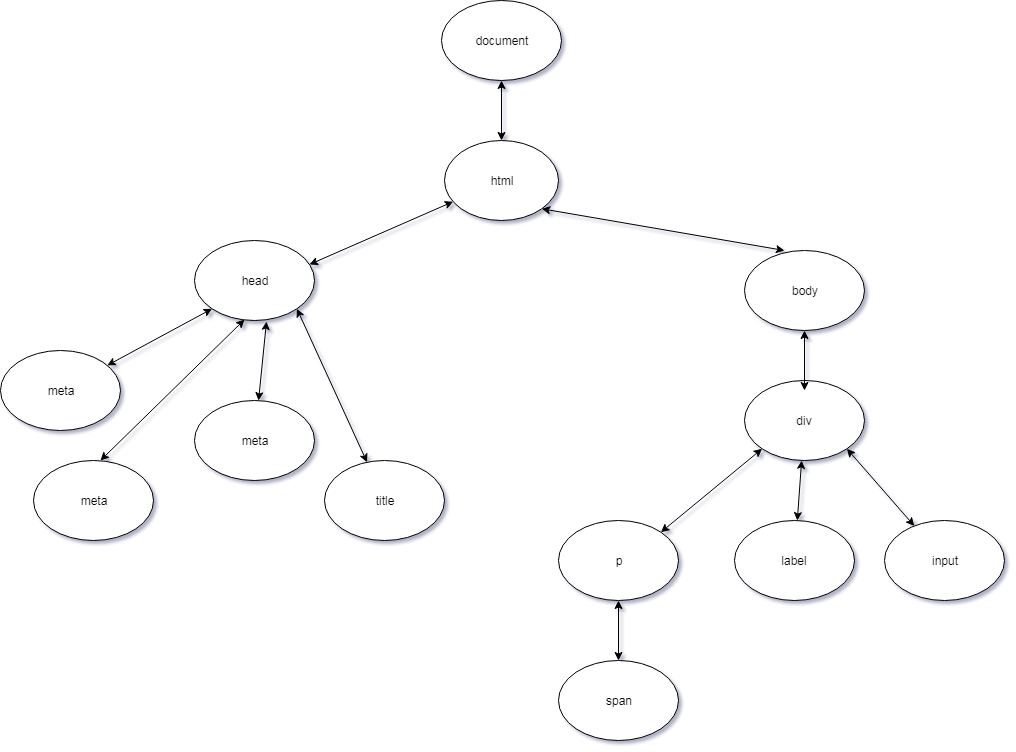 **JavaScript**中的`document`物件代表**DOM** 。它為我們提供了許多方法,我們可以用來選擇元素來更新元素內容等等。 ### 6.什麼是**事件傳播**? [↑](#the-questions "返回問題")當某個**事件**發生在**DOM**元素上時,該**事件**並非完全發生在該元素上。在**冒泡階段**,**事件**向上冒泡,或到達其父級、祖父母、祖父母的父級,直到一直到達`window` ,而在**捕獲階段**,事件從`window`開始向下到達觸發的元素事件或`<a href="#12-what-is-eventtarget-">event.target</a>` 。 **事件傳播**分為**三個**階段。 1. [捕獲階段](#8-whats-event-capturing)-事件從`window`開始,然後向下到達每個元素,直到到達目標元素。 2. [目標階段](#12-what-is-eventtarget-)– 事件已到達目標元素。 3. [冒泡階段](#7-whats-event-bubbling)-事件從目標元素冒起,然後向上移動到每個元素,直到到達`window` 。 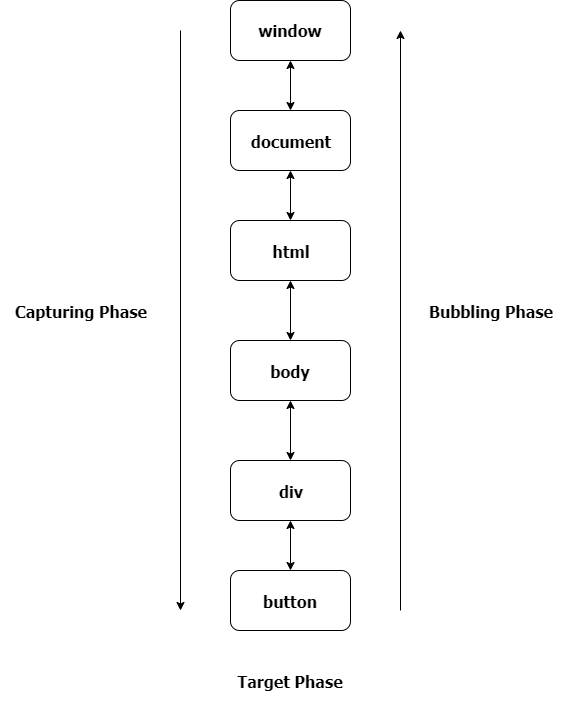 ### 7.什麼是**事件冒泡**? [↑](#the-questions "返回問題")當某個**事件**發生在**DOM**元素上時,該**事件**並非完全發生在該元素上。在**冒泡階段**,**事件**向上冒泡,或到達其父級、祖父母、祖父母的父級,直到一直到達`window` 。 如果我們有一個像這樣的範例標記。 ``` <div class="grandparent"> <div class="parent"> <div class="child">1</div> </div> </div> ``` 還有我們的js程式碼。 ``` function addEvent(el, event, callback, isCapture = false) { if (!el || !event || !callback || typeof callback !== 'function') return; if (typeof el === 'string') { el = document.querySelector(el); }; el.addEventListener(event, callback, isCapture); } addEvent(document, 'DOMContentLoaded', () => { const child = document.querySelector('.child'); const parent = document.querySelector('.parent'); const grandparent = document.querySelector('.grandparent'); addEvent(child, 'click', function (e) { console.log('child'); }); addEvent(parent, 'click', function (e) { console.log('parent'); }); addEvent(grandparent, 'click', function (e) { console.log('grandparent'); }); addEvent(document, 'click', function (e) { console.log('document'); }); addEvent('html', 'click', function (e) { console.log('html'); }) addEvent(window, 'click', function (e) { console.log('window'); }) }); ``` `addEventListener`方法有第三個可選參數**useCapture ,**預設值為`false`事件將在**冒泡階段**發生,如果為`true` ,事件將在**捕獲階段**發生。如果我們點擊`child`元素,它會分別在**控制台**上記錄`child` 、 `parent`元素、 `grandparent` 、 `html` 、 `document`和`window` 。這就是**事件冒泡**。 ### 8. 什麼是**事件擷取**? [↑](#the-questions "返回問題")當某個**事件**發生在**DOM**元素上時,該**事件**並非完全發生在該元素上。在**捕獲階段**,事件從`window`開始一直到觸發事件的元素。 如果我們有一個像這樣的範例標記。 ``` <div class="grandparent"> <div class="parent"> <div class="child">1</div> </div> </div> ``` 還有我們的js程式碼。 ``` function addEvent(el, event, callback, isCapture = false) { if (!el || !event || !callback || typeof callback !== 'function') return; if (typeof el === 'string') { el = document.querySelector(el); }; el.addEventListener(event, callback, isCapture); } addEvent(document, 'DOMContentLoaded', () => { const child = document.querySelector('.child'); const parent = document.querySelector('.parent'); const grandparent = document.querySelector('.grandparent'); addEvent(child, 'click', function (e) { console.log('child'); }, true); addEvent(parent, 'click', function (e) { console.log('parent'); }, true); addEvent(grandparent, 'click', function (e) { console.log('grandparent'); }, true); addEvent(document, 'click', function (e) { console.log('document'); }, true); addEvent('html', 'click', function (e) { console.log('html'); }, true) addEvent(window, 'click', function (e) { console.log('window'); }, true) }); ``` `addEventListener`方法有第三個可選參數**useCapture ,**預設值為`false`事件將在**冒泡階段**發生,如果為`true` ,事件將在**捕獲階段**發生。如果我們點擊`child`元素,它會分別在**控制台**上記錄`window` 、 `document` 、 `html` 、 `grandparent` 、 `parent`和`child` 。這就是**事件捕獲**。 ### 9. `event.preventDefault()`和`event.stopPropagation()`方法有什麼差別? [↑](#the-questions "返回問題") `event.preventDefault()`方法**阻止**元素的預設行為。如果在`form`元素中使用,它**會阻止**其提交。如果在`anchor`元素中使用,它**會阻止**其導航。如果在`contextmenu`中使用,它**會阻止**其顯示或顯示。而`event.stopPropagation()`方法會停止事件的傳播或停止事件在[冒泡](#7-whats-event-bubbling)或[捕獲](#8-whats-event-capturing)階段發生。 ### 10. 如何知道元素中是否使用了`event.preventDefault()`方法? [↑](#the-questions "返回問題")我們可以使用事件物件中的`event.defaultPrevented`屬性。它傳回一個`boolean` ,指示是否在特定元素中呼叫了`event.preventDefault()` 。 ### 11. 為什麼這段程式碼`obj.someprop.x`會拋出錯誤? ``` const obj = {}; console.log(obj.someprop.x); ``` [^](#the-questions "返回問題")顯然,由於我們嘗試存取 a 的原因,這會引發錯誤 `someprop`屬性中的`x`屬性具有`undefined`值。請記住,物件中的**屬性**本身並不存在,且其**原型**具有預設值`undefined`且`undefined`沒有屬性`x` 。 ### 12.什麼是**event.target** ? [↑](#the-questions "返回問題")最簡單來說, **event.target**是**發生**事件的元素或**觸發**事件的元素。 HTML 標記範例。 ``` <div onclick="clickFunc(event)" style="text-align: center;margin:15px; border:1px solid red;border-radius:3px;"> <div style="margin: 25px; border:1px solid royalblue;border-radius:3px;"> <div style="margin:25px;border:1px solid skyblue;border-radius:3px;"> <button style="margin:10px"> Button </button> </div> </div> </div> ``` JavaScript 範例。 ``` function clickFunc(event) { console.log(event.target); } ``` 如果您單擊按鈕,它會記錄**按鈕**標記,即使我們將事件附加在最外部的`div`上,它也會始終記錄**按鈕**,因此我們可以得出結論, **event.target**是觸發事件的元素。 ### 13.什麼是**event.currentTarget** ? [↑](#the-questions "返回問題") **event.currentTarget**是我們**明確**附加事件處理程序的元素。 複製**問題 12**中的標記。 HTML 標記範例。 ``` <div onclick="clickFunc(event)" style="text-align: center;margin:15px; border:1px solid red;border-radius:3px;"> <div style="margin: 25px; border:1px solid royalblue;border-radius:3px;"> <div style="margin:25px;border:1px solid skyblue;border-radius:3px;"> <button style="margin:10px"> Button </button> </div> </div> </div> ``` 並且稍微改變我們的**JS** 。 ``` function clickFunc(event) { console.log(event.currentTarget); } ``` 如果您按一下該按鈕,即使我們按一下該按鈕,它也會記錄最外層的**div**標記。在此範例中,我們可以得出結論, **event.currentTarget**是我們附加事件處理程序的元素。 ### 14. `==`和`===`有什麼差別? [^](#the-questions "返回問題") `==` \_\_(抽象相等)\_\_ 和`===` \_\_(嚴格相等)\_\_ 之間的區別在於`==`在*強制轉換*後按**值**進行比較,而`===`在不進行*強制轉換的*情況下按**值**和**類型**進行比較。 讓我們更深入地研究`==` 。那麼首先我們來談談*強制*。 *強制轉換*是將一個值轉換為另一種類型的過程。在本例中, `==`進行*隱式強制轉換*。在比較兩個值之前, `==`需要執行一些條件。 假設我們必須比較`x == y`值。 1. 如果`x`和`y`具有相同的類型。 然後將它們與`===`運算子進行比較。 2. 如果`x`為`null`且`y` `undefined` ,則傳回`true` 。 3. 如果`x` `undefined`且`y`為`null`則傳回`true` 。 4. 如果`x`是`number`類型, `y`是`string`類型 然後回傳`x == toNumber(y)` 。 5. 如果`x`是`string`類型, `y`是`number`類型 然後返回`toNumber(x) == y` 。 6. 如果`x`是`boolean`類型 然後返回`toNumber(x) == y` 。 7. 如果`y`是`boolean`類型 然後回傳`x == toNumber(y)` 。 8. 如果`x`是`string` 、 `symbol`或`number`且`y`是 type `object` 然後回傳`x == toPrimitive(y)` 。 9. 如果`x`是`object`且`x`是`string` 、 `symbol` 然後返回`toPrimitive(x) == y` 。 10. 返回`false` 。 **注意:** `toPrimitive`首先使用物件中的`valueOf`方法,然後使用`toString`方法來取得該物件的原始值。 讓我們舉個例子。 | `x` | `y` | `x == y` | | ------------- |:-------------:| ----------------: | | `5` | `5` | `true` | | `1` | `'1'` | `true` | | `null` | `undefined` | `true` | | `0` | `false` | `true` | | `'1,2'` | `[1,2]` | `true` | | `'[object Object]'` | `{}` | `true` | 這些範例都傳回`true` 。 **第一個範例**屬於**條件一**,因為`x`和`y`具有相同的類型和值。 **第二個範例**轉到**條件四,**在比較之前將`y`轉換為`number` 。 **第三個例子**涉及**條件二**。 **第四個範例**轉到**條件七,**因為`y`是`boolean` 。 **第五個範例**適用於**條件八**。使用`toString()`方法將陣列轉換為`string` ,該方法傳回`1,2` 。 **最後一個例子**適用於**條件十**。使用傳回`[object Object]`的`toString()`方法將該物件轉換為`string` 。 | `x` | `y` | `x === y` | | ------------- |:-------------:| ----------------: | | `5` | `5` | `true` | | `1` | `'1'` | `false` | | `null` | `undefined` | `false` | | `0` | `false` | `false` | | `'1,2'` | `[1,2]` | `false` | | `'[object Object]'` | `{}` | `false` | 如果我們使用`===`運算符,則除第一個範例之外的所有比較都將傳回`false` ,因為它們不具有相同的類型,而第一個範例將傳回`true` ,因為兩者俱有相同的類型和值。 ### 15. 為什麼在 JavaScript 中比較兩個相似的物件時回傳**false** ? [^](#the-questions "返回問題")假設我們有下面的例子。 ``` let a = { a: 1 }; let b = { a: 1 }; let c = a; console.log(a === b); // logs false even though they have the same property console.log(a === c); // logs true hmm ``` **JavaScript**以不同的方式比較*物件*和*基元*。在*基元*中,它透過**值**來比較它們,而在*物件*中,它透過**引用**或**儲存變數的記憶體位址**來比較它們。這就是為什麼第一個`console.log`語句回傳`false`而第二個`console.log`語句回傳`true`的原因。 `a`和`c`有相同的引用,而`a`和`b`則不同。 ### 16. **!!**是什麼意思?運營商做什麼? [↑](#the-questions "返回問題")**雙非**運算子或**!!**將右側的值強制轉換為布林值。基本上,這是一種將值轉換為布林值的奇特方法。 ``` console.log(!!null); //logs false console.log(!!undefined); //logs false console.log(!!''); //logs false console.log(!!0); //logs false console.log(!!NaN); //logs false console.log(!!' '); //logs true console.log(!!{}); //logs true console.log(!![]); //logs true console.log(!!1); //logs true console.log(!![].length); //logs false ``` ### 17. 如何計算一行中的多個表達式? [↑](#the-questions "返回問題")我們可以使用`,`或逗號運算子來計算一行中的多個表達式。它從左到右計算並傳回右側最後一項或最後一個操作數的值。 ``` let x = 5; x = (x++ , x = addFive(x), x *= 2, x -= 5, x += 10); function addFive(num) { return num + 5; } ``` 如果記錄`x`的值,它將是**27** 。首先,我們**增加**x 的值,它將是**6** ,然後我們呼叫函數`addFive(6)`並將 6 作為參數傳遞,並將結果分配給`x` , `x`的新值將是**11** 。之後,我們將`x`的當前值乘以**2**並將其分配給`x` , `x`的更新值將是**22** 。然後,我們將`x`的當前值減去 5 並將結果指派給`x` ,更新後的值將是**17** 。最後,我們將`x`的值增加 10 並將更新後的值指派給`x` ,現在`x`的值將是**27** 。 ### 18.什麼是**吊裝**? [^](#the-questions "返回問題")**提升**是一個術語,用於描述將*變數*和*函數*移動到其*(全域或函數)*作用域的頂部(即我們定義該變數或函數的位置)。 要理解**提升**,我必須解釋*執行上下文*。 **執行上下文**是目前正在執行的「程式碼環境」。**執行上下文**有兩個階段*:編譯*和*執行*。 **編譯**- 在此階段,它獲取所有*函數聲明*並將它們*提升*到作用域的頂部,以便我們稍後可以引用它們並獲取所有*變數聲明***(使用 var 關鍵字聲明)** ,並將它們*提升*並給它們一個默認值*未定義*的 . **執行**- 在此階段,它將值指派給先前*提升的*變數,並*執行*或*呼叫*函數**(物件中的方法)** 。 **注意:**只有使用*var*關鍵字宣告的**函數宣告**和變數才會*被提升*,而不是**函數表達式**或**箭頭函數**、 `let`和`const`關鍵字。 好吧,假設我們在下面的*全域範圍*內有一個範例程式碼。 ``` console.log(y); y = 1; console.log(y); console.log(greet("Mark")); function greet(name){ return 'Hello ' + name + '!'; } var y; ``` 此程式碼記錄`undefined` , `1` , `Hello Mark!`分別。 所以*編譯*階段看起來像這樣。 ``` function greet(name) { return 'Hello ' + name + '!'; } var y; //implicit "undefined" assignment //waiting for "compilation" phase to finish //then start "execution" phase /* console.log(y); y = 1; console.log(y); console.log(greet("Mark")); */ ``` 出於範例目的,我對變數和*函數呼叫*的*賦值*進行了評論。 *編譯*階段完成後,它開始*執行*階段,呼叫方法並向變數賦值。 ``` function greet(name) { return 'Hello ' + name + '!'; } var y; //start "execution" phase console.log(y); y = 1; console.log(y); console.log(greet("Mark")); ``` ### 19.什麼是**範圍**? [↑](#the-questions "返回問題") JavaScript 中的**作用域**是我們可以有效存取變數或函數的**區域**。 JavaScript 有三種類型的作用域。**全域作用域**、**函數作用域**和**區塊作用域(ES6)** 。 - **全域作用域**- 在全域命名空間中宣告的變數或函數位於全域作用域中,因此可以在程式碼中的任何位置存取。 ``` //global namespace var g = "global"; function globalFunc(){ function innerFunc(){ console.log(g); // can access "g" because "g" is a global variable } innerFunc(); } ``` - **函數作用域**- 函數內聲明的變數、函數和參數可以在該函數內部存取,但不能在函數外部存取。 ``` function myFavoriteFunc(a) { if (true) { var b = "Hello " + a; } return b; } myFavoriteFunc("World"); console.log(a); // Throws a ReferenceError "a" is not defined console.log(b); // does not continue here ``` - **區塊作用域**- 在區塊`{}`內宣告的變數**( `let` 、 `const` )**只能在區塊內存取。 ``` function testBlock(){ if(true){ let z = 5; } return z; } testBlock(); // Throws a ReferenceError "z" is not defined ``` **範圍**也是一組查找變數的規則。如果一個變數在**當前作用域中**不存在,它會在**外部作用域中查找**並蒐索該變數,如果不存在,它會再次**查找,**直到到達**全域作用域。**如果該變數存在,那麼我們可以使用它,如果不存在,我們可以使用它來拋出錯誤。它搜尋**最近的**變數,一旦找到它就停止**搜尋**或**尋找**。這稱為**作用域鏈**。 ``` /* Scope Chain Inside inner function perspective inner's scope -> outer's scope -> global's scope */ //Global Scope var variable1 = "Comrades"; var variable2 = "Sayonara"; function outer(){ //outer's scope var variable1 = "World"; function inner(){ //inner's scope var variable2 = "Hello"; console.log(variable2 + " " + variable1); } inner(); } outer(); // logs Hello World // because (variable2 = "Hello") and (variable1 = "World") are the nearest // variables inside inner's scope. ``` 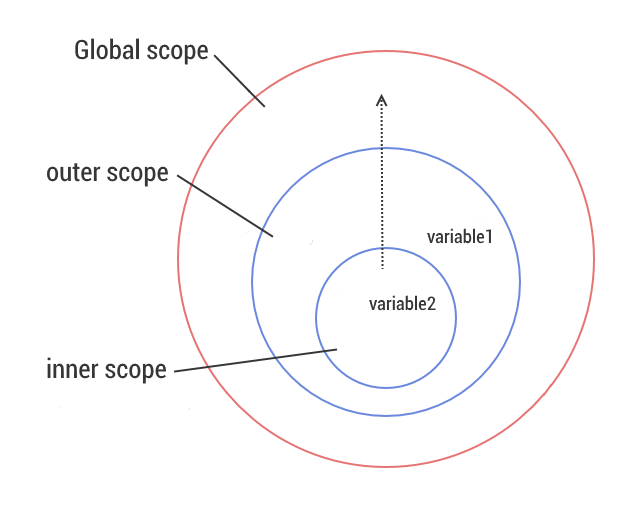 ### 20.什麼是**閉包**? [^](#the-questions "返回問題")這可能是所有這些問題中最難的問題,因為**閉包**是一個有爭議的話題。那我就從我的理解來解釋。 **閉包**只是函數在宣告時記住其當前作用域、其父函數作用域、其父函數的父函數作用域上的變數和參數的引用的能力,直到在**作用域鏈**的幫助下到達全域作用域。基本上它是聲明函數時建立的**作用域**。 例子是解釋閉包的好方法。 ``` //Global's Scope var globalVar = "abc"; function a(){ //testClosures's Scope console.log(globalVar); } a(); //logs "abc" /* Scope Chain Inside a function perspective a's scope -> global's scope */ ``` 在此範例中,當我們宣告`a`函數時**,全域**作用域是`a's`*閉包*的一部分。 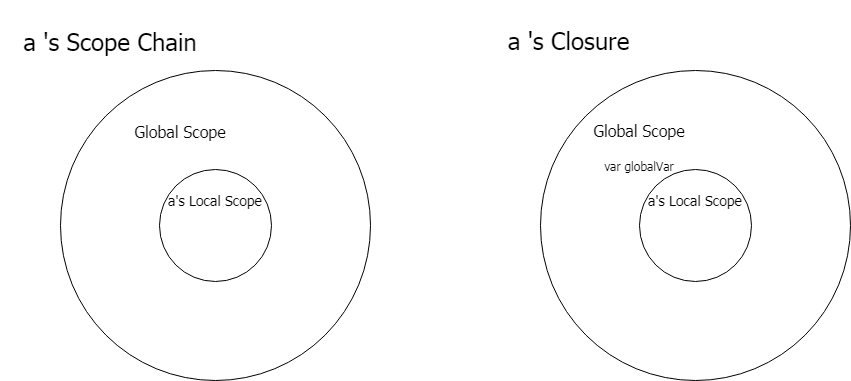 變數`globalVar`在影像中沒有值的原因是該變數的值可以根據我們呼叫`a`**位置**和**時間**而改變。 但在上面的範例中, `globalVar`變數的值為**abc** 。 好吧,讓我們來看一個複雜的例子。 ``` var globalVar = "global"; var outerVar = "outer" function outerFunc(outerParam) { function innerFunc(innerParam) { console.log(globalVar, outerParam, innerParam); } return innerFunc; } const x = outerFunc(outerVar); outerVar = "outer-2"; globalVar = "guess" x("inner"); ``` 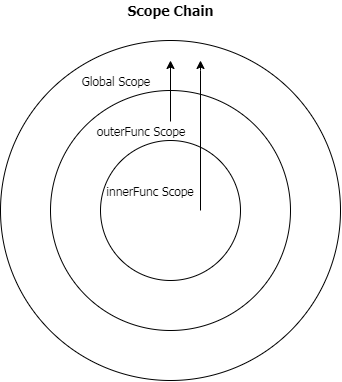 這將列印“猜測外部內部”。對此的解釋是,當我們呼叫`outerFunc`函數並將`innerFunc`函數的回傳值指派給變數`x`時,即使我們將新值**outer-2**指派給`outerVar`變數, `outerParam`也會具有**outer**值,因為 重新分配發生在呼叫`outer`函數之後,當我們呼叫`outerFunc`函數時,它會在**作用域鏈**中尋找`outerVar`的值,而`outerVar`的值為**「outer」** 。現在,當我們呼叫引用了`innerFunc`的`x`變數時, `innerParam`的值為**inner,**因為這是我們在呼叫中傳遞的值,而`globalVar`變數的值為**猜測**,因為在呼叫`x`變數之前,我們為`globalVar`分配了一個新值,並且在呼叫`x`時**作用域鏈**中`globalVar`的值是**猜測**。 我們有一個例子來示範沒有正確理解閉包的問題。 ``` const arrFuncs = []; for(var i = 0; i < 5; i++){ arrFuncs.push(function (){ return i; }); } console.log(i); // i is 5 for (let i = 0; i < arrFuncs.length; i++) { console.log(arrFuncs[i]()); // all logs "5" } ``` 由於**Closures**的原因,此程式碼無法按我們的預期工作。 `var`關鍵字建立一個全域變數,當我們推送一個函數時 我們返回全域變數`i` 。因此,當我們在循環之後呼叫該陣列中的其中一個函數時,它會記錄`5` ,因為我們得到 `i`的目前值為`5` ,我們可以存取它,因為它是全域變數。因為**閉包**保留該變數的**引用,**而不是其建立時的**值**。我們可以使用**IIFES**或將`var`關鍵字變更為`let`來解決此問題,以實現區塊作用域。 ### 21. **JavaScript**中的**假**值是什麼? [↑](#the-questions "返回問題") ``` const falsyValues = ['', 0, null, undefined, NaN, false]; ``` **假**值是轉換為布林值時變成**false 的**值。 ### 22. 如何檢查一個值是否為**假值**? [↑](#the-questions "返回問題")使用**布林**函數或雙非運算符**[!!](#16-what-does-the-operator-do)** ### 23. `"use strict"`有什麼作用? [^](#the-questions "返回問題") `"use strict"`是**JavaScript**中的 ES5 功能,它使我們的程式碼在*函數*或*整個腳本*中處於**嚴格模式**。**嚴格模式**幫助我們避免程式碼早期出現**錯誤**並為其加入限制。 **嚴格模式**給我們的限制。 - 分配或存取未宣告的變數。 ``` function returnY(){ "use strict"; y = 123; return y; } ``` - 為唯讀或不可寫的全域變數賦值; ``` "use strict"; var NaN = NaN; var undefined = undefined; var Infinity = "and beyond"; ``` - 刪除不可刪除的屬性。 ``` "use strict"; const obj = {}; Object.defineProperty(obj, 'x', { value : '1' }); delete obj.x; ``` - 參數名稱重複。 ``` "use strict"; function someFunc(a, b, b, c){ } ``` - 使用**eval**函數建立變數。 ``` "use strict"; eval("var x = 1;"); console.log(x); //Throws a Reference Error x is not defined ``` - **該**值的預設值是`undefined` 。 ``` "use strict"; function showMeThis(){ return this; } showMeThis(); //returns undefined ``` **嚴格模式**的限制遠不止這些。 ### 24. JavaScript 中`this`的值是什麼? [↑](#the-questions "返回問題")基本上, `this`是指目前正在執行或呼叫函數的物件的值。我說**目前**是因為**它**的值會根據我們使用它的上下文和使用它的位置而改變。 ``` const carDetails = { name: "Ford Mustang", yearBought: 2005, getName(){ return this.name; }, isRegistered: true }; console.log(carDetails.getName()); // logs Ford Mustang ``` 這是我們通常所期望的,因為在**getName**方法中我們傳回`this.name` ,在此上下文中`this`指的是`carDetails`物件,該物件目前是正在執行的函數的「擁有者」物件。 好吧,讓我們加入一些程式碼讓它變得奇怪。在`console.log`語句下面加入這三行程式碼 ``` var name = "Ford Ranger"; var getCarName = carDetails.getName; console.log(getCarName()); // logs Ford Ranger ``` 第二個`console.log`語句印製了**「Ford Ranger」**一詞,這很奇怪,因為在我們的第一個`console.log`語句中它印了**「Ford Mustang」** 。原因是`getCarName`方法有一個不同的「擁有者」物件,即`window`物件。在全域作用域中使用`var`關鍵字聲明變數會在`window`物件中附加與變數同名的屬性。請記住,當未使用`"use strict"`時,全域範圍內的`this`指的是`window`物件。 ``` console.log(getCarName === window.getCarName); //logs true console.log(getCarName === this.getCarName); // logs true ``` 本例中的`this`和`window`指的是同一個物件。 解決此問題的一種方法是使用函數中的`<a href="#27-what-is-the-use-functionprototypeapply-method">apply</a>`和`<a href="#28-what-is-the-use-functionprototypecall-method">call</a>`方法。 ``` console.log(getCarName.apply(carDetails)); //logs Ford Mustang console.log(getCarName.call(carDetails)); //logs Ford Mustang ``` `apply`和`call`方法期望第一個參數是一個物件,該物件將是該函數內`this`的值。 **IIFE** (即**立即呼叫函數表達式)** 、在全域作用域中宣告的函數、物件內部方法中的**匿名函數**和內部函數都有一個指向**window**物件的預設**值**。 ``` (function (){ console.log(this); })(); //logs the "window" object function iHateThis(){ console.log(this); } iHateThis(); //logs the "window" object const myFavoriteObj = { guessThis(){ function getThis(){ console.log(this); } getThis(); }, name: 'Marko Polo', thisIsAnnoying(callback){ callback(); } }; myFavoriteObj.guessThis(); //logs the "window" object myFavoriteObj.thisIsAnnoying(function (){ console.log(this); //logs the "window" object }); ``` 如果我們想要取得`myFavoriteObj`物件中的`name`屬性**(Marko Polo)**的值,有兩種方法可以解決這個問題。 首先,我們將`this`的值保存在變數中。 ``` const myFavoriteObj = { guessThis(){ const self = this; //saves the this value to the "self" variable function getName(){ console.log(self.name); } getName(); }, name: 'Marko Polo', thisIsAnnoying(callback){ callback(); } }; ``` 在此圖像中,我們保存`this`的值,該值將是`myFavoriteObj`物件。所以我們可以在`getName`內部函數中存取它。 其次,我們使用**ES6[箭頭函數](#43-what-are-arrow-functions)**。 ``` const myFavoriteObj = { guessThis(){ const getName = () => { //copies the value of "this" outside of this arrow function console.log(this.name); } getName(); }, name: 'Marko Polo', thisIsAnnoying(callback){ callback(); } }; ``` [箭頭函數](#43-what-are-arrow-functions)沒有自己的`this` 。它複製封閉詞法範圍的`this`值,或複製`getName`內部函數外部的`this`值(即`myFavoriteObj`物件)。我們也可以根據[函數的呼叫方式](#66-how-many-ways-can-a-function-be-invoked)來決定`this`的值。 ### 25. 物件的`prototype`是什麼? [↑](#the-questions "返回問題")最簡單的`prototype`是一個物件的*藍圖*。如果目前物件中確實存在它,則將其用作**屬性**和**方法**的後備。這是在物件之間共享屬性和功能的方式。這是 JavaScript**原型繼承**的核心概念。 ``` const o = {}; console.log(o.toString()); // logs [object Object] ``` 即使`o.toString`方法不存在於`o`物件中,它也不會拋出錯誤,而是傳回字串`[object Object]` 。當物件中不存在屬性時,它會尋找其**原型**,如果仍然不存在,則會尋找**原型的原型**,依此類推,直到在**原型鏈**中找到具有相同屬性的屬性。**原型鏈**的末尾在**Object.prototype**之後為`null` 。 ``` console.log(o.toString === Object.prototype.toString); // logs true // which means we we're looking up the Prototype Chain and it reached // the Object.prototype and used the "toString" method. ``` ### 26. 什麼是**IIFE** ,它有什麼用? [^](#the-questions "返回問題") **IIFE**或**立即呼叫函數表達式**是在建立或宣告後將被呼叫或執行的函數。建立**IIFE**的語法是,我們將`function (){}`包裝在括號`()`或**分組運算**子內,以將函數視為表達式,然後用另一個括號`()`呼叫它。所以**IIFE**看起來像這樣`(function(){})()` 。 ``` (function () { }()); (function () { })(); (function named(params) { })(); (() => { })(); (function (global) { })(window); const utility = (function () { return { //utilities }; })(); ``` 這些範例都是有效的**IIFE** 。倒數第二個範例顯示我們可以將參數傳遞給**IIFE**函數。最後一個範例表明我們可以將**IIFE**的結果保存到變數中,以便稍後引用它。 **IIFE**的最佳用途是進行初始化設定功能,並避免與全域範圍內的其他變數**發生命名衝突**或污染全域名稱空間。讓我們舉個例子。 ``` <script src="https://cdnurl.com/somelibrary.js"></script> ``` 假設我們有一個指向庫`somelibrary.js`的連結,該庫公開了我們可以在程式碼中使用的一些全域函數,但該庫有兩個我們不使用`createGraph`和`drawGraph`方法,因為這些方法中有錯誤。我們想要實作我們自己的`createGraph`和`drawGraph`方法。 - 解決這個問題的一種方法是改變腳本的結構。 ``` <script src="https://cdnurl.com/somelibrary.js"></script> <script> function createGraph() { // createGraph logic here } function drawGraph() { // drawGraph logic here } </script> ``` 當我們使用這個解決方案時,我們將覆蓋庫為我們提供的這兩種方法。 - 解決這個問題的另一種方法是更改我們自己的輔助函數的名稱。 ``` <script src="https://cdnurl.com/somelibrary.js"></script> <script> function myCreateGraph() { // createGraph logic here } function myDrawGraph() { // drawGraph logic here } </script> ``` 當我們使用此解決方案時,我們還將這些函數呼叫更改為新函數名稱。 - 另一種方法是使用**IIFE** 。 ``` <script src="https://cdnurl.com/somelibrary.js"></script> <script> const graphUtility = (function () { function createGraph() { // createGraph logic here } function drawGraph() { // drawGraph logic here } return { createGraph, drawGraph } })(); </script> ``` 在此解決方案中,我們建立一個實用程式變數,它是**IIFE**的結果,它傳回一個包含`createGraph`和`drawGraph`兩個方法的物件。 **IIFE**解決的另一個問題就是這個例子。 ``` var li = document.querySelectorAll('.list-group > li'); for (var i = 0, len = li.length; i < len; i++) { li[i].addEventListener('click', function (e) { console.log(i); }) } ``` 假設我們有一個`ul`元素,其類別為**list-group** ,並且它有 5 個`li`子元素。當我們**點擊**單一`li`元素時,我們希望`console.log` `i`的值。 但我們想要的程式碼中的行為不起作用。相反,它會在對`li`元素的任何**點擊**中記錄`5` 。我們遇到的問題是由於**閉包的**工作方式造成的。**閉包**只是函數記住其當前作用域、其父函數作用域和全域作用域中的變數引用的能力。當我們在全域範圍內使用`var`關鍵字聲明變數時,顯然我們正在建立一個全域變數`i` 。因此,當我們單擊`li`元素時,它會記錄**5** ,因為這是我們稍後在回調函數中引用它時的`i`值。 - 解決這個問題的一種方法是**IIFE** 。 ``` var li = document.querySelectorAll('.list-group > li'); for (var i = 0, len = li.length; i < len; i++) { (function (currentIndex) { li[currentIndex].addEventListener('click', function (e) { console.log(currentIndex); }) })(i); } ``` 這個解決方案之所以有效,是因為**IIFE**為每次迭代建立一個新範圍,並且我們捕獲`i`的值並將其傳遞到`currentIndex`參數中,因此當我們呼叫**IIFE**時,每次迭代的`currentIndex`值都是不同的。 ### 27. `Function.prototype.apply`方法有什麼用? [^](#the-questions "返回問題") `apply`呼叫一個函數,在呼叫時指定`this`或該函數的「所有者」物件。 ``` const details = { message: 'Hello World!' }; function getMessage(){ return this.message; } getMessage.apply(details); // returns 'Hello World!' ``` 這個方法的工作方式類似於`<a href="#28-what-is-the-use-functionprototypecall-method">Function.prototype.call</a>`唯一的差異是我們傳遞參數的方式。在`apply`中,我們將參數作為陣列傳遞。 ``` const person = { name: "Marko Polo" }; function greeting(greetingMessage) { return `${greetingMessage} ${this.name}`; } greeting.apply(person, ['Hello']); // returns "Hello Marko Polo!" ``` ### 28. `Function.prototype.call`方法有什麼用? [^](#the-questions "返回問題")此`call`呼叫一個函數,指定呼叫時該函數的`this`或「擁有者」物件。 ``` const details = { message: 'Hello World!' }; function getMessage(){ return this.message; } getMessage.call(details); // returns 'Hello World!' ``` 這個方法的工作方式類似於`<a href="#27-what-is-the-use-functionprototypeapply-method">Function.prototype.apply</a>`唯一的差異是我們傳遞參數的方式。在`call`中,我們直接傳遞參數,對於每個參數`,`用逗號分隔它們。 ``` const person = { name: "Marko Polo" }; function greeting(greetingMessage) { return `${greetingMessage} ${this.name}`; } greeting.call(person, 'Hello'); // returns "Hello Marko Polo!" ``` ### 29. `Function.prototype.apply`和`Function.prototype.call`有什麼差別? [↑](#the-questions "返回問題") `apply`和`call`之間的唯一區別是我們如何在被呼叫的函數中傳遞**參數**。在`apply`中,我們將參數作為**陣列**傳遞,而在`call`中,我們直接在參數列表中傳遞參數。 ``` const obj1 = { result:0 }; const obj2 = { result:0 }; function reduceAdd(){ let result = 0; for(let i = 0, len = arguments.length; i < len; i++){ result += arguments[i]; } this.result = result; } reduceAdd.apply(obj1, [1, 2, 3, 4, 5]); // returns 15 reduceAdd.call(obj2, 1, 2, 3, 4, 5); // returns 15 ``` ### 30. `Function.prototype.bind`的用法是什麼? [↑](#the-questions "返回問題") `bind`方法傳回一個新*綁定的*函數 到特定的`this`值或“所有者”物件,因此我們可以稍後在程式碼中使用它。 `call` 、 `apply`方法立即呼叫函數,而不是像`bind`方法那樣傳回一個新函數。 ``` import React from 'react'; class MyComponent extends React.Component { constructor(props){ super(props); this.state = { value : "" } this.handleChange = this.handleChange.bind(this); // Binds the "handleChange" method to the "MyComponent" component } handleChange(e){ //do something amazing here } render(){ return ( <> <input type={this.props.type} value={this.state.value} onChange={this.handleChange} /> </> ) } } ``` ### 31.什麼是**函數式程式設計**? **JavaScript**的哪些特性使其成為**函數式語言**的候選者? [^](#the-questions "返回問題")**函數式程式設計**是一種**聲明式**程式設計範式或模式,它介紹如何**使用表達式來**計算值而不改變傳遞給它的參數的函數來建立應用程式。 JavaScript**陣列**具有**map** 、 **filter** 、 **reduce**方法,這些方法是函數式程式設計世界中最著名的函數,因為它們非常有用,而且它們不會改變或改變陣列,這使得這些函數變得**純粹**,並且JavaScript 支援**閉包**和**高階函數**,它們是**函數式程式語言**的一個特徵。 - **map**方法建立一個新陣列,其中包含對陣列中每個元素呼叫提供的回調函數的結果。 ``` const words = ["Functional", "Procedural", "Object-Oriented"]; const wordsLength = words.map(word => word.length); ``` - **filter**方法會建立一個新陣列,其中包含透過回調函數中測試的所有元素。 ``` const data = [ { name: 'Mark', isRegistered: true }, { name: 'Mary', isRegistered: false }, { name: 'Mae', isRegistered: true } ]; const registeredUsers = data.filter(user => user.isRegistered); ``` - **reduce**方法對累加器和陣列中的每個元素(從左到右)套用函數,將其減少為單一值。 ``` const strs = ["I", " ", "am", " ", "Iron", " ", "Man"]; const result = strs.reduce((acc, currentStr) => acc + currentStr, ""); ``` ### 32.什麼是**高階函數**? [^](#the-questions "返回問題")**高階函數**是可以傳回函數或接收具有函數值的一個或多個參數的函數。 ``` function higherOrderFunction(param,callback){ return callback(param); } ``` ### 33.為什麼函數被稱為**First-class Objects** ? [^](#the-questions "返回問題") JavaScript 中的 \_\_Functions\_\_ 是**一流物件**,因為它們被視為該語言中的任何其他值。它們可以分配給**變數**,可以是稱為**方法的物件的屬性**,可以是**陣列中的專案**,可以**作為參數傳遞給函數**,也可以**作為函數的值返回**。函數與**JavaScript**中任何其他值之間的唯一區別是**函數**可以被呼叫。 ### 34. 手動實作`Array.prototype.map`方法。 [↑](#the-questions "返回問題") ``` function map(arr, mapCallback) { // First, we check if the parameters passed are right. if (!Array.isArray(arr) || !arr.length || typeof mapCallback !== 'function') { return []; } else { let result = []; // We're making a results array every time we call this function // because we don't want to mutate the original array. for (let i = 0, len = arr.length; i < len; i++) { result.push(mapCallback(arr[i], i, arr)); // push the result of the mapCallback in the 'result' array } return result; // return the result array } } ``` 正如`Array.prototype.map`方法的MDN描述。 **map() 方法建立一個新陣列,其中包含對呼叫陣列中的每個元素呼叫所提供函數的結果。** ### 35. 手動實作`Array.prototype.filter`方法。 [↑](#the-questions "返回問題") ``` function filter(arr, filterCallback) { // First, we check if the parameters passed are right. if (!Array.isArray(arr) || !arr.length || typeof filterCallback !== 'function') { return []; } else { let result = []; // We're making a results array every time we call this function // because we don't want to mutate the original array. for (let i = 0, len = arr.length; i < len; i++) { // check if the return value of the filterCallback is true or "truthy" if (filterCallback(arr[i], i, arr)) { // push the current item in the 'result' array if the condition is true result.push(arr[i]); } } return result; // return the result array } } ``` 正如`Array.prototype.filter`方法的 MDN 描述。 **filter() 方法建立一個新陣列,其中包含透過所提供函數實現的測試的所有元素。** ### 36. 手動實作`Array.prototype.reduce`方法。 [↑](#the-questions "返回問題") ``js 函數reduce(arr,reduceCallback,initialValue){ // 首先,我們檢查傳遞的參數是否正確。 if (!Array.isArray(arr) || !arr.length || typeof reduceCallback !== 'function') { ``` return []; ``` } 別的 { ``` // If no initialValue has been passed to the function we're gonna use the ``` ``` let hasInitialValue = initialValue !== undefined; ``` ``` let value = hasInitialValue ? initialValue : arr[0]; ``` ``` // first array item as the initialValue ``` ``` // Then we're gonna start looping at index 1 if there is no ``` ``` // initialValue has been passed to the function else we start at 0 if ``` ``` // there is an initialValue. ``` ``` for (let i = hasInitialValue ? 0 : 1, len = arr.length; i < len; i++) { ``` ``` // Then for every iteration we assign the result of the ``` ``` // reduceCallback to the variable value. ``` ``` value = reduceCallback(value, arr[i], i, arr); ``` ``` } ``` ``` return value; ``` } } ``` As the MDN description of the <code>Array.prototype.reduce</code> method. __The reduce() method executes a reducer function (that you provide) on each element of the array, resulting in a single output value.__ ###37. What is the __arguments__ object? [↑](#the-questions "Back To Questions") The __arguments__ object is a collection of parameter values pass in a function. It's an __Array-like__ object because it has a __length__ property and we can access individual values using array indexing notation <code>arguments[1]</code> but it does not have the built-in methods in an array <code>forEach</code>,<code>reduce</code>,<code>filter</code> and <code>map</code>. It helps us know the number of arguments pass in a function. We can convert the <code>arguments</code> object into an array using the <code>Array.prototype.slice</code>. ``` 函數一(){ 返回 Array.prototype.slice.call(參數); } ``` Note: __the <code>arguments</code> object does not work on ES6 arrow functions.__ ``` 函數一(){ 返回參數; } 常數二 = 函數 () { 返回參數; } 常量三 = 函數三() { 返回參數; } const 四 = () => 參數; 四(); // 拋出錯誤 - 參數未定義 ``` When we invoke the function <code>four</code> it throws a <code>ReferenceError: arguments is not defined</code> error. We can solve this problem if your enviroment supports the __rest syntax__. ``` const 四 = (...args) => args; ``` This puts all parameter values in an array automatically. ###38. How to create an object without a __prototype__? [↑](#the-questions "Back To Questions") We can create an object without a _prototype_ using the <code>Object.create</code> method. ``` 常數 o1 = {}; console.log(o1.toString()); // Logs \[object Object\] 取得此方法到Object.prototype const o2 = Object.create(null); // 第一個參數是物件「o2」的原型,在此 // case 將為 null 指定我們不需要任何原型 console.log(o2.toString()); // 拋出錯誤 o2.toString 不是函數 ``` ###39. Why does <code>b</code> in this code become a global variable when you call this function? [↑](#the-questions "Back To Questions") ``` 函數 myFunc() { 令a = b = 0; } myFunc(); ``` The reason for this is that __assignment operator__ or __=__ has right-to-left __associativity__ or __evaluation__. What this means is that when multiple assignment operators appear in a single expression they evaluated from right to left. So our code becomes likes this. ``` 函數 myFunc() { 令 a = (b = 0); } myFunc(); ``` First, the expression <code>b = 0</code> evaluated and in this example <code>b</code> is not declared. So, The JS Engine makes a global variable <code>b</code> outside this function after that the return value of the expression <code>b = 0</code> would be 0 and it's assigned to the new local variable <code>a</code> with a <code>let</code> keyword. We can solve this problem by declaring the variables first before assigning them with value. ``` 函數 myFunc() { 令 a,b; a = b = 0; } myFunc(); ``` ###40. <div id="ecmascript">What is __ECMAScript__</div>? [↑](#the-questions "Back To Questions") __ECMAScript__ is a standard for making scripting languages which means that __JavaScript__ follows the specification changes in __ECMAScript__ standard because it is the __blueprint__ of __JavaScript__. ###41. What are the new features in __ES6__ or __ECMAScript 2015__? [↑](#the-questions "Back To Questions") * [Arrow Functions](#43-what-are-arrow-functions) * [Classes](#44-what-are-classes) * [Template Strings](#45-what-are-template-literals) * __Enhanced Object literals__ * [Object Destructuring](#46-what-is-object-destructuring) * [Promises](#50-what-are-promises) * __Generators__ * [Modules](#47-what-are-es6-modules) * Symbol * __Proxies__ * [Sets](#48-what-is-the-set-object-and-how-does-it-work) * [Default Function parameters](#53-what-are-default-parameters) * [Rest and Spread](#52-whats-the-difference-between-spread-operator-and-rest-operator) * [Block Scoping with <code>let</code> and <code>const</code>](#42-whats-the-difference-between-var-let-and-const-keywords) ###42. What's the difference between <code>var</code>, <code>let</code> and <code>const</code> keywords? [↑](#the-questions "Back To Questions") Variables declared with <code>var</code> keyword are _function scoped_. What this means that variables can be accessed across that function even if we declare that variable inside a block. ``` 函數給MeX(showX) { 如果(顯示X){ ``` var x = 5; ``` } 返回x; } console.log(giveMeX(false)); console.log(giveMeX(true)); ``` The first <code>console.log</code> statement logs <code>undefined</code> and the second <code>5</code>. We can access the <code>x</code> variable due to the reason that it gets _hoisted_ at the top of the function scope. So our function code is intepreted like this. ``` 函數給MeX(showX) { 變數 x; // 有一個預設值未定義 如果(顯示X){ ``` x = 5; ``` } 返回x; } ``` If you are wondering why it logs <code>undefined</code> in the first <code>console.log</code> statement remember variables declared without an initial value has a default value of <code>undefined</code>. Variables declared with <code>let</code> and <code>const</code> keyword are _block scoped_. What this means that variable can only be accessed on that block <code>{}</code> on where we declare it. ``` 函數給MeX(showX) { 如果(顯示X){ ``` let x = 5; ``` } 返回x; } 函數給MeY(顯示Y){ 如果(顯示Y){ ``` let y = 5; ``` } 返回y; } ``` If we call this functions with an argument of <code>false</code> it throws a <code>Reference Error</code> because we can't access the <code>x</code> and <code>y</code> variables outside that block and those variables are not _hoisted_. There is also a difference between <code>let</code> and <code>const</code> we can assign new values using <code>let</code> but we can't in <code>const</code> but <code>const</code> are mutable meaning. What this means is if the value that we assign to a <code>const</code> is an object we can change the values of those properties but can't reassign a new value to that variable. ###43. What are __Arrow functions__? [↑](#the-questions "Back To Questions") __Arrow Functions__ are a new way of making functions in JavaScript. __Arrow Functions__ takes a little time in making functions and has a cleaner syntax than a __function expression__ because we omit the <code>function</code> keyword in making them. ``` //ES5版本 var getCurrentDate = 函數 (){ 返回新日期(); } //ES6版本 const getCurrentDate = () => new Date(); ``` In this example, in the ES5 Version have <code>function(){}</code> declaration and <code>return</code> keyword needed to make a function and return a value respectively. In the __Arrow Function__ version we only need the <code>()</code> parentheses and we don't need a <code>return</code> statement because __Arrow Functions__ have a implicit return if we have only one expression or value to return. ``` //ES5版本 函數問候(名稱){ return '你好' + 名字 + '!'; } //ES6版本 const 問候 = (name) => `Hello ${name}` ; constgreet2 = 名稱 => `Hello ${name}` ; ``` We can also parameters in __Arrow functions__ the same as the __function expressions__ and __function declarations__. If we have one parameter in an __Arrow Function__ we can omit the parentheses it is also valid. ``` const getArgs = () => 參數 const getArgs2 = (...休息) => 休息 ``` __Arrow functions__ don't have access to the <code>arguments</code> object. So calling the first <code>getArgs</code> func will throw an Error. Instead we can use the __rest parameters__ to get all the arguments passed in an arrow function. ``` 常量資料 = { 結果:0, 數字:\[1,2,3,4,5\], 計算結果() { ``` // "this" here refers to the "data" object ``` ``` const addAll = () => { ``` ``` // arrow functions "copies" the "this" value of ``` ``` // the lexical enclosing function ``` ``` return this.nums.reduce((total, cur) => total + cur, 0) ``` ``` }; ``` ``` this.result = addAll(); ``` } }; ``` __Arrow functions__ don't have their own <code>this</code> value. It captures or gets the <code>this</code> value of lexically enclosing function or in this example, the <code>addAll</code> function copies the <code>this</code> value of the <code>computeResult</code> method and if we declare an arrow function in the global scope the value of <code>this</code> would be the <code>window</code> object. ###44. What are __Classes__? [↑](#the-questions "Back To Questions") __Classes__ is the new way of writing _constructor functions_ in __JavaScript__. It is _syntactic sugar_ for using _constructor functions_, it still uses __prototypes__ and __Prototype-Based Inheritance__ under the hood. ``` //ES5版本 函數人(名字,姓氏,年齡,地址){ ``` this.firstName = firstName; ``` ``` this.lastName = lastName; ``` ``` this.age = age; ``` ``` this.address = address; ``` } Person.self = 函數(){ ``` return this; ``` } Person.prototype.toString = function(){ ``` return "[object Person]"; ``` } Person.prototype.getFullName = function (){ ``` return this.firstName + " " + this.lastName; ``` } //ES6版本 類人{ ``` constructor(firstName, lastName, age, address){ ``` ``` this.lastName = lastName; ``` ``` this.firstName = firstName; ``` ``` this.age = age; ``` ``` this.address = address; ``` ``` } ``` ``` static self() { ``` ``` return this; ``` ``` } ``` ``` toString(){ ``` ``` return "[object Person]"; ``` ``` } ``` ``` getFullName(){ ``` ``` return `${this.firstName} ${this.lastName}`; ``` ``` } ``` } ``` __Overriding Methods__ and __Inheriting from another class__. ``` //ES5版本 Employee.prototype = Object.create(Person.prototype); 函數 Employee(名字, 姓氏, 年齡, 地址, 職位名稱, 開始年份) { Person.call(this, 名字, 姓氏, 年齡, 地址); this.jobTitle = jobTitle; this.yearStarted = YearStarted; } Employee.prototype.describe = function () { return `I am ${this.getFullName()} and I have a position of ${this.jobTitle} and I started at ${this.yearStarted}` ; } Employee.prototype.toString = function () { 返回“\[物件員工\]”; } //ES6版本 class Employee extends Person { //繼承自「Person」類 建構函數(名字,姓氏,年齡,地址,工作標題,開始年份){ ``` super(firstName, lastName, age, address); ``` ``` this.jobTitle = jobTitle; ``` ``` this.yearStarted = yearStarted; ``` } 描述() { ``` return `I am ${this.getFullName()} and I have a position of ${this.jobTitle} and I started at ${this.yearStarted}`; ``` } toString() { // 重寫「Person」的「toString」方法 ``` return "[object Employee]"; ``` } } ``` So how do we know that it uses _prototypes_ under the hood? ``` 類別東西{ } 函數 AnotherSomething(){ } const as = new AnotherSomething(); const s = new Something(); console.log(typeof Something); // 記錄“函數” console.log(AnotherSomething 類型); // 記錄“函數” console.log(as.toString()); // 記錄“\[物件物件\]” console.log(as.toString()); // 記錄“\[物件物件\]” console.log(as.toString === Object.prototype.toString); console.log(s.toString === Object.prototype.toString); // 兩個日誌都回傳 true 表示我們仍在使用 // 底層原型,因為 Object.prototype 是 // 原型鏈的最後一部分和“Something” // 和「AnotherSomething」都繼承自Object.prototype ``` ###45. What are __Template Literals__? [↑](#the-questions "Back To Questions") __Template Literals__ are a new way of making __strings__ in JavaScript. We can make __Template Literal__ by using the backtick or back-quote symbol. ``` //ES5版本 vargreet = '嗨,我是馬克'; //ES6版本 讓問候 = `Hi I'm Mark` ; ``` In the ES5 version, we need to escape the <code>'</code> using the <code>\\</code> to _escape_ the normal functionality of that symbol which in this case is to finish that string value. In Template Literals, we don't need to do that. ``` //ES5版本 var 最後一個字 = '\\n' - ' 在' - '我\\n' - '鋼鐵人\\n'; //ES6版本 讓最後一個單字=` ``` I ``` ``` Am ``` 鋼鐵人 `; ``` In the ES5 version, we need to add this <code>\n</code> to have a new line in our string. In Template Literals, we don't need to do that. ``` //ES5版本 函數問候(名稱){ return '你好' + 名字 + '!'; } //ES6版本 const 問候 = 名稱 => { 返回`Hello ${name} !` ; } ``` In the ES5 version, If we need to add an expression or value in a string we need to use the <code>+</code> or string concatenation operator. In Template Literals, we can embed an expression using <code>${expr}</code> which makes it cleaner than the ES5 version. ###46. What is __Object Destructuring__? [↑](#the-questions "Back To Questions") __Object Destructuring__ is a new and cleaner way of __getting__ or __extracting__ values from an object or an array. Suppose we have an object that looks like this. ``` 常量僱員 = { 名字:“馬可”, 姓氏:“波羅”, 職位:“軟體開發人員”, 聘用年份:2017 }; ``` The old way of getting properties from an object is we make a variable t
長話短說 ==== 在本文中,您將學習如何使用 Nextjs、CopilotKit 和 OpenAI 建立人工智慧驅動的 PowerPoint 應用程式。我們將涵蓋: - 利用 ChatGPT 建立您的 PowerPoint 簡報📊 - 與您的 PowerPoint 簡報聊天💬 - 將音訊和圖像新增至您的 PowerPoint 簡報🔉  --- CopilotKit:建構深度整合的應用內人工智慧聊天機器人💬 ------------------------------- CopilotKit 是[開源人工智慧副駕駛平台。](https://github.com/CopilotKit/CopilotKit)我們可以輕鬆地將強大的人工智慧聊天機器人整合到您的 React 應用程式中。完全可定制和深度集成。  {% cta https://github.com/CopilotKit/CopilotKit %} Star CopilotKit ⭐️ {% endcta %} ###### \*在布胡布上 現在回到文章。 --- **先決條件** -------- 要開始學習本教程,您需要在電腦上安裝以下軟體: - 文字編輯器(例如 Visual Studio Code) - Node.js - 套件管理器 使用 NextJS 建立 PowerPoint 應用程式前端 ------------------------------ **步驟 1:**使用下列指令 Git 複製 PowerPoint 應用程式樣板。 ``` git clone https://github.com/TheGreatBonnie/aipoweredpowerpointpresentation ``` **步驟 2:**在文字編輯器上開啟 PowerPoint 應用程式樣板,並使用下列指令安裝所有專案相依性。 ``` npm install ``` 步驟3: • 前往根目錄\*\*\*\*並建立一個名為**`.env.local`的檔案。**在該文件中,加入下面保存您的 ChatGPT API 金鑰的環境變數。 ``` OPENAI_API_KEY="Your ChatGPT API Key” ``` **步驟4:**在命令列執行命令*npm run dev* 。導航至 http://localhost:3000/,您應該會看到 PowerPoint 應用程式前端。  建立 PowerPoint 投影片功能 ------------------- 步驟 1:前往**`/[root]/src/app/components`** ,並建立一個名為`present.tsx`的檔案。然後在文件頂部導入以下相依性。 ``` "use client"; import { useCopilotContext } from "@copilotkit/react-core"; import { CopilotTask } from "@copilotkit/react-core"; import { useMakeCopilotActionable, useMakeCopilotReadable, } from "@copilotkit/react-core"; import { useEffect, useState } from "react"; import "./../presentation/styles.css"; import Markdown from "react-markdown"; ``` 步驟 2:定義一個名為 Slide 的 TypeScript 接口,其中包含 PowerPoint 簡報投影片的標題和內容屬性。 ``` // Define slide interface interface Slide { title: string; content: string; } ``` 步驟 3:建立一個名為`Presentation`函數,並使用usestate 初始化名為`allSlides`和`currentSlideIndex`狀態變數`usestate.`變數`allSlides`將保存幻燈片陣列,而`currentSlideIndex`將保存目前幻燈片索引。 ``` export function Presentation (){ const [allSlides, setAllSlides] = useState<Slide[]>([]); const [currentSlideIndex, setCurrentSlideIndex] = useState<number>(0); } ``` 步驟 4:在`Presentation`函數中,使用`useMakeCopilotReadable`掛鉤新增投影片的`allSlides`陣列作為應用程式內聊天機器人的上下文。 ``` useMakeCopilotReadable("Powerpoint presentation slides: " + JSON.stringify(allSlides)); ``` 步驟 5:使用`useMakeCopilotActionable`掛鉤設定一個名為`createNewPowerPointSlide`操作,其中包含描述和更新`allSlides`和`currentSlideIndex`狀態變數的實作函數,如下所示。 ``` useMakeCopilotActionable( { name: "createNewPowerPointSlide", description: "create slides for a powerpoint presentation. Call this function multiple times to present multiple slides.", argumentAnnotations: [ { name: "slideTitle", type: "string", description: "The topic to display in the presentation slide. Use simple markdown to outline your speech, like a headline.", required: true, }, { name: "content", type: "string", description: "The content to display in the presentation slide. Use simple markdown to outline your speech, like lists, paragraphs, etc.", required: true }, ], implementation: async (newSlideTitle, newSlideContent) => { const newSlide: Slide = { title: newSlideTitle, content: newSlideContent}; const updatedSlides = [...allSlides, newSlide]; setAllSlides(updatedSlides); setCurrentSlideIndex(updatedSlides.length - 1); }, }, [], ); ``` 步驟6:定義一個名為`displayCurrentSlide`的函數,用於在前端顯示目前投影片索引。 ``` // Display current slide const displayCurrentSlide = () => { const slide = allSlides[currentSlideIndex]; return slide ? ( <div className="h-screen flex flex-col justify-center items-center text-5xl text-white bg-cover bg-center bg-no-repeat p-10 text-center" style={{ textShadow: "1px 1px 0 #000, -1px -1px 0 #000, 1px -1px 0 #000, -1px 1px 0 #000", }} > <Markdown className="markdown">{slide.title}</Markdown> <Markdown className="markdown">{slide.content}</Markdown> </div> ) : ( <div className="h-screen flex flex-col justify-center items-center text-5xl text-white bg-cover bg-center bg-no-repeat p-10 text-center"> No Slide To Display </div> ); }; ``` 步驟 7: 定義一個名為 addSlide 的函數,該函數包含一個名為 CopilotTask 的類別。 CopilotTask 類別定義新增投影片的功能。 ``` // Add new slide function const addSlide = new CopilotTask({ instructions: "create a new slide", actions: [ { name: "newSlide", description: "Make a new slide related to the current topic.", argumentAnnotations: [ { name: "title", type: "string", description: "The title to display in the presentation slide.", required: true, }, { name: "content", type: "string", description: "The title to display in the presentation slide.", required: true, }, ], implementation: async (newSlideTitle,newSlideContent,) => { const newSlide: Slide = {title: newSlideTitle,content: newSlideContent,}; const updatedSlides = [...allSlides, newSlide]; setAllSlides(updatedSlides); setCurrentSlideIndex(updatedSlides.length - 1); }, }, ], }); const context = useCopilotContext(); const [randomSlideTaskRunning, setRandomSlideTaskRunning] = useState(false); ``` 步驟 8:定義兩個函數 goBack 和 goForward。 goBack 函數定義導覽到上一張投影片的功能,而 goForward 函數定義導覽到下一張投影片的功能。 ``` // Button click handlers for navigation const goBack = () => setCurrentSlideIndex((prev) => Math.max(0, prev - 1)); const goForward = () => setCurrentSlideIndex((prev) => Math.min(allSlides.length - 1, prev + 1)); ``` 步驟9:傳回一個呼叫displayCurrentSlide函數的元件,並包含呼叫addSlide、goBack和goForward函數的按鈕。 ``` return ( <div> {displayCurrentSlide()} <button disabled={randomSlideTaskRunning} className={`absolute bottom-12 left-0 mb-4 ml-4 bg-blue-500 text-white font-bold py-2 px-4 rounded ${randomSlideTaskRunning ? "opacity-50 cursor-not-allowed" : "hover:bg-blue-700"}`} onClick={async () => { try { setRandomSlideTaskRunning(true); await addSlide.run(context); } finally { setRandomSlideTaskRunning(false); } }} > {randomSlideTaskRunning ? "Loading slide..." : "Add Slide +"} </button> <button className={`absolute bottom-0 left-0 mb-4 ml-4 bg-blue-500 text-white font-bold py-2 px-4 rounded ${randomSlideTaskRunning ? "opacity-50 cursor-not-allowed" : "hover:bg-blue-700"}`} onClick={goBack}>Prev</button> <button className={`absolute bottom-0 left-20 mb-4 ml-4 bg-blue-500 text-white font-bold py-2 px-4 rounded ${randomSlideTaskRunning ? "opacity-50 cursor-not-allowed" : "hover:bg-blue-700"}`} onClick={goForward}>Next</button> </div> ); ``` 步驟10:在Presentation資料夾中,將以下程式碼加入page.tsx檔案。 ``` "use client"; import { CopilotKit } from "@copilotkit/react-core"; import { CopilotSidebar } from "@copilotkit/react-ui"; import {Presentation} from "../components/present"; import "./styles.css"; let globalAudio: any = undefined; let globalAudioEnabled = false; const Demo = () => { return ( <CopilotKit url="/api/copilotkit/openai"> <CopilotSidebar defaultOpen={true} labels={{ title: "Presentation Copilot", initial: "Hi you! 👋 I can give you a presentation on any topic.", }} clickOutsideToClose={false} onSubmitMessage={async (message) => { if (!globalAudioEnabled) { globalAudio.play(); globalAudio.pause(); } globalAudioEnabled = true; }} > <Presentation/> </CopilotSidebar> </CopilotKit> ); }; export default Demo; ``` 步驟11:導覽至http://localhost:3000/,點擊「開始」按鈕,您將被重定向到與聊天機器人整合的演示頁面,如下所示。 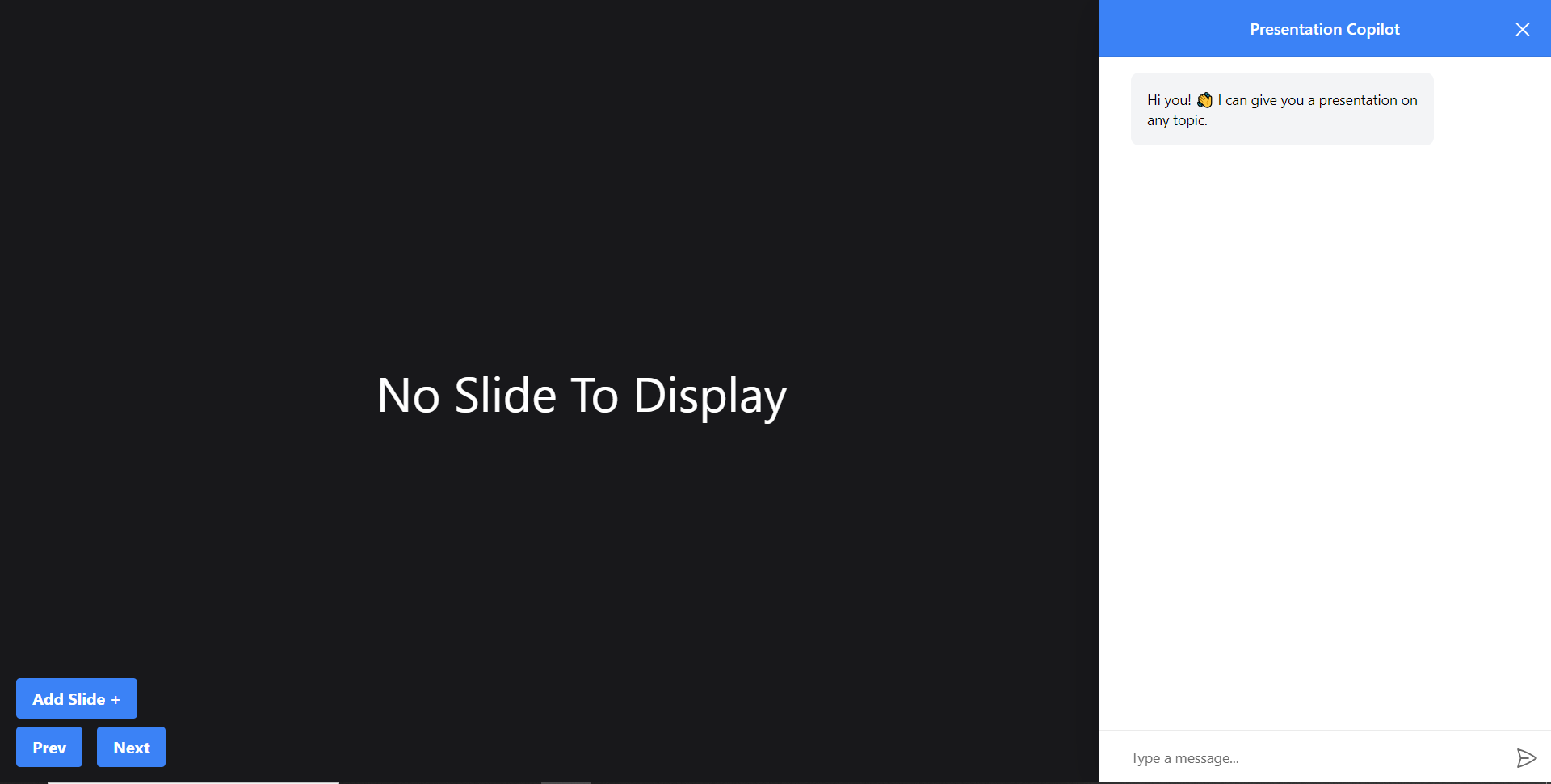 步驟12:給右側的聊天機器人一個提示,例如「在TypeScript上建立PowerPoint簡報」聊天機器人將開始產生回應,完成後,它將在頁面左側顯示產生的PowerPoint投影片,如下圖所示 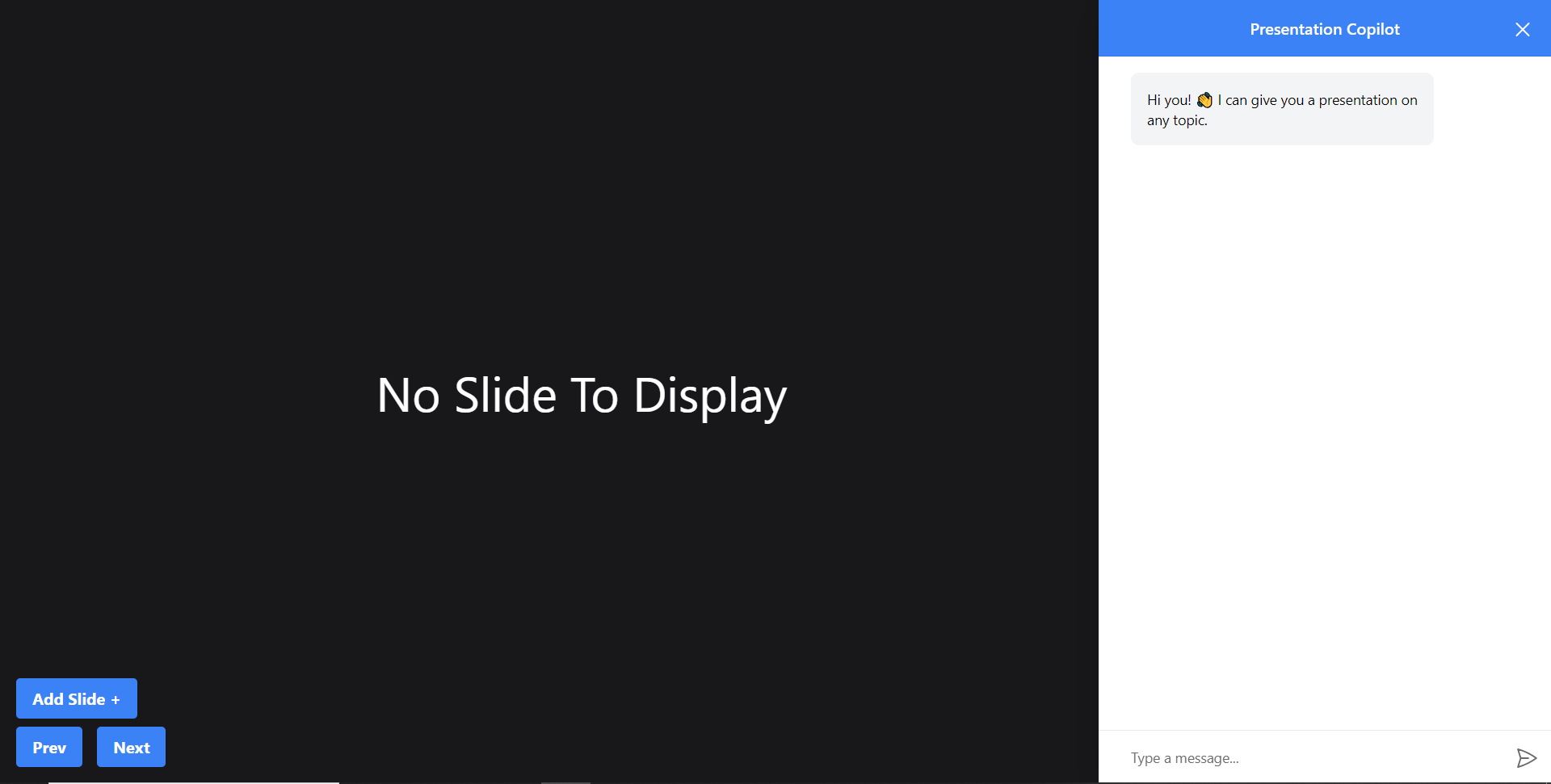 步驟 13:關閉聊天機器人窗口,然後按一下新增投影片 + 按鈕將新投影片新增至 PowerPoint 簡報中,如下所示。 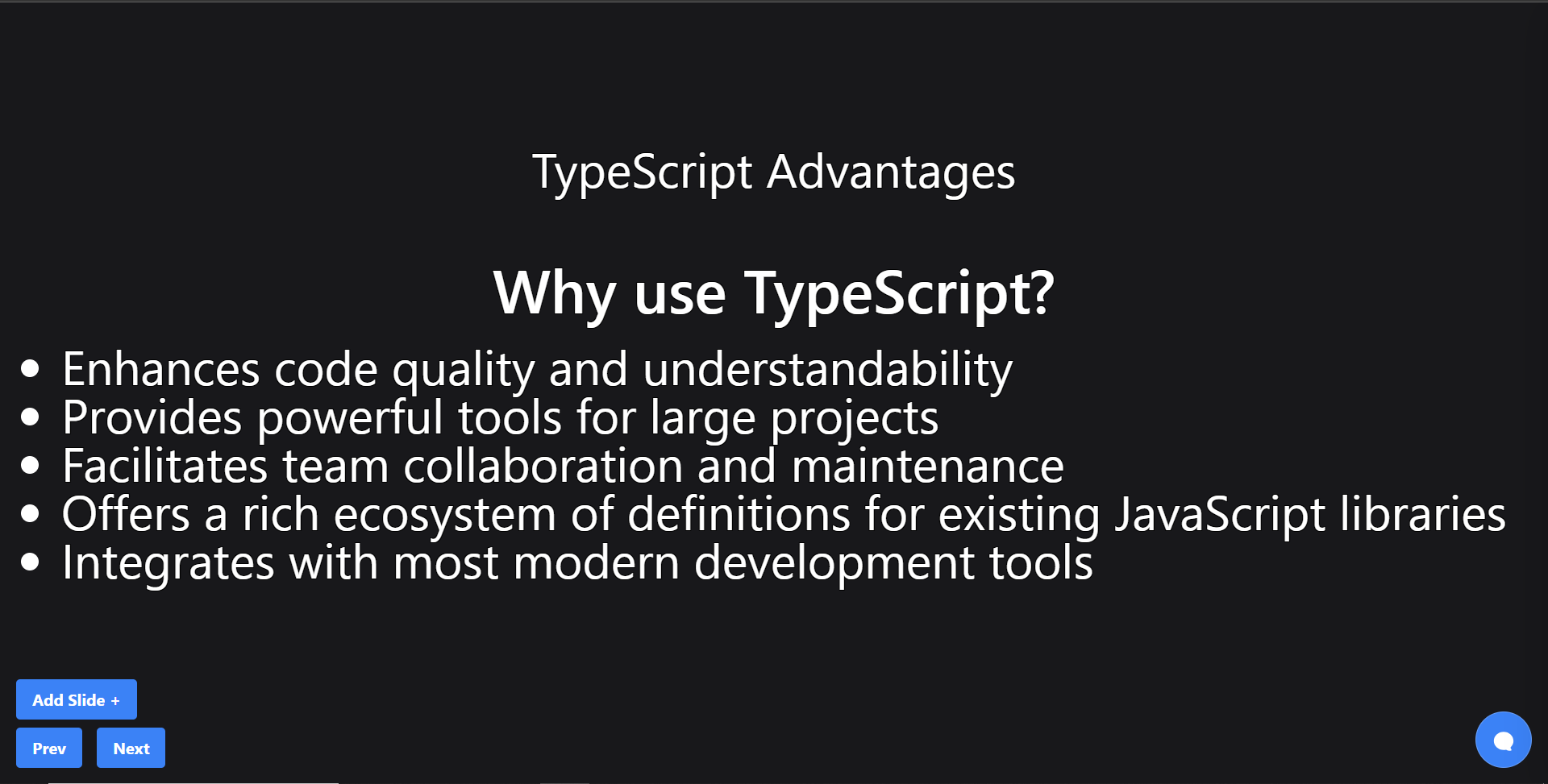 第 14 步:按一下「上一張」按鈕,您將導覽至上一張投影片。如果您按一下「下一步」按鈕,您將導覽至下一張投影片。 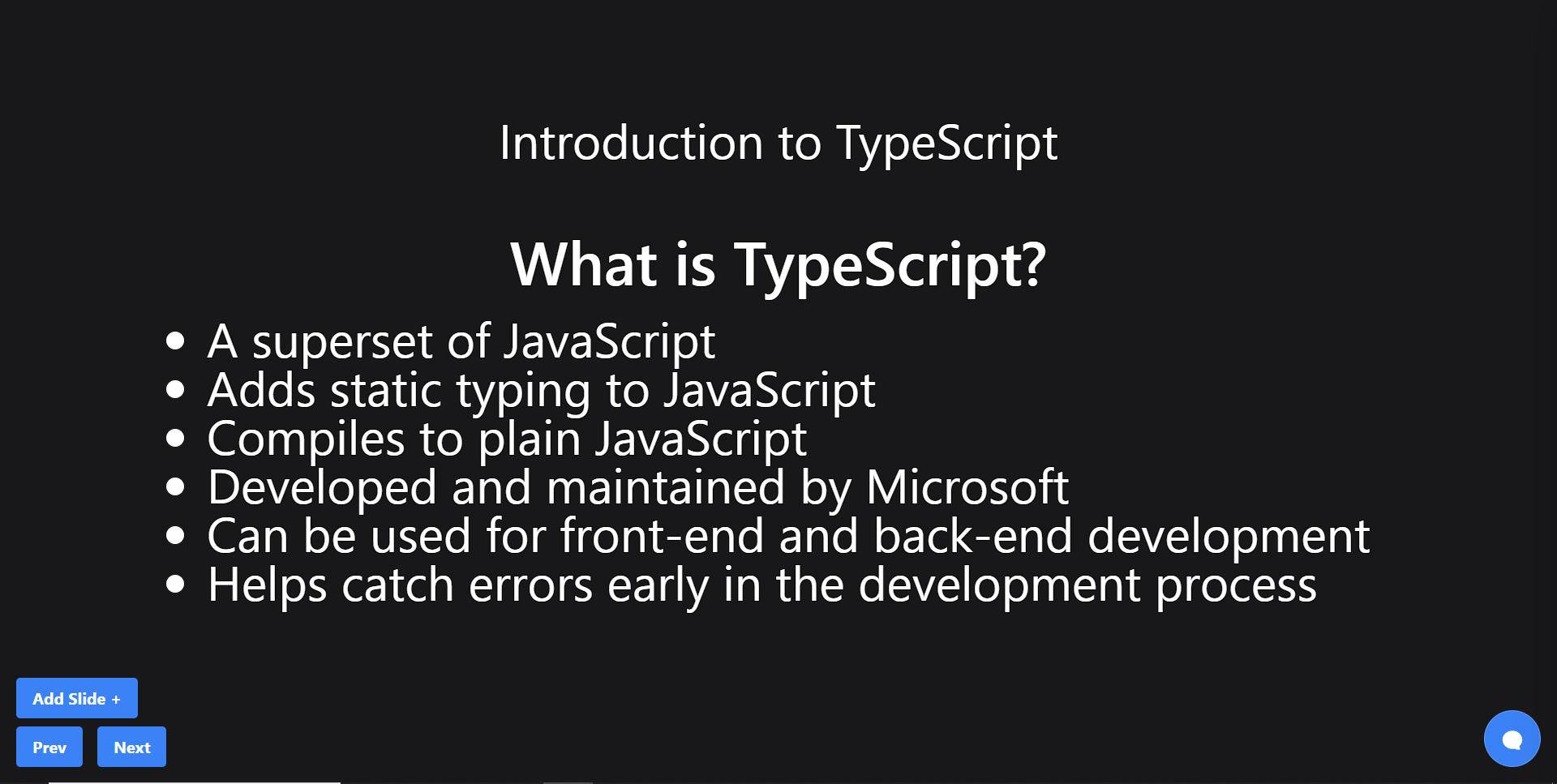 建立 PowerPoint 投影片 自動語音功能 ------------------------ 步驟1:在`present.tsx`檔案中,宣告一個名為`globalAudio`的變數,如下所示。 ``` let globalAudio: any = undefined; ``` 步驟2:在`Presentation`元件中,宣告一個`useEffect`鉤子,用一個新的**`Audio`**物件初始化**`globalAudio`** ,如下所示。 ``` useEffect(() => { if (!globalAudio) { globalAudio = new Audio(); } }, []); ``` 步驟 3:更新 useMakeCopilotActionable 掛鉤,透過 API 將 PowerPoint 幻燈片文字轉換為語音,如下所示。 ``` useMakeCopilotActionable( { name: "createNewPowerPointSlide", description: "create slides for a powerpoint presentation. Call this function multiple times to present multiple slides.", argumentAnnotations: [ { name: "slideTitle", type: "string", description: "The topic to display in the presentation slide. Use simple markdown to outline your speech, like a headline.", required: true, }, { name: "content", type: "string", description: "The content to display in the presentation slide. Use simple markdown to outline your speech, like lists, paragraphs, etc.", required: true }, { name: "speech", type: "string", description: "An informative speech about the current slide.", required: true, }, ], implementation: async (newSlideTitle, newSlideContent, speech) => { const newSlide: Slide = { title: newSlideTitle, content: newSlideContent }; const updatedSlides = [...allSlides, newSlide]; setAllSlides(updatedSlides); setCurrentSlideIndex(updatedSlides.length - 1); const encodedText = encodeURIComponent(speech); const url = `/api/tts?text=${encodedText}`; globalAudio.src = url; await globalAudio.play(); await new Promise<void>((resolve) => { globalAudio.onended = function () { resolve(); }; }); await new Promise((resolve) => setTimeout(resolve, 500)); }, }, [], ); ``` 步驟 4:更新 addSlide 函數,透過 API 將新的 PowerPoint 投影片文字轉換為語音,如下所示。 ``` // Add new slide function const addSlide = new CopilotTask({ instructions: "create a new slide", actions: [ { name: "newSlide", description: "Make a new slide related to the current topic.", argumentAnnotations: [ { name: "title", type: "string", description:"The title to display in the presentation slide.", required: true, }, { name: "content", type: "string", description:"The title to display in the presentation slide.", required: true, }, { name: "speech", type: "string", description: "An informative speech about the current slide.", required: true, }, ], implementation: async (newSlideTitle, newSlideContent, speech) => { const newSlide: Slide = { title: newSlideTitle, content: newSlideContent }; const updatedSlides = [...allSlides, newSlide]; setAllSlides(updatedSlides); setCurrentSlideIndex(updatedSlides.length - 1); const encodedText = encodeURIComponent(speech); const url = `/api/tts?text=${encodedText}`; globalAudio.src = url; await globalAudio.play(); await new Promise<void>((resolve) => { globalAudio.onended = function () { resolve(); }; }); await new Promise((resolve) => setTimeout(resolve, 500)); }, } ] }); ``` 步驟 5: 再次向聊天機器人發出「在 TypeScript 上建立 PowerPoint 簡報」提示,您應該會聽到簡報投影片的聲音。 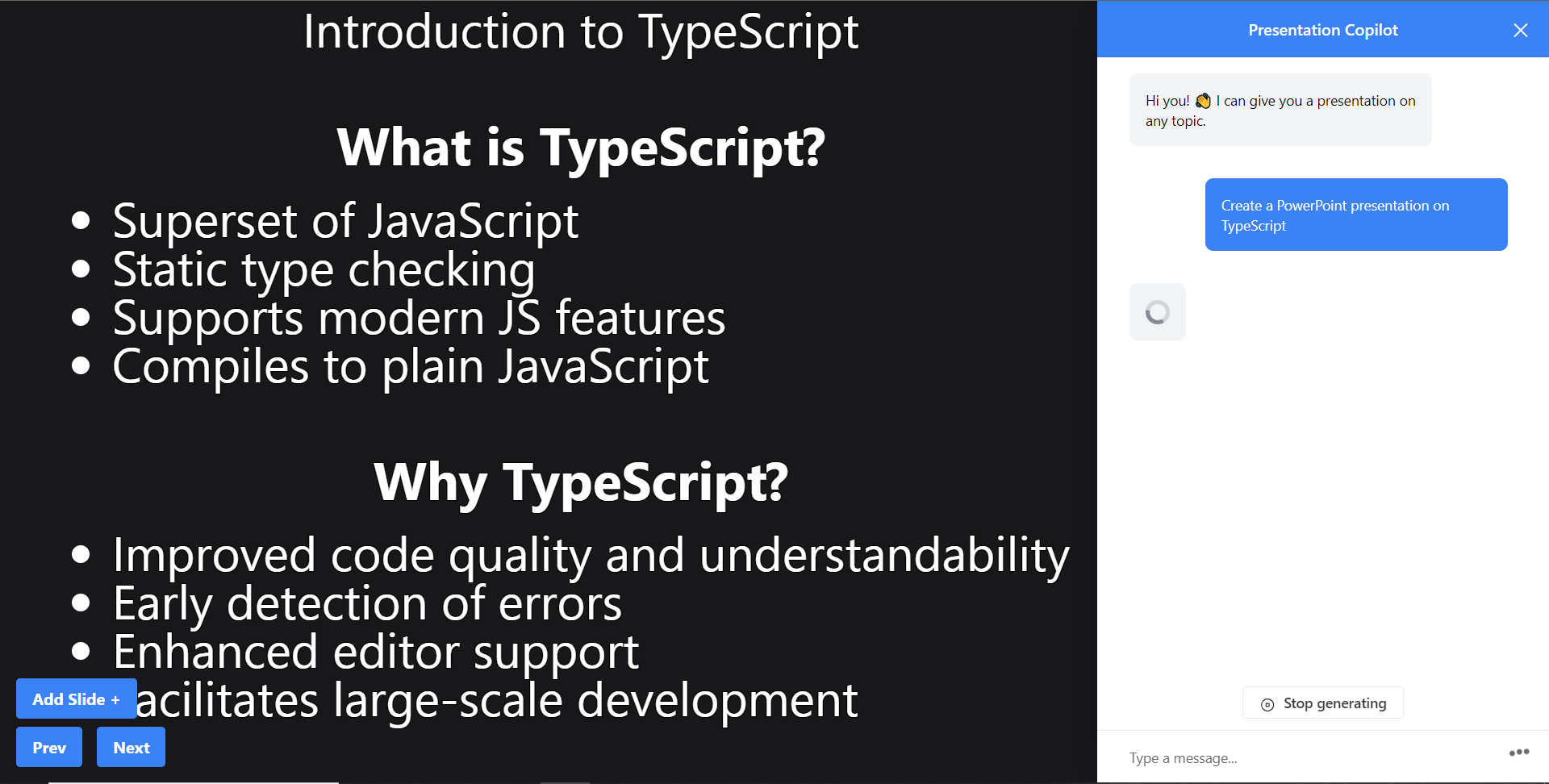 建立圖像生成功能 -------- 步驟1:在present.tsx檔案中,新增一個名為backgroundImage的新屬性來鍵入介面Slide,如下所示。 ``` // Define slide interface interface Slide { title: string; content: string; backgroundImage: string; } ``` 步驟 2:更新 useMakeCopilotActionable 掛鉤以產生 PowerPoint 簡報投影片的圖片。 ``` useMakeCopilotActionable( { name: "createPowerPointSlides", description: "create slides for a powerpoint presentation. Call this function multiple times to present multiple slides.", argumentAnnotations: [ { name: "slideTitle", type: "string", description: "The topic to display in the presentation slide. Use simple markdown to outline your speech, like a headline.", required: true, }, { name: "content", type: "string", description: "The content to display in the presentation slide. Use simple markdown to outline your speech, like lists, paragraphs, etc.", required: true }, { name: "backgroundImage", type: "string", description: "What to display in the background of the slide (i.e. 'dog' or 'house').", required: true, }, { name: "speech", type: "string", description: "An informative speech about the current slide.", required: true, }, ], implementation: async (newSlideTitle, newSlideContent, newSlideBackgroundImage, speech) => { const newSlide: Slide = { title: newSlideTitle, content: newSlideContent, backgroundImage: newSlideBackgroundImage }; const updatedSlides = [...allSlides, newSlide]; setAllSlides(updatedSlides); setCurrentSlideIndex(updatedSlides.length - 1); const encodedText = encodeURIComponent(speech); const url = `/api/tts?text=${encodedText}`; globalAudio.src = url; await globalAudio.play(); await new Promise<void>((resolve) => { globalAudio.onended = function () { resolve(); }; }); await new Promise((resolve) => setTimeout(resolve, 500)); }, }, [], ); ``` 步驟 2:更新 addSlide 函數以產生新的 PowerPoint 簡報投影片的圖片。 **步驟3:**更新`slide.tsx`檔案中的`Slide`元件以透過[`unsplash.com`](http://unsplash.com/)產生映像 ``` // Add new slide function const addSlide = new CopilotTask({ instructions: "create a new slide", functions: [ { name: "newSlide", description: "Make a new slide related to the current topic.", argumentAnnotations: [ { name: "title", type: "string", description:"The title to display in the presentation slide.", required: true, }, { name: "content", type: "string", description:"The title to display in the presentation slide.", required: true, }, { name: "backgroundImage", type: "string", description: "What to display in the background of the slide (i.e. 'dog' or 'house').", required: true, }, { name: "speech", type: "string", description: "An informative speech about the current slide.", required: true, }, ], implementation: async (newSlideTitle, newSlideContent, newSlideBackgroundImage, speech) => { const newSlide: Slide = { title: newSlideTitle, content: newSlideContent, backgroundImage: newSlideBackgroundImage }; const updatedSlides = [...allSlides, newSlide]; setAllSlides(updatedSlides); setCurrentSlideIndex(updatedSlides.length - 1); const encodedText = encodeURIComponent(speech); const url = `/api/tts?text=${encodedText}`; globalAudio.src = url; await globalAudio.play(); await new Promise<void>((resolve) => { globalAudio.onended = function () { resolve(); }; }); await new Promise((resolve) => setTimeout(resolve, 500)); }, } ] }); ``` 步驟 3:更新 displayCurrentSlide 函數以將背景圖像新增至 PowerPoint 簡報投影片中。 ``` // Display current slide const displayCurrentSlide = () => { const slide = allSlides[currentSlideIndex]; return slide ? ( <div className="h-screen flex flex-col justify-center items-center text-5xl text-white bg-cover bg-center bg-no-repeat p-10 text-center" style={{ backgroundImage: 'url("https://source.unsplash.com/featured/?' + encodeURIComponent(allSlides[currentSlideIndex].backgroundImage) + '")', textShadow: "1px 1px 0 #000, -1px -1px 0 #000, 1px -1px 0 #000, -1px 1px 0 #000", }} > <Markdown className="markdown">{slide.title}</Markdown> <Markdown className="markdown">{slide.content}</Markdown> </div> ) : ( <div className="h-screen flex flex-col justify-center items-center text-5xl text-white bg-cover bg-center bg-no-repeat p-10 text-center"> No Slide To Display </div> ); }; ``` **步驟 4:**前往 Web 應用程式,您應該會看到背景圖像已新增至 PowerPoint 投影片中。 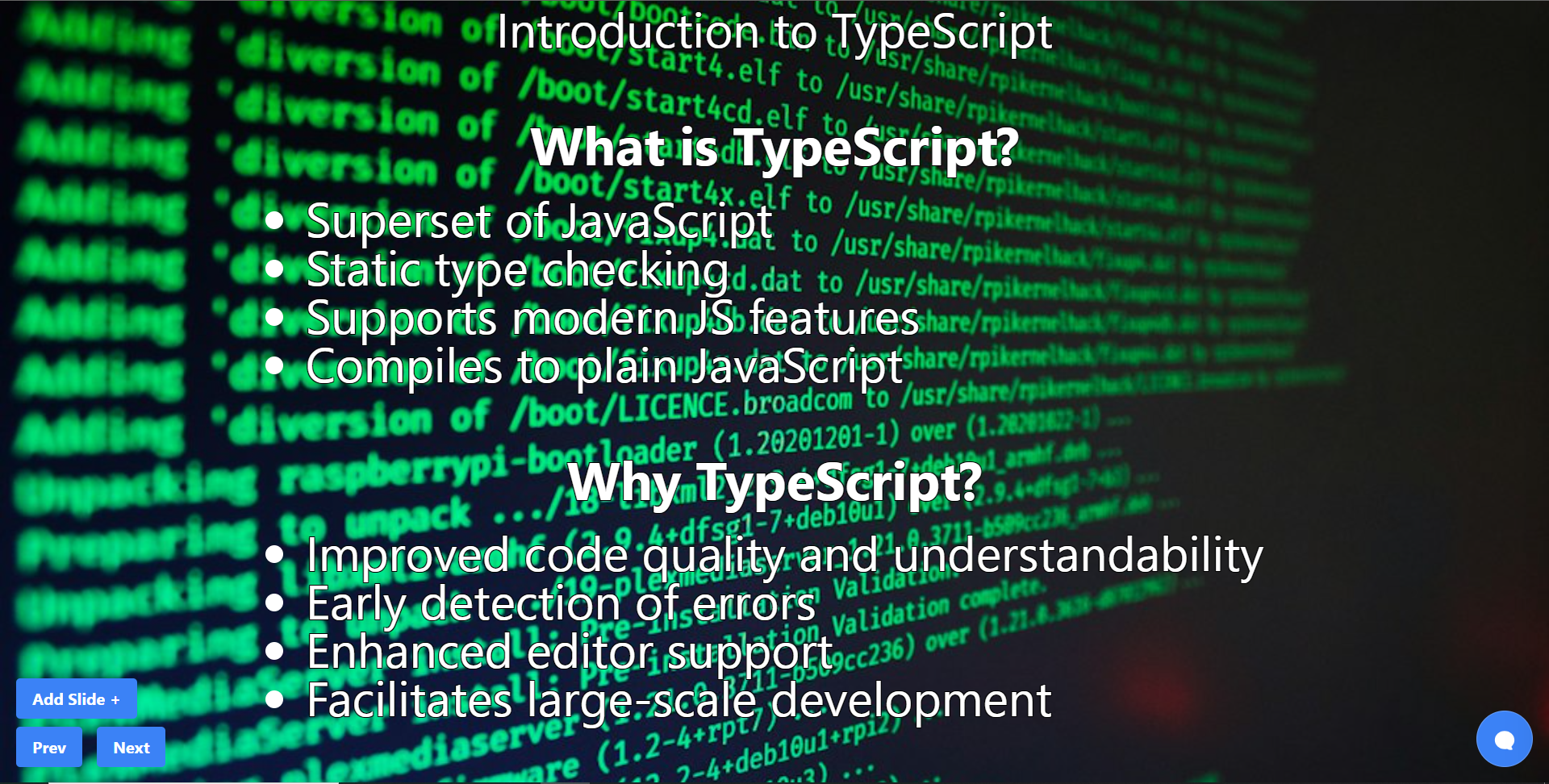 結論 -- 總而言之,您可以使用 CopilotKit 建立應用內 AI 聊天機器人,該機器人可以查看當前應用程式狀態並在應用程式內執行操作。 AI 聊天機器人可以與您的應用程式前端、後端和第三方服務對話。 筆記: - 告訴聊天機器人要寫什麼 - 建立包含文字、圖片和自動語音的幻燈片。 這是全部實作程式碼: https://github.com/CopilotKit/CopilotKit/blob/mme/tools/CopilotKit/examples/next-openai/src/app/helloworld/page.tsx 你可以拿程式碼寫文章,一定要截圖。 確保按照邏輯實現的順序寫文章: - 首先,外部 React 元件( `page.tsx`中的`HelloWorld`元件) ``` - cover `CopilotKit` and `CopliotSidebar` ``` - 然後覆蓋`Presentation`反應元件而不加入 Copilot 功能 ``` - include the `Slide` react component ``` - 最後,在建立基本的 React 應用程式後,加入描述 Copilot 特定功能的部分( `useMakeCopilotReadable`和`useMakeCopilotActionable` ) - 最後,介紹生成音訊+影像的函數。保持描述非常簡短,只需說“我們透過瀏覽器audio-gen API產生音訊”和“我們透過[`unsplash.com`](http://unsplash.com/)產生圖像” 執行演示: - 請參閱文件/貢獻指南,以了解如何執行 CopilotKit 儲存庫中包含的範例應用程式:https://docs.copilotkit.ai/contribute/quickstart-contribute - 執行 - 前往`/helloworld`頁面 --- 結論 -- 總而言之,您可以使用 CopilotKit 建立應用內 AI 聊天機器人,該機器人可以查看當前應用程式狀態並在應用程式內執行操作。 AI 聊天機器人可以與您的應用程式前端、後端和第三方服務對話。 對於完整的源程式碼: https://github.com/TheGreatBonnie/aipoweredpresentation 感謝@theGreatBonnie 在本文中所做的出色工作。 別忘了...  {% cta https://github.com/CopilotKit/CopilotKit %} Star CopilotKit ⭐️ {% endcta %} --- 原文出處:https://dev.to/copilotkit/how-to-build-ai-powered-powerpoint-app-nextjs-openai-copilotkit-ji2
你的轉職路上,還缺少一份自學作業包!寫完這幾包,直接拿作品去面試上班!
本論壇另有附設一個 LINE 新手發問&交流群組!歡迎加入討論!